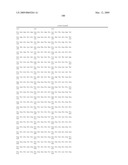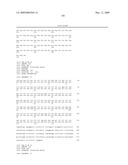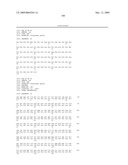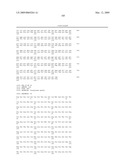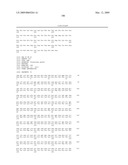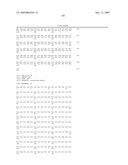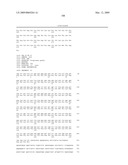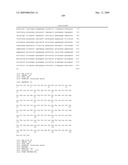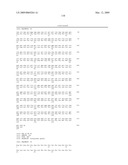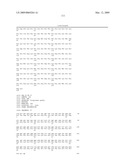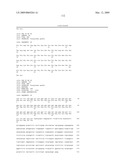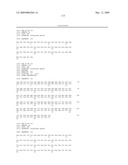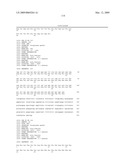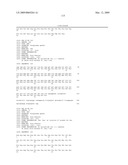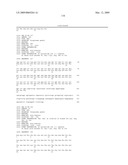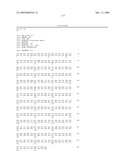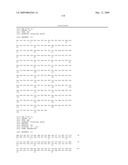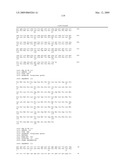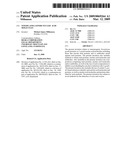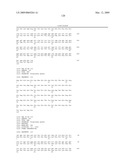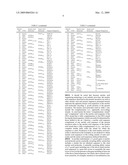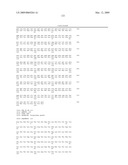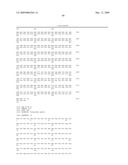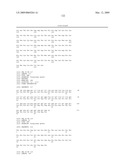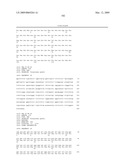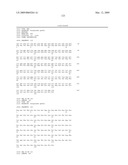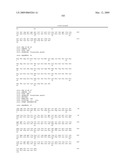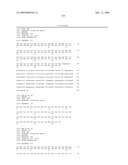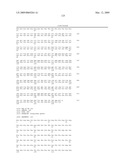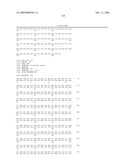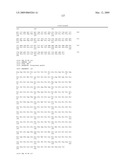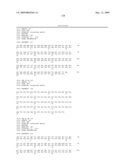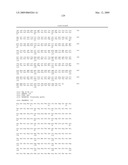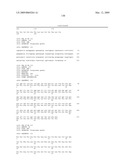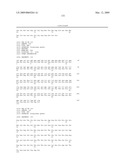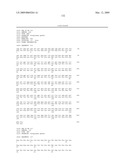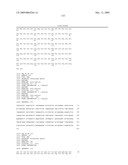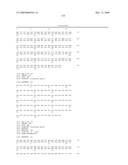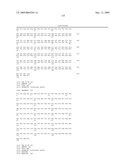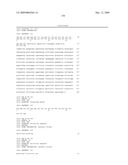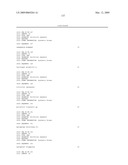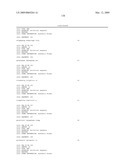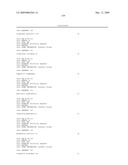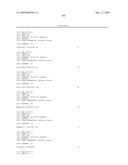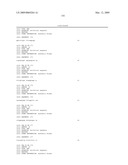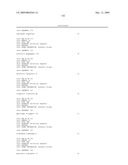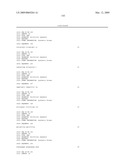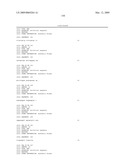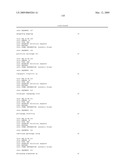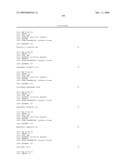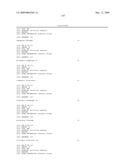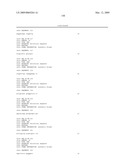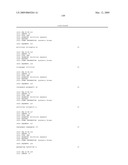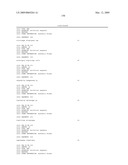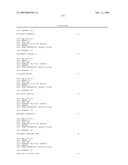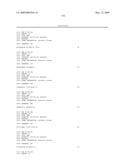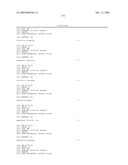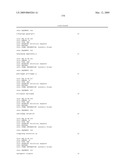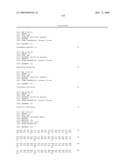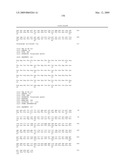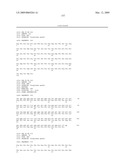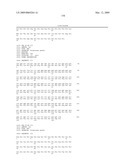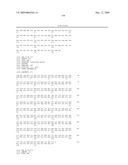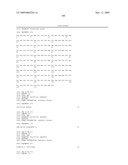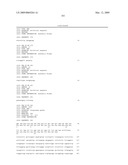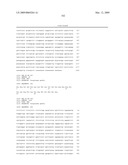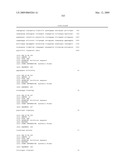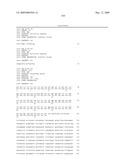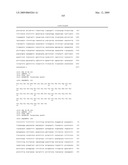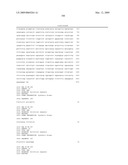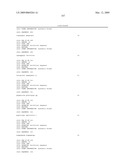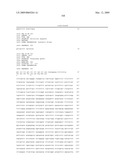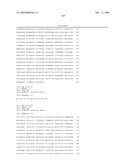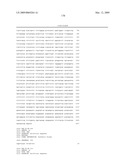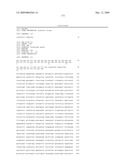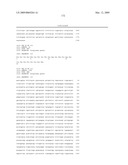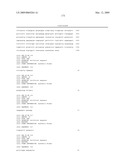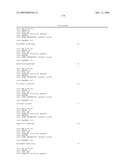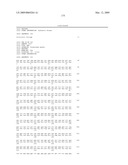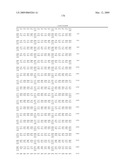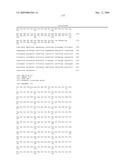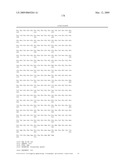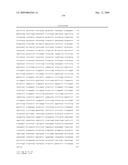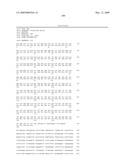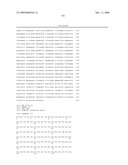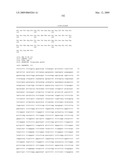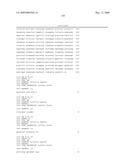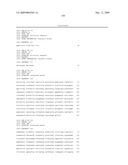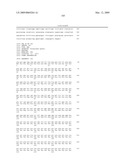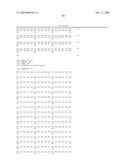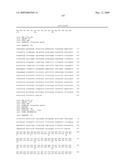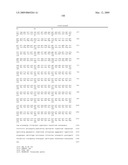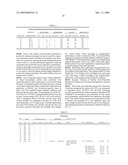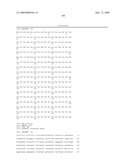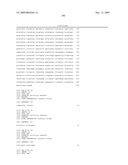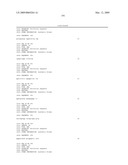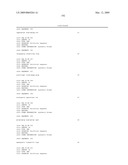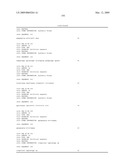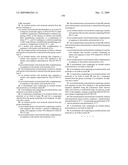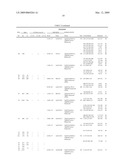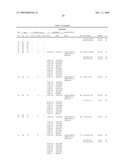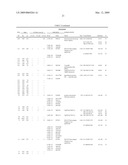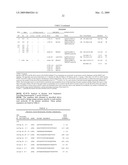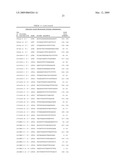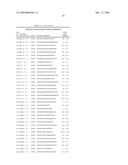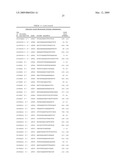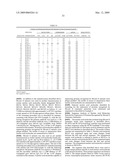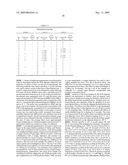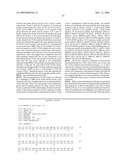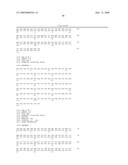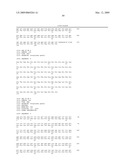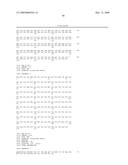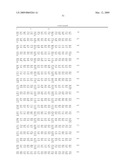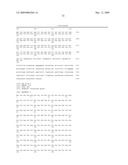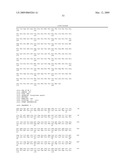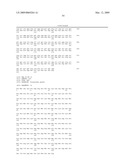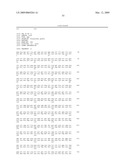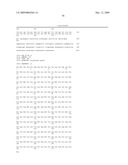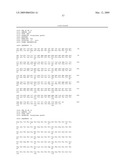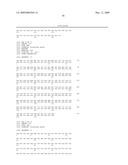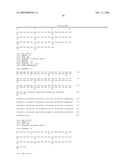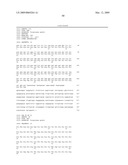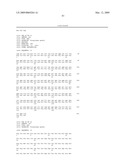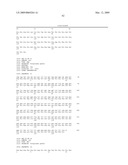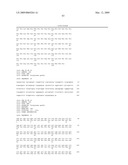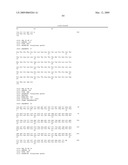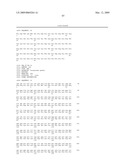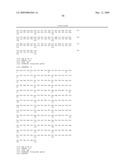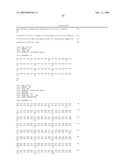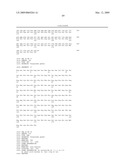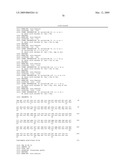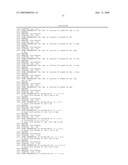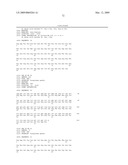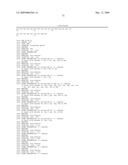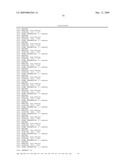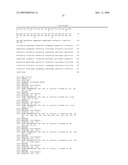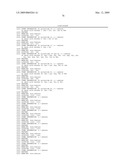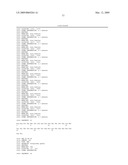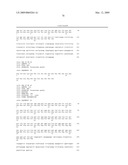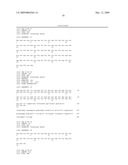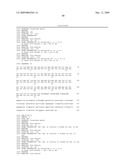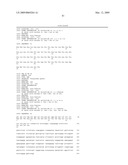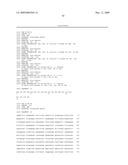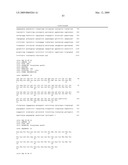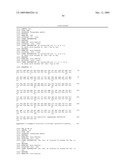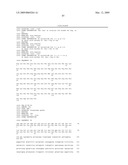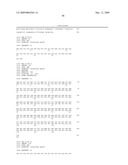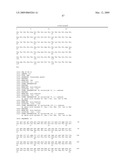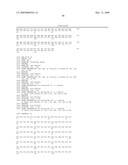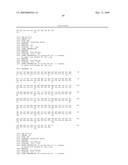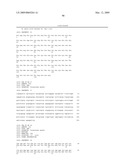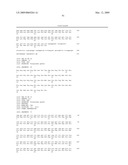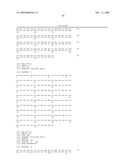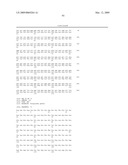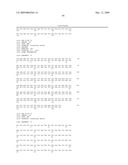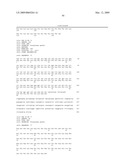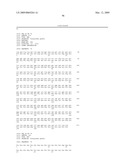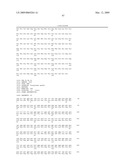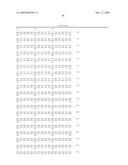Patent application title: TOXOPLASMA GONDII NUCLEIC ACID MOLECULES
Inventors:
Michael James Milhausen (Boulder, CO, US)
IPC8 Class: AA61K317088FI
USPC Class:
514 44
Class name: N-glycoside nitrogen containing hetero ring polynucleotide (e.g., rna, dna, etc.)
Publication date: 2009-03-12
Patent application number: 20090069264
Claims:
1-18. (canceled)
19. An isolated nucleic acid molecule selected from the group consisting of:(a) a nucleic acid molecule that hybridizes to an at least 18 contiguous nucleotide region of SEQ ID NO:72 under conditions comprising (1) hybridizing in a solution comprising 2.times.SSC in the absence of nucleic acid double helix destabilizing compounds, at a temperature of about 37.degree. C.; and (2) washing in a solution comprising 1.times.SSC in the absence of double helix destabilizing compounds at a temperature of about 74.degree. C.; and(b) a nucleic acid molecule fully complementary in sequence to the nucleic acid molecule of (a).
20. The isolated nucleic acid molecule of claim 1, wherein said nucleic acid molecule is selected from the group consisting of:(a) an isolated nucleic acid molecule that comprises a nucleic acid sequence at least 95% identical to the nucleic acid sequence represented by SEQ ID NO:72; and(b) an isolated nucleic acid molecule fully complementary in sequence to the nucleic acid molecule of (a).
21. The isolated nucleic acid molecule of claim 1, wherein said nucleic acid molecule is selected from the group consisting of:(a) an isolated nucleic acid molecule that comprises a nucleic acid sequence represented by SEQ ID NO:72; and(b) an isolated nucleic acid molecule fully complementary in sequence to the nucleic acid molecule of (a).
22. A recombinant virus comprising an isolated nucleic acid molecule as set forth in claim 19.
23. A recombinant cell comprising an isolated nucleic acid molecule as set forth in claim 19.
24. A composition comprising (a) an isolated nucleic acid molecule as set forth in claim 19, and (b) a component selected from the group consisting of an excipient, an adjuvant and a carrier.
25. An isolated nucleic acid molecule selected from the group consisting of:(a) an isolated nucleic acid molecule comprising a nucleic acid sequence that encodes a protein comprising an amino acid sequence at least 95% identical to SEQ ID NO:73; and(b) an isolated nucleic acid molecule fully complementary in sequence to the nucleic acid molecule of (a).
26. The isolated nucleic acid molecule of claim 25, wherein said isolated nucleic acid molecule is selected from the group consisting of:(a) an isolated nucleic acid molecule comprising a nucleic acid sequence that encodes a protein comprising SEQ ID NO:73; and(b) an isolated nucleic acid molecule fully complementary in sequence to the nucleic acid molecule of (a).
27. The isolated nucleic acid molecule of claim 25, wherein said isolated nucleic acid molecule is selected from the group consisting of:(a) an isolated nucleic acid molecule consisting of a nucleic acid sequence that encodes a protein comprising an amino acid sequence at least 95% identical to SEQ ID NO:73; and(b) an isolated nucleic acid molecule fully complementary in sequence to the nucleic acid molecule of (a).
28. A recombinant virus comprising an isolated nucleic acid molecule as set forth in claim 25.
29. A recombinant cell comprising an isolated nucleic acid molecule as set forth in claim 25.
30. A composition comprising (a) an isolated nucleic acid molecule as set forth in claim 25, and (b) a component selected from the group consisting of an excipient, an adjuvant and a carrier.
31. An isolated nucleic acid molecule comprising a nucleic acid sequence at least 95% identical to the polynucleotide sequence amplified using the polymerase chain reaction when said reaction is performed using Toxoplasma gondii DNA as the template, a primer comprising SEQ ID NO:335, and a primer comprising SEQ ID NO:336.
32. The isolated nucleic acid molecule of claim 31, wherein said polymerase chain reaction comprises a denaturization step performed at 95.degree. C., an annealing step performed at 58.degree. C. and an extension step performed at 72.degree. C.
33. A recombinant virus comprising an isolated nucleic acid molecule as set forth in claim 31.
34. A recombinant cell comprising an isolated nucleic acid molecule as set forth in claim 31.
Description:
CROSS-REFERENCE TO RELATED APPLICATIONS
[0001]This application is a divisional of copending application U.S. Ser. No. 09/216,393, filed Dec. 18, 1998, entitled "METHODS FOR THE DETECTION OF ENCYSTED PARASITES", which is Continuation-in-Part of U.S. Ser. No. 08/994,825, filed Dec. 19, 1997, now abandoned, entitled "TOXOPLASMA GONDII PROTEINS, NUCLEIC ACID MOLECULES, AND USES THEREOF".
FIELD OF THE INVENTION
[0002]The present invention relates to Toxoplasma gondii nucleic acid molecules, proteins encoded by such nucleic acid molecules, antibodies raised against such proteins and methods to identify such nucleic acid molecules, proteins or antibodies. The present invention also includes compositions comprising such nucleic acid molecules, proteins and antibodies, as well as their use for inhibiting oocyst shedding by cats infected with T. gondii and for protecting animals from diseases caused by T. gondii.
BACKGROUND OF THE INVENTION
[0003]Various attempts to develop a vaccine to both the asexual systemic stage and the sexual entero-epithelial stage of the Toxoplasma life cycle have been reported over the last thirty years (Hermentin, K. and Aspock, H. (1988), Zbl. Bakt. Hyg. A, 269:423-436). These attempts can be grouped into the following categories: 1) immunization with whole killed organism, 2) immunization with selected antigens, either purified native or recombinant protein, 3) immunization with attenuated strains, and 4) immunization with irradiated organisms. Little success has been achieved with immunizations using whole killed organism (Frenkel, J. K. and Smith, D. D. (1982), Journal of Parasitology, 68:744-748). Partial success has been observed with the pure native protein P30 (Bulow, R., and Boothroyd, J. C. (1991), J. Immunol. 147:3496) and with selected fractions of parasite lysates (Lunden, A. Lovgren, K. Uggla, A., and Araujo, P. G.; (1993) Infection and Immunity, 61: 2639-2643). However, attempts with purified recombinant antigens have not been successful (Lunden, A., Parmley, S. F., Bengtsson, K. L. and Araujo, F. G. (1997) Parasitology Research, 83:6-9). Studies with irradiated organisms have reported 0-90% protection and are complicated by the uncertainty of truly inactivated irradiated preparations. Effective vaccines have been produced using attenuated strains. Two such mutant strains, ts-4 (Waldeland, H., Pfefferkorn, E. R., and Frenkel, J. K. (1993), Journal of Parasitology, 69:171-175) and S48 (Hartley, W. J. and Marshall, S. C. (1957), New Zealand Veterinary Journal, 5:119-124), successfully protect animals against the asexual systemic disease. These strains are delivered in the tachyzoite form and do not protect cats from oocyst shedding. Another strain, T-263 (Frenkel, J. K.; Pfefferkorn, E. R.; Smith, D. D.; and Fishback, J. L. (1991), American Journal of Veterinary Research, 52:759-763) is an oocyst minus strain, but was shown to progress through most of the entero-epithelial stages in the cat intestine. Exposure to this strain induces immunity in the cat to oocyst shedding upon subsequent challenge. There remains a need for an effective vaccine for prevention of the diseases caused by infection with Toxoplasma gondii.
SUMMARY OF THE INVENTION
[0004]The present invention relates to novel compositions and methods to inhibit Toxoplasma gondii (T. gondii) oocyst shedding by cats, thereby preventing the spread of T. gondii infection. According to the present invention there are provided isolated immunogenic T. gondii proteins and mimetopes thereof; T. gondii nucleic acid molecules, including those that encode such proteins; recombinant molecules including such nucleic acid molecules; recombinant viruses including such nucleic acid molecules; recombinant cells including such nucleic acid molecules; and antibodies that selectively bind to such immunogenic T. gondii proteins.
[0005]The present invention also includes methods to obtain and/or identify proteins, nucleic acid molecules, recombinant molecules, recombinant viruses, recombinant cells, and antibodies of the present invention. Also included are compositions comprising such proteins, nucleic acid molecules, recombinant molecules, recombinant viruses, recombinant cells, and antibodies, as well as use of such compositions to inhibit T. gondii oocyst shedding by cats infected with T. gondii, or for preventing T. gondii infection in an animal.
[0006]The present invention further includes the use of the nucleic acid molecules or proteins of the present invention as diagnostic reagents for the detection of T. gondii infection. In a preferred embodiment, the present invention includes a novel detection method and kit for detecting T. gondii oocysts in the feces of T. gondii infected cats.
[0007]One embodiment of the present invention is an isolated nucleic acid molecule encoding an immunogenic T. gondii protein that can be identified by a method that includes the steps of: a) immunoscreening a T. gondii genomic expression library or cDNA expression library with an antiserum, including an antiserum derived from intestinal secretions; and b) identifying a nucleic acid molecule in the library that expresses a protein that selectively binds to an antibody in the antiserum. Antisera to be used for screening include antiserum raised against T. gondii oocysts, antiserum raised against T. gondii bradyzoites, antiserum raised against T. gondii infected cat gut, and antiserum isolated from a cat immune to T. gondii infection. Another embodiment is an isolated immunogenic T. gondii protein that can be identified by a method that includes the steps of: a) immunoscreening a T. gondii genomic expression library or cDNA expression library with such an antiserum; and b) identifying a protein expressed by the library that selectively binds to antibodies in the antiserum. Also included are methods to identify and isolate such nucleic acid molecules and proteins.
[0008]The present application also includes an isolated nucleic acid molecule that hybridizes under stringent hybridization conditions with a gene that includes a nucleic acid sequence cited in Table 1. Also included in the present invention is an isolated nucleic acid molecule that hybridizes under stringent hybridization conditions with a gene that includes a nucleic acid molecule cited in Table 1. Preferred nucleic acid molecules encode immunogenic T. gondii proteins. More preferred nucleic acid molecules are those cited in Table 1.
[0009]The present invention also relates to recombinant molecules, recombinant viruses and recombinant cells that include an isolated nucleic acid molecule of the present invention. Also included are methods to produce such nucleic acid molecules, recombinant molecules, recombinant viruses and recombinant cells.
[0010]Another embodiment of the present invention is an isolated immunogenic protein encoded by a nucleic acid molecule that hybridizes under stringent hybridization conditions with a gene (i.e., with either the coding strand or the non-coding strand) comprising a nucleic acid sequence cited in Table 1 and/or a nucleic acid molecule cited in Table 1. Note that the nucleic acid molecule hybridizes with the non-coding strand of the gene, that is, with the complement of the coding strand of the gene. A preferred protein is an immunogenic T. gondii protein. More preferred proteins are those encoded by nucleic acid molecules cited in Table 1. Also preferred are the proteins cited in Table 1.
[0011]The present invention also relates to: mimetopes of immunogenic T. gondii proteins and isolated antibodies that selectively bind to immunogenic T. gondii proteins or mimetopes thereof. Also included are methods, including recombinant methods to produce proteins, mimetopes and antibodies of the present invention.
[0012]Yet another embodiment of the present invention is a composition to inhibit T. gondii oocyst shedding in a cat due to infection with T. gondii. Such a composition includes one or more of the following protective compounds: an isolated immunogenic T. gondii protein encoded by a nucleic acid molecule that hybridizes under stringent hybridization conditions with a gene comprising a nucleic acid sequence cited in Table 1, and specifically with the non-coding-strand of that gene; an isolated antibody that selectively binds to said immunogenic T. gondii protein; and an isolated nucleic acid molecule that hybridizes under stringent hybridization conditions with a gene comprising a nucleic acid sequence cited in Table 1. Such a composition can also include an excipient, adjuvant or carrier. Preferred compositions comprising a nucleic acid molecule of the present invention include genetic vaccines, recombinant virus vaccines and recombinant cell vaccines. Also included in the present invention is a method to protect an animal, including a human, from disease caused by T. gondii, comprising the step of administering to the animal a composition of the present invention. Preferred animals to treat are cats in order to prevent oocyst shedding caused by T. gondii infection.
DETAILED DESCRIPTION OF THE INVENTION
[0013]The present invention provides for isolated immunogenic T. gondii proteins, isolated T. gondii nucleic acid molecules including those encoding such T. gondii proteins, recombinant molecules comprising such nucleic acid molecules, recombinant viruses comprising such nucleic acid molecules, cells transformed with such nucleic acid molecules (i.e., recombinant cells), and antibodies that selectively bind to immunogenic T. gondii proteins. As used herein, the terms isolated immunogenic T. gondii protein and isolated nucleic acid molecule refer to an immunogenic T. gondii protein and a T. gondii nucleic acid molecule, respectively, derived from T. gondii which can be obtained from its natural source or can be produced using, for example, recombinant nucleic acid technology or chemical synthesis. Also included in the present invention is the use of these proteins, nucleic acid molecules, and antibodies as compositions to protect animals from diseases caused by T. gondii and to inhibit T. gondii oocyst shedding in cats. As used herein, a cat refers to any member of the cat family (i.e., Felidae), including domestic cats, wild cats and zoo cats. Examples of cats include, but are not limited to, domestic cats, lions, tigers, leopards, panthers, cougars, bobcats, lynx, jaguars cheetahs, and servals. A preferred cat to protect is a domestic cat. Further included in the present invention is the use of these proteins, nucleic acid molecules and antibodies for the detection of T. gondii infection in an animal or as targets for the development of chemotherapeutic agents against parasitic infection.
[0014]Immunogenic T. gondii protein and nucleic acid molecules of the present invention have utility because they represent novel targets for anti-parasite vaccines or chemotherapeutic agents. Compositions of the present invention can also be used as reagents for the diagnosis of T. gondii infection in cats and other animals, including humans. The products and processes of the present invention are advantageous because they enable the inhibition of T. gondii oocyst shedding in cats, the definitive hosts for T. gondii (i.e., the animals in which T. gondii reproduction takes place). It is to be noted that the proteins and nucleic acid molecules of the present invention have uses beyond eliciting an immune response despite denoting proteins of the present invention as immunogenic proteins.
[0015]As described in more detail in the Examples, it was very difficult to isolate a nucleic acid molecule encoding an immunogenic T. gondii protein selectively bound by antisera directed against T. gondii intestinal stages. Such stages are preferred because they represent the sexual cycle of T. gondii, the preferred target for development of a composition to inhibit oocyst shedding. Unfortunately, however, the it gondii sexual cycle cannot currently be reproduced in culture, and, there is not a simple method by which to produce a cDNA (i.e., complementary DNA) library containing only T. gondii nucleic acid molecules of various stages of the sexual cycle. For example, the infected cat gut is the source of many of the sexual stages of T. gondii, and, as such, material to be used in identifying T. gondii immunogenic proteins are contaminated with cat material. The present invention describes the development of new techniques to isolate and identify nucleic acid molecules encoding immunogenic T. gondii proteins. These techniques include (a) the isolation and enrichment of antisera against a variety of T. gondii life stages, several of which are only present in infected cats, at least predominantly in infected cat guts, and (b) the use of such antisera to screen cDNA and genomic expression libraries to identify nucleic acid molecules that express T. gondii proteins that selectively bind to such antisera.
[0016]One embodiment of the present invention is an isolated protein that includes an immunogenic T. gondii protein. It is to be noted that the terms "one or more" and "at least one" can be used interchangeably herein. It is also to be noted that the terms "comprising", "including", and "having" can be used interchangeably. According to the present invention, an isolated, or biologically pure, protein is a protein that has been removed from its natural milieu. The terms "isolated" and "biologically pure" do not necessarily reflect the extent to which the protein has been purified. An isolated protein of the present invention can be obtained from its natural source, can be produced using recombinant DNA technology, or can be produced by chemical synthesis.
[0017]An isolated protein of the present invention, including a homolog, can be identified in a straight-forward manner by the protein's ability to elicit an immune response against a naturally occurring T. gondii protein. Examples of T. gondii immunogenic proteins include proteins in which amino acids have been deleted (e.g., a truncated version of the protein, such as a peptide) inserted, inverted, substituted and/or derivatized (e.g., by glycosylation, phosphorylation, acetylation, myristoylation, prenylation, palmitoylation, amidation and/or addition of glycerophosphatidyl inositol) such that the homolog includes at least one epitope capable of eliciting an immune response against a T. gondii immunogenic protein, and/or of binding to an antibody directed against a T. gondii immunogenic protein. That is, when the homolog is administered to an animal as an immunogen, using techniques known to those skilled in the art, the animal will produce an immune response against at least one epitope of a T. gondii immunogenic protein. The ability of a protein to effect an immune response can be measured using techniques known to those skilled in the art. As used herein, the term "epitope" refers to the smallest portion of a protein or other antigen capable of selectively binding to the antigen binding site of an antibody or a T-cell receptor. It is well accepted by those skilled in the art that the minimal size of a protein epitope is about four to six amino acids. As is appreciated by those skilled in the art, an epitope can include amino acids that naturally are contiguous to each other as well as amino acids that, due to the tertiary structure of the natural protein, are in sufficiently close proximity to form an epitope. According to the present invention, an epitope includes a portion of a protein comprising at least about 4 amino acids, at least about 5 amino acids, at least about 6 amino acids, at least about 10 amino acids, at least about 15 amino acids, at least about 20 amino acids, at least about 25 amino acids, at least about 30 amino acids, at least about 35 amino acids, at least about 40 amino acids, at least about 50 amino acids, at least about 100 amino acids, at least about 150 amino acids, at least about 200 amino acids, at least about 250 amino acids, or at least about 300 amino acids.
[0018]Immunogenic T. gondii protein homologs can be the result of natural allelic variation or natural mutation. Immunogenic T. gondii protein homologs of the present invention can also be produced using techniques known in the art including, but not limited to, direct modifications to the protein or modifications to the gene encoding the protein using, for example, classic or recombinant DNA techniques to effect random or targeted mutagenesis.
[0019]As used herein, a nucleic acid molecule encoding an immunogenic T. gondii protein includes nucleic acid sequences related to a natural T. gondii gene. As used herein, a T. gondii gene includes all regions of the genome related to the gene, such as regulatory regions that control production of the immunogenic T. gondii protein encoded by the gene (for example, transcription, translation or post-translation control regions) as well as the coding region itself, and any introns or non-translated coding regions. As used herein, a gene that "includes" or "comprises" a sequence may include that sequence in one contiguous array, or may include the sequence as fragmented exons. As used herein, the term "coding region" refers to a continuous linear array of nucleotides that translates into a protein. A full-length coding region is that coding region that is translated into a full-length protein, i.e., a complete protein as would be initially translated in its natural milieu, prior to any post-translational modifications.
[0020]In one embodiment, a T. gondii gene of the present invention includes at least one of the nucleic acid molecules cited in Table 1 (i.e., the cited nucleic acid molecules). The coding strands of the cited nucleic acid molecules are represented, respectively, by the nucleic acid sequences (i.e., the cited nucleic acid sequences) shown in Table 1. Also presented in Table 1 are the deduced amino acid sequences encoded by each of the cited nucleic acid molecules (i.e., the cited amino acid sequences) and the protein name designations (i.e., the cited proteins).
TABLE-US-00001 TABLE 1 SEQ ID Nucleic Acid Amino Acid NO TYPE Molecules Molecules Original Designation 1 DNA nTG1357 Tg-41 2 Protein PTG1119 PTG-41 3 DNA nTG2339 Tg-45 4 Protein PTG2108 PTG-45 5 DNA nTG4526 Tg-50 6 Protein PTG4175 PTG-50 7 cDNA nTG41478 Tg-50c 8 Protein PTG4381 PTG-50c 9 DNA nTG5657 Q2-4 10 Protein PTG5219 PQ2-4 11 cDNA nTG51029 Q2-4c 12 Protein PTG5273 PQ2-4c 13 DNA nTG6425 Q2-9 14 Protein PTG6142 PQ2-9 15 DNA nTG7417 Q2-10 16 Protein PTG7139 PQ2-10 17 DNA nTG8507 Q2-11 18 Protein PTG851 PQ2-11 19 DNA nTG9718 4499-9 20 Protein PTG999 P4499-9 21 DNA nTG10441 4604-2 22 Protein PTG10147 P4604-2 23 DNA nTG11428 4604-3 24 Protein PTG11134 P4604-3 25 DNA nTG13282 4604-5 26 DNA nTG15304 4604-10 27 Protein PTG15101 P4604-10 28 DNA nTG16284 4604-17 29 Protein PTG1695 P4604-17 30 DNA nTG17690 4604-54 31 Protein PTG17230 P4604-54 32 DNA nTG18313 4604-62 33 Protein PTG1854 P4604-62 34 DNA nTG19389 4604-63 35 Protein PTG1965 P4604-63 36 DNA nTG21548 4604-69 37 Protein PTG21183 P4604-69 38 DNA nTG22310 BZ1-2 39 Protein PTG2295 PBZ1-2 40 DNA nTG23220 BZ1-3 41 Protein PTG2373 PBZ1-3 42 DNA nTG24642 BZ1-6 43 Protein PTG2434 PBZ1-6 44 DNA nTG25381 BZ2-3 45 Protein PTG2527 PBZ2-3 46 DNA nTG26432 BZ2-5 47 Protein PTG2685 PBZ2-5 48 DNA nTG27282 BZ3-2 49 Protein PTG2735 PBZ3-2 50 DNA nTG28466 BZ4-3 51 Protein PTG2871 PBZ4-3 52 DNA nTG30539 BZ4-6 53 Protein PTG3020 PBZ4-6 54 DNA nTG311233 AMX/I-5 55 DNA nTG32411 AMX/I-6 56 Protein PTG3260 PAMX/I-6 57 DNA nTG33441 AMX/I-7 58 Protein PTG33118 PAMX/I-7 59 DNA nTG34491 AMX/I-9 60 Protein PTG3434 PAMX/I-9 61 DNA nTG35387 AMX/I-10 62 Protein PTG35129 PAMX/I-10 63 DNA nTG36417 AMI-23 64 Protein PTG36139 PAMI-23 65 DNA nTG37416 AMI-24 66 Protein PTG37138 PAMI-24 67 DNA nTG38500 AMI-28 68 DNA nTG40321 AMI-47 69 Protein PTG4073 PAMI-47 70 DNA nTG41513+C86 OC-1 71 Protein PTG41171 POC-1 72 DNA nTG42528 OC-2 73 Protein PTG42176 POC-2 74 DNA nTG43375 OC-13 75 Protein PTG43125 POC-13 76 DNA nTG44543 OC-14 77 Protein PTG4489 POC-14 78 DNA nTG45573 OC-22 79 Protein PTG45191 POC-22 80 DNA nTG461835 OC-23 81 Protein PTG46612 POC-23 82 DNA nTG48604 4CQA7f 83 Protein PTG48112 P4CQA7f 84 DNA nTG48549 4CQA7r 85 DNA nTG49270 4CQA11 86 Protein PTG4990 P4CQA11 87 DNA nTG50306 4CQA19 88 Protein PTG50102 P4CQA19 89 DNA nTG51804 4CQA21 90 Protein PTG51268 P4CQA21 91 DNA nTG52867 4CQA22 92 Protein PTG52289 P4CQA22 93 DNA nTG531434 4CQA24 94 Protein PTG53164 P4CQA24 95 DNA nTG54680 4CQA25 96 Protein PTG54227 P4CQA25 97 DNA nTG55296 4CQA26 98 Protein PTG5599 P4CQA26 99 DNA nTG56723 4CQA27 100 Protein PTG5653 P4CQA27 101 DNA nTG57270 4CQA29 102 Protein PTG5790 P4CQA29 103 DNA nTG58503 R8050-2 104 Protein PTG5862 PR8050-2 105 DNA nTG60322 R8050-5 106 Protein PTG6073 PR8050-5 107 DNA nTG61390 R8050-6 108 Protein PTG6167 PR8050-6 109 DNA nTG62699 M2A1 110 Protein PTG62233 PM2A1 111 DNA nTG63419 M2A2 112 Protein PTG63140 PM2A2 113 DNA nTG64303 M2A3 114 Protein PTG64101 PM2A3 115 DNA nTG65696 M2A4 116 Protein PTG65232 PM2A4 117 DNA nTG66173 M2A5 118 Protein PTG6658 PM2A5 119 DNA nTG67369 M2A6 120 Protein PTG67123 PM2A6 121 DNA nTG68568 M2A7 122 Protein PTG6861 PM2A7 123 DNA nTG69616 M2A11 124 Protein PTG69205 PM2A11 125 DNA nTG70762 M2A16 126 Protein PTG70254 PM2A16 127 DNA nTG71236 M2A18 128 Protein PTG7179 PM2A18 129 DNA nTG72569 M2A19 130 Protein PTG72190 PM2A19 131 DNA nTG73232 M2A20 132 DNA nTG74276 M2A21 133 Protein PTG7492 PM2A21 134 DNA nTG75309 M2A22 135 Protein PTG75103 PM2A22 136 DNA nTG76534 M2A23 137 Protein PTG76178 PM2A23 138 DNA nTG76423 M2A23 139 DNA nTG77327 M2A24 140 Protein PTG77109 PM2A24 141 DNA nTG78444 M2A25 142 Protein PTG78148 PM2A25 143 DNA nTG79928 M2A29 144 Protein PTG7919 PM2A29 265 DNA nTG22310a BZ1-2-a 266 Protein PTG2295a PBZ1-2-a 267 DNA nTG64303a M2A3-a 268 Protein PTG64101a PM2A3-a 269 DNA nTG71236a M2A18-a 270 Protein PTG7179a PM2A18-a 271 DNA nTG64425a Q2-9-1-a 272 Protein PTG6142a PQ2-9-a 273 DNA nTG41513a OC-1-a 274 Protein PTG41171a POC-1-a 282 cDNA nTG1225 MGIS42 283 Protein PTG28 PMGIS42 284 DNA nTG1225 rc 292 cDNA nTG1573 MGIS44 293 Protein PTG73 PMGIS44 294 DNA nTG1573 rc 306 cDNA nTG2417 MGIS48 307 Protein PTG9 PMGIS48 308 DNA nTG2417 rc 311 cDNA nTG1785 MGIS65 312 Protein PTG24 PMGIS65 313 DNA nTG1785 rc 338 DNA nTG647 511-44 genomic 339 DNA nTG647 rc 340 cDNA nTG867 511-44 coding region 341 Protein PTG288 P511-44 342 DNA nTG867 rc 343 cDNA nTG1397 511-44cDNA 345 DNA nTG1397 rc
[0021]It should be noted that because nucleic acid sequencing technology is not entirely error-free, the nucleic acid sequences disclosed in the present invention (as well as other nucleic acid and protein sequences presented herein) represent the apparent nucleic acid sequences of the nucleic acid molecules encoding T. gondii proteins of the present invention. The nucleic acid molecules cited in Table 1 also include the complementary (i.e., apparently non-coding) strands. As used herein the terms "complementary strand" and "complement" refer to the nucleic acid sequence of the DNA strand that is fully complementary to the DNA strand having the listed sequence, which can easily be determined by those skilled in the art. Likewise, a nucleic acid sequence complement of any nucleic acid sequence of the present invention refers to the nucleic acid sequence of the nucleic acid strand that is fully complementary to (i.e., can form a complete double helix with) the strand for which the sequence is cited. Production of the cited nucleic acid molecules is disclosed in the Examples as are methods to obtain nucleic acid sequences of the coding strands of such molecules and the amino acid sequences deduced therefrom.
[0022]In another embodiment, a T. gondii gene or nucleic acid molecule can be a naturally occurring allelic variant that includes a similar but not identical sequence to the cited nucleic acid molecules. A naturally occurring allelic variant of a T. gondii gene including any of the above-listed nucleic acid sequences is a gene that occurs at essentially the same locus (or loci) in the genome as the gene including at least one of the above-listed sequences, but which, due to natural variations caused by, for example, mutation or recombination, has a similar but not identical sequence. Because natural selection typically selects against alterations that affect function, allelic variants usually encode proteins having similar activity to that of the protein encoded by the gene to which they are being compared. Allelic variants of genes or nucleic acid molecules can also comprise alterations in the 5' or 3' untranslated regions of the gene (e.g., in regulatory control regions), or can involve alternative splicing of a nascent transcript, thereby bringing alternative exons into juxtaposition. Allelic variants are well known to those skilled in the art and would be expected to be found within a given T. gondii organism or population, because, for example, the genome goes through a diploid stage, and sexual reproduction results in the reassortment of alleles.
[0023]In one embodiment of the present invention, an isolated immunogenic T. gondii protein is encoded by a nucleic acid molecule that hybridizes under stringent hybridization conditions to a gene encoding an immunogenic T. gondii protein. The minimal size of a T. gondii protein of the present invention is a size sufficient to be encoded by a nucleic acid molecule capable of forming a stable hybrid (i.e., hybridizing under stringent hybridization conditions) with the complementary sequence of a nucleic acid molecule encoding the corresponding natural protein. The size of a nucleic acid molecule encoding such a protein is dependent on the nucleic acid composition and the percent homology between the T. gondii nucleic acid molecule and the complementary nucleic acid sequence. It can easily be understood that the extent of homology required to form a stable hybrid under stringent conditions can vary depending on whether the homologous sequences are interspersed throughout a given nucleic acid molecule or are clustered (i.e., localized) in distinct regions on a given nucleic acid molecule.
[0024]The minimal size of a nucleic acid molecule capable of forming a stable hybrid with a gene encoding an immunogenic T. gondii protein is typically at least about 12 to about 15 nucleotides in length if the nucleic acid molecule is GC-rich and at least about 15 to about 17 bases in length if it is AT-rich. The minimal size of a nucleic acid molecule used to encode an immunogenic T. gondii protein homolog of the present invention is from about 12 to about 18 nucleotides in length. Thus, the minimal size of an immunogenic T. gondii protein homolog of the present invention is from about 4 to about 6 amino acids in length. There is no limit, other than a practical limit, on the maximal size of a nucleic acid molecule encoding an immunogenic T. gondii protein of the present invention because a nucleic acid molecule of the present invention can include a portion of a gene, an entire gene, or multiple genes. A preferred nucleic acid molecule of the present invention is a nucleic acid molecule that is at least 12 nucleotides in length. Also preferred are nucleic acid molecules that are at least 18 nucleotides, or at least 20 nucleotides, or at least 25 nucleotides, or at least 30 nucleotides, or at least 40 nucleotides, or at least 50 nucleotides, or at least 70 nucleotides, or at least 100 nucleotides, or at least 150 nucleotides, or at least 200 nucleotides, or at least 250 nucleotides, or at least 300 nucleotides, or at least 350 nucleotides, or at least 400 nucleotides, or at least 500 nucleotides, or at least 750 nucleotides, or at least 1000 nucleotides, or at least 1500 nucleotides, or at least 1750 nucleotides, or at least 2000 nucleotides, or at least 2250 nucleotides, or at least 2417 nucleotides in length. The preferred size of a protein encoded by a nucleic acid molecule of the present invention depends on whether a full-length, fusion, multivalent, or functional portion of such a protein is desired.
[0025]Stringent hybridization conditions are determined based on defined physical properties of the gene to which the nucleic acid molecule is being hybridized, and can be defined mathematically. Stringent hybridization conditions are those experimental parameters that allow an individual skilled in the art to identify significant similarities between heterologous nucleic acid molecules. These conditions are well known to those skilled in the art. See, for example, Sambrook, et al., 1989, Molecular Cloning: A Laboratory Manual, Cold Spring Harbor Labs Press, and Meinkoth, et al., 1984, Anal. Biochem. 138, 267-284, each of which is incorporated by reference herein in its entirety. As explained in detail in the cited references, the determination of hybridization conditions involves the manipulation of a set of variables including the ionic strength (M, in moles/liter), the hybridization temperature (° C.), the concentration of nucleic acid helix destabilizing agents (such as formamide), the average length of the shortest hybrid duplex (n), and the percent G+C composition of the fragment to which an unknown nucleic acid molecule is being hybridized. For nucleic acid molecules of at least about 150 nucleotides, these variables are inserted into a standard mathematical formula to calculate the melting temperature, or Tm of a given nucleic acid molecule. As defined in the formula below, Tm is the temperature at which two complementary nucleic acid molecule strands will disassociate, assuming 100% complementarity between the two strands.
Tm=81.5° C.+16.6 log M+0.41(% G+C)-500/n-0.61(% formamide).
For nucleic acid molecules smaller than about 50 nucleotides, hybrid stability is defined by the dissociation temperature (Td), which is defined as the temperature at which 50% of the duplexes dissociate. For these smaller molecules, the stability at a standard ionic strength is defined by the following equation:
Td=4(G+C)+2(A+T).
A temperature of 5° C. below Td is used to detect hybridization between perfectly matched molecules.
[0026]Also well known to those skilled in the art is how base-pair mismatch, i.e. differences between two nucleic acid molecules being compared, including non-complementarity of bases at a given location, and gaps due to insertion or deletion of one or more bases at a given location on either of the nucleic acid molecules being compared, will affect Tm or Td for nucleic acid molecules of different sizes. For example, Tm decreases about 1° C. for each 1% of mismatched base-pairs for hybrids greater than about 150 bp, and Td decreases about 5° C. for each mismatched base-pair for hybrids below about 50 bp. Conditions for hybrids between about 50 and about 150 base-pairs can be determined empirically and without undue experimentation using standard laboratory procedures well known to those skilled in the art. These simple procedures allow one skilled in the art to set the hybridization conditions (by altering, for example, the salt concentration, the formamide concentration or the temperature) so that only nucleic acid 20, hybrids with less than a specified % base-pair mismatch will hybridize. Stringent hybridization conditions are commonly understood by those skilled in the art to be those experimental conditions that will allow hybridization between molecules having about 30% or less base-pair mismatch (i.e., about 70% or greater identity). Because one skilled in the art can easily determine whether a given nucleic acid molecule to be tested is less than or greater than about 50 nucleotides, and can therefore choose the appropriate formula for determining hybridization conditions, he or she can determine whether the nucleic acid molecule will hybridize with a given gene under stringent hybridization conditions and similarly whether the nucleic acid molecule will hybridize under conditions designed to allow a desired amount of base pair mismatch.
[0027]Hybridization reactions are often carried out by attaching the nucleic acid molecule to be hybridized to a solid support such as a membrane, and then hybridizing with a labeled nucleic acid molecule, typically referred to as a probe, suspended in a hybridization solution. Examples of common hybridization reaction techniques include, but are not limited to, the well-known Southern and northern blotting procedures. Typically, the actual hybridization reaction is done under non-stringent conditions, i.e., at a lower temperature and/or a higher salt concentration, and then high stringency is achieved by washing the membrane in a solution with a higher temperature and/or lower salt concentration in order to achieve the desired stringency.
[0028]For example, if the skilled artisan wished to identify a nucleic acid molecule that hybridizes under stringent hybridization conditions with a T. gondii nucleic acid molecule of about 150 bp in length, the following conditions could preferably be used. As an example, the average G+C content of Dirofilaria immitis DNA is about 35%. The unknown nucleic acid molecules would be attached to a support membrane, and the 150 bp probe would be labeled, e.g. with a radioactive tag. The hybridization reaction could be carried out in a solution comprising 2×SSC and 0% formamide, at a temperature of about 37° C. (low stringency conditions). Solutions of differing concentrations of SSC can be made by one of skill in the art by diluting a stock solution of 20×SSC (175.3 gram NaCl and about 88.2 gram sodium citrate in 1 liter of water, pH 7) to obtain the desired concentration of SSC. In order to achieve high stringency hybridizations the skilled artisan would calculate the washing conditions required to allow up to 30% base-pair mismatch. For example, in a wash solution comprising 1×SSC and 0% formamide, the Tm of perfect hybrids would be about 79° C.:
81.5° C.+16.6 log(0.15M)+(0.41×35)-(500/150)-(0.61×0)=79° C.
Thus, to achieve hybridization with nucleic acid molecules having about 30% base-pair mismatch, hybridization washes would be carried out at a temperature of about 49° C. It is thus within the skill of one in the art to calculate additional hybridization temperatures based on the desired percentage base-pair mismatch, formulae and G/C content disclosed herein. For example, it is appreciated by one skilled in the art that as the nucleic acid molecule to be tested for hybridization against nucleic acid molecules of the present invention having sequences specified herein becomes longer than 150 nucleotides, the Tm for a hybridization reaction allowing up to 30% base-pair mismatch will not vary significantly from 49° C.
[0029]Furthermore, it is known in the art that there are commercially available computer programs for determining the degree of similarity between two nucleic acid sequences. These computer programs include various known methods to determine the percentage identity and the number and length of gaps between hybrid nucleic acid molecules. Preferred methods to determine the percent identity among amino acid sequences and also among nucleic acid sequences include analysis using one or more of the commercially available computer programs designed to compare and analyze nucleic acid or amino acid sequences. These computer programs include, but are not limited to, GCG® (available from Genetics Computer Group, Madison, Wis.), DNAsis® (available from Hitachi Software, San Bruno, Calif.) and MacVector® (available from the Eastman Kodak Company, New Haven, Conn.). A preferred method to determine percent identity among amino acid sequences and also among nucleic acid sequences includes using the GCG® program, Bestfit function with default parameter settings, or a gap weight of 12, a length weight of 4, an average match of 2.912, and an average mismatch of -2.003.
[0030]A preferred immunogenic T. gondii protein of the present invention is a compound that, when administered to an animal in an effective manner, is capable of protecting that animal from disease caused by T. gondii or, in the case of cats, is capable of preventing T. gondii oocyst shedding in cats infected with T. gondii. In accordance with the present invention, the ability of an immunogenic T. gondii protein of the present invention to protect an animal from T. gondii disease refers to the ability of that protein to, for example, treat, ameliorate and/or prevent disease caused by T. gondii. In one embodiment, an immunogenic T. gondii protein of the present invention can elicit an immune response (including a humoral and/or cellular immune response) against T. gondii.
[0031]The present invention also includes mimetopes of immunogenic T. gondii proteins of the present invention. As used herein, a mimetope of an immunogenic T. gondii protein of the present invention refers to any compound that is able to mimic the activity of such an immunogenic T. gondii protein, often because the mimetope has a structure that mimics the particular T. gondii protein. Mimetopes can be, but are not limited to: peptides that have been modified to decrease their susceptibility to degradation such as all-D retro peptides; anti-idiotypic and/or catalytic antibodies, or fragments thereof; non-proteinaceous immunogenic portions of an isolated protein (e.g., carbohydrate structures); and synthetic or natural organic molecules, including nucleic acids. Such mimetopes can be designed using computer-generated structures of proteins of the present invention. Mimetopes can also be obtained by generating random samples of molecules, such as oligonucleotides, peptides or other organic molecules, and screening such samples by affinity chromatography techniques using the corresponding binding partner.
[0032]One embodiment of an immunogenic T. gondii protein of the present invention is a fusion protein that includes an immunogenic T. gondii protein-containing domain attached to one or more fusion segments. Suitable fusion segments for use with the present invention include, but are not limited for segments that can: enhance a protein's stability; act as an immunopotentiator to enhance an immune response against an immunogenic T. gondii protein; and/or assist in purification of an immunogenic T. gondii protein (e.g., by affinity chromatography). A suitable fusion segment can be a domain of any size that has the desired function (e.g., imparts increased stability, imparts increased immunogenicity to a protein, and/or simplifies purification of a protein). Fusion segments can be joined to amino and/or carboxyl termini of the immunogenic T. gondii protein-containing domain of the protein and can be susceptible to cleavage in order to enable straightforward recovery of an immunogenic T. gondii protein. Fusion proteins are preferably produced by culturing a recombinant cell transformed with a nucleic acid molecule that encodes a protein including the fusion segment attached to either the carboxyl and/or amino terminal end of an immunogenic T. gondii protein-containing domain. Preferred fusion segments include a metal binding domain (e.g., a poly-histidine segment); an immunoglobulin binding domain (e.g., Protein A; Protein G; T cell; B cell; Fc receptor or complement protein antibody-binding domains); a sugar binding domain (e.g., a maltose binding domain); and/or a "tag" domain (e.g., at least a portion of β-galactosidase, a strep tag peptide, a T7 tag peptide, a Flag® peptide, or other domains that can be purified using compounds that bind to the domain, such as monoclonal antibodies). More preferred fusion segments include metal binding domains, such as a poly-histidine segment; a maltose binding domain; a strep tag peptide, such as that available from Biometra in Tampa, Fla.; and an S10 peptide.
[0033]In another embodiment, an immunogenic T. gondii protein of the present invention also includes at least one additional protein segment that is capable of protecting an animal from one or more diseases. Such a multivalent protective protein can be produced, for example, by culturing a cell transformed with a nucleic acid molecule comprising two or more nucleic acid domains joined together in such a manner that the resulting nucleic acid molecule is expressed as a multivalent protective compound containing at least two protective compounds capable of protecting an animal from diseases caused, for example, by at least one infectious agent.
[0034]Examples of multivalent protective compounds include, but are not limited to, an immunogenic T. gondii protein of the present invention attached to one or more compounds protective against one or more other infectious agents, particularly an agent that infects cats. In another embodiment, one or more protective compounds can be included in a multivalent vaccine comprising an immunogenic T. gondii protein of the present invention and one or more other protective molecules as separate compounds.
[0035]A preferred isolated immunogenic T. gondii protein of the present invention includes a protein that is encoded by a nucleic acid molecule that hybridizes under stringent hybridization conditions with a gene (i.e., with the non-coding strand which is a complement of the coding strand) comprising at least one of the nucleic acid molecules cited in Table 1. As such, also preferred is a protein that is encoded by a nucleic acid molecule that hybridizes under stringent hybridization conditions with the non-coding strand of a gene comprising at least one of the nucleic acid sequences cited in Table 1. More preferred is a protein encoded by a nucleic acid molecule that hybridizes under stringent hybridization conditions with at least one of the cited nucleic acid molecules particularly since those nucleic acid molecules have been shown to encode proteins that selectively bind to antiserum that either was raised against T. gondii oocysts, bradyzoites, or infected cat gut, or was isolated from a cat immune to T. gondii infection. As such, also preferred is a protein encoded by a nucleic acid molecule that hybridizes under stringent hybridization conditions with the complement of at least one of the cited nucleic acid sequences.
[0036]Even more preferred are isolated proteins having an amino acid sequence encoded by a nucleic acid molecules that are at least about 75%, preferably at least about 80%, more preferably at least about 85%, even more preferably at least about 90%, even more preferably at least about 95%, and even more preferably at least about 98% identical to one of the nucleic acid molecules and/or nucleic acid sequences cited in Table 1. Also preferred are proteins that comprise one or more epitopes of any of the proteins having such amino acid sequences.
[0037]A particularly preferred isolated protein of the present invention is a protein having an amino acid sequence encoded by at least one of the cited nucleic acid molecules and/or cited nucleic acid sequences, a protein encoded by an allelic variant of at least one of the cited nucleic acid molecules and/or nucleic acid sequences, or a protein comprising an epitope of any of the proteins having such amino acid sequences.
[0038]In one embodiment, preferred immunogenic T. gondii proteins of the present invention include proteins that are at least about 75%, preferably at least about 80%, more preferably at least about 85%, even more preferably at least about 90%; and even more preferably at least about 95% identical to at least one of the proteins cited in Table 1. As such, also preferred are proteins that are at least about 75%, preferably at least about 80%, more preferably at least about 85%, even more preferably at least about 90%, and even more preferably at least about 95% identical to at least one of the amino acid sequences cited in Table 1. Also preferred are proteins that comprise one or more epitopes of any of such proteins. More preferred are immunogenic T. gondii proteins comprising the cited proteins and/or having the cited amino acid sequences, proteins encoded by allelic variants of nucleic acid molecules encoding proteins including the cited proteins and/or having the cited amino acid sequences, and proteins having one or more epitopes of such proteins.
[0039]Another embodiment of the present invention is an isolated nucleic acid molecule comprising a T. gondii nucleic acid molecule that encodes an immunogenic T. gondii protein. The identifying characteristics of such nucleic acid molecules are heretofore described. A nucleic acid molecule of the present invention can include an isolated natural T. gondii nucleic acid molecule or a homolog thereof, the latter of which is described in more detail below. A nucleic acid molecule of the present invention can include one or more regulatory regions, full-length or partial coding regions, or combinations thereof. The minimal size of a nucleic acid molecule of the present invention is a size sufficient to allow the formation of a stable hybrid (i.e., hybridization under stringent hybridization conditions) with the complementary sequence of another nucleic acid molecule. The minimal size of an T. gondii nucleic acid molecule of the present invention is from about 12 to about 18 nucleotides in length.
[0040]In accordance with the present invention, an isolated nucleic acid molecule is a nucleic acid molecule that has been removed from its natural milieu (i.e., that has been subjected to human manipulation) and can include DNA, RNA, or derivatives of either DNA or RNA. Accordingly, the term "isolated", as used herein to describe a nucleic acid molecule, does not reflect the extent to which the nucleic acid molecule has been purified. An isolated T. gondii nucleic acid molecule of the present invention can be isolated from its natural source or produced using recombinant nucleic acid technology (e.g., polymerase chain reaction (PCR) amplification or cloning) or chemical synthesis. Isolated T. gondii nucleic acid molecules can include, for example, natural allelic variants and nucleic acid molecules modified by nucleotide insertions, deletions, substitutions, and/or inversions in a manner such that the modifications do not substantially interfere with the nucleic acid molecule's ability to encode an immunogenic T. gondii protein of the present invention.
[0041]A homolog of a nucleic acid molecule encoding an immunogenic T. gondii protein can be produced using a number of methods known to those skilled in the art, see, for example, Sambrook et al., 1989, Molecular Cloning: A Laboratory Manual, Cold Spring Harbor Labs Press; Sambrook et al., ibid., is incorporated by reference herein in its entirety. For example, nucleic acid molecules can be modified using a variety of techniques including, but not limited to, classic mutagenesis and recombinant DNA techniques such as site-directed mutagenesis, chemical treatment, restriction enzyme cleavage, ligation of nucleic acid fragments, PCR amplification, synthesis of oligonucleotide mixtures and ligation of mixture groups to "build" a mixture of nucleic acid molecules, and combinations thereof. Nucleic acid molecule homologs can be selected by hybridization with a nucleic acid molecule encoding an immunogenic T. gondii protein or by screening the function of a protein encoded by the nucleic acid molecule (e.g., ability to elicit an immune response against at least one epitope of an immunogenic T. gondii protein).
[0042]An isolated nucleic acid molecule of the present invention can include a nucleic acid sequence that encodes at least one immunogenic T. gondii protein of the present invention, examples of which are disclosed herein. Although the phrase "nucleic acid molecule" primarily refers to the physical nucleic acid molecule and the phrase "nucleic acid sequence" primarily refers to the sequence of nucleotides on the nucleic acid molecule, the two phrases can be used interchangeably, especially with respect to a nucleic acid molecule, or a nucleic acid sequence, capable of encoding an T. gondii protein.
[0043]A preferred nucleic acid molecule of the present invention, when administered to a cat, is capable of preventing T. gondii oocyst shedding. As will be disclosed in more detail below, such a nucleic acid molecule can be, or encode, an antisense RNA, a molecule capable of triple helix formation, a ribozyme, or other nucleic acid-based drug compound. In additional embodiments, a nucleic acid molecule of the present invention can encode a protective protein (e.g., an immunogenic T. gondii protein of the present invention), the nucleic acid molecule being delivered to the animal, for example, by direct injection (i.e., as a genetic vaccine) or in a vehicle such as a recombinant virus vaccine or a recombinant cell vaccine. Another preferred nucleic acid molecule of the present invention, when administered to an animal, is capable of preventing disease in that animal caused by T. gondii.
[0044]One embodiment of the present invention is an isolated nucleic acid molecule that hybridizes under stringent hybridization conditions with a nucleic acid molecule comprising at least one of the nucleic acid molecules cited in Table 1. As such, also preferred is a nucleic acid molecule that hybridizes under stringent hybridization conditions with at least one of the nucleic acid sequences cited in Table 1 or with a complement of such a sequence. More preferred is a nucleic acid molecule that hybridizes under stringent hybridization conditions with at least one of the cited nucleic acid molecules. As such, also preferred is a nucleic acid molecule that hybridizes under stringent hybridization conditions with at least one of the cited nucleic acid sequences or with a complement thereof.
[0045]Even more preferred are isolated nucleic acid molecules that are at least about 75%, preferably at least about 80%, more preferably at least about 85%, even more preferably at least about 90%, even more preferably at least about 95%, and even more preferably at least about 98% identical to one of the nucleic acid molecules and/or nucleic acid sequences cited in Table 1. Also preferred are nucleic acid molecules that form stable hybrids with nucleic acid molecules having those percent identities.
[0046]A particularly preferred isolated nucleic acid molecule of the present invention is a nucleic acid molecule that comprises at least one of the cited nucleic acid molecules and/or cited nucleic acid sequences, a nucleic acid molecule that is an allelic variant of at least one of the cited nucleic acid molecules and/or nucleic acid sequences, or a nucleic acid molecule that is a portion thereof (i.e., a nucleic acid molecule that forms a stable hybrid with at least one of the cited nucleic acid molecules or allelic variants thereof).
[0047]In one embodiment, a nucleic acid molecule encoding an immunogenic T. gondii protein of the present invention encodes a protein that is at least about 75%, preferably at least about 80%, more preferably at least about 85%, even more preferably at least about 90%, and even more preferably at least about 95% identical to the proteins cited in Table 1. Even more preferred is a nucleic acid molecule encoding a protein cited in Table 1 or an allelic variant of such a nucleic acid molecule. Also preferred are nucleic acid molecules encoding proteins comprising one or more epitopes of proteins having the cited 1 percent identities or epitopes of proteins cited in Table 1 or encoded by nucleic acid molecules that are allelic variants of nucleic acid molecules cited in Table 1.
[0048]In another embodiment, a nucleic acid molecule encoding an immunogenic T. gondii protein of the present invention encodes a protein having an amino acid sequence that is at least about 75%, preferably at least about 80%, more preferably at least about 85%, even more preferably at least about 90%, and even more preferably at least about 95% identical to at least one of the amino acid sequences cited in Table 1. Even more preferred is a nucleic acid molecule encoding a protein having an amino acid sequence cited in Table 1 or an allelic variant of such a nucleic acid molecule. Also preferred are nucleic acid molecules encoding proteins comprising one or more epitopes of proteins having the cited percent identities or epitopes of proteins having amino acid sequences cited in Table 1 or encoded by nucleic acid molecules that are allelic variants of nucleic acid molecules cited in Table 1.
[0049]Note that nucleic acid molecules of the present invention can include nucleotide sequences in addition to those disclosed above, such as, but not limited to, nucleotide sequences comprising a full-length gene, a full-length coding region, a nucleic acid molecule encoding a fusion protein, or a nucleic acid molecule encoding a multivalent protective compound. Also included in the present invention are nucleic acid molecules that have been modified to accommodate codon usage properties of the cells in which such nucleic acid molecules are to be expressed. Preferred nucleic acid molecules of the present invention include fragments of the nucleic acid molecules disclosed in Table 1.
[0050]Knowing the nucleic acid sequences of certain nucleic acid molecules encoding immunogenic T. gondii proteins of the present invention allows one skilled in the art to, for example, (a) make copies of those nucleic acid molecules, (b) obtain nucleic acid molecules including at least a portion of such nucleic acid molecules (e.g., nucleic acid molecules including full-length genes, full-length coding regions, regulatory control sequences, truncated coding regions), and (c) obtain other nucleic acid molecules encoding an immunogenic T. gondii proteins. Such nucleic acid molecules can be obtained in a variety of ways including screening appropriate expression libraries with antibodies of the present invention; traditional cloning techniques using oligonucleotide probes of the present invention to screen appropriate libraries; and PCR amplification of appropriate libraries or DNA using oligonucleotide primers of the present invention. Preferred libraries to screen or from which to amplify nucleic acid molecules include T. gondii cDNA libraries as well as genomic DNA libraries. Similarly, preferred DNA sources from which to amplify nucleic acid molecules include T. gondii cDNA and genomic DNA. Techniques to clone and amplify nucleic acid molecules are disclosed, for example, in Sambrook et al., ibid.
[0051]The present invention also includes nucleic acid molecules that are oligonucleotides capable of hybridizing, under stringent hybridization conditions, with complementary regions of other, preferably longer, nucleic acid molecules of the present invention such as those comprising nucleic acid molecules encoding immunogenic T. gondii proteins. Oligonucleotides. of the present invention can be RNA, DNA, or derivatives of either. The minimum size of such oligonucleotides is the size required for formation of a stable hybrid between an oligonucleotide and a complementary sequence on a nucleic acid molecule of the present invention. A preferred oligonucleotide of the present invention has a maximum size of about 100 nucleotides. The present invention includes oligonucleotides that can be used as, for example, probes to identify nucleic acid molecules encoding immunogenic T. gondii proteins, primers to produce nucleic acid molecules encoding immunogenic T. gondii proteins, or reagents to inhibit immunogenic T. gondii protein production or activity (e.g., as antisense-, triplex formation-, ribozyme- and/or RNA drug-based reagents). The present invention also includes the use of such oligonucleotides to protect animals from disease using one or more of such technologies. Appropriate oligonucleotide-containing compositions can be administered to an animal using techniques known to those skilled in the art.
[0052]One embodiment of the present invention includes a recombinant vector, which includes at least one isolated nucleic acid molecule of the present invention, inserted into any vector capable of delivering the nucleic acid molecule into a host cell. Such a vector contains heterologous nucleic acid sequences, that is nucleic acid sequences that are not naturally found adjacent to nucleic acid molecules of the present invention and that preferably are derived from a species other than the species from which the nucleic acid molecule(s) are derived. The vector can be either RNA or DNA, either prokaryotic or eukaryotic, and typically is a virus or a plasmid. Recombinant vectors can be used in the cloning, sequencing, and/or otherwise manipulating of nucleic acid molecule encoding immunogenic T. gondii proteins of the present invention.
[0053]One type of recombinant vector, referred to herein as a recombinant molecule, comprises a nucleic acid molecule of the present invention operatively linked to an expression vector. The phrase operatively linked refers to insertion of a nucleic acid molecule into an expression vector in a manner such that the molecule is able to be expressed when transformed into a host cell. As used herein, an expression vector is a DNA or RNA vector that is capable of transforming a host cell and of effecting expression of a specified nucleic acid molecule. Preferably, the expression vector is also capable of replicating within the host cell. Expression vectors can be operative in either prokaryotic or eukaryotic cells, and are typically viruses or plasmids. Expression vectors of the present invention include any vectors that function (i.e., direct gene expression) in recombinant cells of the present invention, including in bacterial, fungal, parasite, insect, other animal, and plant cells. Preferred expression vectors of the present invention can direct gene expression in bacterial yeast, T. gondii and mammalian cells, and more preferably in the cell types disclosed herein.
[0054]In particular, expression vectors of the present invention contain regulatory sequences such as transcription control sequences, translation control sequences, origins of replication, and other regulatory sequences that are compatible with the recombinant cell and that control the expression of nucleic acid molecules of the present invention. In particular, recombinant molecules of the present invention include transcription control sequences. Transcription control sequences are sequences which control the initiation, elongation, and termination of transcription. Particularly important transcription control sequences are those which control transcription initiation, such as promoter, enhancer, operator and repressor sequences. Suitable transcription control sequences include any transcription control sequence that can function in at least one of the recombinant cells of the present invention. A variety of such transcription control sequences are known to those skilled in the art. Preferred transcription control sequences include those which function in bacterial, yeast, helminth or other endoparasite, or insect and mammalian cells, such as, but not limited to, tac, lac, trp, trc, oxy-pro, omp/lpp, rrnb, bacteriophage lambda (such as lambda pL and lambda pR and fusions that include such promoters), bacteriophage T7, T7lac, bacteriophage T3, bacteriophage SP6, bacteriophage SP01, metallothionein, alpha-mating factor, Pichia alcohol oxidase, alphavirus subgenomic promoter, antibiotic resistance gene, baculovirus, Heliothis zea insect virus, vaccinia virus, herpesvirus, raccoon poxvirus, other poxvirus, adenovirus, cytomegalovirus (such as immediate early promoter), simian virus 40, retrovirus, actin, retroviral long terminal repeat, Rous sarcoma virus, heat shock, phosphate and nitrate transcription control sequences as well as other sequences capable of controlling gene expression in prokaryotic or eukaryotic cells. Additional suitable transcription control sequences include tissue-specific promoters and enhancers as well as lymphokine-inducible promoters (e.g., promoters inducible by interferons or interleukins). Transcription control sequences of the present invention can also include naturally occurring transcription control sequences naturally associated with T. gondii.
[0055]Suitable and preferred nucleic acid molecules to include in recombinant vectors of the present invention are as disclosed herein. Preferred nucleic acid molecules to include in recombinant vectors, and particularly in recombinant molecules, include those cited in Table 1. Particularly preferred recombinant molecules of the present invention include those recombinant molecules, the production of which are described in the Examples section.
[0056]Recombinant molecules of the present invention may also (a) contain secretory signals (i.e., signal segment nucleic acid sequences) to enable an expressed T. gondii protein of the present invention to be secreted from the cell that produces the protein and/or (b) contain fusion sequences which lead to the expression of nucleic acid molecules of the present invention as fusion proteins. Examples of suitable signal segments include any signal segment capable of directing the secretion of a protein of the present invention. Preferred signal segments include, but are not limited to, tissue plasminogen activator (t-PA), interferon, interleukin, growth hormone, histocompatibility and viral envelope glycoprotein signal segments. Suitable fusion segments encoded by fusion segment nucleic acids are disclosed herein. In addition, a nucleic acid molecule of the present invention can be joined to a fusion segment that directs the encoded protein to the proteosome, such as a ubiquitin fusion segment. Eukaryotic recombinant molecules may also include intervening and/or untranslated sequences surrounding and/or within the nucleic acid sequences of nucleic acid molecules of the present invention.
[0057]Another embodiment of the present invention includes a recombinant cell comprising a host cell transformed with one or more recombinant molecules of the present invention. Transformation of a nucleic acid molecule into a cell can be accomplished by any method by which a nucleic acid molecule can be inserted into the cell. Transformation techniques include, but are not limited to, transfection, electroporation, inicroinjection, lipofection, adsorption, and protoplast fusion. A recombinant cell may remain unicellular or may grow into a tissue, organ or a multicellular organism. Transformed nucleic acid molecules of the present invention can remain extrachromosomal or can integrate into one or more sites within a chromosome of the transformed (i.e., recombinant) cell in such a manner that their ability to be expressed is retained. Preferred nucleic acid molecules with which to transform a cell include nucleic acid molecules encoding immunogenic T. gondii proteins disclosed herein. Particularly preferred nucleic acid molecules with which to transform a cell include those listed in Table 1.
[0058]Suitable host cells to transform include any cell that can be transformed with a nucleic acid molecule of the present invention. Host cells can be either untransformed cells or cells that are already transformed with at least one nucleic acid molecule (e.g., nucleic acid molecules encoding one or more proteins of the present invention and/or other proteins useful in the production of multivalent vaccines). Host cells of the present invention either can be endogenously (i.e., naturally) capable of producing T. gondii proteins of the present invention or can be capable of producing such proteins after being transformed with at least one nucleic acid molecule of the present invention. Host cells of the present invention can be any cell capable of producing at least one protein of the present invention, and include bacterial, fungal (including yeast), parasite (including helminth, protozoa and ectoparasite), insect, other animal and plant cells. Preferred host cells include bacterial, mycobacterial, yeast, protozoan, helminth, insect and mammalian cells. More preferred host cells include Salmonella, Escherichia, Bacillus, Listeria, Saccharomyces, Spodoptera, Mycobacteria, Trichoplusia, BHK (baby hamster kidney) cells, MDCK cells (Madin-Darbj canine kidney cell line), CRFK cells (Crandell feline kidney cell line), CV-1 cells (African monkey kidney cell line used, for example, to culture raccoon poxvirus), COS (e.g., COS-7) cells, and Vero cells. Particularly preferred host cells are Escherichia coli, including E. coli K-12 derivatives; Salmonella typhi; Salmonella typhimurium, including attenuated strains such as UK-1 .sub.x3987 and SR-11 .sub.X4072, Spodoptera frugiperda; Trichoplusia ni; BHK cells; MDCK cells; CRFK cells; CV-1 cells; COS cells; Vero cells; and non-tumorigenic mouse myoblast G8 cells (e.g., ATCC CRL 1246). Additional appropriate mammalian cell hosts include other kidney cell lines, other fibroblast cell lines (e.g., human, murine or chicken embryo fibroblast cell lines), myeloma cell lines, Chinese hamster ovary cells, mouse NIH/3T3 cells, LMTK31 cells and/or HeLa cells. In one embodiment, the proteins may be expressed as heterologous proteins in myeloma cell lines employing immunoglobulin promoters.
[0059]A recombinant cell is preferably produced by transforming a host cell with one or more recombinant molecules, each comprising one or more nucleic acid molecules of the present invention operatively linked to an expression vector containing one or more transcription control sequences, examples of which are disclosed herein.
[0060]A recombinant cell of the present invention includes any cell transformed with at least one of any nucleic acid molecule of the present invention. Suitable and preferred nucleic acid molecules as well as suitable and preferred recombinant molecules with which to transfer cells are disclosed herein. Particularly preferred recombinant cells include those recombinant cells, the production of which are disclosed in the Examples section.
[0061]Recombinant cells of the present invention can also be co-transformed with one or more recombinant molecules including a nucleic acid molecule encoding at least one immunogenic T. gondii protein of the present invention and one or more other nucleic acid molecules encoding other protective compounds, as disclosed herein (e.g., to produce multivalent vaccines).
[0062]Recombinant DNA technologies can be used to improve expression of transformed nucleic acid molecules by manipulating, for example, the number of copies of the nucleic acid molecules within a host cell, the efficiency with which those nucleic acid molecules are transcribed, the efficiency with which the resultant transcripts are translated, and the efficiency of post-translational modifications. Recombinant techniques useful for increasing the expression of nucleic acid molecules of the present invention include, but are not limited to, operatively linking nucleic acid molecules to high-copy number plasmids, integration of the nucleic acid molecules into one or more host cell chromosomes, addition of vector stability sequences to plasmids, substitutions or modifications of transcription control signals (e.g., promoters, operators, enhancers), substitutions or modifications of translational control signals (e.g., ribosome binding sites, Shine-Dalgarno sequences), modification of nucleic acid molecules of the present invention to correspond to the codon usage of the host cell, deletion of sequences that destabilize transcripts, and use of control signals that temporally separate recombinant cell growth from recombinant enzyme production during fermentation. The activity of an expressed recombinant protein of the present invention may be improved by fragmenting, modifying, or derivatizing nucleic acid molecules encoding such a protein.
[0063]Isolated T. gondii proteins of the present invention can be produced in a variety of ways, including production and recovery of natural proteins, production and recovery of recombinant proteins, and chemical synthesis of the proteins. In one embodiment, an isolated protein of the present invention is produced by culturing a cell capable of expressing the protein under conditions effective to produce the protein, and recovering the protein. A preferred cell to culture is a recombinant cell of the present invention. Effective culture conditions include, but are not limited to, effective media, bioreactor, temperature, pH and oxygen conditions that permit protein production. An effective medium refers to any medium in which a cell is cultured to produce an immunogenic T. gondii protein of the present invention. Effective media typically comprise an aqueous medium having assimilable carbon, nitrogen and phosphate sources, and appropriate salts, minerals, metals and other nutrients, such as vitamins. Cells of the present invention can be cultured in conventional fermentation bioreactors, shake flasks, test tubes, microtiter dishes, and petri plates. Culturing can be carried out at a temperature, pH and oxygen content appropriate for a recombinant cell. Suitable culturing conditions are within the expertise of one of ordinary skill in the art. Examples of suitable conditions are included in the Examples section.
[0064]Depending on the vector and host system used for production, resultant proteins of the present invention may either remain within the recombinant cell; be secreted into the fermentation medium; be secreted into a space between two cellular membranes, such as the periplasmic space in E. coli; or be retained on the outer surface of a cell or viral membrane.
[0065]The phrase "recovering the protein", as well as similar phrases, refers to collecting the whole fermentation medium containing the protein and need not imply additional steps of separation or purification. Proteins of the present invention can be purified using a variety of standard protein purification techniques, such as, but not limited to, affinity chromatography, ion exchange chromatography, filtration, electrophoresis, hydrophobic interaction chromatography, gel filtration chromatography, reverse phase chromatography, concanavalin A chromatography, chromatofocusing and differential solubilization. Proteins of the present invention are preferably retrieved in "substantially pure" form. As used herein, "substantially pure" refers to a purity that allows for the effective use of the protein as a composition to inhibit T. gondii oocyst shedding in a cat due to infection with T. gondii, or for preventing T. gondii infection in an animal, or as a diagnostic reagent. A composition for inhibiting T. gondii oocyst shedding in a cat due to infection with T. gondii animals, or for preventing T. gondii infection in an animal for example, should exhibit no substantial toxicity and preferably should be capable of stimulating the production of antibodies in a treated animal.
[0066]The present invention also includes isolated (i.e., removed from their natural milieu) antibodies that selectively bind to an immunogenic T. gondii protein of the present invention or a mimetope thereof (e.g., anti-T. gondii antibodies). As used herein, the term "selectively binds to" an immunogenic T. gondii protein refers to the ability of antibodies of the present invention to preferentially bind to specified proteins and mimetopes thereof of the present invention. Binding can be measured using a variety of methods standard in the art including enzyme immmunoassays (e.g., ELISA), immunoblot assays, etc.; see, for example, Sambrook et al., ibid., and Harlow, et al., 1988, Antibodies, a Laboratory Manual, Cold Spring Harbor Labs Press; Harlow et al., ibid., is incorporated by reference herein in its entirety. An anti-T. gondii antibody of the present invention preferably selectively binds to an immunogenic T. gondii protein in such a way as to inhibit the function of that protein. Isolated antibodies of the present invention can include antibodies in any bodily fluid that has been collected (e.g., recovered) from an animal. Suitable bodily fluids include, but are not limited to, blood, serum, plasma, urine, tears, aqueous humor, central nervous system fluid (CNF), saliva, lymph, nasal secretions, milk and feces. Thus, serum containing antibodies (i.e., antiserum) or mucosal secretions, such as intestinal secretions, are examples of isolated antibodies. Other embodiments of antibodies include antibodies that have been purified to varying degrees. Antibodies of the present invention can be polyclonal or monoclonal, or can be functional equivalents such as antibody fragments and genetically-engineered antibodies, including single chain antibodies or chimeric antibodies that can bind to one or more epitopes.
[0067]A preferred method to produce antibodies of the present invention includes (a) administering to an animal an effective amount of a protein, peptide or mimetope thereof of the present invention to produce the antibodies and (b) recovering the antibodies. In another method, antibodies of the present invention are produced recombinantly using techniques as heretofore disclosed to produce T. gondii proteins of the present invention. Antibodies raised against defined proteins or mimetopes can be advantageous because such antibodies are not substantially contaminated with antibodies against other substances that might otherwise cause interference in a diagnostic assay or side effects if used in a composition for inhibiting T. gondii oocyst shedding in a cat due to infection with T. gondii, or for preventing T. gondii infection in an animal.
[0068]Antibodies of the present invention have a variety of potential uses that are within the scope of the present invention. For example, such antibodies can be used (a) as compounds to passively immunize a cat in order to inhibit the cat from shedding T. gondii oocysts, (b) as reagents in assays to detect infection by T. gondii and/or (c) as tools to screen expression libraries and/or to recover desired proteins of the present invention from a mixture of proteins and other contaminants.
[0069]One embodiment of the present invention includes a method for identifying a nucleic acid molecule encoding an immunogenic T. gondii protein. According to this method, antiserum (comprising either monoclonal or polyclonal antibodies) raised against a T. gondii developmental stage or stages, or against oocysts, is used to immunoscreen a T. gondii genomic expression library or a it gondii cDNA expression library, and a nucleic acid molecule expressing an immunogenic T. gondii protein is identified by its ability to selectively bind to at least one antibody within the antiserum. As used herein, the term immunoscreen refers to a method in which antibodies are mixed with a sample to determine whether the sample contains a substance to which the antibodies can selectively bind. A substance is identified by its ability to selectively bind to such antibodies. Although general methods to accomplishing immunoscreening of expression libraries are known to those skilled in the art, the exact method to use such a technique to identify T. gondii immunogenic proteins was not previously known. The present invention includes the identification of antisera that are useful in the identification and isolation of nucleic acid molecules encoding T. gondii immunogenic proteins. Such antisera include antiserum raised against T. gondii oocysts, antiserum raised against T. gondii bradyzoites, antiserum raised against 77 gondii infected cat gut, and antiserum isolated from a cat immune to T. gondii infection. In one embodiment, antiserum as described above is enriched for antibodies specific to T. gondii gametogenic stages. In a preferred embodiment, polyclonal antiserum is produced by exposing an animal to a T. gondii antigen or antigens, then isolating the antiserum from the animal so exposed. Methods to produce and use the various antisera are described in the Examples section.
[0070]In another embodiment, immunoscreening as described above can be used to identify an immunogenic T. gondii protein. According to this method, antiserum as described above is used to immunoscreen a T. gondii genomic expression library or cDNA expression library, and an immunogenic T. gondii protein is identified. T. gondii immunogenic proteins can also be identified by immunoscreening preparations containing T. gondii antigens (e.g., T. gondii oocysts, bradyzoites, infected cat guts) using antiserum as described above.
[0071]Nucleic acid molecules and proteins identified using such techniques can be isolated (i.e., recovered) and purified to a desired state of purity using techniques known to those skilled in the art.
[0072]One embodiment of the present invention is a composition that, when administered to a cat in an effective manner, is capable of preventing that cat from shedding T. gondii oocysts. Compositions of the present invention, useful for inhibiting T. gondii oocyst shedding in a cat due to infection with T. gondii (i.e., infection with T. gondii causes oocyst shedding in cats), include at least one of the following protective compounds: an isolated immunogenic T. gondii protein or a mimetope thereof, an isolated nucleic acid molecule that hybridizes under stringent hybridization conditions with a nucleic acid molecule comprising one of the nucleic acid molecules and/or nucleic acid sequences cited in Table 1, an isolated antibody that selectively binds to an immunogenic T. gondii protein, an inhibitor of T. gondii function identified by its ability to bind to an immunogenic T. gondii protein and thereby impede development and/or the production of oocysts, or a mixture thereof (i.e., combination of at least two of the compounds). As used herein, a protective compound refers to a compound that, when administered to a cat in an effective manner, is able to inhibit the cat from shedding T. gondii oocysts upon infection with T. gondii. The term protective compound also refers to a compound that, when administered to a cat or other animal, including a human, in an effective manner, is able to prevent or ameliorate disease caused by infection with T. gondii. Examples of proteins, nucleic acid molecules, antibodies and inhibitors of the present invention are disclosed herein.
[0073]The present invention also includes a composition comprising at least one T. gondii protein-based compound of the present invention in combination with at least one additional compound protective against one or more infectious agents. Examples of such compounds and infectious agents are disclosed herein.
[0074]Compositions of the present invention that are useful for preventing T. gondii infection can be administered to any animal susceptible to such therapy, preferably to mammals.
[0075]In order to inhibit a cat from shedding T. gondii oocysts, a composition of the present invention is administered to the cat in a manner effective to inhibit that cat from shedding T. gondii oocysts. In a preferred embodiment, compositions of the present invention are administered to cats prior to infection in order to prevent oocyst shedding (i.e., as a preventative vaccine). In another embodiment, compositions of the present invention can be administered to animals after infection in order to treat disease caused by T. gondii (erg., as a therapeutic vaccine).
[0076]Compositions of the present invention, useful for inhibiting T. gondii oocyst shedding in a cat due to infection with T. gondii, or for preventing T. gondii infection in an animal, can be formulated in an excipient that the animal to be treated can tolerate. Examples of such excipients include water, saline, Ringer's solution, dextrose solution, Hank's solution, and other aqueous physiologically balanced salt solutions. Nonaqueous vehicles, such as fixed oils, sesame oil, ethyl oleate, or triglycerides may also be used. Other useful formulations include suspensions containing viscosity enhancing agents, such as sodium carboxymethylcellulose, sorbitol, or dextran. Excipients can also contain minor amounts of additives, such as substances that enhance isotonicity and chemical stability. Examples of buffers include phosphate buffer, bicarbonate buffer and Tris buffer, while examples of preservatives include thimerosal,--or o-cresol, formalin and benzyl alcohol. Standard formulations can either be liquid injectables or solids which can be taken up in a suitable liquid as a suspension or solution for injection. Thus, in a non-liquid formulation, the excipient can comprise dextrose, human serum albumin, preservatives, etc., to which sterile water or saline can be added prior to administration.
[0077]In one embodiment of the present invention, a composition useful for inhibiting oocyst shedding in a cat infected with T. gondii, or for preventing T. gondii infection in an animal, can include an adjuvant. Adjuvants are agents that are capable of enhancing the immune response of an animal to a specific antigen. Suitable adjuvants include, but are not limited to, cytokines, chemokines, and compounds that induce the production of cytokines and chemokines (e.g., granulocyte macrophage colony stimulating factor (GM-CSF), granulocyte colony stimulating factor (G-CSF), macrophage colony stimulating factor (M-CSF), colony stimulating factor (CSF), erythropoietin (EPO), interleukin 2 (IL-2), interleukin-3 (IL-3), interleukin 4 (IL-4), interleukin 5 (IL-5), interleukin 6 (IL6), interleukin 7 (IL-7), interleukin 8 (IL-8), interleukin 10 (IL-10), interleukin 12 (IL-12), interferon gamma, interferon gamma inducing factor I (IGIF), transforming growth factor beta, RANTES (regulated upon activation, normal T-cell expressed and presumably secreted), macrophage inflammatory proteins (e.g., MIP-1 alpha and MIP-1 beta), and Leishmania elongation initiating factor (LEIF)); bacterial components (e.g., endotoxins, in particular superantigens, exotoxins and cell wall components); aluminum-based salts; calcium-based salts; silica; polynucleotides; toxoids; serum proteins, viral coat proteins; block copolymer adjuvants (e.g., Hunter's Titermax® adjuvant (Vaxcel®, Inc. Norcross, Ga.), Ribi adjuvants (Ribi ImmunoChem Research, Inc., Hamilton, Mont.); and saponins and their derivatives (e.g., Quil A (Supeifos Biosector A/S, Denmark). Protein adjuvants of the present invention can be delivered in the form of the protein themselves or of nucleic acid molecules encoding such proteins using the methods described herein.
[0078]In one embodiment of the present inventions a composition useful for inhibiting oocyst shedding in a cat infected with T. gondii, or for preventing T. gondii infection in an animal, can include a carrier. Carriers include compounds that increase the half-life of a composition of the present invention in the treated animal. Suitable carriers include, bit are not listed to, polymeric controlled release vehicles, biodegradable implants, liposomes, bacteria, viruses, other cells, oils, esters, and glycols.
[0079]One embodiment of the present invention is a controlled release formulation that is capable of slowly releasing a composition of the present invention into an animal. As used herein, a controlled release formulation comprises a composition of the present invention in a controlled release vehicle. Suitable controlled release vehicles include, but are not limited to, biocompatible polymers, other polymeric matrices, capsules, microcapsules, microparticles, bolus preparations, osmotic pumps, diffusion devices, liposomes, lipospheres, and transdermal delivery systems. Other controlled release formulations of the present invention include liquids that, upon administration to an animal, form a solid or a gel in situ. Preferred controlled release formulations are biodegradable (i.e., bioerodible).
[0080]A preferred controlled release formulation of the present invention is capable of releasing a composition of the present invention into the blood of the treated animal at a constant rate sufficient to attain dose levels of the composition effective to either inhibit oocyst shedding by cats, or to protect an animal from disease caused by T. gondii. The composition is preferably released over a period of time ranging from about 1 to about 12 months. A controlled release formulation of the present invention is capable of effecting a treatment preferably for at least about 1 month, more preferably for at least about 3 months, even more preferably for at least about 6 months, even more preferably for at least about 9 months, and even more preferably for at least about 12 months.
[0081]Compositions of the present invention can be administered to cats prior to infection in order to inhibit oocyst shedding, and/or can be administered to cats or other animals, including humans, before infection in order to prevent disease caused by T. gondii infection, or after infection in order to treat disease caused by T. gondii. For example, nucleic acid molecules, proteins, mimetopes thereof, antibodies thereof, and inhibitors thereof can be used to treat or prevent disease caused by T. gondii infection.
[0082]Acceptable protocols to administer compositions of the present invention include individual dose size, number of doses, frequency of dose administration, and mode of administration. Determination of such protocols can be accomplished by those skilled in the art. A suitable single dose is a dose that is capable of protecting an animal from disease when administered one or more times over a suitable time period. For example, a preferred single dose of a proteins mimetope or antibody composition of the present invention is from about 1 microgram (μg) to about 10 milligrams (mg) of the composition per kilogram body weight of the animal. Booster doses can be administered from about 2 weeks to several years after the original administration. Booster administrations preferably are administered when the immune response of the animal becomes insufficient to protect the animal from disease. A preferred administration schedule is one in which from about 10 μg to about 1 mg of the composition per kg body weight of the animal is administered from about one to about two times over a time period of from about 2 weeks to about 12 months. Modes of administration can include, but are not limited to, injection, oral administration, inhalation, nasal administration, intraocular administration, anal administration, topical administration, particle bombardment, and intradermal scarification. Preferred injection methods include intradermal, intramuscular, subcutaneous, intravenous methods, with intradermal injection and intramuscular injection being more preferred. A particularly preferred method is mucosal administration.
[0083]According to one embodiment, a nucleic acid molecule of the present invention can be administered to an animal in a fashion to enable expression of that nucleic acid molecule into a protective protein or protective RNA (e.g., antisense RNA, ribozyme, triple helix forms or RNA drug) in the animal. Nucleic acid molecules can be delivered to an animal in a variety of methods including, but not limited to, (a) administering a nucleic acid not packaged in a viral coat or cell as a genetic vaccine (e.g., as "naked" DNA or RNA molecules with or without a non-viral/non-cellular carrier (e.g., liposome, hydrogel, etc.) or (b) administering a nucleic acid molecule packaged as a recombinant virus vaccine or as a recombinant cell vaccine (i.e., the nucleic acid molecule is delivered by a viral or cellular vehicle).
[0084]A genetic vaccine of the present invention includes a recombinant molecule of the present invention. As such, a genetic vaccine comprises at least one isolated nucleic acid molecule encoding an immunogenic T. gondii protein operatively linked to a eukaryotic or prokaryotic transcription control region. A genetic vaccine can be either RNA or DNA, can have components from prokaryotic as well as eukaryotic sources, and can have the ability, by methods described herein, to enter either eukaryotic or prokaryotic cells and direct expression of isolated nucleic acid molecules of the present invention in those cells. In a preferred embodiment, a genetic vaccine of the present invention includes a recombinant virus genome (i.e., a nucleic acid molecule of the present invention ligated to at least one viral genome in which transcription of the nucleic acid molecule is directed either by a transcription control region on the genome or a separate transcription control region) or a recombinant plasmid that includes a nucleic acid molecule of the present invention ligated into a vector that is not a viral genome such that the nucleic acid molecule is operatively linked to a transcription control region.
[0085]A genetic vaccine of the present invention includes a nucleic acid molecule of the present invention and preferably includes a recombinant molecule of the present invention that preferably is replication, or otherwise amplification, competent. A genetic vaccine of the present invention can comprise one or more nucleic acid molecules of the present invention in the form of, for example, a dicistronic recombinant molecule. Preferred genetic vaccines include at least a portion of a viral genome (i.e., a viral vector) and a nucleic acid molecule of the present invention. Preferred viral vectors include those based on alphaviruses, poxviruses, adenoviruses, adeno-associated viruses, herpesviruses, picornaviruses, and retroviruses, with those based on alphaviruses (e.g., Sindbis virus or Semliki forest virus), picornaviruses (e.g., poliovirus or mengovirus), species-specific herpesviruses and poxviruses being particularly preferred. Any suitable transcription control sequence can be used, including those disclosed as suitable for protein production. Particularly preferred transcription control sequences include cytomegalovirus immediate early (preferably in conjunction with Intron-A), Rous sarcoma virus long terminal repeat, and tissue-specific transcription control sequences, as well as transcription control sequences endogenous to viral vectors if viral vectors are used. The incorporation of a "strong" polyadenylation signal is also preferred.
[0086]Genetic vaccines of the present invention can be administered in a variety of ways, with intramuscular, subcutaneous, intradermal, transdermal, intraocular, intranasal and oral routes of administration being preferred. A preferred single dose of a genetic vaccine ranges from about 1 nanogram (ng) to about 600 μg, depending on the route of administration and/or method of delivery, as can be determined by those skilled in the art. Suitable delivery methods include, for example, by injection, by gene gun, as drops, as inhaled aerosols, ingested in microparticles or microcapsules, and/or topical delivery. Genetic vaccines of the present invention can be contained in an aqueous excipient (e.g., phosphate buffered saline) alone or in a carrier (e.g., lipid-based vehicles).
[0087]A recombinant virus vaccine of the present invention includes a recombinant molecule of the present invention that is packaged in a viral coat and that can be expressed in an animal after administration. Preferably, the recombinant molecule is packaging- or replication-deficient and/or encodes an attenuated virus. A number of recombinant viruses can be used, including, but not limited to, those based on alphaviruses, poxviruses, adenoviruses, herpesviruses, picornaviruses, and retroviruses. Preferred recombinant virus vaccines are those based on alphaviruses (e.g., Sindbis virus), picornaviruses (e.g., poliovirus, mengovirus), raccoon poxviruses, species-specific herpesviruses and species-specific poxviruses. An example of methods to produce and use alphavirus recombinant virus vaccines are disclosed in PCT Publication No. WO 94/17813, by Xiong et al., published Aug. 18, 1994, which is incorporated by reference herein in its entirety.
[0088]When administered to an animal, a recombinant virus vaccine of the present invention infects cells within the immunized animal and directs the production of a protective protein or RNA nucleic acid molecule that is capable of preventing a cat from shedding oocysts as disclosed herein. For example, a recombinant virus vaccine, comprising a nucleic acid molecule encoding an immunogenic T. gondii protein of the present invention is administered according to a protocol that results in the subject cat producing a sufficient immune response to inhibit shedding T. gondii oocysts. A preferred single dose of a recombinant virus vaccine of the present invention is from about 1×104 to about 1×108 virus plaque forming units (pfu) per kilogram body weight of the animal. Administration protocols are similar to those described herein for protein-based vaccines, with subcutaneous, intramuscular, intraocular, intranasal and oral administration routes being preferred.
[0089]A recombinant cell vaccine of the present invention includes recombinant cells of the present invention that express at least one protein of the present invention. Preferred recombinant cells for this embodiment include Salmonella, E. coli, Listeria, Mycobacterium, S. frugiperda, yeast, (including Saccharomyces cerevisiae and Pichia pastoris), BHK, CV-1, myoblast G8, COS (e.g., COS-7), Vero, MDCK and CRFK recombinant cells. Recombinant cell vaccines of the present invention can be administered in a variety of ways but have the advantage that they can be administered orally, preferably at doses ranging from about 108 to about 1012 cells per kilogram body weight. Administration protocols are similar to those described herein for protein-based vaccines. Recombinant cell vaccines can comprise whole cells, cells stripped of cell walls or cell lysates.
[0090]The efficacy of a composition of the present invention to inhibit oocyst shedding caused by T. gondii can be tested in a variety of ways including, but not limited to, detection of protective antibodies (using, for example, proteins or mimetopes of the present invention), detection of cellular immunity within the treated animal, or challenge of the treated animal with T. gondii to determine whether the treated animal is resistant to oocyst shedding. Challenge studies can include direct administration of T. gondii tachyzoites or tissue cysts or sporulated oocysts (the infective stages) to the treated animal. In one embodiment, compositions of the present invention can be tested in animal models such as mice. Such techniques are known to those skilled in the art.
[0091]One preferred embodiment of the present invention is the use of immunogenic T. gondii proteins, nucleic acid molecules encoding immunogenic T. gondii proteins, antibodies and inhibitors of the present invention, to inhibit a cat from shedding oocysts. It is particularly preferred to prevent intestinal stages of the parasite from developing into oocysts. Preferred compositions are those that are able to inhibit at least one step in the portion of the parasite's development cycle that occurs in the intestines prior to the development of oocysts. In cats infected with tissue cysts, for example, the prepatent period for oocyst shedding is three to five days. When cats are infected with sporulated oocysts, for example, the prepatent period can range from 19 to 45 days. Particularly preferred compositions useful for inhibiting oocyst shedding in a cat infected with T. gondii include T. gondii-based compositions of the present invention. Such compositions include nucleic acid molecules encoding immunogenic T. gondii proteins, immunogenic T. gondii proteins and mimetopes thereof and anti-T. gondii antibodies. Compositions of the present invention are administered to cats in a manner effective to inhibit the cats from shedding T. gondii oocysts. Additional protection may be obtained by administering additional protective compounds, including other T. gondii proteins, nucleic acid molecules and antibodies, as disclosed herein.
[0092]It is also within the scope of the present invention to use isolated proteins, mimetopes, nucleic acid molecules and antibodies of the present invention as diagnostic reagents to detect infection by T. gondii. These diagnostic reagents can further be supplemented with additional compounds that can specifically detect any or all phases of the parasite's life cycle. General methods to use diagnostic reagents in the diagnosis of disease are, known to those skilled in the art. A method or a kit for the detection of T. gondii infection could be combined with reagents for the detection of additional infectious agents, for example viruses (e.g. Coronaviruses), bacteria (e.g. Campylobacter, Clostridium, Salmonella), protozoa (e.g. Cryptosporidium, Giardia, Isospora, Hammondia, Sarcocystis, Besnoitia, Microsporidium), and/or multi-cellular organisms (e.g. Teania, Anclostorna, Toxocara, Physaloptera, Paragonimus, Strongyloides, Trichuris).
[0093]Another embodiment of the present invention is a method to detect microscopic parasite cysts or oocysts in feces using PCR amplification techniques. By microscopic, it is meant cysts or oocysts that are too small to be conveniently detected by simple visual observation of the feces. Preferred organisms to be detected include oocysts from infectious protozoan parasites including members of the apicomplexa and others including, for example, Toxoplasma, Cryptosporidium, Isospora, Giardia, Eimeria, Hammorndia, Sarcocystis, Besnoitia, Microsporidium. Additional infectious agents to detect include, for example, viruses (e.g. Coronaviruses), bacteria (e.g. Campylobacter, Clostridium, Salmonella), and/or multi-cellular organisms (e.g. Teania, Anclostoma, Toxocara, Physaloptera, Paragonimus, Strongyloides, Trichuris). Particularly preferred oocysts to be detected include Toxoplasma and Cryptosporidium oocysts. Preferred cysts to be detected include any cysts capable of binding to a solid support and remaining bound to the support through a washing step. Preferred cysts include Giardia cysts. According to this embodiment of the invention, a solid support that is capable of binding cysts or oocysts is contacted with a sample of feces, which may or may not have been partially solubilized first in an aqueous solution, and the sample of feces is allowed to dry on the support. The solid support can be of any material to which the cysts or oocyts will bind and remain bound during washing in an aqueous solution. The support can comprise one or more compounds that aid in PCR amplification of the sample, for example by allowing the inhibitors to be released in the wash step, or by binding inhibitors of PCR that are not released in the elution step, or by otherwise inactivating inhibitors of PCR amplification. Preferred supports comprise a paper substrate to which the oocysts or cysts can bind. Preferred supports include IsoCodeJ® Stix, or their equivalent, S&S® #903®, or their equivalent, or Nobuto Blood Filter Strips, or their equivalent. The support, or the portion of the support contacted with the sample of feces, is preferably small enough to fit into a container convenient for the wash step; e.g., a size that will fit into a 1.5. ml conical centrifuge tube. The portion of the support that is contacted with the sample of feces can be removed from the rest of the support in order to achieve a convenient size. The portion of the support that includes the dried sample of feces is then washed with an aqueous solution. In a preferred embodiment the aqueous solution is water, preferably distilled water. The solution can comprise one or more compounds that aid in PCR amplification of the sample, for example by inactivating or removing inhibitors of PCR amplification. DNA associated with the sample is eluted by adding an aqueous solution to the support and then heating the solution to a temperature sufficient to elute DNA from the sample, into the solution. In a preferred embodiment, the aqueous solution into which the sample is eluted is water, preferably distilled water. This solution can comprise one or more compounds that aid in PCR amplification of the sample, for example by inactivating inhibitors of PCR amplification, or by improving reaction conditions for the PCR reaction. The heating step comprises heating to a temperature sufficient to elute DNA from the sample. A preferred temperature is approximately 95° C. Oocyst or cyst-specific DNA in the elution solution is then PCR amplified using primers specific to the oocysts or cysts being detected. The amplification products indicative of oocysts or cysts are then detected using any means available for the detection of PCR amplification products. These can include, for example, separation and observation of the PCR products on a gel, or detection and/or quantification by PCR ELISA. In a preferred embodiment of the present invention, nucleic acid molecules of the present invention are used for the detection of T. gondii oocysts in cat feces by PCR amplification using nucleic acid molecules of the present invention as primers. According to the present invention, detection of oocysts can be accomplished by direct analysis of feces. Methods to conduct such an assay are described further in the Examples section.
[0094]The following examples are provided for the purposes of illustration and are not intended to limit the scope of the present invention.
EXAMPLES
[0095]It is to be noted that the examples include a number of molecular biology, microbiology, immunology and biochemistry techniques considered to be familiar to those skilled in the art. Disclosure of such techniques can be found, for example, in Sambrook et al., ibid. and Ausubel, et al., 1993, Current Protocols in Molecular Biology, Greene/Wiley Interscience, New York, N.Y., and related references. Ausubel, et al, ibid. is incorporated by reference herein in its entirety. DNA sequence analysis and protein translations were carried out using the DNAsis program (available from Hitachi Software, San Bruno, Calif.) or MacVector program (available from International Biotechnologies, Inc., Hew Haven, Conn.). It should also be noted that since nucleic acid sequencing technology, and in particular the sequencing of PCR products, is not entirely error-free, that the nucleic acid sequences presented herein represent apparent nucleic acid sequences of the nucleic acid molecules encoding immunogenic 2 gondii proteins of the present invention.
Example 1
[0096]This example discloses the construction of a T. gondii genomic expression library.
[0097]Pure mRNA from T. gondii parasite present in the infected cat gut cannot presently be obtained. Therefore, a true cDNA library for the gametogenic stages cannot be produced. In order to get around the unavailability of pure mRNA from gut stages of T. gondii, a genomic expression library in λgt11 was constructed using Toxoplasma genomic DNA obtained from tachyzoites produced in tissue culture. This library represented genes expressed at all stages of the Toxoplasma life cycle, including the gametogenic genes.
[0098]Construction of the library was modeled on procedures used previously for standard lambda cloning (see, for example, Sambrook, et al., ibid.). In brief, a series of high frequency cutting restriction enzymes were used to generate near random fragments of DNA representing the tachyzoite genome. DNA fragments of approximately 500 to 2000 bp were size selected and then inserted in frame with the expressed fusion protein in λgt11. Construction of this library is described in greater detail below.
[0099]Standard Production of Tachyzoites from liquid nitrogen stocks: Liquid nitrogen stocks of Toxoplasma tachyzoites (TZ) (1 ml samples at 2-4×106 TZ/ml) were thawed in a 37° C. waterbath. The samples were thawed completely without attaining 37° C. Room temperature TMM (DMEM+3% FBS+0.1 ml 50 mg/ml gentamicin per 100 ml media) was added to the thawed sample according to the following timetable: 0.3 ml added at 0 minutes; 0.6 ml added at 5 minutes; 1.5 ml added at 10 minutes. The samples were maintained at room temperature for 5 minutes longer, then centrifuged for 10 minutes at 2,000 RPM at room temperature. The supernatant was discarded and the pellet resuspended in 12 ml of TMM.
[0100]Human foreskin fibroblasts (HSF) cells (ATCC CRL 1637) were infected with the thawed tachyzoites as follows: Passage 15-25 HSF cells were split 1:3 and grown to confluence in a 175 flask with DMEM+10% FBS (fetal bovine serum, available from Summit Biotechnology, Fort Collins, Colo.)+0.1 ml gentarnicin per 100 ml media in an incubator at 37° C. with 5% CO2. HSF cells were infected by replacing the media with the thawed tachyzoites in TMM. Infections were allowed to progress until 30-50% of the cell monolayer was destroyed. The medium in the infected T75 flask was replaced with fresh TMM the day before harvesting tachyzoites for expansion of the culture.
[0101]Passage 19-25 HSF cells cultured in roller bottles (850 cm2), were split 1:3 and grown to confluence in a roller bottle incubator apparatus under conditions as described above. The medium from a single roller bottle was decanted and replaced with 100 ml of TMM. The cells in this roller bottle were then infected by adding medium from an infected T75 flask (described above). Infection was allowed to progress until 30-50% of the cell monolayer was destroyed, Fresh TMM was replaced in the infected roller bottle the day before using the supernatant to infect new HSF cells. Four new roller bottles with confluent HSF cells were each infected with 2.5×107 tachyzoites harvested from a previously infected roller bottle. This cycle of infection of four roller bottles, for the purpose of tachyzoite production, was continued on a weekly basis.
[0102]Tachyzoite Purification: Extracellular tachyzoites were collected from tissue culture and concentrated. To collect and concentrate tachyzoites, media from roller bottles containing extracellular tachyzoites were poured into 50 ml conical tubes and centrifuged at 2,000 RPM for 10 minutes. The resulting pellets were pooled and the volume was brought up to 50 ml using TMM. The tachyzoites were diluted and counted using a haemacytometer, and then purified by either the CF-11 column method or the nucleopore method as follows:
[0103]CF-11 Method of Purifying Tachyzoites: 1.5 g of CF-11 (available from Whatman, Inc., Clifton, N.J.) was mixed thoroughly in 50 ml of DMEM (no FBS), then added to an econo-column chromatography column (available from Biorad, Hercules, Calif.) and allowed to settle, forming a flat bed. The stopcock was then opened and the excess DMEM was drained until 1/4 inch of media remained above the bed. The column was washed by gently adding 50 ml of DMEM and then bringing the media level down to 1 inch above the CF-1 bed. The 50 ml of tachyzoites in TMM (prepared as described above) was then added to the column. The stopcock was opened and the tachyzoites were eluted at a rate of 1 drop/second and collected into 50 ml conical tubes on ice. The media was eluted to 1/4 inch above the gel bed. Two additional 5 in elutions were performed, followed by a 40 ml elution. The 100 ml total eluate was then centrifuged at 2,000 RPM for 10 minutes. The pellets were again pooled by resuspension in 50 ml of DMEM. The tachyzoites were counted and the final number of organisms determined. The tachyzoites were centrifuged at 2,000 rpm for 10 minutes, and the pellet resuspended in 1 ml of Hanks Balanced Salt Solution (HBSS). The tachyzoites were washed 3 times with 1 ml of HBSS by centrifugation at 5000 rpm for 5 minutes in an Eppendorf centrifuge. The pellets were stored at -70° C. until needed.
[0104]Nucleopore Method of Purifying Tachyzoites: 47 mm nucleopore units (available from Corning Costar Corp., Cambridge, Mass.) with a polycarbonate 3 um capillary pore membrane were assembled according to manufacturer's specifications. The nucleopore units were then placed on top of an open 50 ml conical tube. Five ml of DMEM was gently forced through the unit using a 30 cc syringe that connects to the top of the nucleopore unit. Twenty-five ml of the extracellular tachyzoite preparation collected from tissue culture in DMEM were passed through the unit by gently pushing on the 30 cc syringe. The maximum number of tachyzoites per nucleopore filter did not exceed 5×108. Filtration was followed by 2, 5 ml washes of DMEM. The nucleopore-purified tachyzoites were then centrifuged at 2,000 RPM for 10 minutes, and the pelleted tachyzoites resuspended in 50 ml of DMEM. The number of tachyzoites was determined by counting in a hemacytometer. Following centrifugation at 2,000 rpm for 10 minutes, the pellet was resuspended in 1 ml EBSS. The tachyzoites were washed 3 times with 1 ml of HBSS by centrifugation at 5,000 rpm for 5 minutes in an Eppendorf centrifuge. The pellets were stored at -70° C. until needed.
[0105]Isolation of tachyzoite DNA: DNA from all sources (for example, DNA from Toxoplasma or mammalian tissue) was isolated using standard techniques that can be can be found, for example, in Sambrook et alt ibid. In particular, 2×109 tachyzoites were resuspended in 10 ml of 10 mM Tris, pH 8, 0.1 M EDTA, 0.5% SDS and 20 μg/ml pancreatic RNase (available from Sigma Chemical Co., St. Louis, Mo.). After incubating for 1 hour at 37° C., 1 ml of SM NaCl and 100 μl of 10 mg/ml proteinase K (available from Boehringer Mannheim Corp., Indianapolis, Ind.) was added and the solution incubated for 3 hours at 50° C. The solution was then extracted with phenol and the DNA precipitated with EtOH.
[0106]Preparation of Restricted and Size Selected DNA: Six, four-base recognition site restriction enzymes, Alu 1, Mbo L, Msp I, Rsa I, Sau3A I, and Taq.sup.αI, (available from New England Biolabs, Beverly, Mass.) and one six-nucleotide recognition site restriction enzyme, Dra I, were used to cut T. gondii genomic DNA to completion. Ten μg of tachyzoite DNA was digested to completion according to the manufacturer's recommended protocols for each enzyme. All seven digests of DNA were combined and electrophoresed on an 0.8% preparative agarose gel. The region of the gel representing double stranded DNA between 500 and 2000 bp was excised and the DNA recovered using a Gene Clean Kit (available from BIO 101 Inc., Vista, Calif.). The eluted DNA was quantitated using an ethidium bromide sensitivity assay on agarose, using calf thymus DNA as a standard. The DNA was then ethanol precipitated.
[0107]Addition of Linkers: Four μg of the digested and size selected DNA was then prepared for the addition of linkers by filling in the restriction site overhangs as follows: First, the DNA was resuspended into Klenow buffer, 0.2 mM dNTPs, and Klenow fragment (available from Boehringer Mannheim Biochemicals, Indianapolis, Ind.), and the reaction mix was incubated for 30 minutes at room temperature. The reaction was stopped by incubating the reaction mix at 65° C. for 10 minutes, The DNA was then methylated using standard conditions including 0.1 mM s-adenosylmethionine and 120 units of EcoR I methylase (available from Promega Corp., Madison, Wis.). Following reprecipitation with ethanol, the DNA pellet was dissolved in water and standard T4 DNA ligase buffer (see, for example, Sambrook, et al., ibid.). Three separate EcoR I linkers, constructed to allow three different reading frames (available from Stratagene, La Jolla, Calif.) were added along with T4 DNA ligase (available from Promega, Corp.) and incubated for 16 hours at 15° C. The solution was then diluted directly into EcoR I restriction buffer and EcoR I enzyme (available from Promega Corp.) and incubated at 37° C. for 2 hours. The DNA fragments were separated from the free linkers using a Sephacryl S-400 spin column. The recovered DNA was ethanol precipitated.
[0108]Ligation and Packaging of the Restricted DNA: The entire fraction of DNA obtained from the above reaction mixture was ligated into 1 μg of EcoR I-cut and phosphatase treated λgt11 arms (available from Stratagene) with T4 DNA ligase at 15° C. for 16 hours. The phage was then packaged, titered and amplified using the Gigapack® II Packaging system (available from Stratagene) according to the manufacturer's directions. The resulting library is referred to herein as the Toxoplasma or T. gondii genorc expression library or as the λgt11:Toxoplasma genomnic expression library.
Example 2
[0109]This Example discloses a method of isolation of T. gondii nucleic acid molecules encoding immunogenic T. gondii proteins recognized by antisera specific for a Toxoplasma intestinal stage: oocysts. This Example further discloses recombinant nucleic acid molecules, proteins and cells of the present invention.
[0110]The final stage of T. gondii gametogony is the unsporulated oocyst. Antisera was raised directly against Toxoplasma oocysts. In addition to the antisera reacting with their respective immunogens, the ability of this antisera to react with T. gondii gametogenic stages in intestinal tissue sections from infected animals was assessed. When used in immunofluorescence assays conducted on infected cat gut samples, the anti-oocyst antisera reacted with various parasite structures in the ICG tissue sections, indicating some cross-reactivity with gametogenic stages. This antisera was made as follows.
[0111]Production of antibody to a Toxoplasma intestinal stage: oocysts: Oocysts from a wild type strain designated Maggie, a recent isolate from a cat with Toxoplasmosis (Veterinary Teaching Hospital, Colorado State University, 1993), were obtained from the feces of cats fed mouse brains from mice previously infected with the Maggie strain. The oocysts were purified by the standard method of repeated sugar flotation (described in Dubey, J. P. and Beattie, C. P., (1988) Toxoplasnmosis of Animals and Man, CRC Press, Boca Raton, Fla.). The oocysts (3×107) were vortexed vigorously in 2 ml of PBS, and then frozen and thawed four times using liquid nitrogen and a 37° C. water bath. Each thaw was followed with vigorous vortexing. The suspension was then sonicated for 20 seconds. The protein concentration of the sonicate was determined as described above, and the suspension stored at -70° until used.
[0112]The thawed oocyst suspension was mixed with Freunds Complete Adjuvant for the first injection and Freund's Incomplete Adjuvant for three subsequent boosts. The protein concentrations of each injection in the series were 9 ug, 50 ug, 90 ug, and 90 ug respectively, delivered at four week intervals. The single cat #1959 (designated Queen 4) used for production of antibody to unsporulated oocysts had been orally infected with 100 mouse brain-derived C strain tissue cysts one month before the initial protein injection. Serum obtained from this cat (designated herein as Q4-1959) was analyzed for the presence of antibody specific to T. gondii oocysts by Western blot and immunohistochemistry on a monthly schedule during the injection period.
[0113]Immunoscreening the λgt11: Toxoplasma Genomic Expression Library and Isolation of Toxoplasma-Specific Nucleic Acid Molecules Reactive with Antisera to Oocysts.: Antisera Q4-1959 was used to isolate nucleic acid molecules herein designated OC-1, 15. OC-2, OC-13, OC-14, OC-22, OC-23 as follows: E. coli Y1090 was infected with approximately 5×106 plaque forming units (PFI) of the λgt11:Toxoplasma genomic expression library, and then evenly spread on 20 LB-amp agarose culture plates. The phage were allowed to grow for about four hours at 37° C. The plates were then overlayed with nitrocellulose filters impregnated with 10 mM isopropyl-B-D-thiogalactoside (EPTG) 120 to induce the expression of the recombinant Toxoplasma protein. The induction proceeded for between 4 hours to overnight and then the filters were marked to establish orientation. The filters were removed and, following several washes in TBST (Tris-buffered saline (TBS)+Tween 20; 20 in M Tris, pH 7.5, 150 mM NaCl, 0.5% Tween-20), and an incubation in blocking solution (TBS+5% powdered milk), incubated with a 1:40 dilution of antisera Q4-1959 for about 3 hours at room temperature or overnight at 4° C. After 3 to 5 washes with TBST the filters were incubated with a 1:1000 dilution of alkaline phospatase (AP)-conjugated goat anti-cat IgG (available from Kirkegaard & Perry Laboratories Inc., Gaithersburg, Md.) at room temperature for two hours. The filters were washed two times with TBST and once with TBS. The color indicator was developed in AP buffer (100 mM Tris pH 9, 100 mM NaCl, 5 mM MgCl) containing 0.7% NBT (nitroblue tetrazolium) and 0.3% BCIP (5-bromo-4-chloro-3-indolyl phosphate).
[0114]Plaques in the area corresponding to the positive signals were picked into SM buffer (50 nM Tris, pH 7.5, 100 nM NaCl, 8 mM MgSO4, and 0.01% gelatin) and the phage replated at a lower density. The same screening procedure was repeated three or four times until a pure plaque was isolated. Of the approximately 5×106 plaques screened in this manner, 6 nucleic acid molecules capable of expressing proteins recognized by antisera Q4-1959 were plaque purified.
[0115]Characterization of Immunogenic T. gondii Proteins Encoded by Nucleic Acid Molecules Selected from the T. gondii Genomic Expression Library:
[0116]The nucleic acid molecules identified as positive for expression of immunogenic T. gondii proteins by immunoscreening with antisera Q4-1959 were screened for expression of proteins reactive with intestinal secretions from immune cats. The production of immune intestinal secretions is described in detail in Example 6, below. Prior to being used for screening, pooled intestinal secretions were preabsorbed with E. coli lysates as follows. Individual cultures of E. coli Y1090 cells and XL-1 blue cells (available from Stratagene) were grown overnight in LB Amp medium at 37° C. The cells were harvested by centrifugation, then resuspended in PBS, pH 7.4. The cell suspensions were then frozen and thawed 3 times, using a dry ice-acetone bath and a 37° C. water bath, then sonicated on ice for 10 minutes. The protein concentrations of the resulting cell lysates were adjusted to approximately 20 mg/ml, then diluted 1:10 in PBS. Fresh nitrocellulose filters (82 mm) were coated with bacterial proteins by immersing them in the diluted E. coli lysates at room temperature for 1 hour. The filters were further incubated in a solution of 4% (w/v) powdered milk in PBS, pH 7.4 for 30 minutes. The filters were then washed with PBS three times for 10 minutes each at room temperature. Pooled immune cat intestinal secretions were diluted 1:20 with 4% (w/v) powdered milk in PBS, pH 7.4. The diluted secreticins mixture was incubated with the E. coli lysate-treated filters at room temperature for 1 hour, at a ratio of 20 ml per six filters. The resulting absorbed immune intestinal secretions were used without further dilution to screen nucleic acid molecules identified as positive by immunoscreening as described below. Essentially the same protocol was followed when characterizing the proteins expressed by nucleic acid molecules isolated by immunoscreening with other antisera (as described below).
[0117]Plaque pure phage identified as positive by immunoscreening were diluted in SM buffer to approximately 50 PFU/311. 3 μl of each clone was dropped onto an LB/Amp agar plate which was previously overlayed with top agar containing a 1:20 dilution of a fresh culture of E. coli Y1090 at mid-log growth. The plates were then incubated at 37° C. for 5 hours. IPTG-treated nitrocellulose filters were placed on the top agar and incubated for 5 hours. The filters were marked, washed in TBS buffer, pH 8.0 at room temperature for 15 minutes and then blocked with 4% (w/v) powdered milk in TBS for 30 minutes, at room temperature. The filters were incubated with absorbed intestinal secretions at 4° C. overnight. All further manipulations were at room temperature. The filters were washed in TBS buffer for 10 minutes, 3 times. The filters were incubated for 2 hours with a 1:300 dilution of horse radish peroxidase (HRP)-conjugated goat anti-cat IgA polyclonal antibody (available from Bethyl Laboratories Inc.) in TBS buffer. The filters were washed in TBS for 10 minutes, 3 times, then incubated with 4-chloro-1-naphthol substrate. Clones were judged to be either positive or negative by the intensity of the color reaction relative to wild type phage controls. The results of this assay are summarized in Table 2. Of the six nucleic acid molecules expressing proteins recognized by antisera Q4-1959, only OC-1 expressed a protein that was positive for reactivity to immune cat intestinal secretions.
TABLE-US-00002 TABLE 2 Nucleic Acid Molecules Selected with Cat Sera Specific to Unsporulated Oocysts ORIGINAL DETECTION EXPRESSION pDVAC REACTIVITY SEQ ID NO DESIGNATION ICG UCG TZ BZ pTrCHIS λ CRO IN VITRO IN VIVO SERUM IS 70 OC-1 + + + + - ND ND ND ND + 72 OC-2 + - 2+ + + ND ND ND ND - 74 0C-13 2+ - + + + ND + + ND - 76 0C-14 + - + + - ND ND ND ND - 78 0C-22 2+ - + 2+ + ND + + ND - 80 0C-23 2+ - 2+ + + ND ND ND ND -
[0118]Some of the nucleic acid molecules identified as positive by immunoscreening were also assessed for expression of proteins reactive with Mozart II (immune) sera. Reactivity was assessed by spotting the purified phage directly on a lawn of host E. coli and inducing the expression of protein encoded by the cloned DNA insert using IPTG-soaked filters, similar to the phage screening protocol. The filters were then probed with the Mozart II sera, in essentially the same manner as was used to select the plaque purified phage identified as positive by immunoscreening. The results of these assays are summarized in Table 2.
[0119]The Toxoplasma inserts in λgt11, herein referred to as Xλgt11:Toxoplasma nucleic acid molecules were sequenced either by direct sequencing, or by first subcloning the λgt11:Toxoplasma nucleic acid molecules into a cloning vector, then sequencing. Direct sequencing of each insert was performed as follows: the Toxoplasma-specific insert in λgt11 was PCR amplified under standard conditions well known in the art using a λgt11 forward primer (5' GGTGGCGACGACTCCTGGAG 3') designated SEQ ID NO:365, and at λgt11 reverse primer (5'CCACACCAACTGOTAATGGTAG 3) designated SEQ ID NO:366, and the major PCR reaction product was separated from the rest of the PCR reaction products on a 1% agarose gel. The band representing the major PCR product was excised, and the gel slice was processed using the QIAquick kit (available from Qiagen Inc., Santa Clarita, Calif.) according to manufacturer's instructions in order to release the DNA. The isolated DNA fragment was sequenced under standard conditions using an ABI PRISM 377 automated DNA sequencer (available from Applied Biosystems, Foster City, Calif.). Each of the amplification primers were used separately as sequencing primers to obtain sequence from both directions.
[0120]Subcloning, then sequencing, was performed as follows: the Toxoplasma-specific insert was PCR amplified and gel purified as described above. The purified DNA was then cloned into a TA cloning vector (available from Invitrogen Corp., San Diego, Calif.) according to the manufacturer's instructions, and sequenced under standard conditions.
[0121]Sequence Analysis of Nucleic Acid Molecules Selected for Expression of Proteins Recognized by Antisera O4-1959:
[0122]The nucleic acid molecules selected for expression of proteins recognized by antisera Q4-1959 were sequenced as described above. BLASTn and BLASTp homology searches were performed on these sequences using the NCBI GenBank® non-redundant (nr) nucleotide (n) and amino acid (p) databases, and the dbEST (est) database as described above. The results of these searches are summarized in Table 3. Nucleic acid molecule OC-1 was sequenced again and some changes found between the first and second sequence. The resequenced nucleic acid molecule is referred to herein as OC-1-a.
TABLE-US-00003 TABLE 3 Homologies SEQ Size # P (N) < 1e-10 TOP HITS HOMOLOGIES ID bp aa n vs nr n vs est p vs nr Score Gene Name Size Clone/Match Identities % 19 718 99 -- -- -- 21 441 147 -- -- -- 23 428 142 -- -- -- 26 304 101 -- -- -- 28 284 95 -- -- -- 30 690 230 -- -- -- 32 313 54 -- -- -- 34 389 65 -- -- -- 36 548 183 -- -- -- 82 604 112 -- 2 -- 1.20E-112 AA531653 TgESTzz29d08.r1 553 302-2/8-308 291-301 96 invivo Bradyzoite cDNA 446-345/8-109 84-102 82 590-489/8-109 82-102 80 349-135/129/342 122-214 57 493-418/129-204 51-76 67 137-16/5-126 69-122 56 3.10E-33 AA520213 TgESTzz43d05.s1 574 363-127/192-428 162-237 68 TgME49 invivo Bradyzoite 500-364/340-476 117-137 85 356-220/340-476 113-137 82 601-515/383-469 77/87 88 178-106/350-422 51-73 69 241-205/456-492 26-37 70 373-349/468-492 20-25 80 84 549 -- 2 -- 4.30E-35 520213 TgESTzz43d05.s1 574 113-249/340-476 121-137 88 TgME49 invivo Bradyzoite 257-403/340-486 123-147 83 2-105/373-476 93-104 89 409-530/348-469 84-122 68 96-120/468-492 20/25 80 1.50E-30 AA531653 TgESTzz29d08.r1 553 23-124/8-109 87-102 85 TgME49 invivo Bradyzoite 167-268/8-109 86/102 84 311-4128-109 77-102 75 120-195/129-204 54-76 71 85 270 90 -- -- -- 87 306 102 -- -- -- 89 804 268 -- 2 -- 6.80E-150 N82167 TgESTzy44c02.r1 613 247-498/2-253 245-252 97 TgRH tachyzoite cDNA 498-557/255-336 79-82 96 575-620/334-379 44-46 95 8.00E-40 AA012353 TgESTzz17b0.r1 380 671-780/1-100 99-100 99 TgME49 tachyzoite cDNA 769-804/98-133 35-36 97 91 867 289 -- 1 -- 1.00E-113 N81503 TgESTzy57e07.r1 343 329-541/97-309 211-213 99 TgRH tachyzoite cDNA 3-151/161-309 147-149 98 93 1424 164 -- 2 -- 2.40E-142 AA531653 TgESTzz29d08.r1 553 882-1086/8-212 198-205 96 TgME49 invivo bradyzoite 1078-1262/206-390 176-185 95 452-553/8-109 93-102 91 24-125/8-109 87-102 85 1.20E-33 AA520213 TgESTzz43d.s1 574 114-250/340-476 119-137 86 TgME49 invivo bradyzoite 684-820/340-476 117-0137 85 849-1084/220-455 161-236 68 95 680 227 -- 2 -- 3.80E-149 AA520213 TgESTzz43d05.s1 574 3-352/127-476 343-350 98 TgME49 invivo Bradyzoite 237-493/220-476 202-257 78 1.50E-37 AA531653 TgESTzz29d08.r1 553 267-501/5-239 168-235 71 TgME49 invivo bradyzoite 411-512/8-109 86-102 84 97 296 99 -- -- -- 99 723 53 -- -- -- 101 270 90 -- 1 -- 4.50E-57 AA531653 TgESTzz29d08.r1 553 3-157/236-390 149-155 96 TgME49 invivo bradyzoite 80-187/283-390 77-108 71 63 417 139 -- -- -- 65 416 138 -- -- -- 67 500 -- -- 68 321 73 -- -- -- 54 1233 -- 1 4.50E-176 AA520348 TgESTzz69d04.r1 607 2-216/147-361 162-215 75 TgME49 invivo bradyzoites 161-407/144-390 239-247 96 408-577/390-559 156-170 91 55 411 60 -- -- -- 57 441 118 -- -- -- 59 491 34 -- -- 61 387 129 -- -- -- 38 310 95 -- -- -- 40 220 73 -- -- -- 42 642 34 -- 11 -- 6.20E-190 AA519977 TgESTzz36d07.r1 653 385-150/199-434 221-236 93 TgME49 invivo bradyzoite 642-479/32-195 155-164 94 148-1/435-582 124-148 83 9.50E-162 AA520558 8.90E-122 AA531849 1.30E-117 AA520976 4.90E-106 AA274332 5.20E-102 W99585 8.10E-94 AA520425 8.40E-90 AA274257 1.70E-87 AA532000 5.00E-81 AA520339 2.10E-55 AA012063 44 381 27 -- 9 -- 4.70E-123 AA532000 TgESTzz46d07.r1 577 328-3/11-336 316-326 96 TgME49 invivo bradyzoites 5.50E-116 AA520339 1.60E-112 AA531849 1.70E-100 AA520425 3.20E-95 AA519977 1.60E-83 AA520558 6.80E-59 AA012063 4.00E-13 AA274257 7.40E-10 W99585 46 432 85 -- 9 -- 4.30E-124 AA520558 TgESTzz62b09.r1 441 207-430/91-314 224-224 100 TgME49 invivo bradyzoite 119-210/2-93 91-92 98 8.10E-120 AA532000 8.90E-113 AA520339 2.20E-110 AA531849 2.40E-97 AA520425 9.90E-94 AA519977 8.20E-53 AA012063 8.20E-14 AA274257 1.50E-10 W99585 48 282 35 -- -- -- 50 466 71 -- 9 -- 1.70E-125 AA520558 TgESTzz62b09.r1 441 119-418/2-316 314-315 99 TgME49 invivo bradyzoite 1.30E-116 AA532000 7.70E-110 AA520339 4.70E-106 AA531849 2.60E-97 AA520425 2.90E-95 AA519977 1.60E-55 AA012063 6.40E-14 AA274257 1.20E-10 W99585 52 539 20 -- 8 -- 9.50E-130 AA532000 TgESTzz46d07.r1 577 191-400/85-294 208-210 99 TgME49 invivo bradyzoites 108-190/1-83 80-83 96 397-443/290-336 46-47 97 9.00E-124 AA531849 2.50E-109 AA520339 2.90E-98 AA520425 7.70E-86 AA519977 8.30E-83 AA520558 4.40E-55 AA012063 6.30E-11 W99585 109 699 233 -- -- 100 2.70E-40 P46531 Notch protein homolog 2444 36-72/658-694 19-37 51 Homo sapiens 42-71/243-272 18-30 60 188-227/893-932 15-40 37 3.60E-40 A40043 1.60E-35 A36666 111 419 140 1 -- 6 1.30E-28 P27951 IGA FC/beta antigen 1164 22-139/827-944 40-118 33 Streptococcus agalactiae 6-128/823-945 41-123 33 3.40E-28 FCSOAG 6.20E-22 A60234 113 303 101 -- -- -- 115 696 232 -- -- -- 117 173 58 -- -- -- 119 369 123 -- -- -- 121 566 61 1 -- 2.80E-13 X60241 T. gondii 1105 459-542/937-1020 69-84 82 mitochondria-like REP2 1 2.90E-13 N61888 TgESTzy31c05.r1 253 542-460/167-249 68-83 81 TgRH tachyzoite 123 616 205 -- -- -- 125 762 254 -- -- 2 5.30E-12 d1017785 hypothetical protein: 1749 5-96/1137-1228 32-92 34 PE . . . Synechocystis. 7.10E-12 S14959 127 236 79 -- -- -- 129 569 190 -- -- -- 131 232 -- -- 132 276 92 -- -- -- 134 309 103 -- -- -- 136 534 178 -- -- -- 139 327 109 -- -- -- 141 444 148 -- -- -- 143 928 19 -- -- -- 70 513 171 -- -- 6 3.60E-15 S14959 proline-rich protein 378 10-149/192-331 46-140 32 Triticum aestivum 3.60E-14 d1017785 1.40E-13 160171 4.10E-13 1372954 4.20E-11 S20500 2.90E-10 Q15428 72 528 176 -- -- -- 74 375 125 -- -- -- 76 543 89 -- 2 -- 2.00E-72 N82029 TgESTzy39d03.r1 251 525-384/56-197 139-142 97 386-331/196-251 53-56 94 542-524/38-56 18-19 94 1.40E-49 W00112 TgESTzy77b07.r1 401 542-399/136-279 142-144 98 78 573 191 -- -- -- 80 1835 612 -- -- -- 9 657 219 -- -- 8 5.40E-31 P27951 IGA FC/beta antigen 1164 22-170/827-975 45-149 30 Streptococcus agalactiae 67-188/824-945 41-122 33 1.40E-30 FCSOAG 2.60E-22 A60234 4.90E-14 1620100 1.40E-12 Q01456 2.50E-10 JC4749 6.90E-10 d1014692 8.30E-10 703450 11 1029 273 1 -- 5 1.70E-27 P27951 IGA FC/beta antigen 1164 22-170/827-975 45-149 30 Streptococcus agalactiae 6.70E-27 FCSOAG 67-188/824-945 41-122 33 1.10E-20 A60234 7.80E-14 1620100 3.50E-12 Q01456
13 425 142 -- -- -- 16 417 139 -- -- -- 17 507 51 -- 1 -- 1.70E-51 N61591 TgESTzy18d02.r1 149 331-446/4-149 144-146 98 TgRH tachyzoite 103 503 62 -- 1 -- 1.70E-51 N61591 TgESTzy18d02.r1 149 331-446/4-149 144-146 98 TgRH tachyzoite 105 322 73 -- -- -- 107 390 67 -- -- -- 1 357 119 -- -- -- 3 339 108 -- -- -- 5 526 175 -- 2 -- 4.40E-65 W96667 TgESTzy98f02.r1 454 369-502/55-188 123-134 91 TgME49 tachyzoite 314-385/1-72 72-72 100 3.10E-43 AA037916 TgESTzy55c09.r1 385 372-502/2-132 128-131 97 TgRH tachyzoite 7 1478 381 -- 5 -- 4.60E-128 W96667 TgESTzy98f02.r1 454 864-1126/55-317 251-263 95 TgME49 tachyzoite 809-868/1-60 72-72 100 4.70E-119 AA037916 4.50E-43 N82635 1.20E-36 N96576 2.20E-36 N82193 TABLE 3 Legend: Results of BLASTn and BLASTp search of the NCBI GenBank ® non-redundant (nr) nucleotide (n) and amino acid (p) databases, and the dbEST (est) database. The algorithm used was as described in S. F. Altschul, W. Gish, W. Miller, E. W. Myers, and D. J. Lipman, J. Mol. Biol. 215, 403-10 (1990) and the NCBI. From left to right: are the sequence identification number (SEQ ID No), the size of the nucleic acid molecule (Size) in either base pairs (bp) or amino acids (aa), the number of hits below the sum probability score of 1e-10 (# P(N) < 1e-10), and a section of the hits with the highest homology (HOMOLOGIES). The homologies section is sub-divided to include the sum probability (Score) of the homology, the gene accession number (Gene), the name or identifier of the gene (Name), the size of the gene either in nucleotides, if it is a match in the BLASTn or amino acids if it is in the BLASTp (Size), the range of either nucleotides or amino acids in which a match was identified in the clone versus the match in the database (Clone/Match), the number of identities compared with the range matched (Identities), and the percentage homology of the match (%). A dash (--) indicates the search was done and there were no matches.
[0123]RT-PCR Analysis of Nucleic Acid Sequences Encoding Immunogenic T. gondii Proteins:
[0124]The sequence data obtained as described above were used to design unique primers specific to each nucleic acid molecule of the present invention. These primer sequences are listed in Table 4.
TABLE-US-00004 TABLE 4 Nucleic Acid Molecules Primer Sequences SEQ BASE ID ORIGINAL PAIR NO. DESIGNATION NAME PRIMER SEQUENCE NUMBERS 144 145 Tg-41 (5') nTG1 CGCTTCTTGTGTCACCTG 1--18 146 Tg-41 (3') nTG1 GCACCTTGTTCTCTCTCTTCGCC 317--295 147 Tg-45-2T (5') nTG2 CGAGGAGACGGTGGGAGC 1--18 148 Tg-45-2T (3') nTG2 TGCCCAAGATGCCGATCTCTG 289--269 149 Tg-50 (5') nTG4 TCTCCCCCATCGACGAAAAC 95--114 150 Tg-50 (3') nTG4 GCTCATTTCCTCCGCAATTTGG 456--435 151 Q2-4 (5') nTG5 AGCTGGCAGAAATACCAAAGCTC 67--90 152 Q2-4 (3') nTG5 TGTCGGCAATACTGGGCATG 529--510 153 Q2-9 (5') nTG6 ACTGGAGTGGAAAGTCTGGTTTTG 37--60 154 Q2-9 (3') nTG6 GACGCAGAGAAGAAAGAAGAGCC 415--393 155 Q2-10 (5') nTG7 TCCAAAACTGTCTCGTCTCCCC 165--186 156 Q2-10 (3') nTG7 TCTGGATACGCCGTTCCTTTG 305--284 157 Q2-11 (5') nTG8 GACATCTACCTGTGAGTGAACCAGG 50--74 158 Q2-11 (3') nTG8 GTCAAAACCTTGCCAGCATCTC 475--454 159 4499-9 (5') nTG9 TCCGACTGAATGACTACCTCTTTC 45--28 160 4499-9 (3') nTG9 TCCGACCAAGTCCTCAGTGAAC 537--518 161 4604-2 (5') nTG10 TGGGCATTTCCTGGAAGAGG 36--55 162 4604-2 (3') nTG10 GAATCCATCTCGTGCAAACGG 378--358 163 4604-3 (5') nTG11 CAAGACACAGGGAAACGTTGG 102--122 164 4604-3 (3') nTG11 GAAAGAATCGCACCTCCTCTCC 424--403 165 4604-5 (5') nTG13 TTTGAGTCTAACCGCCGTATGTC 20--42 166 4604-5 (3') nTG13 TCAGACGATTCTCCCATTGTACG 216--194 167 4604-10 (5') nTG15 TCGACTTGGGTCCGATTGTTAG 43--64 168 4604-10 (3') nTG15 GATCTTTTGCGTGACTTTGTCTGC 289--266 169 4604-17 (5') nTG16 GAAGATGCTTGTCTTGTTCGGTTC 19--42 170 4604-17 (3') nTG16 GAGGGGTTTCCTTCTTTATTGCC 178--156 171 4604-64 (5') nTG17 TGTTGGACATCCCGAGCATC 23--42 172 4604-54 (3') nTG17 GGTCCTTGTTTTTCAGGCGG 472--453 173 4604-62 (5') nTG18 TCGTGCAGACAGTGAAGCAATG 35--56 174 4604-62 (3') nTG18 TTTTGTCAGCACAGAGTGGCG 201--281 175 4604-63 (5') nTG19 CGCAAGTGAGTTTTGGCTTTACC 15--37 176 4604-63 (3') nTG19 CCTGGAAGAGATATGCAGACAC 389--368 177 4604-69 (5') nTG21 TCACCGTTCGCTCTTCTTTCTC 12--33 178 4604-69 (3') nTG21 CGACTGAAGCATGGATTGCC 367--348 179 AMX/I-5 (5') nTG31 ACATATTCCTGAGGAGGAGTTCCC 82--105 180 AMX/I-5 (3') nTG31 AACACACCTCCGACGACACCAC 447--426 181 AMX/I-6 (5') nTG32 CTCGGCTTCTCCACATACAAGG 8--29 182 AMX/I-6 (3') nTG32 GGATCTAGGCATTTGGGTTTCAC 411--389 183 AMX/I-7 (5') nTG33 ATCGAAGAAGCTGAAGCGGAG 4--24 184 AMX/I-7 (3') nTG33 GTGCTTGTCTCTGACGAAACCC 193--172 185 AMX/I-9 (5') nTG34 TATCATTGTATCCCGTCGTCCC 47--68 186 AMX/I-9 (3') nTG34 TGATGCCTGGATTTGCACAAC 363--343 187 AMX/I-10 (5') nTG35 CGGATCGCTCTGAGTCTCTTTG 1--22 188 AMX/I-10 (3') nTG35 ATCCTGTGTCTTCTCTTCGACCC 384--362 189 AMI-23 (5') nTG36 GATCGCTCTGAGTCTCTTTG 88--110 190 AMI-24 (5') nTG37 ACGTGAGGGAGAAGAAGAGAGTGC 21--44 191 AMI-24 (3') nTG37 TTCATCGTCGCCTCTGATGTCC 347--326 192 AMI-28 (5') nTG38 TGTAGACAGCGTTTAGGGAGTGC 21--43 193 AMI-28 (3') nTG38 GTCCTTGGAAGTGCAGAAGCAG 440--419 194 AMI-47 (5') nTG40 AAGCGAGGAAAAGGAGGTGTC 95-115 195 AMI-47 (3') nTG40 CGGGAAGGTTGGTGATGTCTGTG 252--230 196 OC-1 (5') nTG41 CCCGAAGACTTTGACCTG 34--51 197 OC-1 (3') nTG41 AGTGGCATAGGAGGCTGG 191--174 198 OC-2 (5') nTG42 GCACCTTCAATGCCACAGGTATC 90--112 199 OC-2 (3') nTG42 TCGTGTGCTTCTCGCTTCTCTG 484--463 200 OC-13 (5') nTG43 CACTGTCGATCAGAAGAAGGCTTAC 84--108 201 OC-13 (3') nTG43 GCTCCGTGGGCACATTTTTG 367--348 202 OC-14 (5') nTG44 CAGTTTACGAGGTACAAGGCAACAG 9--33 203 OC-14 (3') nTG44 GATTGCGTGGGCAGTGTAGAAG 237--216 204 OC-22 (5') nTG45 TGTTTGTTTCCCCAGTCAACGAC 89--111 205 OC-22 (3') nTG45 CGGAAGAGGTTGTTGGACTCCTTC 570--547 206 OC-23 (5') nTG46 CAACCGAGAGAGAAGAGAGGAACAG 62--86 207 OC-23 (3') nTG46 TGGGGAGAACAGCAGACATCAG 602--581 208 4CQA11 (5') nTG49 GGATGAACACTGGTGCATCATG 6--27 209 4CQA11 (3') nTG49 CGACTTGGTCCGCTC 270--256 210 4CQA19 (5') nTG50 CGGCGGCAACAAATGGGC 1--18 211 4CQA19 (3') nTG50 GTCCGAGATATGAGGATGCGAC 129--108 212 4CQA21 (5') nTG51 TCAGAGCACCATTGTTGCGAC 39--59 213 4CQA21 (3') nTG51 TTTGACGCTCAAGTGGAGGCTG 556--535 214 4CQA22 (5') nTG52 GCCTGCAACGCTCGATGGC 615--633 215 4CQA22 (3') nTG52 CTTCTTGACTACCTTCACGTCTG 810--788 216 4CQA24 (5') nTG53 AAGGACAAGCCTGGTTTG 283--300 217 4CQA24 (3') nTG53 TTTGCCCTTCGCACAATC 1130--1113 218 4CQA25 (5') nTG54 CCAGTTTTGCCAGAGGAAGACC 82--103 219 4CQA25 (3') nTG54 ATCCGTCAATGCAGGTTTCATC 459--438 220 4CQA26 (5') nTG55 AGACACCAGAGACAGCAGCAGTC 45--67 221 4CQA26 (3') nTG55 ACTTCGCCCGACAATCGCTTTCC 266--244 222 4CQA27 (5') nTG56 CGATCCTCCCGAGGGACC 1--18 223 4CQA27 (3') nTG56 GCCTTTACGCATTCAAGTCGTG 174--153 224 4CQA29 (3') nTG57 TTCAGCGGGTCTTTCCTCAC 129--110 225 R8050-2 (5') nTG58 CAACGAGAAAGATGGAGCTTCG 34--55 226 R8050-2 (3') nTG58 AACTTCTTGCACTTGGTCCCG 404--384 227 R8050-5 (5') nTG60 AAGCGAGGAAAAGGAGGTGTCTC 95--118 228 R8050-5 (3') nTG60 GGAAGGTTGGTGATGTCTGTG 250--230 229 R8050-6 (5') nTG61 TCCCCCAGGAATTGTTGAAACAG 8--3O 230 R8050-6 (3') nTG61 ACTACCGACAACGTCTCAGTCCTTC 254--230 231 M2A1 (5') nTG62 CGTGCGTCTGTGAGGAAAAGTG 2--23 232 M2A1 (3') nTG62 TTGTTGCTCGTGTTGCAGGTGC 341--320 233 M2A3 (5') nTG64 TTGTTCTCGAACCCGCAGAG 74--93 234 M2A3 (3') nTG64 TGGCAAGAGACCGAATCGTG 235--216 235 M2A4 (5') nTG65 AAACTTGGCAAAGGGGAACG 49--68 236 M2A4 (3') nTG65 TGCTGTGGAGAATGATGGCTG 483--463 237 M2A5 (5') nTG66 TTTCCGACGAAGCTGCC 25--41 238 M2A5 (3') nTG66 GACTCCAACGAAAGCCTCG 144--126 239 M2A6 (5') nTG67 GGAAAGGGATAAAGACGCCG 150--169 240 M2A6 (3') nTG67 AAGCAGAGGAGAGACGAGACGAAG 337--314 241 M2A7 (5') nTG68 CTGCACCATTTCTCACTTCTTGTG 57--80 242 M2A7 (3') nTG68 GCAAAAGCGGACTCGATTCTATTG 192--169 243 M2A11 (5') nTG69 TGTGGCAGAGCAAAAGGCTC 12--31 244 M2A11 (3') nTG69 CTGTGGATGCTCCTTTGCGACT 406--385 245 M2A16 (5') nTG70 CGAGGCACCCGAAGAATTTG 195--214 246 M2A16 (3') nTG70 CTTCTCAGGTTCACTTCCTGCG 759--738 247 M2A18 (5') nTG71 TCACGCAACGAACAAGTCCTC 42--62 248 M2A18 (3') nTG71 CCCATTTTTGCTTGGCTTGC 149--130 249 M2A19 (5') nTG72 AGCGGCAAACCAGTTCGTTG 283--302 250 M2A19 (3') nTG72 CACCACCTTTTTCGTTGCGG 558--539 251 M2A20 (5') nTG73 CGGCGACTCAGATGGG 1--16 252 M2A20 (3') nTG73 GGGGCTGTGTCTTCTCTATTTCG 131--109 253 M2A21 (5') nTG74 AAGCAAACAGGCTCGGAAGC 127--146 254 M2A21 (3') nTG74 TCATGTTGGAGGCGTCGTTC 241--222 255 M2A22 (5') nTG75 TGTGCAGTGGAGGACAAATGG 50--70 256 M2A22 (3') nTG75 GAATCAGGGTGTTTTAGGGCG 284--264 257 M2A23 (5') nTG76 ATTCTGTGCAAGCCCAGAG 305--323 258 M2A23 (3') nTG76 CGACCAAGGGTGTTGACCAT 136--155 259 M2A24 (5') nTG77 CTAGGCAAAGAAACACCCATGC 226--247 260 M2A24 (3') nTG77 CGCTGGAACTCCTGACAC 327--310 261 M2A25 (5') nTG78 ACGAAGGGAGAGATGCGTTTG 59--79 262 M2A25 (3') nTG78 TGGCTGTTTGGGTTGTCTGG 392--373 263 M2A29 (5') nTG79 TCACCGCAGAACTTAACCCG 62--81 264 M2A29 (3') nTG79 CTCGCTTTTCCAGCTTGTCG 249--230 Table 4 Legend:
Primer Sequences to Nucleic Acid Molecules. The original name (Original Designation) and the present name (Name) for each nucleic acid molecule are listed in the second and third columns. Separate 5' and 3' primer sequences are listed for the nucleic acid molecules under Primer Sequence. Identification of each primer sequence as 5' or 3' is shown in the column labeled Original Designation. The location of each primer sequences in its respective nucleic acid molecule is shown in the column, Base Pair Numbers. The sequence identification number for each primer is listed in the first column (Seq ID NO).
[0125]The unique primers listed in Table 4 were used in reverse transcriptase-polymerase chain reaction (RT-PCR) assays to assess the expression of the particular nucleic acid sequence in ICG, bradyzoites and tachyzoites. DNA templates were generated from total or poly A+ RNA using an RT-PCT kit (available from Stratagene) according to the manufacturer's instructions. The resulting DNA templates were then amplified by standard PCR reaction. The RT-PCR reactions were performed using RNA isolated from infected cat gut (ICOG), bradyzoites (BZ), tachyzoites (TZ), and the appropriate controls (e.g., uninfected cat gut (UCG) RNA). In addition to UCG controls, clone-specific primers were used in PCR reactions using DNA from the following sources: T. gondii, mouse cells, cat intestinal cells, and human cells. These results are, summarized in Table 2.
[0126]Subcloning T. gondii Nucleic Acid Molecules Encoding Immunogenic T. gondii Proteins into the Expression Vector pTrcHisB:
[0127]T. gondii nucleic acid molecules encoding immunogenic T. gondii proteins isolated as described above were subcloned into the expression vector pTrcHisB (available from Invitrogen Corp., San Diego, Calif.). The vector pTrcHisB is designed for expression of fusion proteins in E. coli and purification of proteins encoded by nucleic acid molecules of interest. Expression of fusion proteins from this vector was assessed following induction and subsequent Western blot analysis of the E. coli lysates using both a monoclonal antibody to the T7 phage amino acid tag sequence and the original sera used to select the nucleic acid molecule. The fusion proteins all contain a poly histidine amino acid sequence which was used to purify the fusion proteins using metal chelate chromatography.
[0128]Recombinant molecules containing nucleic acid sequences encoding immunogenic T. gondii proteins were produced by PCR amplifying plaque purified λgt11:Toxoplasma nucleic acid molecules using a λgt11 forward primer, SEQ ID NO:365 and a λgt11 reverse primer, SEQ ID NO:366. Amplifying the Toxoplasma inserts in this way produced DNA fragments with EcoR I sites at the jundtions between the Toxoplasma insert and the lambda vector. These PCR fragments were then digested with the restriction endonuclease EcoR I, gel purified and subcloned into the EcoR I-cleaved expression vector, pTrcHisB. The resultant recombinant molecules were transformed into DH5a competent cells to form recombinant cells, and assayed for the expression of an immunogenic T. gondii protein. The results of these assays are summarized in Table 2.
[0129]The recombinant cells were cultured in enriched bacterial growth medium containing 0.1 mg/ml ampicillin and 0.1% glucose at about 37° C. When the cells reached an OD600 of about 0.4-0.5, expression of recombinant proteins was induced by the addition of 0.5 mM isopropyl-B-D-thiogalactoside (IPTG), and the cells were cultured for about 4 hours at about 37° C. Immunoblot analysis of the recombinant cell lysates using a T7 tag monoclonal antibody (available from Novagen Inc., Madison, Wis.) directed against the fusion portion of the recombinant Toxoplasma fusion protein was used to confirm the expression of the fusion proteins and to identify their size. In addition, the original selecting antisera were used to determine whether the recombinant expression molecule expressed a protein that could be recognized by the sera originally used to isolate the Toxoplasma-specific portion of the recombinant molecule. The results of these immunoblot assays are summarized in Table 2. Of the six nucleic acid molecules selected by immunoscreening with antiserum raised against oocysts (Q4-1959 serum), six were positive by this immunoblot assay.
Example 3
[0130]This Example discloses a method of isolation of T. gondii nucleic acid molecules encoding immunogenic T. gondii proteins recognized by antisera raised against the initiating stage of T. gondii gametogony: the bradyzoite. This Example further discloses recombinant nucleic acid molecules, proteins and cells of the present invention.
[0131]Antibody To Bradyzoites: Purified C strain bradyzoites (3×107) from mouse, brain tissue cysts were used to generate stage-specific antibody to T. gondii as follows:
[0132]T. gondii C-strain tissue cysts containing bradyzoites were passaged in mice by harvesting tissue cysts from chronically infected mice that had been infected, either intraperitoneally with tachyzoites produced in vitro, or by oral gavage with tissues cysts. Between four and eight weeks post-infection, tissue cysts were harvested and used to inoculate naive mice. Harvest was accomplished by dissecting out the brains of infected mice euthanized by inhalation of CO2. The brains were added to a tube of 30% Dextran in HBSS (Hanks Balanced Salt Solution, available from Life Technologies Inc. (Gibco/BRL), Gaithersburg, Md.), and placed on ice until further purified. Each tube contained a maximum of 8 brains per 20 ml of 30% Dextran solution. Tissue cysts were purified by homogenizing the brains for 20-30 seconds with a Tissuemizer (available from Tekmar-Dohrmann, Cincinnati, Ohio). The homogenized brains were centrifuged for 10 minutes at 3,300 g at 4° C. The supernatant was poured off and the pellet was resuspended in 2.0 ml of HBSS. The pellets from multiple tubes were combined and the tissue cysts were counted using a hemacytometer. To produce a new lot of chronically infected mice, tissue cysts purified as described above were diluted in HBSS to a concentration of 100 tissue cysts/ml. Mice were inoculated by oral gavage with 100 μl (10 tissue cysts). After six weeks there were approximately 600 tissue cysts per mouse.
[0133]Bradyzoites were purified from tissue cysts by pepsin digestion and passage through a CF 11 cellulose column. Pepsin digestion was initiated by adding approximately 1.0 ml of pepsin digestion fluid (0.5% pepsin, 0.17 M NaCl, and 1.16 M HCl) fluid per 1.0 ml of cyst suspension. The sample was incubated for 10 min in a 37° C. waterbath with occasional swirling. After incubation, approximately 0.9 ml of 0.5% sodium carbonate per 1.0 ml of sample was added slowly and with constant gentle mixing. The solution was then centrifuged for 10 minutes at 2,000 rpm. The supernatant was removed and the pellet resuspended in 5.0 ml of Dulbecco's Modified Eagle's Medium.
[0134]1.2 g of CF-11 cellulose was added to 50.0 ml of DMEM, and then poured into a 50 ml chromatography column. The column was equilibrated by allowing most of the DMEM to wash out. The pepsin-digested bradyzoites were diluted with 45 ml of DMEM and loaded onto the column. The column was allowed to drip slowly and the flow through was collected. The column was washed with another 50 ml of DMEM and the flow through was again collected. The two 50 ml flow through aliquots were centrifuged at 2,000 rpm for 15 min. The supernatant was carefully removed and the bradyzoite pellet was resuspended in 1 ml of sterile PBS buffer. The number of bradyzoites obtained was determined by counting an aliquot using a hemacytometer.
[0135]Bradyzoites prepared as described above were lysed in a PBS, 0.001% Triton X-100 solution by freeze-thawing four times in liquid nitrogen and a 37° C. water bath. The resulting lysate was further treated by sonication for ten, 30 second bursts, while on ice. Following protein determination using a BCA Protein Kit (available from Pierce Biochemicals, Rockford, Ill.), the bradyzoite lysate was mixed with Freunds Complete and Freunds Incomplete Adjuvants for the first and subsequent (booster) injections respectively. The first injection of rabbit #2448 contained 46 mg of soluble protein, and the two following boosts contained 6 ug of soluble protein each. Injections were given subcutaneously at four week intervals, and serum, designated 2448, was collected every three weeks.
[0136]Antiserum 2448 was used to isolate nucleic acid molecules herein designated BZ1-2, BZ1-3, BZ1-6, BZ2-3, BZ2-5, BZ3-2, BZ4-3 and BZ4-6 as follows: E. coli Y1090 was infected with approximately 2×105 PFU and then evenly spread on 4 LB-amp agarose culture plates. The rest of the screening procedure was as described for immunoscreening with antisera Q4-1959 (Example 2), with the following exceptions: the primary antibody was used at a 1:200 dilution, and the secondary antibody was a 1:1000 dilution of AP-conjugated goat anti-rabbit IgG. Of the 2×105 plaques screened in this manner, 8 nucleic acid molecules capable of expressing proteins recognized by antisera 2448 were plaque purified.
[0137]Characterization of Immunogenic T. gondii Proteins Encoded by Nucleic Acid Molecules Selected from the T. gondii Genomic Expression Library:
[0138]The nucleic acid molecules identified as positive for expression of Toxoplasma stage-specific antigenic proteins by immunoscreening with antisera 2448 were screened for expression of proteins reactive with intestinal secretions from immune cats, as described above. The results of this assay are summarized in Table 5. None of the 8 nucleic acid molecules expressing proteins recognized by antisera 2448 were positive for reactivity to immune cat intestinal secretions in this assay,
TABLE-US-00005 TABLE 5 Nucleic Acid Molecules Selected with Rabbit Sera Specific to Bradyzoites ORIGINAL DETECTION EXPRESSION pDVAC REACTIVITY SEQ ID NO DESIGNATION ICG UCG TZ BZ pTrCHIS λ CRO IN VITRO IN VIVO SERUM IS 38 BZ1-2 ND ND ND ND ND ND ND ND ND - 40 BZ1-3 ND ND ND ND ND ND ND ND ND - 42 BZ1-6 ND ND ND ND ND ND ND ND ND - 44 BZ2-3 ND ND ND ND ND ND ND ND ND - 46 BZ2-5 ND ND ND ND ND ND ND ND ND - 48 BZ3-2 ND ND ND ND ND ND ND ND ND - 50 BZ4-3 ND ND ND ND ND ND ND ND ND - 52 BZ4-6 ND ND ND ND ND ND ND ND ND - Table 5 Legend: See Legend for Table 2.
[0139]Sequence Analysis of Nucleic Acid Molecules Selected for Expression of Proteins Recognized by Antisera 2448:
[0140]The nucleic acid molecules selected for expression of proteins recognized by antisera 2448 were sequenced as described above. BLASTn and BLASTp homology searches were performed on these sequences using the NCBI GenBank® non-redundant (nr) nucleotide (n) and amino acid (p) databases, and the dbEST (est) database as described above. The results of these searches are summarized in Table 3. Nucleic acid molecule BZ1-2 was sequenced again and some changes found between the first and second sequence. The resequenced nucleic acid molecule is referred to herein as BZ2-1-a.
Example 4
[0141]This Example discloses a method of isolation of T. gondii nucleic acid molecules encoding immunogenic T. gondii proteins recognized by rabbit antisera raised against infected cat gut. This Example further discloses recombinant nucleic acid molecules, proteins and cells of the present invention.
[0142]Production of rabbit antisera to infected cat put: A pregnant female cat (designated Queen 2) (available from Liberty Laboratories, Liberty Corners, N.J.) was maintained in isolation and allowed to come to term. The kittens (4) were housed with the mother and nursed normally throughout the protocol. At day seven post-partum, one kitten was selected as the control and its intestine harvested as described below. The remaining kittens were infected orally with 5000 mouse brain-derived tissue cysts of the T. gondii strain C, by dripping a solution of the tissue cysts in 1 ml of PBS down the back of their throats. The infected kitten intestines were obtained and processed on day 7 post-infection. The Queen 2 was also infected orally at the same time and in a similar fashion using 100 tissue cysts of T. gondii C strain.
[0143]In order to obtain fresh intestine, the following procedure was used for both the control and infected animals. A kitten was first anesthetized by placing it in an inhalation chamber which was flooded with both isoflurane and oxygen until the animal was anesthetized. The kitten was then euthanized with an intravenous injection of commercial pentobarbital euthanasia solution at the recommended dose (88 mg/kg). The animal was immediately dissected to expose the small intestine. This was removed by excisions at the anterior junction with the stomach and the posterior junction with the large intestine. The intestine was opened by a single cut from the anterior to the posterior end, exposing the mucosal surface. The gut was then dipped sequentially into three separate washing baths containing cold HBSS (Hanks buffered saline solution) (available from Life Technologies Inc. (Gibco/BRL), Gaithersburg, Md.). The intestine was then placed flat on a chilled laininated sterile surface with the mucosal layer up. A single piece of dry nitrocellulose (BA85; available from Schleicher and Schuell Inc., Keene, N.H.) the length of the intestine, ranging in size from 40 to 70 cm long (this varied with the animal) and 5 mm wide, was carefully placed lengthwise on the mucosal surface of the intestine to obtain an impression smear of the villus epithelial cells. After the nitrocellulose strip became wet (approximately 30 seconds after application), the strip was carefully lifted off and allowed to air dry. The orientation of the anterior and posterior ends of the intestine and strip were noted. Forty biopsy samples, approximately 4 mm by 4 mm sections, were then taken from random positions throughout the length of the intestine, and immediately fixed in either methanol or gluteraldehyde, and maintained for further histological analysis. The intestine was then cut into ten equal sections, and each section placed in a separate bag, labeled and quick frozen in a dry ice and acetone bath. The intestinal sections were maintained at -70° until further processing.
[0144]Sections of the cat gut which contained T. gondii were identified using PCR analysis of the DNA captured by the nitrocellulose lift with primers specific to the T. gondii α-tubulin gene. The presence of T. gondii parasite infection was confirmed by histological analysis of the biopsy sections. Portions of T. gondii-positive cat gut sections were then prepared as follows for subsequent injections into rabbits to produce antibody directed toward major epitopes from T. gondii gametogenic stages. The same methods were also used to produce antibody in cats to infected cat gut preparations, as herein described (in Example 5). A piece of intestine approximately 2 mm by 20 mm was cut from five frozen sections of infected cat gut material. The pieces were maintained at 4° C. laid flat and the mucosal layer carefully scraped from the intestine wall and muscle layers using a razor blade. This material was then minced and placed in 5 ml of sterile PBS containing 1% nystatin, 10 pg/ml gentamicin, and 1% penicillin/streptomycin in a conical centrifuge tube. The mixture was brought through 4 cycles of a freeze-thaw treatment using liquid nitrogen and a 37° C. waterbath. The sample was vortexed between each cycle. The sample was placed on ice and then sonicated using a microtip for 20 seconds followed by 20 seconds on ice. This was repeated four times. The suspension was divided among four Eppendorf tubes and centrifuged (Eppendorf 5415C centrifuge, available from Brinkmann Instruments Inc., Westbury, N.Y.) at maximum speed for 30 minutes at 4° C. The supernatant was then put through a 0.22 micron filter and a protein determination performed using the BCA Protein Determination Kit (available from Pierce Chemical Co., Rockford, Ill.) according to the manufacturer's protocol. The sample was stored as small aliquots at -70° C. until used.
[0145]Polyclonal antisera against infected cat gut (ICG) antigens (also herein referred to as anti-ICG antiserum, or anti-ICG antibody) were prepared by immunization of New Zealand White rabbits with infected cat gut tissue protein as follows. Six rabbits were injected with the solubilized cat gut material; two rabbits (designated #4603 and #8049) were injected with solubilized material from uninfected cat gut, and 4 rabbits (designated #4604, #4499, #8050, and #8051) were injected with solubilized material from infected cat gut material. For the first injection, 0.5 mg of soluble protein, prepared as described above, was brought to 0.5 ml and mixed with an equal volume of Freunds Complete Adjuvant. This solution was delivered subcutaneously (SQ). The second injection, two weeks later, was identical to the first, except Freunds Incomplete Adjuvant was used. A third injection, twelve weeks after the first injection, was similar to prior injections except that the total amount of protein injected was 1.5 mg. The animals were pre-bled prior to the first immunization and were bled at approximately monthly intervals to monitor antibody responses. The blood was allowed to clot at room temperature and serum obtained by centrifugation. The sera Were evaluated for the presence of antibody specific to T. gondii by both Western blot analysis using tachyzoite lysates and by indirect immunofluorescent antibody assay (section EFA) using histological sections obtained from infected cat intestine.
[0146]The rabbit antisera were preabsorbed to uninfected cat gut material prior to use in immunoscreening, either by absorbing the antisera to Sepharose beads to which solubilized uninfected cat gut material had been covalently linked, or by absorbing the antisera to nitrocellulose sheets to which uninfected cat gut protein was bound. Western analysis demonstrated that greater than 98% of the serum reactivity to uninfected cat gut was removed by preabsorption to the column. The remaining (unabsorbed) sera showed reactivity towards T. gondii tachyzoite lysates. The unabsorbed sera were used to screen the Toxoplasma genomic library.
[0147]Antisera 4604 was used to isolate nucleic acid molecules herein designated 4604-2, 4604-3, 4604-5, 4604-10, 4604-17, 4604-54, 4604-62, 4604-63 and 4604-69 as follows: Two separate immunoscreens were performed with this antisera, and Toxoplasma-specific nucleic acid molecules were isolated form each screen. In the first screen, E. coli Y1090 was infected with approximately 5×104 PFU and then evenly spread on. 10 LB-amp agarose culture plates. In the second screen, E. coli Y1090 was infected with approximately 1.5×106 PFU and then evenly spread on 12 LB-amp agarose culture plates. The rest of the screening procedure was as described for immunoscreening with antisera Q4-1959 (Example 2), with the following exceptions: the primary antibody was used at a 1:500 dilution, and the secondary antibody was a 1:500 dilution of AP-conjugated goat anti-rabbit IgG. Of the approximately 1.5×106 plaques screened in this manner, 15 nucleic acid molecules capable of expressing proteins recognized by antisera 4604 were plaque purified.
[0148]Antisera 4499 was used to isolate nucleic acid molecule 4499-9 as follows: E. coli Y1090 was infected with approximately 5×104 PFU and then evenly spread on 10 LB-amp agarose culture plates. The rest of the screening procedure was as described for immunoscreening with antisera Q4-1959 (Example 2), with the following exceptions: the primary antibody was used at a 1:200 dilution, and the secondary antibody Was a 1:500 dilution of AP-conjugated goat anti-rabbit IgG. Of the 5×104 plaques screened in this manner, 2 nucleic acid molecules capable of expressing proteins recognized by antisera 4499 were plaque purified.
[0149]Antisera R8050 (rabbit antisera raised against infected cat gnt) was used to isolate nucleic acid molecules herein designated R8050-2, R8050-5, and R8050-6 as follows: E. coli Y1090 was infected with approximately 5×106 PFU and then evenly spread on 10 LB-amp agarose culture plates. The rest of the screening procedure was as described for immunoscreening with antisera Q4-1959 (Example 2), with the following exceptions: the primary antibody was used at a 1:200 dilution, and the secondary antibody was a 1:1000 dilution of AP-conjugated goat anti-rabbit IgG (available from Kirkegaard Perry Laboratories). Of the 5×106 plaques screened in this manner, 4 nucleic acid molecules capable of expressing proteins recognized by antisera R8050 were plaque purified.
[0150]Selected nucleic acid molecules identified by screening for the expression of proteins recognized by rabbit anti-ICG antisera were subcloned and sequenced as described in Example 2. The results of assays to characterize the isolated nucleic acid molecules are summarized in Table 6.
TABLE-US-00006 TABLE 6 Nucleic Acid Molecules Selected with Rabbit Sera Specific to Infected Cat Gut ORIGINAL DETECTION EXPRESSION pDVAC REACTIVITY SEQ ID NO DESIGNATION ICG UCG TZ BZ pTrCHIS λ CRO IN VITRO IN VIVO SERUM IS 19 4499-9 + - + + ND + ND ND + + 21 46O4-2 + - + + ND + ND ND ND - 23 46O4-3 + - + - ND + ND ND ND - 25 46O4-5 - - + + ND - ND ND ND - 26 46O4-10 - - + + ND - ND ND ND - 28 46O4-17 + - + + ND - ND ND ND - 30 46O4-54 + - - 2+ ND + ND ND ND - 32 46O4-62 + - + + + ND ND ND ND - 34 46O4-63 + - + + - ND ND ND ND - 36 4604-69 + - 2+ + ND + ND ND ND - 103 R8050-2 + - 2+ + + ND ND ND ND - 105 R8050-5 - - + - + ND ND ND ND - 107 R8050-6 + - 2+ - - ND ND ND ND - Table 6 Legend: See Legend for Table 2.
[0151]Sequence Analysis of Nucleic Acid Molecules Selected for Expression of Proteins Recognized by Rabbit Anti-ICG Antisera 4604, 4499 and R8050:
[0152]Nucleic acid molecules 4604-2, 4604-3, 4604-5, 4604-10, 4604-17, 4604-54, 4604-62, 4604-6, 4604-69, R8050-2, R8050-5, and R8050-6 were sequenced as described above. These nucleic acid molecules were sequenced as described above. BLASTn and BLASTp homology searches were performed on these sequences using the NCBI GenBank® non-redundant (nr) nucleotide (n) and amino acid (p) databases, and the dbEST (est) database as described above. The results of these searches are summarized in Table 3, as described above. The results of these searches are summarized in Table 3.
[0153]The sequence data described above were used to design unique primers specific to each nucleic acid molecule of the present invention. These primer sequences are listed in Table 4. The unique primers listed in Table 4 were used in reverse transcriptase-polymerase chain reaction (RT-PCR) assays to assess the expression of the particular nucleic acid sequence in ICG, bradyzoites and tachyzoites. The results of these assays are summarized in Table 6.
[0154]T. gondii nucleic acid molecules encoding immunogenic T. gondii proteins isolated by immunoscreening with rabbit anti-ICG antiserum were subcloned into either or both of two expression vectors: pTrcHisB (as described above) or Prcro/T2ori/RSET-B (described below). Expression of the fusion proteins from these vectors, and purification of their expressed fusion proteins, were as described above. The results of assays for the expression of recombinant immunogenic T. gondii proteins from these expression vectors is summarized in Table 6.
[0155]Recombinant nucleic acid molecules and protein molecules including sequences encoding T. gondii antigenic proteins and sequences from the vector Prcro/T2ori/RSET-B: Recombinant molecules containing T. gondii nucleic acid molecules operatively linked to lambda phage transcriptional control sequences and to a fusion sequence encoding a poly-histidine segment, were produced in the following manner. T. gondii DNA fragments in λgt11 were PCR amplified from nucleic acid molecules herein designated 4499-9, 4604-2, 4604-3, 4604-5, 4604-10, 4604-17, 4604-54, and 4604-69, using the λgt11 forward and reverse primers herein described. Recombinant molecules were produced by digesting the PCR product with EcoR I, gel purifying the resulting fragment, and subcloning into expression vector PRcro/T2ori/RSET-B (also referred to herein as λ CRO) that had been cleaved with EcoR I and gel purified. Expression vector PRcro/T2ori/RSET-B contains the following nucleotide segments: An about 1990-bp Pvu II to Aat II fragment from pUC19 containing the ampicillin resistance gene and E. coli of replication; an about 1000-bp Pvu 11 to Bgl II fragment from pRK248cIts (available from American Type Culture Collection, Rockville, Md.) containing lambda transcriptional regulatory regions (including the gene encoding cIts, the promoter pR, and a sequence encoding 22 amino acids of the cro protein); an about 60-bp Bgl It to Xba I fragment from pGEMEX-1 (available from Promega Corp.) which contains the TV promoter; an about 166-bp Xba I to EcoR I fragment from pRSET-B (available from Invitrogen, San Diego Calif.) which contains sequences encoding the T7-S10 translational enhancer, the His6 fusion, the 14-amino acid S10 leader fusion, and an enterokinase cleavage site as well as the multiple cloning site; and an about 210-bp EcoR I to Aat II fragment containing synthetic translational and transcription termination signals including the T1 translation terminators in all three reading frames, an RNA stabilization sequence from Bacillus thurengiensis crystal protein and the T2 rho-independent transcription terminator from the trpA operon. Expression vector PRcroIT2ori/RSET-B contains the following nucleotide segments. An about 1990-bp PvuII to AatlI fragment from pUC19 containing the ampicillin resistance gene and E. coli of replication; an about 1000-bp PvuII to BglII fragment from pRK24ScIts (available from American Type Culture Collection, Rockville, Md.) containing lambda transcriptional regulatory regions (including the gene encoding cIts, the promoter pR, and a sequence encoding 22 amino acids of the cro protein); an about 60-bp BgIII to XbaI fragment from pGEMEX-1 (available from Promega Corp., Madison Wis.) which contains the T7 promoter; an about 166-bp XbaI to EcoRI fragment from pRSET-B (available from Invitrogen Corp., San Diego Calif.) which contains sequences encoding the T7-S10 translational enhancer, the His6 fusion, the 14-amino acid S10 leader fusion, and an enterokinase cleavage site as well as the multiple cloning site; and an about 210-bp EcoRI to AatII fragment containing synthetic translational and transcription termination signals including the T1 translation terminators in all three reading frames, an RNA stabilization sequence from Bacillus thurengiensis crystal protein and the T2 rho-independent transcription terminator from the trpA operon.
[0156]The resulting recombinant molecules were transformed into E. coli to form recombinant cells, using standard techniques as disclosed in Sambrook et al., ibid.
[0157]The recombinant cells were cultured in shake flasks containing an enriched bacterial growth medium containing 0.1 mg/ml ampicillin and 1% glucose at about 32° C. When the cells reached an OD600 of about 0.6, expression of the Toxoplasma antigen was induced by quickly adjusting the temperature to 42° C. and continuing cultivation of the cells for about 2 hours. Protein production was monitored by SDS PAGE of recombinant cell lysates, followed by immunoblot analysis using standard techniques as described herein and as known in the art. The results of these assays are summarized in Table 6.
[0158]The antisera used to originally isolate each Toxoplasma-specific nucleic acid molecule (i.e., either antiserum 4604, or antiserum 4499) was used to identify recombinant proteins in E. coli extracts as follows. The material in crude extracts from E. coli were separated by running 5 μg protein per lane on a 12-well 10% Tris-glycine SDS-PAGE gel at 200 volts for 1 hour, and then transferred to nitrocellulose membranes by standard methods. After transfer, the membranes were blocked in 5% (w/v) dry milk for 1 hr at 37° C. The membranes were then incubated with a 1:200 dilution in Tris buffered saline of the sera originally used to select the nucleic acid molecule encoding Toxoplasma-specific portion of the fusion protein. After 1 hr incubation at room temperature, the blots were washed, and antibody binding resolved using a secondary antibody bound to a substrate for a color indicator. Using the original selecting antibody, immunoblot analysis of E. coli lysates identified fusions proteins at or near the predicted molecular weight of the recombinant fusion protein. The results of these assays are summarized in Table 6.
[0159]Histidine tagged fusion proteins were purified from cell lysates as follows. Cell cultures containing nucleic acid molecules of the present invention inserted into either pTrcHisB or λCRO were grown to an OD600 of approximately 0.4 to 0.5. The cultures were induced with IPTG, and the cells harvested 4 hours later. Ten ml of cell culture was centrifuged at 3000 rpm on a table top centrifuge and the protein isolated according to the manufacturer's instructions using a Ni-NTA Spin Kit (available from Qiagen Inc.). Protein purification was monitored by SDS PAGE followed by Coomassie Blue staining of the column eluate fractions. Recombinant cells including recombinant molecules 4499-9, 4604-2, 4604-3, 4604-54, and 4604-69 produced proteins that were able to bind to a T7 tag monoclonal antibody (available from Novagen Inc., Madison, Wis.) directed against the fusion portion of the recombinant fusion protein.
[0160]Recombinant Nucleic Acid Molecules and Protein Molecules Including Sequences Encoding T. gondii Antigenic Proteins and Sequences from the Vector pTrcHisB:
[0161]Recombinant nucleic acid molecules including sequences encoding T. gondii antigenic proteins and sequences from the vector pTrcHisB were produced as described in Example 2. In brief, T. gondii DNA fragments in λgt11 were PCR amplified from nucleic acid molecules herein designated 4604-62, 4604-63, R8050-2, R8050-5, and R8050-6, using the λgt11 forward and reverse primers herein described. The resulting recombinant molecules were transformed into E. coli to form recombinant cells 4604-62, 4604-63, R8050-2, R8050-5, and R8050-6. Immunoblot analysis of the recombinant cell lysates using a T7 tag monoclonal antibody (available from Novagen Inc., Madison, Wis.) directed against the fusion portion of the recombinant Toxoplasma fusion protein was used to confirm the expression of the fusion proteins and to identify their size. Of the six nucleic acid molecules selected by immunoscreening with rabbit anti-ICG antiserum that were subcloned into the expression vector pTrcHisB, 15(4604-62, R8050-2, and R8050-5) were positive by this immunoblot assay. The results of these assays are summarized in Table 6.
Example 5
[0162]This Example discloses a method of isolation of T. gondii nucleic acid molecules encoding immunogenic T. gondii proteins recognized by cat antisera raised against infected cat gut. This Example further discloses recombinant nucleic acid molecules, proteins and cells of the present invention.
[0163]Preparation of Cat Antibody Against Infected Cat Gut: Preparation of infected cat gut material and production of anti-ICC antisera in cats was performed essentially as herein described for production of rabbit anti-ICG antiserum. Polyclonal cat antisera against infected cat gut (ICG) antigens (also herein referred to as anti-ICG antiserum or antisera, or anti-ICG antibody) were prepared by immunization of cats as follows. Three cats were injected with cat gut material. One cat (#AME5) was injected with material from uninfected cat gut material and two cats (#AMI4, #AMx1) were injected with material from infected cat gut preparations. The same injection, boost and bleed regimen and antigen-preparation were used for cats as was used for rabbits, described above. Like the rabbit antisera, the cat antisera were preabsorbed to uninfected cat gut material prior to use in immunoscreening.
[0164]Anti-sera AMI was used to isolate nucleic acid molecules herein designated AMI-23, AMI-24, AMI-28, and AMI-47 as follows: E. coli Y1090 was infected with approximately 5×106 PFU and then evenly spread on 10 LB-amp agarose culture plates. The rest of the screening procedure was as described for immunoscreening with antisera Q4-1959 (Example 2), with the following exceptions: the primary antibody was used at a 1:200 dilution, and the secondary antibody was a 1:1000 dilution of AP-conjugated goat anti-cat IgG. Of the 5×106 plaques screened in this manner, 6 nucleic acid molecules capable of expressing proteins recognized by antisera AMI were plaque purified.
[0165]Anti-sera AMXII was used to isolate nucleic acid molecules herein designated AMX/1-5, AMX/1-6, AMX/1-7, AMX/1-9, and AMX/1-10 as follows: E. coli Y1090 was infected with approximately 5×106 PFU and then evenly spread on 12 LB-amp agarose culture plates. The rest of the screening procedure was as described for immunoscreening with antisera Q4-1959 (Example 2), with the following exceptions: the primary antibody was used at a 1:200 dilution, and the secondary antibody was a 1:1000 dilution of AP-conjugated goat anti-cat IgG. Of the 5×106 plaques screened in this manner, 6 nucleic acid molecules capable of expressing proteins recognized by antisera AMX/I were plaque purified. The results of this immunoscreen are summarized in Table 7.
TABLE-US-00007 TABLE 7 Nucleic Acid Molecules Selected by Cat Serum Specific to Infected Cat Gut ORIGINAL DETECTION EXPRESSION pDVAC REACTIVITY SEQ ID NO DESIGNATION ICG UCG TZ BZ pTrCHIS λ CRO IN VITRO IN VIVO SERUM IS 54 AMX/I-5 + - + + + + ND ND ND + 55 AMX/I-6 2+ - 2+ + ND + ND ND ND - 57 AMX/I-7 2+ - - + ND + ND ND ND - 59 AMX/I-9 2+ - + + + ND ND ND ND - 61 AMX/I-10 + + - - + ND ND ND - 63 AMI-23 + + - - ND ND ND ND ND - 65 AMI-24 + - + 2+ + ND ND ND ND - 67 AMI-28 + - + 2+ ND ND ND ND ND - 68 AMI-47 - - + - + ND ND ND ND - Table 7 Legend: See Legend for Table 2.
[0166]Selected nucleic acid molecules identified by screening for the expression of proteins recognized by cat anti-ICG antisera were subcloned and sequenced as described in Example 2.
[0167]Sequence analysis of nucleic acid molecules selected for expression of proteins recognized by cat anti-ICG antisera AMI and AMX/I:
[0168]The nucleic acid molecules isolated using antisera AMI or AMX/I were sequenced as described above. BLASTn and BLASTp homology searches were performed on these sequences using the NCBI GenBank® non-redundant (nr) nucleotide (n) and amino acid (p) databases, and the dbEST (est) database as described above. The results of these searches are summarized in Table 3.
[0169]The sequence data described above were used to design unique primers specific to each nucleic acid molecule of the present invention. These primer sequences are listed in table 4. The unique primers listed in Table 4 were used in reverse transcriptase-polymerase chain reaction (RT-PCR) assays to assess the expression of the particular nucleic acid sequence in ICG, bradyzoites and tachyzoites. The results of these assays are summarized in Table 7.
[0170]T. gondii nucleic acid molecules encoding immunogenic T. gondii proteins isolated by immunoscreening with cat anti-ICG antiserum (antiserum AMI or AMX/I) were subcloned into either or both of two expression vectors: pTrcHisB or Prcro/T2ori/RSET-B (as described above). Expression of the fusion proteins from these vectors, and purification of their expressed fusion proteins, were as described above.
[0171]Recombinant Nucleic Acid Molecules, Protein Molecules and Cells Including Sequences Encoding T. gondii Antigenic Proteins and Sequences from the Vector PrcEo/T2ori/RSET-B:
[0172]Recombinant molecules containing T. gondii nucleic acid molecules operatively linked to lambda phage transcriptional control sequences and to a fusion sequence encoding a poly-histidine segment in the vector Prcro/T2ori/RSET-B, were produced essentially as described above, resulting in the production of recombinant molecules. The resulting recombinant molecules were transformed into E. coli to form recombinant cells using standard techniques as disclosed in Sambrook et al., ibid. Assays for the expression of an immunogenic T. gondii fusion protein by these cells were performed as described above, and the results are summarized in Table 7.
[0173]Recombinant Nucleic Acid Molecules Protein Molecules and Cells Including Sequences Encoding T. gondii Antigenic Proteins and Sequences from the Vector pTrcHisB:
[0174]Recombinant nucleic acid molecules including sequences encoding T. gondii antigenic proteins and sequences from the vector pTrcHisB were produced as described in Example 2. In brief, T. gondii DNA fragments in λgt11 were PCR amplified from nucleic acid molecules herein designated AMX/I-5, AMX/I-9, AMI-24 and AMI-47 using the λgt11 forward and reverse primers herein described. The resulting recombinant molecules were transformed into E. coli to form recombinant cells AMX/1-5, AMX/1-9, AMI-24 and AMI-47. Immunoblot analysis of the recombinant cell lysates using a T7 tag monoclonal antibody (available from Novagen Inc., Madison, R1) directed against the fusion portion of the recombinant Toxoplasma fusion protein was used to confirm the expression of the fusion proteins and to identify their size. The results of this immunoblot analysis are summarized in Table 7.
Example 6
[0175]This Example discloses a method of isolation of T. gondii nucleic acid molecules encoding immunogenic T. gondii proteins recognized by cat immune sera. This Example further discloses recombinant nucleic acid molecules, proteins and cells of the present invention.
[0176]Production of Cat Immune Sera:
[0177]Eight specific-pathogen free (SPF) cats (available from Liberty Laboratories, Liberty Corners, N.J.), ages 8-10 months, were randomly assigned to two groups; Group 1, n=5 and Group 2, n=3 (the uninfected control group). Before the initiation of any studies with these animals, serum samples were taken from each and tested for reactivity to solubilized tachyzoites. Each animal was seronegative for T. gondii by standard Western and ELISA analysis using solubilized tachyzoites as the antigen. This serum also served as the pre-bleed in subsequent studies. Feces from each animal were analyzed for the presence of shed T. gondii oocysts using flotation by sugar solution centrifugation followed by microscopic examination. Food was removed from both groups fourteen hours prior to Day 00 and on the day prior to all sample collections. On Day 0 the cats in Group 1 were orally inoculated by syringe at the back of the throat with 1000 mouse brain derived T. gondii tissue cysts of the Mozart strain. This strain represents an isolate from a cat which presented with Toxoplasmosis at the Veterinary Teaching Hospital, Colorado State University, in 1992. The Group 2 cats were not infected.
[0178]The Group 1 cats were housed in individual stainless steel cages in an infectious disease isolation unit. The feces from each animal were collected every day for the first fourteen days post infection (PI) and weekly thereafter until parasite challenge. The feces were analyzed for the presence of shed T. gondii oocysts. Five milliliters of whole blood was collected from each animal by jugular venipuncture on the following days post primary infection: 3, 7, 10, 14, 21, 28, 42, 56, 70, 84, 112, 140, 143, 147, 154, 161, 168, and 182.
[0179]On day 140 post primary infection, all Group 1 cats were orally challenged with 1000 mouse brain-derived tissue cysts of the Mozart strain. Fecal samples were collected and monitored for the excretion of oocysts for thirty days post challenge (PC). The cats were then bled as before on days: 3, 7, 14, 21, 28, and 42 post challenge.
[0180]In addition to the serum samples collected on the bleed dates, both salivary secretions and intestinal secretions were obtained at weeks 0, 1, 2, 4, 8, 10, 16, 20, 21, 22, 23, 24, and 26. These samples were obtained by first anesthetizing each animal with an injection of thiobarbiturate, then intubating the animals and maintaining them with halothane and oxygen. Approximately 0.1 μl of saliva was collected into an equal volume of 0.1 M EDTA. The intestinal secretions were obtained from the upper portion of the small intestine using an endoscope fitted with medical tubing which allowed suction of intestinal fluid. Intestinal secretions were diluted 1:1 with sterile 0.9% NaCl and centrifuged at 10,000×g for 5 minutes in an Eppendorf centrifuge. The secretions were stored at -70° C. until use. Pooled secretions included equal aliquots from all five immune animals from week 20 through 26 post infection. These pooled secretions were used to test the reactivity of intestinal secretions from immune cats to proteins expressed 11 by nucleic acid molecules of the present invention.
[0181]All Group 1 animals shed oocysts in their feces during the primaly infection and all seroconverted as assessed by Western blot analysis using tachyzoite lysates as the antigen. None of these animals shed oocysts when challenged, and were therefore considered immune. The sera from the immune animals was pooled, and is referred to herein as Mozart II antiserum or antisera, or as immune antiserum or antisera.
[0182]Mozart II antisera was used to isolate nucleic acid molecules herein designated 4CQA-7, 4CQA-11, 4CQA-19, 4CQA-21, 4CQA-22, 4CQA-24, 4CQA-25, 4CQA-26, 4CQA-27, and 4CQA29 as follows: E. coli Y1090 was infected with approximately 8.3×105 PFU and then evenly spread on 13 LB-amp agarose culture plates. The rest of the screening procedure was as described for immunoscreening with antisera Q4-1959 (Example 2), with the following exceptions: the primary antibody was used at a 1:80 dilution, and the secondary antibody was a 1:50 dilution of monoclonal mouse anti-cat a chain (available from Serotec, Oxford, England) and the tertiary antibody was a 1:1000 dilution of AP-conjugated goat anti-mouse IgG (Kirkegaard Perry Laboratories). Of the 8.3×105 plaques screened in this manner, 13 nucleic acid molecules capable of expressing proteins recognized by Mozart II antisera were plaque purified. The results of assays to characterize these nucleic acid molecules are summarized in Table 8.
TABLE-US-00008 TABLE 8 Nucleic Acid Molecules Selected with Immune Cat Sera in Screens II and III ORIGINAL DETECTION EXPRESSION pDVAC REACTIVITY SEQ ID NO DESIGNATION ICG UCG TZ BZ pTrCHIS ICRO IN VITRO IN VIVO SERUM IS 1 Tg-41 2+ - + 3+ + ND + + + - 3 Tg-45 + - 2+ + + ND + + + + 5 Tg-50 + - + + + ND ND ND + + 82 4CQA-7 ND ND ND ND ND ND ND ND + - 85 4CQA-11 2+ - + 2+ - ND + ND + + 87 4CQA-19 + - + + - ND ND ND + - 89 4CQA-21 3+ - 3+ + + ND ND ND + - 91 4CQA-22 + - 3+ 2+ - ND ND ND + - 93 4CQA-24 + - 2+ 3+ - ND ND ND + - 95 4CQA-25 + - 2+ 3+ - ND ND ND + - 97 4CQA-26 + + + + - ND ND ND + - 99 4CQA-27 + - + + + ND ND ND + - 101 4CQA-29 + - + 2+ - ND ND ND + - 109 M2A-1 + - + + ND ND ND ND + + 111 M2A-2 ND ND ND ND ND ND ND ND + - 113 M2A-3 - - - - ND ND ND ND + - 115 M2A-4 + - + + ND ND ND ND + - 117 M2A-5 + - ND ND ND ND ND ND + - 119 M2A-6 - - - - ND ND ND ND + - 121 M2A-7 + - + + ND ND ND ND + - 123 M2A-11 + - + + ND ND ND ND + - 125 M2A-16 + - ND ND ND ND ND ND + - 127 M2A-18 + - + + ND ND ND ND + - 129 M2A-19 + + - + ND ND ND ND + - 131 M2A-20 + - + + ND ND ND ND + - 132 M2A-21 - - - - ND ND ND ND + - 134 M2A-22 + - + + ND ND ND ND + - 136 M2A-23 - - - - ND ND ND ND + - 139 M2A-24 - - - - ND ND ND ND + - 141 M2A-25 + - + + ND ND ND ND + - 143 M2A-29 + - + + ND ND ND ND + - Table 8 Legend: See Legend for Table 2.
[0183]In addition to the immunoscreen described above, Mozart II antisera was used in another immunoscreen to isolate nucleic acid molecules herein designated M2A1, M2A2, M2A3, M2A4, M2A5, M2A6, M2A7, M2A11, M2A16, M2A18, M2A19, M2A20, M2A21, M2A22, M2A23, M2A24, M2A25, and M2A29 as follows: E. coli Y1090 was infected with approximately 1×106 PFU and then evenly spread on 10 LB-amp agarose culture plates. The rest of the screening procedure was as described for immunoscreening with antisera Q4-1959 Example 2), with the following exceptions the primary antibody was used at a 1:50 dilution, and the secondary antibody was a 1:200 dilution of AP-conjugated goat anti-cat IgA (available from Bethyl Laboratories Inc., Montgomery, Tex.). Of the 1×106 plaques screened in this manner, 18 nucleic acid molecules capable of expressing proteins recognized by Mozart II antisera were plaque purified. The results of assays to characterize these nucleic acid molecules are summarized in Table 8.
[0184]Mozart II antisera was also used in yet another immunoscreen to isolate nucleic acid molecules herein designated Tg-41, Tg-45, and Tg-50 as follows: E. coli Y1090 was infected with approximately 1×106 PFU and then evenly spread on 12 LB-amp agarose culture plates. The rest of the screening procedure was as described for immunoscreening with antisera Q4-1959 Q3(Example 2), with the following exceptions: the primary antibody was used at a 1:50 dilution, and the secondary antibody was a 1:200 dilution of AP-conjugated goat anti-cat IgA Fce Of the 1×106 plaques screened in this manner, 4 nucleic acid molecules capable of expressing proteins recognized by Mozart II antisera were plaque purified. The results of assays to characterize these nucleic acid molecules are summarized in Table 8.
[0185]Selected nucleic acid molecules identified by screening for the expression of proteins recognized by Mozart II (immune) antiserum were subcloned and sequenced as described in Example 2.
[0186]Sequence Analysis of Nucleic Acid Molecules Selected for Expression of Proteins Recognized by Mozart II (Immune) Antiserum:
[0187]The nucleic acid molecules isolated using Mozart II (immune) serum were sequenced as described above. BLASTn and BLASTp homology searches were performed on these sequences using the NCBI GenBank® non-redundant (nr) nucleotide (n) and amino acid (p) databases and the dbEST (est) database as described above. The results of these searches are summarized in Table 3. Nucleic acid molecule M2A3 was sequenced again and some changes found between the first and second sequence. The resequenced nucleic acid molecule is referred to herein as M2A3-a. In addition, nucleic acid molecule M2A18 was sequenced again and some changes found between the first and second sequence. The resequenced nucleic acid molecule is referred to herein as M2A18-a.
[0188]The sequence data described above were used to design unique primers specific to each nucleic acid molecule of the present invention. These primer sequences are listed in Table 4. The unique primers listed in Table 4 were used in reverse transcriptase-polymerase chain reaction (RT-PCR) assays to assess the expression of the particular nucleic acid sequence in ICE, bradyzoites and tachyzoites. The results of these assays are summarized in Table 8.
[0189]Recombinant Nucleic Acid Molecules, Protein Molecules and Cells Including Sequences Encoding T. gondii Antigenic Proteins and Sequences from the Vector pTrcHisB:
[0190]Recombinant nucleic acid molecules including sequences encoding T. gondii antigenic proteins and sequences from the vector pTrcHisB were produced as described in Example 2. In brief, T. gondii DNA fragments in λgt11 were PCR amplified from nucleic acid molecules herein designated 4CQA-11, 4CQA-19, 4CQA-21, 4CQA-22, 4CQA-24, 4CQA-25, 4CQA-26, 4CQA-27, 4CQA-29, Tg-41, Tg-45, and Tg-50 using the λgt11 forward and reverse primers herein described. The resulting recombinant molecules were transformed into E. coli to form recombinant cells. Immunoblot analysis of the recombinant cell lysates using a T7 tag monoclonal antibody (available from Novagen Inc., Madison, Wis.) directed against the fusion portion of the recombinant Toxoplasma fusion protein was used to confirm the expression of the fusion proteins and to identify their size. The results of this immunoblot analysis are summarized in Table 8.
Example 7
[0191]This Example discloses a method of isolation of T. gondii nucleic acid molecules encoding immunogenic T. gondii proteins recognized by cat immune sera enriched for antibodies to gametogenic stages (herein referred to as absorbed immune sera or serum). This Example further discloses recombinant nucleic acid molecules, proteins and cells of the present invention.
[0192]Production of Cat Immune Sera Enriched for Antibodies to Gametogenic Stages:
[0193]Sera from cats which were infected and then subsequently challenged with mouse brain-derived tissue cysts were tested for reactivity to extracts of infected cat gut material by Western blot analysis. Sera from one specific cat, designated Queen 2, demonstrated reactivity to particular ICG sections in which the presence of T. gondii had been shown by immunofluorescence assay. Queen 2 was originally infected with 100 mouse brain-derived tissue cysts, did not shed oocysts, and seroconverted to positive for tachyzoite antigens by day 39 post-infection. This sera was highly reactive to the asexual stage, tachyzoites. Therefore, to enhance the utility of this sera as a reagent for detection of gametogenic proteins, this sera was used in conjunction with a western blot of infected cat intestinal cell lysates to obtain a fraction enriched in antibody reactive to the gametogenic proteins. The enrichment of the Queen 2 sera (also referred to herein as Q2 sera) was performed as follows:
[0194]A 12% SDS-PAGE gel was prepared according to standard methods (Laemmli, 1970, Nature 227, 680-685). 1000 μg of solubilized ICG protein, prepared as described above, was loaded on 20×20×0.1 cm gel and run at 8V/cm for 5 hours. Toxoplasma tachyzoite (TZ) antigen, prepared from solubilized tachyzoites, was used as a control. Separated proteins were transferred to nitrocellulose according to standard procedures for western blotting. After transfer, the nitrocellulose filter was blocked with 4% (w/v) dry milk powder in PBS (pH 7.5), and incubated with a 1:200 dilution of immune cat (Queen 2) antiserum at room temperature for 5 hours with gentle shaking. The filter was then washed with PBS (pH 7.5). After washing, a 0.5 cm strip was cut off the end of the filter and incubated with a 1:1000 dilution of alkaline phosphatase labeled goat anti-cat IgG antibody at room temperature for 1 hour. The strip was stained with 5-bromo-4-chloro-3-indolylphosphate p-toluene salt/nitroblue tetrazolium chloride substrates (BCIP/NBT)(available from Gibco/BRL). The areas of the gel that stained with BCIP/NBT substrates represented ICG protein bands which were recognized by IgG antibodies in immune cat serum.
[0195]The regions of interest that were visualized on the BCEP/NBT-stained end strip, were cut from the remainder of the filter, and the bound antibody eluted with 0.1 M glycine (pH 2.8), 1 mM EDTA at room temperature for 10 minutes. The antibody in glycine was neutralized with 10 mM Tris (pH 9.0), 0.02% NaN3 was added, and the solution was stored at 4° C. The purified antibody was analyzed by Western blot of ICG to monitor successful recovery of the eluted antibody, verifying recovery of antibody that reacted with the appropriate molecular weight region of the ICG western blot. This antibody preparation is referred to herein as absorbed immune serum or sera.
[0196]The absorbed immune serum was used to isolate nucleic acid molecules herein designated Q2-4, Q2-9, Q2-10, and Q2-11 as follows: E. coli Y1090 was infected with approximately 3.2×105 PFU and then evenly spread on 8 LB-amp agarose culture plates. The rest of the screening procedure was as described for immunoscreening with antisera Q4-1959 (Example 2), with the following exceptions: the primary antibody was used at a 1:200 dilution, and the secondary antibody was a 1:1000 dilution of AP-conjugated goat anti-cat IgG. Of the 3.2×105 plaques screened in this manner, 4 nucleic acid molecules capable of expressing proteins recognized by absorbed immune serum were plaque purified. The results of assays to characterize these nucleic acid molecules are summarized in Table 9.
TABLE-US-00009 TABLE 9 Nucleic Acid Molecules Selected with Absorbed Immune Sera ORIGINAL DETECTION EXPRESSION pDVAC REACTIVITY SEQ ID NO DESIGNATION ICG UCG TZ BZ pTrCHIS λ CRO IN VITRO IN VIVO SERUM IS 9 Q2-4 2+ - + 2+ ND + ND ND + - 13 Q2-9 + - + + - - ND ND + - 15 Q2-10 + - + + ND + ND ND + - 17 Q2-11 - - + + ND + ND ND + - Table 9 Legend: See Legend for Table 2.
[0197]Selected nucleic acid molecules identified by screening for the expression of proteins recognized by absorbed immune serum were subcloned and sequenced as described in Example 2.
[0198]Sequence Analysis of Nucleic Acid Molecules Selected for Expression of Proteins Recognized by Absorbed Immune Serum:
[0199]The nucleic acid molecules selected for expression of proteins recognized by absorbed immune serum were sequenced as described above. BLASTn and BLASTp homology searches were performed on these sequences using the NCBI GenBank® non-redundant (nr) nucleotide (n) and amino acid (p) databases, and the dbEST (est) database as described above. The results of these searches are summarized in Table 3. Nucleic acid molecule Q2-9 was sequenced again and some changes found between the first and second sequence. The resequenced nucleic acid molecule is referred to herein as Q2-9-a.
[0200]The sequence data described above were used to design unique primers specific to each nucleic acid molecule of the present invention. These primer sequences are listed in Table 4. The unique primers listed in Table 4 were used in reverse transcriptase-polymerase chain reaction (RT-PCR) assays to assess the expression of the particular nucleic acid sequence in ICG, bradyzoites and tachyzoites. The results of these assays are summarized in Table 9.
[0201]Recombinant Nucleic Acid Molecules, Protein Molecules and Cells Including Sequences Encoding T. gondii Antigenic Proteins and Sequences from the Vector Prcro/T2ori/RSET-B:
[0202]Recombinant molecules containing T. gondii nucleic acid molecule operatively linked to lambda phage transcriptional control sequences and to a fusion sequence encoding a poly-histidine segment in the vector Prcro/T2ori/RSET-B, were produced essentially as described above, resulting in the production of recombinant molecule. The resulting recombinant molecules were transformed into E. coli to form recombinant cells using standard techniques as disclosed in Sambrook et al., ibid. Immunoblot analysis of expression of immunogenic T. gondii proteins by these recombinant cells is summarized in Table 9.
Example 8
[0203]This Example describes the construction of several cDNA expression libraries of the present invention.
[0204]A T. gondii tachyzoite cDNA expression library, a T. gondii infected cat gut (ICG) cDNA library (constructed from seven day post infection infected cat gut material, which is a mix of both cat intestinal cDNA and T. gondii gametogenic cDNA), and an uninfected cat gut (UCG) cDNA expression library were from total RNAs as follows:
[0205]Isolation of Total RNA From Tachyzoites: Total RNA from tachyzoites was prepared using Tri-Reagent® (available from Molecular Research Center, Inc, Cincinnati, Ohio) according to the manufacturer's directions. Briefly, 4×109 tachyzoites were resuspended in 6 ml of Trikeagent with a syringe and 18 gauge needle. Successive triturations were made with 20 gauge and 22 gauge needles. A volume of CHCl3 equal to one-fifth the original volume of TriReagent® was added and the mixtures were shaken for 15 seconds. The aqueous and organic phases were then separated by centrifugation. Total RNA was recovered from the aqueous phase by precipitation in isopropanol.
[0206]PolyA.sup.+ RNA was isolated from total RNA using Pharmacia mRNA purification kit (available from Pharmacia Biotech Inc., Piscataway, N.J.).
[0207]Isolation of Total RNA from Other Sources: The method of isolation of total RNA from various tissues was the same for all tissues. The only variable Was the starting material. For example, to obtain RNA from infected cat gut (ICG) or uninfected cat gut (UCG), the epithelial layer of a fifteen square centimeter section of gut was scraped into 6 mil of Tri-Reagent and processed as described above. RNA from mouse was obtained from 1 gma of mouse brain and treated with Tri-Reagent as described above. RNA from 1 bradyzoites was obtained from 7,000 tissue cysts propagated in mouse brain, obtained as described, and treated with Tri-Reagent as described above.
[0208]PolyA.sup.+ mRNA was isolated from total RNA using Pharmacia mRNA purification kit (available from Pharmacia Biotech Inc., Piscataway, N.J.).
[0209]Preparation of λ cDNA Libraries:
[0210]The ZAP-cDNA® synthesis kit (available from Stratagene) was used according to manufacturer's instructions to synthesize cDNA. Briefly, 5 or 10 μg of PolyA.sup.+ RNA (prepared as described above) was reverse transcribed using Superscript® reverse transcriptase and 0.6 mM dGTP, DATP, dTTP, and 0.3 mM 5-methyl dCTP and 1.4 μg of oligo dT linker primer supplied with the ZAP-cDNA® Synthesis Kit. The second strand was made by digesting the RNA template with RNaseH and priming second strand synthesis with DNA polymerase I. The cDNA was then ligated into the Uni-ZAP XR lambda insertion vector (available from Stratagene), packaged and amplified to produce tachyzoite and ICG cDNA libraries.
[0211]5 μg of polyA+ RNA was used to prepare the ICG cDNA library, and 10 μg of polyA+ RNA was used to prepare the tachyzoite cDNA library. For each library, 100 ng of double stranded cDNA was ligated and packaged and gave approximately 1.5×105 unique nucleic acid molecules. The average size of the cloned inserts was 1.9 Kb in the tachyzoite cDNA library, and 2.1 Kb in the ICG cDNA library.
Example 9
[0212]This Example describes the construction and identification of cDNA sequences encoding near full-length T. gondii nucleic acid molecules encoding immunogenic T. gondii proteins.
[0213]Two of the molecular libraries described above were used to isolate near full-length T. gondii nucleic acid molecules encoding immunogenic T. gondii proteins: the tachyzoite cDNA library and the ICG cDNA library constructed from seven day post infection infected cat gut material.
[0214]The general approach to isolating nucleic acid sequences representing full length, or near full-length cDNA sequences was as follows: First, the MacVector DNA analysis program was used to design DNA primers for each of the Toxoplasma sequences cloned in an expression vector as herein described. These primers were then used in a PCR reaction in which the template was either of the Toxoplasma cDNA libraries herein described. The presence of a positive band on an agarose gel following PCR was diagnostic of the presence in the cDNA library of a nucleic acid molecule with homology to the primers. A near full-length cDNA molecule having sequence homology with the genomic DNA sequence designated Q2-4 was obtained by a direct hybridization screen of the libraries using radiolabeled clone-specific PCR fragments as templates, The isolation of one of these near full-length sequences is herein described in detail as representative of the methods used to isolate all of the near full-length sequences identified by this strategy.
[0215]A cDNA sequence representing a near full-length gene having homology to a nucleic acid sequence herein designated Q2-4 (isolated from the Toxoplasma genomic DNA library) was isolated from the infected cat gut (ICG) cDNA library by hybridization screening as follows: E. coli Y1090 was infected with approximately 1×106 PFIU of the Toxoplasma ICG cDNA library and then plated at a density of about 50,000 plaques per 150 mm agar plate. The resulting plaques were transferred to nitrocellulose filters. The filters were then soaked in denaturing solution (1.5 M NaCl, 0.5 M NaOH) for two minutes, neutralization solution (1.5 M NaCl, 0.5 M Tris, pH 8) for five minutes, and then rinsed several times in 2×SSC (150 mM NaCl, 15 mM Na citrate, pH 7). The DNA bound to the filters was crosslinked using a Stratalinkere UV crosslinker (available from Stratagene) according to the manufacturer's directions.
[0216]A radioactive hybridization probe was made by incorporating 32P into clone-specific template DNA using a Prime-It® II random primer labeling kit (available from Stratagene) following the manufacturers directions. The template was a PCR fragment generated by using two primers specific for Q2-4. For each 100 μl reaction, 30 ng of Toxoplasma genomic DNA was PCR amplified using 200 mM of each dCTP, dGTP, dTTP, dATP, 200 nM of each specific primer, 2.5 mM MgCl2, 20 mM Tris pH 8.4, 50 mM KCl, and 2.5 units Taq DNA polymerase (available from The Perkin Elmer Corp.) for thirty-five cycles in a Perkin-Bilmer Gene Amp PCR System (available from The Perkin Elmer Corp.).
[0217]The nitrocellulose filters containing crosslinked DNA were hybridized in 2×PIPES buffer (10 mM piperazine-N,N'-bis[2-ethanesulfonic acid] (pH 6.5); 400 mM, NaCl), 50% formamide, 0.5% SDS, 100 mg/ml denatured salmon sperm DNA and 107 cpm/ml of the radioactive hybridization probe. The filters were incubated with this hybridization solution overnight at 42° C. The next day the filters were washed in 0.1×SSC, 0.1% SDS and then exposed to X-ray film (available from Kodak, Rochester, N.Y.) in order to visualize positive plaques.
[0218]Plaques in the area corresponding to the positive signals were picked into SM buffer (50 mM Tris, pH 7.5, 100 mM NaCl, 8 mM MgSO4, and 0.01% gelatin) and the phage replated at a lower density. The same screening procedure was repeated three or four times until a pure plaque corresponding to a full length cDNA nucleic acid sequence representing Q2-4 was isolated.
[0219]After plaque purification, the nucleic acid molecules were mapped and the areas of interest sequenced using primers specific to the original clone, long fragment PCR, and cycle sequencing of the large fragments.
Example 10
[0220]This Example describes the expression in a eucaryotic cell of nucleic acid molecules encoding immunogenic T. gondii proteins, and DNA vaccination with nucleic acid molecules encoding immunogenic T. gondii proteins.
[0221]Cloning into a Eucaryotic Expression Vector(pDacI):
[0222]Inserts from eight clones (OC-2, OC-13, OC-14, OC-22, Tg-41, Tg-45, Tg-50, 4CQA-11) were ligated into the pDVacI expression vector. This vector contained a eucaryotic promoter from cytomegalovirus. (CMV), followed by the start codon and signal sequence for a mouse kappa immunoglobulin gene. An EcoR I site was inserted in frame downstream to the signal sequence. This allowed the insertion of Eco RI fragments directly from the original lambda phage. The nucleic acid molecules produced by insertion of nucleic acid molecules encoding immunogenic T. gondii proteins into pDVacI are referred to herein as pDVacI:Toxoplasma nucleic acid molecules. If the EcoR I inserts represent nucleic acid sequence that is entirely open reading frame, then the protein product expressed from these inserts may be in frame with a C-terminal fusion consisting of both a poly histidine track and amino acid sequence representing an epitope from the human myc gene as a reporter sequence. The N-terminal fusion adds 49 amino acids, or about 5.4 kD to the protein encoded by the T. gondii nucleic acid molecule, and the C-terminal fusion adds 38 amino acids, or about 4.2 kD, to the fusion protein.
[0223]Expression In Vitro:
[0224]Direct sequencing of the inserts in each plasmid confirmed the production of eight different pDVacI:Toxoplasma nucleic acid molecules. DNA from these molecules was then tested for eukaryotic expression of antigenic T. gondii proteins by transfecting BHK cells in vitro with DNA isolated from the pDVacI:Toxoplasma nucleic acid molecules. Analysis of the eukaryotic expression products of the pDVacI:Toxoplasma nucleic acid molecules was done by western blot on cell lysates and on supernatants from the transformed BHK cells. Either a monoclonal reactive with the myc epitope or antibody specific to each clone was used as the primary antibody. Seven out of the eight plasmid constructs expressed a protein in vitro. See Table 10.
TABLE-US-00010 TABLE 10 Analysis of Clones in Eucaryotic Expression Vector and DNA Vaccination Size (KD) Expression Sero- Expressed in in vitro conversion Clone pDVac EU/ug DNA* Pellet Super (# of Mice)** OC-2 40 0.3/0.4 + + 5/5/5 OC-13 38 0/0.23 + + 0/0/4 OC-14 32 7.7/3.8 - - *** OC-22 40 0.5/0.44 + + 4/5/5 Tg-41 33 23/1.8 + + 0/1/5 Tg-45 26 0/0 + + 3/5/5 Tg-50 55 4.0/4.0 + + 5/5/5 4cqa-11 25 0.95/5.3 + + 0/0/0 Table 10 legend: *The first and second numbers represent the endotoxin units (EU)/ug of DNA for the first and second immunizations respectively. **The numbers represent the # of mice that sero-converted at the 4, 7 and 9 week bleeds, respectively, out of the group of five that were injected. *** Antigen for Nt4 protein was not available to analyze for these sera samples.
[0225]Expression In Vivo:
[0226]100 ug of each pDVacI:Toxoplasma nucleic acid molecule was injected intradermally into five mice. The administrations were at day zero and week five; bleeds were collected at weeks four, seven and nine. The mouse sera were used to determine if the DNA vaccination with each clone elicited a serological response to the cloned fusion protein. This was measured by western blot analysis with the protein expressed in the BHK lysates. Six of the eight clones induced antibodies in mice by week nine, see Table 10.
[0227]Reactivity of Antibody Raised Against Recombinant OC-1 Protein:
[0228]Purified recombinant protein expressed by an expression vector containing the nucleic acid sequence referred to as OC-1 (SEQ ID NO:70) was used to immunize mice and rabbits by methods well known in the art. The animals were bled, and serum collected used in immunofluorescence assays against infected and uninfected cat gut tissue. The results of these assays showed that antibody raised, in mice and rabbits, to recombinant OC-1 protein bound to most of the enteroepithelial stages in the infected cat gut. The antiserum did not react with uninfected cat gut.
Example 11
[0229]This example describes the construction of a Toxoplasma gondii EMBL3 genomic library from tachyzoites grown in tissue culture. This Example further describes isolation of near full-length nucleic acid molecules encoding stage specific T. gondii antigenic proteins.
[0230]An EMBL3 library of Toxoplasma genomic DNA was constructed using standard molecular cloning methods, well known to those skilled in the art of cloning (see, for example, Sambrook, et al., ibid.). In brief, Toxoplasma genomic DNA, prepared from tachyzoites as herein described, was partially digested with Sau3A I, using a series of different ratios of units of enzyme to μg of DNA. Digestions were incubated at 37° C. for one hour. Ratios of 0.06, 0.03, and 0.015 units of enzyme per fig of DNA produced high molecular weight DNA fragments which were then run on a preparative agarose gel. The fraction of the gel corresponding to DNA in a size range of between 15 and 20 Kb was excised. The DNA fragments were extracted from the gel, and the amount of extracted DNA quantitated. The EMBL3 library was then constructed using this DNA and the Lambda EMBL3/BamH I Vector Kit (available from Stratagene). The manufacturer's instructions were followed for all cloning steps, and the resulting ligated DNA was packaged using the Gigapack® II XL Packaging Extract (available from Stratagene). Packaging and amplification followed the manufacturer's specifications. The resulting library is referred to herein as the ENML3:Toxoplasma genomic library.
[0231]The EMBL3:Toxoplasma genomic library was plated at a density of 50,000 plaques per 150 mM agar plate and the plaques transferred to a nitrocellulose filter. The filters were soaked in denaturing solution (1.5 M NaCl, 0.5 M NaOH) for two minutes, neutralization solution (1.5 M NaCl, 0.5 M Tris, pH 8) for five minutes, rinsed several times in 2×SSC (150 mM NaCl, 15 mM Na citrate, pH 7), and the DNA crosslinked using a Stratalinker® LTV crosslinker (available from Stratagene) according to the manufacturer's instructions.
[0232]The EMBL3:Toxoplasma genomic library was screened with probes made from PCR amplified nucleic acid molecules isolated by immunoscreening the λgt11:Toxoplasma genomic library. The primers used to generate these probes were derived using the MacVector Sequence Analysis program and the sequences of nucleic acid molecules encoding T. gondii antigenic proteins isolated from the λgt11:Toxoplasma genomic library.
[0233]The filters were hybridized in 2×PIPES buffer (10 mM piperazine-N,N'-bis[2-ethanesulfonic acid] (pH 6.5), 400 mM NaCl), 50% formamide, 0.5% SDS, 100 μg/m denatured salmon sperm DNA (available from Sigma) and 107 cpm/ml of radioactive hybridization probe. The filters were hybridized overnight at 42° C. The next day the filters were washed in 0.1 X SSC, 0.1% SDS, and then exposed to X-ray film (Kodak).
[0234]Plaques in the area corresponding to the positive signals were picked into SM buffer (50 mM Tris, pH 7.5, 100 mM NaCl, 8 mM MgSO4, and 0.01% gelatin) and the phage replated at a lower density. The same screening procedure was repeated three or four times until a pure plaque hybridizing with a nucleic acid molecule isolated by immunoscreening the λgt11:Toxoplasma genomic library was isolated. After plaque purification, the nucleic acid molecules were mapped and the areas of interest sequenced using primers specific to the original clone, long fragment PCR, and cycle sequencing of the large fragments.
[0235]Long fragment PCR was done with a Perkin-Elmer XL PCR kit (available from The Perkin-Elmer Corp., Foster City, Calif.) as follows: A 100 μl reaction was separated into two layers with a wax bead so one would have a hot-start reaction. The lower layer contained 1×XL PCR buffer supplied with the kit, 40 μM each of the forward and reverse primers, SC1011 and SC1002, (supplied by the manufacturer with the XL PCR kit, 2.5 mM each dNTP, 1.1 mM Mg(OAc)2. The upper layer contained 1×XL buffer, 4 units of rTth DNA polymerase (available from The Perkin-Elmer Corp.) and about 5 ng of the plaque purified EMBL3:Toxoplasma genomic DNA as the template. The reaction was done in a Hybaid thermocycler (available from Hybaid Ltd., Middlesex, UK), and the reaction products were resolved on a 0.6% agarose gel.
Example 12
[0236]This Example describes the detection of T. gondii oocysts in cat feces by PCR amplification of nucleic acid sequences homologous to nucleic acid sequences encoding immunogenic T. gondii proteins of the present invention. Specifically, this example describes a rapid PCR dipstick method for the detection of oocysts in feces.
[0237]Naive cats were infected per os by 1000 mouse-brain derived tissue cysts of T. gondii strain C at day zero. Feces from each animal were collected, if available, on a daily basis starting at day zero and each day for 19 days post infection (PI). A portion of the feces was treated by the standard sugar floatation method (Dubey, J.P., Swan, G. V., and Frenkel, J. K. 1972, Journal of Parasitology. 58: 1005-1006) and the oocysts visualized using a microscope and counted on a haemacytometer. A portion of each feces was also suspended in PBS, vortexed and a small sample obtained by dipping an IsoCodeJ® dipstick (available from Schleicher & Schuell, Keene, N.H.) into the fecal solution. The dipstick was allowed to air dry and then washed in 500 μl of distilled water by vortexing the stick end and water in a tube for 10 seconds. Material adhering to the filter was then eluted in 50 μl of fresh distilled water by heating to 95° C. for 30 minutes. The remaining supernatant was then used for standard hot start PCR, according to methods well known in the art, using primers representing DNA sequences from nucleic acid molecules encoding T. gondii antigenic proteins. The results of an experiment in which primers derived from nucleic acid molecule OC-2 were used are shown in Table 11. The results of this experiment demonstrated that the PCR detection method was at least as sensitive at detecting oocysts in fecal matter as the conventional floatation method.
TABLE-US-00011 TABLE 11 PCR Analysis of Cat Feces #3528-U #3512-I #3515-I PCR PCR PCR Day Oocysts/gm Dipstick Day Oocysts/gm Dipstick Day Oocysts/gm Dipstick PI Float Oc2 PI Float Oc2 PI Float Oc2 0 0 - 0 0 - 0 0 - 1 0 - 1 0 - 1 0 - 2 0 - 2 0 - 2 0 - 3 0 - 3 0 - 3 0 - 4 0 - 4 4 1 × 10e6 + 5 0 - 5 1 × 10e4 + 5 5 × 10e6 + 6 6 3 × 10e5 + 6 1 × 10e6 + 7 0 - 7 1 × 10e6 + 7 8 8 1 × 10e6 + 8 2 × 10e5 + 9 0 - 9 1 × 10e6 + 9 7 × 10e4 + 10 0 - 10 1 × 10e5 + 10 0 + 11 0 - 11 1 × 10e5 + 11 0 - 12 12 0 + 12 0 - 13 13 0 - 13 0 - 14 14 0 - 14 0 - 15 0 - 15 0 - 15 0 - 16 16 16 0 - 17 17 17 0 - 18 18 0 - 18 0 - 19 0 - 19 0 - 19 0 -
[0238]A series of additional experiments was performed in order to investigate further the PCR dipstick method for the detection of oocyts in feces. In this set of experiments, the following methods were used to produce T. gondii infected cats, and to detect oocysts in the feces of the infected cats. T. gondii C-strain tissue cysts were obtained by orally infecting 6-8 week old Swiss Webster mice with a sub-lethal dose of mouse brain derived tissue cysts. At six weeks post infection, the animals were euthanized with CO2 and the brains were removed and placed in 30% Dextran in RBSS (Gibco/BRL). The brains were then homogenized with a Tissuemizer (Tekmar Co., Cincinnati Ohio) and centrifuged at 5,000×g's for 10 min at 4° C. The pellet was resuspended in HBSS and the tissue cysts were counted. The tissue cysts were diluted with PBS to the appropriate concentration for oral administration to cats at the back of the throat using a 1 ml syringe. A total of twenty cats was used in this study: seventeen were experimentally infected with 1000 tissue cysts and three were used as uninfected controls. All cats were housed in separate cages and feces were collected at the day of infection and daily for the next 21 days. On average there were approximately twelve samples per cat. The fecal samples were stored at 4° C. until tested, which was within two weeks of collection.
[0239]Conventional quantification of oocysts in feces was based on the sugar flotation method of Dubey and Beattie, 1988, and is described in full as follows. Each fecal sample was weighed and then 2 grams of feces were mixed with 15 ml of sugar solution (53 gm sugar, 100 ml of water). Following solubilization with a tongue depressor, the mixture was passed through two layers of gauze. The filtrate was poured into a 15 ml conical tube and centrifuged at 1,200×g for 10 minutes, The top 3 ml of the sample was added to 13 ml of sugar solution and centrifuged as above. The top 3 ml of the second flotation was added to 13 ml of water and centrifuged at 1,200×g for 10 minutes. The resulting oocyst pellet was resuspended in 1 ml of water and the oocysts counted using a hemacytometer. Alternatively, the entire fecal sample was solubilized in PBS by adding five nil of PBS per gram of the pre-weighed feces in a 250 ml plastic beaker. After one hour at room temperature, a tongue depressor was used to thoroughly suspend the feces. Five ml of the fecal slurry was added to a 15 nm tube containing 5 ml of 2× sugar solution and inverted several times. The tube was then centrifuged at 1,200×g for 10 minutes. The top 3 ml of the sample was subjected to a second sugar flotation, resuspended, and counted as described above.
[0240]Analysis of the fecal samples by the PCR dipstick method was performed as follows. One ml aliquots were taken, prior to further processing for floatation, from each of the initial fecal slurries described above. Samples were collected directly onto dipsticks, either by spotting 10 ul onto each dipstick filter or by directly dipping the dipstick into the fecal slurry. The filters were then dried at room temperature and the filter portion of the dipstick was cut off into a sterile 1.5 ml centrifuge tube. The filter was washed with 500 ul of sterile distilled water by vortexing for 8 seconds. The wash was removed and 50 ul of sterile water was added to the tube and adherent oocyst DNA eluted by heating at 95° C. for 1 hour. The filter was removed with a sterile tip and the sample stored (also referred to as the dipstick eluate) at -20° C.
[0241]Primers specific to two T. gondii genes, B1 and OC-2, were used in the amplification reactions. The primers for the B1 gene (Burg, et al., 1989, Journal of Clinical Microbiology, 27: 1787-1792) were B1 forward (5'-GGA ACT OCA TCC GTT CAT GAG-3', herein referred to as SEQ ID NO:332), B1 reverse (5'-TCT TAA AGC OTT CGT GGT C-3', herein referred to as SEQ ID NO:333), and a B1 internal primer (5'-GGC GAC CAA TCT GCG AAT ACA CC-3', herein referred to as SEQ ID NO:334). The T. gondii OC-2 was isolated as herein described. The OC-2-derived primers were OC-2 forward (5'-GCA TCC TTG GAG ACA GAG CTT GAG-3', herein referred to as SEQ ID NO:335), OC-2 reverse (5'-OGG TTC TCT TCT CGC TCA TCT TTC-3', herein referred to as SEQ ID NO:336), and an OC-2 internal primer (5'-AGT CAG AAG CAG TCA AGG C-3' herein referred to as SEQ ID NO:337). The PCR mixture contained 1×PCR buffer (10 mM Tris-HCO2, 1.5 mM MgCl2, 50 mM KCl), 0.2 mM deoxynucleoside triphosphates (Perkin-Elmer Cetus Corp., Norwalk, Conn.), 0.8 uM of each primer, 0.5 U of Gold AmpliTaq® DNA polymerase (Available from Perkin-Elmer Corp.), and 1 ul DNA template in a total volume of 25 ul. The reaction mixture was denatured at 95° C. for 10 minutes, amplified for 42 cycles including a denaturation step at 95° C. for 30 seconds, annealing at 58° C. for 30 seconds, extension at 72° C. for 40 seconds, and a final extension for 5 minutes at 75° C. on an automated DNA thermal cycler (Model 9700, Perkin-Elmer, Foster City, Calif.). PCR products were analyzed by electrophoresis on a 1.5% agarose gel, stained with ethidium bromide (0.5 ug/ml), and photographed on a UV transilluminator.
[0242]Following electrophoresis, the DNA products were denatured in 0.5 N NaOH and 1.5 M NaCl buffer for 30 minutes, transferred to a nylon membrane (Maximum Strength Nytran Plus, available from Schleicher & Schuell) overnight and cross-linked by exposure to UV light (UV Stratalinker 1800, available from Stratagene). The filters were incubated in prehybridization buffer (5×SSC, 1×Denhardt's reagent, 0.2% SDS, 1 mg/ml sheared DNA) at 42° C. for 2 hours and then in hybridization buffer (5×SSC, 1×Denhardt's reagent, 0.2% SDS, 1 mg/ml sheared DNA) containing 5'-γ32P labeled 5, oligonucleotide probe at 42° C. overnight. After overnight incubation, membranes were washed twice in 2×SSC, 0.1% SDS for 15 minutes at room temperature, and then washed twice in 0.2×SSC, 0.1% SDS at 55° C. for 1 hour. The filters were autoradiographed at -70° C. with Kodak XRR film.
[0243]Ethidium bromide-stained agarose gel and Southern hybridization analysis of PCR amplified products from oocyst-seeded fecal samples was performed in order to determine whether the dipstick method described herein resulted in a reduction of inhibition of PCR amplification of T. gondii-specific DNA in fecal slurries as compared with fecal slurries alone. Two sets of solutions, PBS and PBS/Feces (1:4 gm/ml), were seeded with four concentrations of oocysts, 2×106, 5×105 5×104, and 5×103. Using the dipstick technique described above, this resulted in an estimated maximum number of oocysts in the PCR amplification tube to be 400, 100, 10, and 1 as indicated for the PBS solution and for the PBS/Feces solution respectively. Southern hybridization was performed using the OC-2 gene internal primer as the probe. Southern hybridization results and the ethidium bromide stained gel demonstrated that inhibition of PCR amplification of the exogenously added DNA was dramatically reduced (as compared with fecal extract alone) in samples prepared as per the dipstick assay as described above,
[0244]Three different paper supports were tested for their ability to support the PCR dipstick assay: IsoCodeJ® Stix, S&S® #903® (available from Schleicher and Schuell) and Nobuto Blood Filter Strips (available from Advantec, Pleasantville, Calif.). First, IsoCodeJ® Stix were tested for the ability to bind oocysts. Oocysts were diluted into either PBS or a suspension of uninfected feces and PBS. The fecal dipstick procedure as described above was used to sample and elute DNA for PCR analysis. The concentration of oocysts per reaction was adjusted so that theoretical maximum could be 1, 10, 100, and 400 oocysts respectively. The amplification products were tun on an agarose gel and stained as described above. According to this assay, oocysts diluted into PBS alone could be readily detected at 10 oocysts per ul of dipstick eluate with primers directed to the T. gondii OC-2 gene. In addition, oocysts in a suspension of feces and PBS could be detected when present at a concentration of between 10 and 100 oocysts per ul. This experiment demonstrates that the oocysts are bound to the IsoCodeJ® Stix in the presence of feces, are eluted by heat, and following a wash and heat elution step are sufficiently free from inhibitors to be detected by PCR amplification.
[0245]Under these conditions, detecting 10 oocysts per ul of eluate from the IsoCodeJ® Stix is equivalent to detecting oocysts at a concentration of 2.5×105 oocysts/gram of feces. Several parameters were tested for their ability to increase the sensitivity of this test. First, two additional paper supports, S&S® #903® and Nobuto Blood Filter Strips, were tested for both the ability to bind oocysts in the presence of solubilized feces, and the ability to support subsequent PCR detection of oocyst DNA. Each of these filter papers bound T. gondii oocysts, and subsequent PCR amplification with OC-2 primers detected the presence of T. gondii DNA. However, the sensitivity of detection for each of these papers was somewhat less than the sensitivity of the assay when using IsoCodeJ Stix®. All three paper supports were also tested for binding of oocysts in the presence of feces over a range of pH from 4 to 9. The S&S® #903® and Nobuto Blood Filter Strips were most effective at pH 7. Binding of oocysts to the IsoCodeJ Stix® was significantly increased at pH 9. All subsequent assays described below used IsoCodeJ Stix® and pH 9 for binding of oocysts to dipsticks.
[0246]Another approach to increasing the sensitivity of the assay was to use primers from the B1 gene during the PCR amplification reaction. The B1 gene is a multicopy gene that is present at approximately 35 copies per T. gondii genome. Using a B1-specific primer resulted in a ten-fold increase in sensitivity, and produced an assay in which 1 oocyst/ul could routinely be detected. This level of sensitivity of the assay correlated with the ability to detect approximately 1×104 oocysts/gram of feces.
[0247]The sensitivity and specificity of the PCR detection method was tested in experimentally infected animals using flotation and visualization of oocysts as the standard for quantification of oocysts. SPF cats were infected with mouse brain-derived tissue cysts and feces were collected from the cats for twenty-one days. Each sample was analyzed by both direct visualization and the dipstick PCR technique. Following gel electrophoresis of the products from PCR amplification, the results were scored as either positive or negative depending on the presence or absence of the correct gene-specific PCR product. Table 12 shows the results of PCR detection using both the B1 and OC-2 DNA primers for each individual fecal sample. The positive and negative predicative values were 93.2% and 97.2% respectively using the B1 gene DNA primers and 80.2% and 95.8% respectively using the OC-2 DNA primers.
TABLE-US-00012 TABLE 12 Sensitivity, specificity and predicative values for the PCR detection of oocysts in experimentally infected cat feces. Total Predictive Samples Sensitivity Specificity Value % Method +/- f/na f/pb % % +/- Microscopy 69/176 0 0 100 100 100/100 PCR B1 Primers 64/171 5 5 94.7 96.7 93.2/97.2 OC-2 61/161 7 16 89.7 96.4 80.2/95.8 Primers afalse negative bfalse positive
Example 13
[0248]A PCR ELISA was developed for the detection and quantification of PCR amplification products from the PCR dipstick method. In general, digoxigenin-labeled amplified product produced by the PCR dipstick detection method were detected by hybridization to an internal biotinylated B1 gene primer bound to microtiter wells. The concentration of PCR labeled digoxigenin fragment was determined using an alkaline phosphatase-linked anti-digoxigenin antibody (available from Boehringer Mannheim Biochemica Gmbh). The alkaline phosphatase activity level was then determined using a standard ELISA reader. This quantitative PCR ELISA method detected oocysts at a lower limit of 1×104 oocysts/gram when tested with uninfected cat feces seeded with known concentrations of T. gondii oocysts. The method is described in detail as follows.
[0249]PCR amplification using B1 gene-specific primers was performed on eluates from the fecal dipstick method herein described. Amplification products were labeled by incorporation of digoxigenin-11-dUTP (D) IG-11-dUTP) present in the reaction mix at 2.5 uM. The concentration of dTTP in this reaction mix was reduced to 22.5 uM. The resulting labeled fragment was detected using reagents from the PCR ELISA (DIG Detection) kit (available from Boehringer Mannheim Biochemica Gmbh, Mannheim, Germany). The procedure was as follows. Four ul of the primary amplification reaction product was added to 16 ul of denaturation buffer and incubated at room temperature for 10 minutes. This was mixed with 200 ul hybridization buffer that contained 20 pmol/ml of the biotinylated B1 gene probe. One-half of the hybridization reaction mixture was transferred to a well in a streptavidin-coated microtiter plate and incubated at 50° C. for 3 hours with shaking. The plate was washed with washing buffer five times at room temperature and incubated with 100 ui of anti-digoxigenin Fab conjugated with peroxidase at 37° C. for 45 minutes. Following five washes, 100 ul of ABTS substrate solution (available from Boehringer Mannheim Biochemica) was added to each well and the color was developed at room temperature for 45 minutes. The optical densities (OD) at 405 nm were read in a spectrophotometer (SpectraMAX 250, available from Molecular Devices Inc., Sunnyvale, Calif.) and analyzed with Soft Max Pro® software (available from Molecular Devices Inc.).
[0250]Quantification of oocysts in feces by the PCR ELISA technique was compared with quantification by the microscopic analysis. Individual feces from six different cats were collected (as available) at various days post infection. Oocysts were then quantified for each sample by two separate techniques, microscopy and PCR ELISA. The results from each of these two methods were in good agreement. Standard regression analysis produced a correlation coefficient of 0.91.
Example 14
[0251]This example describes the detection of Cryptosporidium parvum oocysts and Giardia lamblia cysts in feces using the PCR dipstick detection method described above. Oocysts and cysts from C. parvum and G. lamblia respectively were detected by the dipstick PCR detection method, thereby demonstrating the usefulness of this method for the detection of cysts or oocysts from unrelated species.
[0252]Feline fecal samples from SPF cats were seeded with either C. parvum oocysts or G. lamblia cysts and used in the PCR detection method described herein. The primers used to detect C. parvum were specific for the C. parvum AWA gene while the primers used to detect G. lamblia were specific for the G. lamblia ABB gene (Rochelle, et al.; 1997, Applied and Environmental Microbiology 63:106-114).
[0253]In order to demonstrate binding of C. parvum oocysts to a dipstick in the presence of feline fecal slurry, aliquots of feline fecal slurry (1:4, mg/ml) were seeded with between 5×102 and 5×106 C. parvum oocysts/ml. These samples were then tested for binding of the oocysts and subsequent PCR analysis according to the PCR detection methods described herein. The primers used in the PCR amplification were specific for the C. parvum AWA gene. The PCR amplified products were run on and agarose gel and stained with ethidium bromide. The C. parvum-specific primer primed amplification of a DNA product of the predicted mobility, in an oocyst concentration-dependent manner, from the dipstick eluate as described above, The results of this experiment demonstrated that C. parvum oocysts bound to a dipstick in the presence of feline fecal slurry, and that about 5×102 C. parvum oocysts/ml were detectable by the PCR detection method after binding to the dipstick under these conditions. Because 5×102 oocysts/ml was the lowest concentration tested, and the products were easily observable, the concentration of cysts detectable by this method is likely to be lower than 5×102 oocysts/ml.
[0254]In order to demonstrate binding of Giardia cysts to a dipstick in the presence of feline fecal slurry, aliquots of feline fecal slurry (1:4, mg/ml) were seeded with between 5×102 and 5×105 G. lamblia cysts/ml. These samples were then tested for binding of the cysts and subsequent PCR analysis according to the PCR detection methods described herein. The primers used in PCR amplification were specific for the G. lamblia A gene. The PCR amplified products were run on and agarose gel and stained with ethidium bromide. The G. lamblia-specific primer primed amplification of a DNA product of the predicted mobility, in a cyst concentration-dependent manner, from the dipstick eluate as described above. The results of this experiment demonstrated that G. lamblia cysts bound to a dipstick in the presence of feline fecal slurry, and that about 5×102 G. lamblia cysts/ml were detectable by the PCR detection method after binding to the dipstick under these conditions. Because 5×102 cysts/ml was the lowest tested, and the products were easily observable, the concentration of cysts detectable by this method is likely to be lower tan 5×102 cysts/ml.
Example 15
[0255]This Example discloses a method of isolation of T. gondii nucleic acid molecules encoding immunogenic T. gondii proteins recognized by intestinal secretions from infected cats. This Example further discloses recombinant nucleic acid molecules and proteins of the present invention.
[0256]The production of intestinal secretions and from infected cats and the use of these secretions for screening for nucleic acid molecules encoding immunogenic T. gondii proteins are described herein in Example 6. Intestinal secretions collected from a single cat that had been previously infected with T. gondii were pooled and preabsorbed to remove antibodies directed against UCG and E. coli. The pooled, preabsorbed intestinal secretions are also referred to herein as MGIS antiserum. MGIS antiserum was used to immune screen an ICG cDNA library in order to identify and isolate nucleic acid molecules encoding immunogenic T. gondii proteins recognized by intestinal secretions from infected cats. Six nucleic acid molecules encoding immunogenic T. gondii proteins recognized by intestinal secretions from infected cats were identified and isolated using the following methods. These six nucleic acid molecules are referred to herein as MGIS4-2 (also herein referred to as SEQ ID NO:282 and SEQ ID NO:284, representing the coding strand and its reverse complement, respectively), MGIS4-4 (also herein referred to as SEQ ID NO:292 and SEQ ID NO:294), MGIS4-8 (also herein referred to as SEQ ID NO:306 and SEQ ID NO:308), MGIS6-5 (also herein referred to as SEQ ID NO:311 and SEQ ID NO:313), MGIS6-2 (also herein referred to as SEQ ID NO:326 and SEQ ID NO:328), and MGIS1-3 (also herein referred to as SEQ ID NO:329 and SEQ ID NO:331).
[0257]Absorption of MGIS Antibody
[0258]MGIS antiserum was collected, as previously described, from the cat intestine on weeks 6, 10, and 13 after infection, and on weeks 0, 1, 2, 3, 4, and 5 after challenge. Both pools of antisera were combined and used to screen the cDNA library, and are herein referred to as MGIS antiserum.
[0259]To remove anti-cat intestinal and anti-E. coli tissue reactive antibodies, the MGIS pools were absorbed to nitrocellulose (NC) filters coated with either cat intestinal proteins or E. coli proteins. Cat intestinal proteins used to coat the nitrocellulose filters were generated as follow. The epithelial layer of uninfected cat intestine was scraped on dry ice and the cells subsequently passed through several different gauge needles (No. 18, 21, and 23) 10 times each. The sample was frozen and thawed 3 times, and then sonicated on ice for 10 minutes. The protein extract was diluted to 400 ug/ml in PBS and immersed with the nitrocellulose at room temperature for 1 hour, and was then blocked with 4% milk in PBS for 30 minutes. Similarly, XL-1 blue E. coli cells were resuspended in PBS and bacterial protein extracts prepared similar to the cat intestinal proteins. The bacterial extract was diluted to a final concentration of 2.3 mg/ml in PBS and bound to the filter in a manner similar as the cat intestinal extract.
[0260]MGIS antiserum was diluted 1:20 with 4% milk in PBS and absorbed sequentially 1 to both the cat intestinal and bacterial protein coated filters at room temperature for 1 hour. To demonstrate that all UCG and E. coli-reactive antibody had been removed from the MGIS antiserum preparation, the MGIS antiserum subjected to Western blot analysis which showed that the absorbed antibody had no reactivity to either the cat intestinal proteins or to the bacterial extract.
[0261]Immune Screening of T. gondii cDNA Phage Library
[0262]The ICG cDNA library was constructed from infected cat intestinal mRNA, and the cDNA product cloned into the EcoRI/XhoI sites of the Uni-Zap KR vector. Toxoplasma-specific nucleic acid molecules represented approximately 10% of the library. The ICG cDNA phage library was plated to approximately 2-5×10e4-5 pfu per 135 mm plates with XL-1Blue MRF' cells (available from Stratagene). Ten plates were treated in the following manner after the phage were pinhead in size. Nitrocellulose filters that had been previously treated with IPTG were overlaid on top of the phage and incubated at 37° C. for 5 hours. The filters were marked, washed with TBS, pH 8.0, blocked with 4% milk in TBS, and incubated with MGIS antiserum at room temperature overnight. After washing three times with TBS, horse-radish peroxidase (HRP)-labeled goat anti-cat IgA antibody (Bethyl Lab. Inc.) was diluted 1:350, and incubated with the filters at room temperature for 2 hours. The color indicator was developed with 4-chloro-1-naphthol substrate and H2O2. Forty-one positive clones were selected for further screening.
[0263]Hybridization Screening and Clone Purification
[0264]Selected clones were replated on NZYM plates, and forty-eight individual plaques randomly picked and resuspended in 100 ul of SM buffer. Insert DNAs were PCR, amplified in a final volume of 12.5 ul containing 1 ul of template DNA, 50 mM KCL, 10 mM is --HCL (pH 8.3), 2 mM MgCl2, 0.2 mM each dNTP, 0.2 mM each of T3 and T7 vector specific oligonucleotide primers, and 0.3 units of Taq polymerase. Amplification was performed by 1 cycle of 95° C. for 3 min., 35 cycles of 95° C. for 30 sec., 50° C. for 30 sec., and 72° C. for 2 min., followed by 75° C. for 5 min. on a Perkin Elmer 9600 thermocycler. The PCR amplified products were analyzed on a 1% agarose TBE gel, and the DNA transferred to a nylon membrane.
[0265]A hundred nanograms of T. gondii genomic DNA was labeled using the Megaprime DNA labeling systems (available from Amersham International) and used as a probe to analyze the PCR amplified DNA fragments on the nylon membrane. The membrane was pre-hybridized in 5×SSPE (1×SSPE: 0.18 M NaCl, 10 mM NaH2PO4, and 1 mM EDTA pH 7.7), 0.5% SDS, 5×Denhardt's solution, and 0.1 mg/ml single stranded salmon sperm DNA at 65° C. for 3 hours. Membranes were then hybridized overnight at 65° C., and then washed with 2×SSPE, 0.1% SDS at room temperature for 10 min., twice, and 0.2×SSPE, 0.5% SDS at 65° C. for 1 hour, twice. The membrane was exposed to film at -70° C. overnight. Twenty-three clones were thus shown to contain T. gondii-specific DNA, with an insert size of 1-2 Kb in length.
[0266]Clone Identification by Phage Drop Test
[0267]Each of the twenty-three T. gondii-specific clones were rescreened to confirm reactivity with MGIS antiserum. Phage clones were diluted 1:10e7 from the SM buffer stock, and 3 ul of this dilution (˜5-50 phage) was spotted onto a NZYM/XL-1Blue MRF' agar plate, and incubated at 37° C. for 5 hours. Afterwards, an IPTG pre-treated nitrocellulose filter was overlaid onto the agar surface and incubated for another 5 hours. The filter was marked, washed with TBS buffer (pH 8.0) at room temperature for 15 minutes, and blocked with 4% milk in PBS for 30 minutes. Pre-absorbed MGIS antiserum was added to the filter and allowed to react at room temperature overnight. The filter was subsequently washed in TBS at room temperature for 10 minutes, three times. Goat anti-cat IgA polyclonal antibody labeled with HRP (available from Bethyl Laboratories, Inc.) was diluted 1:300 in TBS buffer and incubated with the filter at room temperature for 2 hours. The filter was washed and developed using 4-chloro-1-naphthol substrate and H2O2. Thirteen of the 23 clones were identified as positive for expressing antigen recognized by IgA in the MGIS antiserum.
[0268]DNA Sequencing
[0269]The DNA inserts in the thirteen clones identified as positive were subcloned into the TA vector using the TA cloning kit (available from Invitrogen). Individual clones were PCR amplified using the T3 and T7 vector-specific primers. The DNA fragments produced by PCR amplification were gel electrophoresed on a 1% agarose gel, and gel purified using a Qiagen Gel Purification kit (available from Qiagen). Plasmid DNA was purified using the 5 prime 3 prime Perfect Plasmid DNA Preparation kit (available from 5 Prime 3 Prime Inc., Boulder, Colo.). DNA sequencing was carried out on six of the T. gondii-specific DNA inserts using a Prizm dideoxy termination kit (available from Perkin Elmer) on an ABI 377 DNA sequencer (available from Applied Biosystems). TA sense and TA antisense oligonucleotide primers were used for DNA sequencing, and insert-specific oligonucleotide primers were used to generate internal fragment sequences. The only variation from this general protocol was in the case of MGIS4-4, where the Erase a Base system (available from Promega) was used to generate plasmids containing deleted fragments in order to facilitate sequencing. The primers used for sequencing each of the inserts were the following:
[0270]The primers used in sequencing MGIS4-2 are herein referred to as SEQ ID NO:275, SEQ ID NO:276, SEQ ID NO:277, SEQ ID NO:278, SEQ ID NO:279, SEQ ID NO:280, and SEQ ID NO:281. The primers used in sequencing MGIS4-4 are herein referred to as SEQ ID NO:285, SEQ ID NO:286, SEQ ID NO:287, SEQ ID NO:288; SEQ ID NO:289, SEQ ID NO:290, and SEQ ID NO:291. The primers used in sequencing MGIS4-8 are herein referred to as SEQ ID NO:295, SEQ ID NO:296, SEQ ID NO:297, SEQ ID NO:298, SEQ ID NO:209, SEQ ID NO:300, SEQ ID NO:301, SEQ ID NO:302, SEQ ID NO:303, SEQ ID NO:304, and SEQ ID NO:305. The primers used in sequencing MGIS6-5 are herein referred to as SEQ ID NO:309 and SEQ ID NO:310. The primers used in sequencing MGIS6-2 are herein referred to as SEQ ID NO:314, SEQ ID NO:315, SEQ ID NO:316, SEQ ID NO:317, SEQ ID NO:318, SEQ ID NO:319, SEQ BD NO:320, SEQ ID NO:321, SEQ ID NO:322, SEQ ID NO:323, SEQ ID NO: 324, and SEQ ID NO:325. And the primers used in sequencing MGIS1-3 are herein referred to as SEQ ID NO:314, SEQ ID NO:315, SEQ ID NO:316, SEQ ID NO:317, SEQ ID NO:318, SEQ ID NO:319, SEQ ID NO:320, SEQ ID NO:321, SEQ ID NO:322, SEQ ID NO:323, SEQ ID NO:324, and SEQ IL) NO:325 (note that the same primers were used for sequencing MGIS6-2 and MGIS1-3).
[0271]PCR Amplification of Feline and T. gondii DNA with Clone-Specific Primers
[0272]The IgA selected MGIS clones were shown to be Toxoplasma specific by PCR amplification analysis. The following different cDNA samples were tested for the presence of DNA representing each of the six different IgA-selected nucleic acid molecules: a) uninfected cat gut (UCG); b) infected cat gut (ICG); c) T. gondii tachyzoite (TgTz); d) Toxoplasma bradyzoite (TgBz); and e) Toxoplasma genomic DNA (TgTz DNA). The preparation of UCG, ICG, Toxoplasma tachyzoite and bradyzoite cDNA was as described above. Toxoplasma genomic DNA was isolated from tachyzoites by phenol/chloroform/isoamylalcohol pH 8.0 extraction. Oligonucleotide sense and anti-sense primers specific to each of five MGIS-selected nucleic acid molecules were synthesized and used as primers in the PCR amplification reactions. The reaction condition were: 95° C. for 10 min., followed by 35 cycles of 95° C. for 30 sec., 58° C. for 30 sec., 72 CC for 40 sec; this was followed by 75° C. for 5 min. afterwards to complete the reaction. The amount of the different templates used in the PCR reactions (3-30 ng of DNA), was empirically determined by comparison with a PCR amplified Toxoplasma tubuhln gene product standard generated with each template. The oligonucleotide primers and the size of the expected products are listed in Table 13, below.
TABLE-US-00013 TABLE 13 MGIS Sense Primer Anti-Sense Primer Product Clone Position: Sequence Position: Sequence Size (bp) 1-3 1513: SEQ ID NO: 319 1858: SEQ ID NO: 320 346 4-2 168: SEQ ID NO: 276 594: SEQ ID NO: 279 427 4-4 455: SEQ ID NO: 285 775: SEQ ID NO: 290 331 4-8 2018: SEQ ID NO: 300 2310: SEQ ID NO: 301 293 6-2 1301: SEQ ID NO: 319 1646: SEQ ID NO: 320 346
The oligonucleotide primers specific for each of the five MGIS-selected nucleic acid molecules PCR amplified products only when the template DNA contained Toxoplasma DNA. There were no PCR amplified products in this assay when the template DNA was UCG cDNA. These results confirm the T. gondii origin of the MGIS-selected nucleic acid molecules.
Sequence Analysis
[0273]Homology searches of a non-redundant protein database were performed on all six MGIS-selected nucleic acid molecules, translated into all six reading frames, using the BLASTX program available through the BLAST® network of the National Center for Biotechnology Information (NCBI) (National Library of Medicine, National Institute of Health, Baltimore, Md.). This database includes SwissProt+PIR+SPupdate+GenPept+GPUpdate+PDB databases. In addition, BLASTN homology searches were performed on these sequences using the NCBI databases including the non-redundant database of GenBank EST, and genembl. In all cases, the default parameters for the homology programs were used.
[0274]The highest scoring match of the homology search (BLASTX) of translation products of the nucleic acid sequence SEQ ID NO:282 (MGIS4-2) was to GenBank® Accession No. prf 2208369A, a Homo sapiens signal peptidase 121D subunit protein. The protein encoded by nucleic acid residues 742-945 of MGIS4-2 (SEQ ID NO:282) showed about 44% identity to amino acid residues 12 to 79 of the protein represented by GenBank® Accession No. prf 2208369A. At the nucleotide level, SEQ DD NO:282 showed 97% identity over 353 nt with te sequence represented by GenBank® Accession No. WO680 (TgESTzy81e12.r1), an EST fragment isolated from T. gondii tachyzoite cDNA. The homology spans the region from nt 748 to nt 1097 of SEQ ID NO:282, and nt 15 to 365 of GenBank® Accession No. WO680. There were no other significant homology matches to SEQ ID NO:282 nucleic acid sequence.
[0275]The highest scoring matches of the homology search (BLASTX) of translation products of the nucleic acid sequence SEQ ID NO:292 (MGIS4-4) were to proteins described as elongation factor 1-gamma, with the highest match to the sequence represented by GenBank® Accession No. gi 2160158, described as "a protein similar to elongation factor" The protein encoded by residues 47-1222 of SEQ ID NO:292 showed about 37% identity to amino acid residues 5-414 of the protein represented by GenBank® Accession No. gi 2160158. At the nucleotide level SEQ ID NO:292 showed 94% identity over 413 nt with an EST fragment, GenBank® Accession No. N81326 (TgESTzy40a12.r.1), an EST fragment isolated from T. gondii cDNA. The homology spans the region from nt 420 to nt 832 of SEQ ID NO:292, and nt 15 to 427 of GenBank® Accession No.N81326. In addition, SEQ ID NO:292 showed 99% identity over 187 nt with an EST fragment, GenBank® Accession No. WO5869 (TgESTzyS5a09.r1), an EST fragment isolated from T. gondii cDNA clone. The homology spans the region from nt 757 to nt 943 of SEQ ID NO:292, and nt 62 to 248 of GenBank® Accession No.W05869.
[0276]The highest scoring match of the homology search (BLASTX in the genembl database) of translation products of the nucleic acid sequence SEQ ID NO:329 (MGIS1-3) was to Herpesvirus Saimiri complete genome, represented by GenBank® Accession No. X64346. The amino acid residues 777 to 1432 of the protein encoded by reading frame +2 of SEQ ID NO:329 showed about 36% identity to amino acid residues 106974 to 106517 of the protein represented by GenBank® Accession No. X64346. At the nucleotide level, SEQ ID NO:329 showed 94% identity over 578 nt with an EST fragment, GenBank® Accession No. AA520348 (TgESTzz69d04.r1), an EST fragment isolated from T. gondii bradyzoite cDNA. The homology spans the region from nt 1334 to 1910 of SEQ ID NO:329, and nt 5 to 571 of GenBank® Accession No. AA520348.
[0277]The highest scoring match of the homology search (BLASTX of the non-redundant databases, GenBank+EMBL+DDBI+PDB) of SEQ ID NO:311 (MGIS6-5) was to a T. gondii lactate dehydrogenase gene, represented by GenBa nkM Accession No. TGU35118. SEQ ID NO:311 showed 99% identity over 1619 nt.
[0278]The highest scoring match of the homology search (BLASTX in the genembl database) of translation products of the nucleic acid sequence SEQ ID NO:326 (MGIS6-2) was to Herpesvirus Saimniri complete genome, represented by GenBank® Accession No. X64346. Amino acid residues 751 to 1206 encoded by SEQ ID NO:326 showed about 36% identity to amino acid residues 106972 to 106517 of the protein represented by GenBank® Accession No. X64346. At the nucleotide level, SEQ ID NO:326 showed 96% identity over 247 nucleotides with an EST fragment, GenBank® Accession No. AA520348 (TgESTzz69dO4.r1), an EST fragment isolated from T. gondii bradyzoite cDNA. The homology spans the region from nt 890 tot 136 of SEQ ID NO:326, and nt 144 to 390 of GenBank® Accession No. AA520348.
[0279]The highest scoring match of the homology search (BLASTX of the non-redundant GenBank CDS database including Translations+PDB+SwissProt+SPupdate+PIR) of translation products of the nucleic acid sequence SEQ ID NO:306 (MGIS4-8) was to a rice 26S protease regulatory subunit 4 homolog (TAT-binding protein homolog 2), represented by GenBank Accession No. P46466. 26S protease regulatory subunit 4 homologs representing other species also have high homology to a translation product of SEQ ID NO:306. The protein encoded by nucleic acid residues 465 to 1565 of SEQ ID NO:306 showed about 72% identity to amino acid residues 35 to 448 of the protein represented by GenBankII Accession No. X64346. It should be noted a gap of 42 amino acids was required in the amino acid sequence encoded by SEQ ID NO:306 in order to achieve the sequence fit resulting in this high homology. At the nucleotide level, SEQ ID NO:306 showed 98% identity over 269 nucleotides with an EST fragment, GenBank® Accession No. W35531 (TgESTzy90g01.r1), an EST fragment isolated from T. gondii cDNA. The homology spans the region from nt 668 to nt 936 of SEQ ID NO:326, and nt 23 to nt 291 of GenBank® Accession No. W35531.
Example 16
[0280]This Example discloses the isolation and sequence analysis of a 1397 bp T. gondii nucleic acid molecule composed of four fragments isolated by subtractive selection from an infected cat gut cDNA library. Also described is an additional nucleic acid molecule representing the genomic DNA sequence immediately upstream (5') of, and overlapping, the genomic DNA sequence encoding the cDNA sequence.
[0281]A 1397 bp T. gondii nucleic acid molecule, denoted nTG1397 (the coding strand of which is herein referred to as SEQ IL NO:343, and the reverse complement of which is herein referred to as SEQ ID NO:345), is a composite of four overlapping PCR amplified products isolated from an infected cat gut (ICG) cDNA library. Specifically, a first 424 bp fragment (representing nucleotide positions 709-1132 of SEQ ID NO:343), was isolated after two rounds of selection using the PCR-Select® Subtraction kit (available from Clontech, Palo Alto, Calif.), using day eight, RsaI restriction enzyme digested ICG cDNA as tester, and similarly digested uninfected cat gut cDNA as driver DNA. Fragments enriched by the PCR-Select® Subtraction selection process were digested with the restriction enzyme SmaI and cloned into SmaI site in the commercially available positive selection vector, QuanToX® (available from Quantum Biotechnologies Inc., Laval, Quebec, Canada). The cloned inserts were subsequently sequenced using the oligonucleotide primers, T7 (TAATACGACTCACTATAGGG, herein referred to as SEQ ID NO:348) and T3 (ATTAACCCTCACTAAAGGGA, herein referred to as SEQ ID NO:347). A 424 bp T. gondii nucleic acid molecule, referred to herein as nTG424, was isolated, cloned and sequenced by this method.
[0282]The orientation of nTG424, as well as additional nucleic acid sequence representing cDNA sequence occurring downstream (3') of nTG424 was determined as follows. A 689 bp fragment including the 3'-end of the gene comprising nTG424 was generated by PCR amplification of an ICG cDNA library constructed in the Uni-Zap XR insertion vector (available from Stratagene). The two primers used for this amplification reaction are represented by SEQ ID NO:358 (709ACAACGACCACGACATCAACTAC731, derived from the sequence of nTG424, also referred to as pRayS), and an adaptor oligonucleotide primer that hybridized to the cDNA poly A tail (GGCCACGCGTCGACTACT17 from BRL/GISBCO, Gaithersburg, Md., herein referred to as SEQ ID NO. 364). The superscript numbers at the beginning and end of the primer sequences described herein represent the location of the primer sequence relative to nTG1397 (SEQ ID NO:343). A resulting 689 bp T. gondii nucleic acid molecule (also referred to as nTG689) was cloned into PCR2.1 (available from Invitrogen, Carlsbad, Calif.), and sequenced using the M13 reverse oligonucleotide primers (CAGGAAACAGCTATGACC, herein referred to as SEQ ID NO:346) and the T7 oligonucleotide primer (SEQ ID NO:348). The sequence of nTG689 revealed 266 bp of additional cDNA sequence (from 1133-1397 bp, relative to SEQ ID NO:343), with an overlap with nTG424 from 709-1132 bp (relative to SEQ ID NO:343). There were three nucleotide differences between the sequence data for nTG424 and the sequence data for nTG689. Instead of a "T", "C" and "T" nucleotide at positions 1159, 1166, and 1169 respectively, the sequence data for nTG689 revealed a "C", "T", and "A" at those positions.
[0283]The remainder of the nucleic acid sequence of nTG1397 was determined in two PCR amplification steps using the ICG cDNA library as the template. The primers for the first PCR amplification were: a) an anti-sense oligonucleotide primer specific for nTG424, having the sequence 929GTTGTCGTAGATGTCGTTGTAGTT906, and herein referred to as SEQ ID NO:359; and b) a Uni-Zap XR insertion vector-specific oligonucleotide primer (available from Stratagene, and referred to as Tp277) having the sequence, GGGAACAAAAGCTGGAGCTCCACC, and herein referred to as SEQ ID NO:354. In the first PCR amplification step, SEQ ID NO:359 and SEQ ID NO:354 were used to generate an 884 bp nucleic acid molecule, (825 bp of which was nTG1397-specific DNA sequence), that was then cloned into PCR2.1. The T. gondii-specific nucleic acid molecule is herein referred to as nTG825. nTG825 was sequenced using a TA sense oligonucleotide primer (having the sequence, CGAGCTCGGATCCACTAG, herein referred to as SEQ ID NO:350), and a TA anti-sense oligbnucleotide primer (having the sequence, GCCAGTGTGATGGATATCTGCAG, herein referred to as SEQ ID NO:349) as well as a nTG1397-specific internal oligonucleotide primer having the sequence, 564GAGGAGATCGAACTTTGCTTGTGC541, herein referred to as SEQ ID NO:361. Sequencing revealed that nTG825 added an additional 604 bp to the sequence of nTG1397, from nucleotides 105-708 (relative to SEQ ID NO:343). nTG825 overlapped with nTG424 and nTG689 from base 709-939 (relative to SEQ ID NO:343.
[0284]The primers for the second PCR amplification step were: a) an oligonucleotide primer specific for nTG424, having the sequence
225AGAAGCGCCTTTGCGTTTCTACGT202, herein referred to as SEQ ID NO:360; andb) Tp277. These two primers were used to generate a 225 bp T. gondii DNA fragment, referred to as nTG225. nTG225 cloned into PCR2.1, and nucleotide sequenced with the TA oligonucleotide primers as above, thereby generating the sequence from nucleotides 1-104 of SEQ ID NO:343. Sequence analysis revealed that nTG225 overlapped with previously isolated nTG825 DNA sequence from base105-225, relative to SEQ ID NO: 343.
[0285]The contiguous cDNA sequence of the overlapping fragments representing nTG1397 was determined (and referred to herein as SEQ ID NO:343), and sequence analysis of the composite molecule revealed an 867 bp coding region (referred to as nTG867), assuming an initiation codon at position 238-240, and a stop codon at position 1102-1104 (relative to SEQ ID NO: 343). The coding strand of nTG867 is herein referred to as SEQ ID NO. 340, and the reverse complement is herein referred to as SEQ ID NO:342. Translation of the coding region of nTG867 yields a 288 amino acid protein herein referred to as PTg288, the amino acid sequence of which is herein referred to as SEQ ID NO:341.
[0286]To confirm the DNA sequence in the predicted coding region of nTG1397, a PCR amplified fragment containing nucleotides 238 to 1271 was generated using an oligonucleotide primer having the sequence, AAGGATAGGCGGCCGCAGGTACC 238ATGGCAGGAAGGCAGGCGGCGTT260, herein referred to as SEQ ID NO:362, and an oligonucleotide primer having the sequence, ACCGCTCGAGAAGCTT 271GAAGCCAAGACATCCCTTCGTGCA1248, herein referred to as SEQ ID NO:363. The nucleotides in italics represent non-nTG1397 nucleotide sequence, and were present to attach convenient restriction sites to the PCR product. The resulting PCR fragment was cloned into a eukaryotic expression vector, referred to as pDVacIII, and sequenced using two vector-specific oligonucleotidd primers: a) Tp244, having the sequence, GGATGCAATGAAGAGAGGGCTC, and herein referred to as SEQ ID NO:352; and b) Tp245, having the sequence, AACTAGAAGGCACAGTCGAGGCTG, and herein referred to as SEQ ID NO:353. The PCR fragment thus generated contained two nucleotide differences as compared with the previously determined cDNA sequence of nTG1397. Instead of an "A" at position 643, a "G" residue was found, and in place of a "T" at position 1187, a "C" residue was found. The resulting nucleotide change at position 643 altered the predicted encoded amino acid from an arginine to a glycine residue. The change at position 1187 did not change the predicted amino acid sequence of nTG1397.
[0287]Genomic DNA sequence upstream of the gene comprising nTG1397 was determined by generating a 747 bp fragment by PCR amplification of the A-EMBL-3 Sau3A partial Toxoplasma genomic library herein described. The primers used were SEQ ID NO:360 (representing nucleotides 202-225 in nTGI397) and a X-EMBL-3-specific primer having the sequence, GGTTCTCTCCAGAGGTTCATTAC, and herein referred to as SEQ ID NO:351. The resulting DNA fragment was cloned in PC12.1 and sequenced with TA oligonucleotide primers (SEQ ID NO:349, and SEQ ID NO:350) and two gene specific oligonucleotide primers, Tp310. (365CGGACGTTGCATGTCAGTGGACA343, herein referred to as SEQ ID NO:355) and Tp311 (243CACGAAGCTGCATGTTCCAGCTAG265, herein referred to as SEQ IID NO:356). The sequence of the PCR fragment revealed a 647 bp DNA fragment, nTG647, (herein referred to as SEQ ID NO:338, the reverse complement is herein refelTed to as SEQ ID NO:339) including 421 nucleotides of new genomic DNA sequence upstream of the 5S end of the cDNA sequence of Tg1397. The fragment contained 327 bp of genomic DNA sequence that overlapped with the cDNA sequence, SEQ ID NO:343 (in other words, bases 422-647 of the genomic DNA sequence, SEQ ID NO:338, overlap with bases 1-225 of the cDNA sequence, SEQ ID NO:343). There was a single nucleotide difference between the genomic and the cDNA sequences at position 118 of the cDNA sequence (SEQ ID NO:343), where there is a "G" in the genomic DNA sequence and an "A", at the equivalent position in the cDNA sequence.
[0288]SEQ ID NO:343 was shown to be T. gondii specific by PCR amplification analysis of various DNAs, using nTG1397-specific DNA primers to drive the reaction. The following cDNA samples were tested for the presence of nTG1397 DNA: a) uninfected cat gut (UCG), b) infected cat gut (ICG), c) T. gondii tachyzoite (TgTz), and d) Toxoplasma bradyzoite (TgBz). To generate UCG and ICG RNA, gut tissue samples from an uninfected cat and a cat 7 days post infection with T. gondii tissue cysts (1000 cysts) were processed by scraping and collecting the epithelial layer of gut cells on dry ice. Cells from UCG, ICG, and T. gondii tachyzoites and bradyzoites were solubilized by homogenization in TR1-reagent (available from Molecular Research Center Inc., Cincinnati, Ohio), and the homogenate passed through a 18/20/and 22 gauge needle 10 times each sequentially. After standing at room temperature for 5 min., 100 ul of bromochloropropane (available from Molecular Research Center Inc.)/ml of TRI reagent was added, and the homogenate vortexed for 15 seconds. The sample was centrifuged at 14,000 rpm for 15 min. at 4° C., the aqueous layer collected, and RNA precipitated with one half volume of isopropanol. Contaminating genomic DNA was removed by digestion with 10 units of kNase free DNaseI (available from Boehringer Mannheim Corp.) at 37° C. for 30 min. The sample was then extracted with phenol/chloroform/isoamylalcohol, pH 6.0. The RNA was precipitated from the aqueous layer with ethanol and resuspended in diethylpyrocarbonate (available from Sigma) treated water. cDNA was generated from total RNA using a commercially available RT-PCR kit (available from Stratagene).
[0289]Two nTG1397-specific oligonucleotide primers were used in the reaction: SEQ ID NO:358, having the sequence, 709ACAACGACCACGACATCAACTAC731, and SEQ ID NO:357, having the sequence, .sup.1114ACACTTTGGTCTAATCGAGGGTAG1091. The reaction conditions were: 95° C. 12 min., followed by 3 cycles of 94° C. 30 sec., 70° C. 30 sec., 72° C. 60 sec., 3 cycles of 94° C. 30 sec., 67° C. 30 sec., 72 CC 60 sec., 3 cycles of 94° C. 30 sec., 65° C. 30 sec., 72° C. 60 sec., 6 cycles of 94° C. 30 sec., 63° C. 30 sec., 72° C. 60 sec., 25 cycles of 94° C. 30 sec., 59° C. 30 sec., 72° C. 60 sec., and a seven minute extension at 75° C. to complete the reaction. The amount of template used in each PCR reaction (˜3-30 ng of DNA), was empirically determined by comparison with a PCR amplified Toxoplasma tubulin gene product standard generated with each template. The PCR amplification reaction generated a 406 bp product only in the reactions containing tachyzoite and ICG cDNA template DNA, thereby confirming the T. gondii-specificity of SEQ ID NO:343.
[0290]Sequence Analysis
[0291]Homology searches of a non-redundant protein database were performed on SEQ ID NO:340 (representing the coding region of nTG,3,7, translated in frame I, using the BLASTP program available through the BLAST network of the National Center for Biotechnology Infoimation (NCBI) (National Library of Medicine, National Institute of Health, Baltimore, Md.). This database searched was PIR. In addition, a BLASTP homology search was performed on SEQ ID NO:341 (representing the amino acid sequence encoded by SEQ ID NO:340) using the NCBI database SwissProt. In all cases, the default parameters for the homology programs were used. Another homology search was run on SEQ ID NO:343 using the BLASTN search program and the database genembl.
[0292]When run against the PIR database, the highest scoring match of the homology search of translation products of the nucleic acid sequence SEQ ID NO:340 (the coding strand of the coding sequence) was to GenBank® accession number A60095, a Drosophila larval glue protein precursor. Other significant homologies included homology to an African clawed frog mucin, and a promastigote surface antigen-2. When analyzed by the GCG program, using BESTFIT and default parameters, amino acid residues 145 to 281 of the protein encoded by SEQ ID NO:340 showed about 70% identity to amino acid residues 42 to 178 of the protein represented by GenBank® accession number A60095. In addition, amino acid residues 153 to 282 of the protein encoded by SEQ ID NO:340 showed about 73% identity to amino acid residues 394 to 523 of the protein represented by GenBank® accession number A45155 (African clawed frog mucin). When compared with the SwissProt database, the highest scoring match of the homology search of the amino acid sequence SEQ ID NO:341 (the protein encoded by SEQ ID NO:340) was to GenBank accession number Q05049, the African clawed frog mucin. These two amino acid sequences showed a 73% identity from amino acid 153 to 282 of SEQ ID NO:341 and amino acid 394 10 523 of the amino acid sequence represented by GenBank® accession number Q05049. A comparison of SEQ ID NO:343 (the cDNA coding strand) using the BLASTN search program and the database genembl revealed a 76% nucleic acid sequence identity to a D. discoideum protein kinase, GenBank® accession number M38703. This identity was between nt 765 to 1058 of SEQ ID NO:343 and nt 772 to 1065 of the sequence represented by GenBank® accession number M38703. In addition, a BLASTN comparison SEQ ID NO:343 with the non-redundant GenBank® database including GenBank EMBL+DDBS+PDB revealed an 89% identity between nucleic acid residues 779 to 902 of SEQ ID NO:343 and nt 2150 to nt 2273 of the nucleic acid sequence represented by GenBank® accession number DDDU86962.
Example 17
[0293]This example describes the induction of humoral and cellular responses in cats by proteins expressed by the T. gondii nucleic acid molecules of the present invention. Protein immunization with T. gondii recombinant protein and several different adjuvants induced both antibodies and T cell proliferative responses in cats. DNA immunization of cats with plasmid constructs expressing T. gondii immunogenic proteins of the present invention also induced antibody responses.
[0294]Protein Immunization
[0295]Protein immunization of cats was carried out with three primary subcutaneous immunizations at intervals of four weeks (prime at week 0 and boosts at weeks 4 and 8) using 50 μg protein per injection in adjuvant. The primary antigen was OC-22, which was purified as a HIS fusion protein from E. coli. The experimental groups were as follows: two cats were immunized with OC-22 protein in alum, two cats were immunized with OC-22 protein in polyphosphazine (PCPP), and two cats were immunized with OC-22 protein in BAYER1005 (Stunkel, K. G., et al., in Cellular Basis of Immune Modulation, 1989, pp. 575-579, incorporated herein by reference in its entirety). One cat was injected with two different antigens in BAYER1005: 50 ug of OC-22 and 12 ug of protein 4499-9. One control cat was injected with saline.
[0296]Whole blood was collected from all of the animals at intervals before and after the immunizations. Mononuclear cells were selected from the blood for T cell proliferation analysis (see blow) and the remaining plasma processed for detection of humoral responses. The presence of antibody was determined by western blot analysis and by ELISA using recombinant purified antigens. The western blot analysis was more sensitive at detecting a positive or negative response, while the ELISA provided a more quantitative comparison of the cat's responses to the immunogenic proteins.
[0297]Western blot analysis was performed on Recombinant purified OC-22 protein was loaded at 2 ug per lane and blotted to nitrocellulose. Samples were from pre-immune cats and cats at 1, 3, and 5 weeks after immunization. Recombinant purified OC-22 protein was loaded at 2 ug per lane and blotted to nitrocellulose. Analysis of the sera collected at three weeks following the first immunization demonstrated that all seven cats responded positively to OC-22 protein. Both anti-cat IgG and anti-cat IgA were used as secondary antibodies (on separate blots). The westerns showed that OC-22 protein elicited both IgA and IgG responses, although the IgA response was not as strong as the IgG response. The ELISA titers were monitored throughout the immunization regimen. The sera collected at week eight and a half, immediately following the second boost had detectable ELISA titers equal to or greater than 1:10,000 for all seven cats. These analyses did not demonstrate any apparent differences between the cats immunized with different adjuvants. The single cat immunized with 12 ug of 4499-9 protein was not positive to 4499-9 protein by either western blot analysis or BLISA, although the same cat demonstrated immune responses to OC-22 that were comparable to the other cats in the study.
[0298]Cellular responses to the recombinant T. gondii OC-22 protein were tested by in vitro proliferation of isolated peripheral blood mononuclear cells (PBMC) to purified protein at concentrations ranging from 0.5 to 8 μg/ml. At higher concentrations of protein, non-specific stimulation was evident, making interpretation difficult, but at lower concentrations of antigen, distinct differences were seen between cats. One week after the first boost, T cells from all of the cats in either the PCPP or BAY R1005 adjuvant groups demonstrated stimulation indices (SI) greater than 3, Cells from the PBS control and two alum group cats did not show any proliferative responses. Peak proliferative responses were seen one week after each boost, with the highest responses observed after the first boost. The cats immunized with protein in PCPP had the highest responses, followed by the cats immunized with protein in BAY R1005. The responses observed at 0.5 μg antigen per ml were lower than the responses observed at higher doses, but correlated well with the results observed at 2 ug/ml (data not shown). All of the immunized cats responded to antigen, at some point during the experiment, with an SI level above 3.
[0299]DNA Immunization
[0300]Cats were immunized with the recombinant eukaryotic expression vector, pDVac II, encoding T. gondii nucleic acid molecules encoding the immunogenic proteins OC-2, OC-22 and Tg-50. The pDVacII vector contains the CMV promoter and intron A sequences. The protein expressed by this vector includes the T. gondii antigen of interest, fused at the 5 prime end to the tissue plasminogen activator signal sequence and fused at the three prime end with both a stretch of poly histidines and an amino acid epitope from the mammalian myc gene. Fifteen cats were divided into four experimental groups: three cats received saline (cats 1, 8, and 16), four cats received DNA encoding OC-2 (cats 2, 5, 15-9, and 15), four cats received DNA encoding OC-22 (cats 3, 6, 10, and 12), and four cats received a combination of DNA encoding OC-2, OC-22, and Tg-50 (cats 4, 7, 13, and 14). Each cat was injected intramuscularly with a total 300 ug of DNA at two sites per immunization. The combined formulation included 300 ug of each plasmid per injection.
[0301]The cats were given one injection and then at eight weeks received a boost.
[0302]The serum samples collected at six weeks after the primary immunization were analyzed. Two out of eight cats immunized with OC-2 DNA were shown to sero convert to antibody positive to OC-2 protein by western blot analysis. None of the sera collected at this time from the cats immunized with OC-22 or Tg-50 DNA were positive by western blot analysis to OC-22 or Tg-50 protein respectively. When sera collected one week following the boost (week 9) were analyzed by western blots, seven of eight cats immunized with OC-2 were positive to OC-2, six of eight cats immunized with OC-22 were positive to OC-22, and one of four cats immunized with Tg-50 were positive to Tg-50. Similar to the western blot analysis for the protein immunogenicity study described above, faint IgA responses from all of the OC-22 sero-positive animals could be observed. ELISA analysis of sera taken one week after the boost indicated that four out of eight cats immunized with OC-2 and four of eight cats immunized with OC-22 had midpoint titers greater then 1:1000.
[0303]The T cell analysis demonstrated positive proliferative responses to several antigens, however the data were difficult to interpret. Cells isolated from two cats immunized with the OC-22 gene and one cat immunized with the OC-Z gene each demonstrated significant SI responses. However, the same cells from each of these cats were also stimulated by the other recombinant antigen; i.e. cells from OC-22-injected cats responded to OC-2 protein and cells from OC-2-injected cats responded to OC-22 protein. Sera from these animals did not react with the poly histidine or myc fusions on other control fusion proteins. This inability to demonstrate strong proliferative responses in PBMC is consistent with other results observed while exploring the induction of proliferative responses in T cells from DNA immunized cats. Cat peripheral blood is a poor source of responsive T cells.
[0304]Analysis of Oocyst Shedding in Protein an DNA Immunized Cats:
[0305]Analysis of oocysts shed following tissue cyst challenge of cats in both the protein and DNA immunogenicity studies showed no significant difference in oocyst shedding between any of the test groups and the control within each study. However, the number of animals in these studies varied between two and four per group, and thus this result is statistically meaningless. However, significant reduction, i.e., greater than several logs of total oocysts, was not observed in this experiment.
Example 18
[0306]This example describes immunization of cats with nucleic acid molecules encoding immunogenic T. gondii proteins, and subsequent challenge of the immunized cats.
[0307]Immunization Protocol:
[0308]The following set of conditions were used for the delivery of DNA-coated gold particles to cats: 1.25 ug of DNA was delivered per shot by Gene Gun (available from Biorad). 1.6 micron gold particles were used in the presence of 0.05 mg/ml PVP (polyvinyl pyrrolidine, 360 kD). The micro-carrier loading quantity was 0.5 mg 1 DNA/cartridge, while the DNA loading ratio was 2.5 ug DNA/mg gold. The animals 1 were anesthetized and shaved at the points of contact with the gun. A total of six shots were delivered to the animal for each immunization: three shots to the inner thigh at 300 psi and three shots to the lower side of the abdomen at 600 psi. The immunization regimen consisted of one prime and two boosts at six week intervals. Tissue cyst challenge was performed two weeks following the second boost. The challenge was with 1000 mouse brain-derived tissue cysts.
[0309]The plasmid containing the human growth hormone (hGH) gene was used in the control groups and as a marker in the other groups in all studies. In most control groups, the hGH plasmid was diluted to a concentration similar to that in the test groups. Humoral immune responses to the gene product were measured with an ELISA assay, and cellular responses were measured using hGH protein.
[0310]First immunogenicity study: The first immunization was followed by a challenge of 1000 mouse brain derived tissue cysts fourteen weeks later. Sample collection was terminated three weeks after that. There were four groups of five animals per group, as follows: Group 1: Control, hGH (0.125 ug/shot), pDVacIII (1.125 ug/shot) This group received one prime and two boosts, at 0, 6 and 12 weeks, respectively. Group 2: OC-22 in pDVacIII (1.25 ug/shot). This group received one prime and two boosts, at 0, 6 and 12 weeks, respectively. Group 3: hGH (0.125 ug/shot), 9 Toxoplasma nucleic acid molecules OC-2, OC-22, OC-13, OC-14, Tg-41, Tg-45, Tg-50, 4604-3, and 4CQA11 (0.125 ug/shot). This group received one prime and two boosts, at 0, 6 and 12 weeks, respectively. Group 4: hGH (0.125 ug/shot), the same DNA as in Group 3 (9 Toxoplasma nucleic acid molecules), but this group received one prime and one boost, at 6 and 12 weeks, respectively. ELISA analysis for hGH sero conversion using sera collected throughout the study demonstrated that five of five cats in Group 1 were positive (i.e., demonstrated an end point titer>1,000) Three of five animals in Group 3 were sero-positive to hGH. ELISA analysis for sero conversion to OC-22 protein using sera from Group 2 and Group 3 indicated that three of five and zero of five cats were positive respectively. These data suggest that competition from the other plasmids reduced the rate of sero conversion to an individual plasmid. In all cases positive titers did not occur until after the first boost. Specific-T cell proliferative responses using PBMC from animals in each group were not observed. Using the B1 gene-based PCR ELISA herein described, the average number of oocysts shed for each group was: Group1, 1.03e8; Group 2, 1.11e8; Group 3, 5.79e7 and Group 4, 8.83e7. Statistical analysis of the data indicated no significant difference between the test groups and the control.
[0311]Second Immunogenicity Study:
[0312]The first immunization for this study was followed by a challenge of 1000 mouse brain derived tissue cysts fourteen weeks later. Sample collection was terminated three weeks after that. There were four groups of five animals per group, and all animals received one prime and two boosts. Group 2 consisted of DNA representing 18 nucleic acid molecules of the present invention. Group 3 represent 14 additional nucleic acid molecules of the present invention. Group 4 was a combination of both of these groups. The specific nucleic acid molecules and concentrations used in the immunizations were as follows: (Group 1: Control, hGH (0.083 ug/shot), pDVacIII (1.125 ug/shot). Group 2: hGH (0.070 ug/shot), 18 Toxoplasma nucleic acid molecules (B3Z1-2, 4604-2, 4604-62, 4CQA27, 4CQA29, 4CQA21, 4CQA27, 4604-62, Q2-4, R8050-6,Tg50, M2A1, M2A5, M2A7, M2A11, M2A19, M2A22, M2A29) (0.070 ug/shot). Group 3: SGH (0.083 ug/shot), 14 Toxoplasma nucleic acid molecules (M2A3, M2A21, M2A18, M2A0, M2A24, M2A6, Q2-9, Q2-10, Q2-11, 4604-63, 4604-17, 4604-69, 4604-54, 4CQA19) (0.083 ug/shot). Group 4: hGH (0.040 ug/shot), 32 Toxoplasma nucleic acid molecules (BZ1-2, 4604-2, 4604-62, 4CQA27, 4CQA29, 4CQA21, 4CQA27, 4604-62, Q2-4, R8050-6,Tg-50, M2A1, M2A5, M2A7, M2AX1, M2A19, M2A22, M2A29, M2A3, M2A21, M2A18, M2A20, M2A24, M2A6, Q2-9, Q2-10, Q2-11, 4604-63, 4604-17, 4604-69, 4604-54, 4CQA19) (0.040 ug/shot).
[0313]The ELISA analysis of antibody to hGH protein demonstrated that two of five, three of five, zero of five, and two of five animals seroconverted in Groups 1, 2, 3, and 4 respectively. Using low amounts of hGH plasmid in the presence of eighteen or thirty-two additional plasmids containing nucleic acid molecules of the present invention still induced sero conversion in several animals per group. This observation suggests that there is not a strict reduction in the production of antibodies when a gene is injected with several other constructs.
[0314]While various embodiments of the present invention have been described in detail, it is apparent that modifications and adaptations of those embodiments will occur to those skilled in the art. It is to be expressly understood, however, that such modifications and adaptations are within the scope of the present invention, as set forth in the following claims.
Sequence CWU
1
3661357DNAToxoplasma gondiiCDS(1)..(357) 1cgc ttc ttg tgt cac ctg cgg cga
cgg ggg gac tct cag cag ggc tcg 48Arg Phe Leu Cys His Leu Arg Arg
Arg Gly Asp Ser Gln Gln Gly Ser1 5 10
15tgg att cca agc ggc tct gtt ctt ctc tct tct tcg ccg gcg
cat tcc 96Trp Ile Pro Ser Gly Ser Val Leu Leu Ser Ser Ser Pro Ala
His Ser20 25 30gcc ggt cct cgg aat act
cga acg tct cga gtt gcg cgc gtt ggc ctg 144Ala Gly Pro Arg Asn Thr
Arg Thr Ser Arg Val Ala Arg Val Gly Leu35 40
45gaa gcc ggg cct gcg aaa ggc gag aca gaa agc aga cga agc aga cag
192Glu Ala Gly Pro Ala Lys Gly Glu Thr Glu Ser Arg Arg Ser Arg Gln50
55 60gac gaa ggg agc gac gtc cgt ggg cgc
ttt ttt cga ggc aga caa acc 240Asp Glu Gly Ser Asp Val Arg Gly Arg
Phe Phe Arg Gly Arg Gln Thr65 70 75
80gga gac tct cgc atc cac atg ggg gtc tac gag ggt cac gat
ggc aac 288Gly Asp Ser Arg Ile His Met Gly Val Tyr Glu Gly His Asp
Gly Asn85 90 95gag ttc ggc gaa gag aga
gaa caa ggt gca tgc gat ttt tcc gca tct 336Glu Phe Gly Glu Glu Arg
Glu Gln Gly Ala Cys Asp Phe Ser Ala Ser100 105
110cct cgc tcg gaa ggc gga tcg
357Pro Arg Ser Glu Gly Gly Ser1152119PRTToxoplasma gondii 2Arg Phe Leu
Cys His Leu Arg Arg Arg Gly Asp Ser Gln Gln Gly Ser1 5
10 15Trp Ile Pro Ser Gly Ser Val Leu Leu
Ser Ser Ser Pro Ala His Ser20 25 30Ala
Gly Pro Arg Asn Thr Arg Thr Ser Arg Val Ala Arg Val Gly Leu35
40 45Glu Ala Gly Pro Ala Lys Gly Glu Thr Glu Ser
Arg Arg Ser Arg Gln50 55 60Asp Glu Gly
Ser Asp Val Arg Gly Arg Phe Phe Arg Gly Arg Gln Thr65 70
75 80Gly Asp Ser Arg Ile His Met Gly
Val Tyr Glu Gly His Asp Gly Asn85 90
95Glu Phe Gly Glu Glu Arg Glu Gln Gly Ala Cys Asp Phe Ser Ala Ser100
105 110Pro Arg Ser Glu Gly Gly
Ser1153339DNAToxoplasma gondiiCDS(1)..(324) 3cga gga gac ggt ggg agc gca
ctg gcc cga ggc gcg gca ctg gga ctt 48Arg Gly Asp Gly Gly Ser Ala
Leu Ala Arg Gly Ala Ala Leu Gly Leu1 5 10
15ggg ggc gcg aca gcc gcc gaa aca gct gct gcg cga ata
gct gct ctc 96Gly Gly Ala Thr Ala Ala Glu Thr Ala Ala Ala Arg Ile
Ala Ala Leu20 25 30aaa cca tcg ctc ttc
gcg gcc tcc gaa ctc cct ccc gat gag aca gca 144Lys Pro Ser Leu Phe
Ala Ala Ser Glu Leu Pro Pro Asp Glu Thr Ala35 40
45gac agt gga gac aca ggg ccg ttc cgg cga gac cgg gac ttc ttc
gcc 192Asp Ser Gly Asp Thr Gly Pro Phe Arg Arg Asp Arg Asp Phe Phe
Ala50 55 60ggc acc gcg ggc gaa cac gat
gcg tcg gcg atg cga gac aaa gag gcc 240Gly Thr Ala Gly Glu His Asp
Ala Ser Ala Met Arg Asp Lys Glu Ala65 70
75 80gca ggc tcc tca ggc gaa gag aca ccc gca gag atc
ggc atc ttg ggc 288Ala Gly Ser Ser Gly Glu Glu Thr Pro Ala Glu Ile
Gly Ile Leu Gly85 90 95agc cgc gga aac
agt tgg ccg gga gac caa ggc tgc tgaagcgtcg ctcgc 339Ser Arg Gly Asn
Ser Trp Pro Gly Asp Gln Gly Cys100 1054108PRTToxoplasma
gondii 4Arg Gly Asp Gly Gly Ser Ala Leu Ala Arg Gly Ala Ala Leu Gly Leu1
5 10 15Gly Gly Ala Thr
Ala Ala Glu Thr Ala Ala Ala Arg Ile Ala Ala Leu20 25
30Lys Pro Ser Leu Phe Ala Ala Ser Glu Leu Pro Pro Asp Glu
Thr Ala35 40 45Asp Ser Gly Asp Thr Gly
Pro Phe Arg Arg Asp Arg Asp Phe Phe Ala50 55
60Gly Thr Ala Gly Glu His Asp Ala Ser Ala Met Arg Asp Lys Glu Ala65
70 75 80Ala Gly Ser Ser
Gly Glu Glu Thr Pro Ala Glu Ile Gly Ile Leu Gly85 90
95Ser Arg Gly Asn Ser Trp Pro Gly Asp Gln Gly Cys100
1055526DNAToxoplasma gondiiCDS(1)..(525) 5cgg aca aaa aag ttt tcc
tac gct ccg aac gga gcg gat tct aac aac 48Arg Thr Lys Lys Phe Ser
Tyr Ala Pro Asn Gly Ala Asp Ser Asn Asn1 5
10 15tcc tct ctt ccg cac ttt cca tct gtg ttt cca gcg
agc gcc gta gtc 96Ser Ser Leu Pro His Phe Pro Ser Val Phe Pro Ala
Ser Ala Val Val20 25 30tcc ccc atc gac
gaa aac cct gca gag atg gaa agc acc atc tcc gag 144Ser Pro Ile Asp
Glu Asn Pro Ala Glu Met Glu Ser Thr Ile Ser Glu35 40
45ggc gaa gca ggt tct gcg gtg gcg gct cct gaa caa ggt atc
cag cca 192Gly Glu Ala Gly Ser Ala Val Ala Ala Pro Glu Gln Gly Ile
Gln Pro50 55 60gag gca gaa ttt gct acc
gcc agc gaa gaa cca cgt ccc ctg gaa cct 240Glu Ala Glu Phe Ala Thr
Ala Ser Glu Glu Pro Arg Pro Leu Glu Pro65 70
75 80gtc gac ccc gaa atg gca gct cag cag ccg caa
ctg cct caa gaa gct 288Val Asp Pro Glu Met Ala Ala Gln Gln Pro Gln
Leu Pro Gln Glu Ala85 90 95atg cca act
gag aat gcg gac ctt ctt gga aac cag ccc aga atg cgc 336Met Pro Thr
Glu Asn Ala Asp Leu Leu Gly Asn Gln Pro Arg Met Arg100
105 110aat gct ctc gaa ccc tct gcc aag gtc ctc gaa ccg
gaa acc ctg gaa 384Asn Ala Leu Glu Pro Ser Ala Lys Val Leu Glu Pro
Glu Thr Leu Glu115 120 125ggg tca cct gct
ctc gtc ccg ccg gca gag act gaa gag ggg aca gcc 432Gly Ser Pro Ala
Leu Val Pro Pro Ala Glu Thr Glu Glu Gly Thr Ala130 135
140gcc caa att gcg gag gaa atg agc aag cag gat cag ggc atg
cag gaa 480Ala Gln Ile Ala Glu Glu Met Ser Lys Gln Asp Gln Gly Met
Gln Glu145 150 155 160gcc
agg cct caa gaa gtt ctc agt aag caa tgg gtt ctt cga tat t 526Ala
Arg Pro Gln Glu Val Leu Ser Lys Gln Trp Val Leu Arg Tyr165
170 1756175PRTToxoplasma gondii 6Arg Thr Lys Lys Phe Ser
Tyr Ala Pro Asn Gly Ala Asp Ser Asn Asn1 5
10 15Ser Ser Leu Pro His Phe Pro Ser Val Phe Pro Ala
Ser Ala Val Val20 25 30Ser Pro Ile Asp
Glu Asn Pro Ala Glu Met Glu Ser Thr Ile Ser Glu35 40
45Gly Glu Ala Gly Ser Ala Val Ala Ala Pro Glu Gln Gly Ile
Gln Pro50 55 60Glu Ala Glu Phe Ala Thr
Ala Ser Glu Glu Pro Arg Pro Leu Glu Pro65 70
75 80Val Asp Pro Glu Met Ala Ala Gln Gln Pro Gln
Leu Pro Gln Glu Ala85 90 95Met Pro Thr
Glu Asn Ala Asp Leu Leu Gly Asn Gln Pro Arg Met Arg100
105 110Asn Ala Leu Glu Pro Ser Ala Lys Val Leu Glu Pro
Glu Thr Leu Glu115 120 125Gly Ser Pro Ala
Leu Val Pro Pro Ala Glu Thr Glu Glu Gly Thr Ala130 135
140Ala Gln Ile Ala Glu Glu Met Ser Lys Gln Asp Gln Gly Met
Gln Glu145 150 155 160Ala
Arg Pro Gln Glu Val Leu Ser Lys Gln Trp Val Leu Arg Tyr165
170 17571478DNAToxoplasma gondiiCDS(19)..(1161)
7gaggacgcag acgtgagt atg ctc cag agg gat cac gga atc cac gga gag
51Met Leu Gln Arg Asp His Gly Ile His Gly Glu1 5
10gaa gcc ggt ttg ttc cgc aag gct gtt ccg ggc ttg gac gac cca gct
99Glu Ala Gly Leu Phe Arg Lys Ala Val Pro Gly Leu Asp Asp Pro Ala15
20 25gaa gac gat gaa gcc gac ggc gaa agt
gcc tcg gat gag gca gaa gcc 147Glu Asp Asp Glu Ala Asp Gly Glu Ser
Ala Ser Asp Glu Ala Glu Ala30 35 40gac
tct gac gtc ttg gcg gac gac gaa gaa ggg aca tcc ctc atc gaa 195Asp
Ser Asp Val Leu Ala Asp Asp Glu Glu Gly Thr Ser Leu Ile Glu45
50 55aat gcg agt gag gaa gac aca gac aac tcc gag
gca gac agt caa cag 243Asn Ala Ser Glu Glu Asp Thr Asp Asn Ser Glu
Ala Asp Ser Gln Gln60 65 70
75gag gat gac agt gtg gga gag gat tcc ttt ctc cag cag gag ggc gag
291Glu Asp Asp Ser Val Gly Glu Asp Ser Phe Leu Gln Gln Glu Gly Glu80
85 90gac tcc gag gaa gaa aga gca gtc gag
gac ccg tat gct gcc gcc gaa 339Asp Ser Glu Glu Glu Arg Ala Val Glu
Asp Pro Tyr Ala Ala Ala Glu95 100 105ccc
tct tat ctt gaa gag gac aac act gtt gac gac agc gcg gcg gag 387Pro
Ser Tyr Leu Glu Glu Asp Asn Thr Val Asp Asp Ser Ala Ala Glu110
115 120gat tat gcc cct gct tcg ttt gtc cag atc ggc
agt gga gag aga aaa 435Asp Tyr Ala Pro Ala Ser Phe Val Gln Ile Gly
Ser Gly Glu Arg Lys125 130 135atc cgg gcg
cac atg cat ctt gac agc cgc caa gtt gcc ccc gaa aga 483Ile Arg Ala
His Met His Leu Asp Ser Arg Gln Val Ala Pro Glu Arg140
145 150 155ttc gcg cat gcg ttc aac cag
gat cat gtc aga ctt ctg gac cag acc 531Phe Ala His Ala Phe Asn Gln
Asp His Val Arg Leu Leu Asp Gln Thr160 165
170gcc gtc gag gac gaa ctt ctc gat gag gcc gcc ccg ggc gga ggc gcg
579Ala Val Glu Asp Glu Leu Leu Asp Glu Ala Ala Pro Gly Gly Gly Ala175
180 185agc gcc gta gtc tcc ccc atc gac gaa
aac cct gca gag atg gaa agc 627Ser Ala Val Val Ser Pro Ile Asp Glu
Asn Pro Ala Glu Met Glu Ser190 195 200acc
atc tcc gag ggc gaa gca ggt tct gcg gtg gcg gct cct gaa caa 675Thr
Ile Ser Glu Gly Glu Ala Gly Ser Ala Val Ala Ala Pro Glu Gln205
210 215ggt atc cag cca gag gca gaa ttt gct acc gcc
agc gaa gaa cca cgt 723Gly Ile Gln Pro Glu Ala Glu Phe Ala Thr Ala
Ser Glu Glu Pro Arg220 225 230
235ccc ctg gaa cct gtc gac ccc gaa atg gca gct cag cag ccg caa ctg
771Pro Leu Glu Pro Val Asp Pro Glu Met Ala Ala Gln Gln Pro Gln Leu240
245 250cct caa gaa gct atg cca act gag aat
gcg gac ctt ctt gga aac cag 819Pro Gln Glu Ala Met Pro Thr Glu Asn
Ala Asp Leu Leu Gly Asn Gln255 260 265ccc
aga atg cgc aat gct ctc gaa ccc tct gcc aag gtc ctc gaa ccg 867Pro
Arg Met Arg Asn Ala Leu Glu Pro Ser Ala Lys Val Leu Glu Pro270
275 280gaa acc ctg gaa ggg tca cct gct ctc gtc ccg
ccg gca gag act gaa 915Glu Thr Leu Glu Gly Ser Pro Ala Leu Val Pro
Pro Ala Glu Thr Glu285 290 295gag ggg aca
gcc gcc caa att gcg gag gaa atg agc aag cag gat cag 963Glu Gly Thr
Ala Ala Gln Ile Ala Glu Glu Met Ser Lys Gln Asp Gln300
305 310 315ggc atg cag gaa gcc agg cct
caa gaa gtt ctc aca cga cac acc tgg 1011Gly Met Gln Glu Ala Arg Pro
Gln Glu Val Leu Thr Arg His Thr Trp320 325
330caa gat atg gag aga act gag gac cta cga aag aac gac gtc ccg gct
1059Gln Asp Met Glu Arg Thr Glu Asp Leu Arg Lys Asn Asp Val Pro Ala335
340 345gca gtg gcg aat tcc ggc agc cag atc
atc acg gct gcg tcg tcc gtc 1107Ala Val Ala Asn Ser Gly Ser Gln Ile
Ile Thr Ala Ala Ser Ser Val350 355 360gcc
ctt gct ggt cta ctg gtc gca gga cag ctt ttg ttc agc gtg ggc 1155Ala
Leu Ala Gly Leu Leu Val Ala Gly Gln Leu Leu Phe Ser Val Gly365
370 375atg tac tgagaataat attcttgctt cgtggaatat
tgttgctacc tgaaagttaa 1211Met Tyr380actattttcg ctgtgaatgt ggggggggtt
cgccgactgt gttcccgccc aacattcgtg 1271gttaatgagt tttgtcccat cgtgcattgc
gacgctcaac cacacttcta ttttgggggg 1331gcatcttagg taatatgcta aggttatttt
ctgcgtcgct gaactctggt cttgcaaaag 1391aagctaactc ttttccggca taacttcgtt
tttggtgtca aaaaaaaaaa aaaaaaaaaa 1451aaaaaaaaaa aaaaaaaaaa aaaaaaa
14788381PRTToxoplasma gondii 8Met Leu
Gln Arg Asp His Gly Ile His Gly Glu Glu Ala Gly Leu Phe1 5
10 15Arg Lys Ala Val Pro Gly Leu Asp
Asp Pro Ala Glu Asp Asp Glu Ala20 25
30Asp Gly Glu Ser Ala Ser Asp Glu Ala Glu Ala Asp Ser Asp Val Leu35
40 45Ala Asp Asp Glu Glu Gly Thr Ser Leu Ile
Glu Asn Ala Ser Glu Glu50 55 60Asp Thr
Asp Asn Ser Glu Ala Asp Ser Gln Gln Glu Asp Asp Ser Val65
70 75 80Gly Glu Asp Ser Phe Leu Gln
Gln Glu Gly Glu Asp Ser Glu Glu Glu85 90
95Arg Ala Val Glu Asp Pro Tyr Ala Ala Ala Glu Pro Ser Tyr Leu Glu100
105 110Glu Asp Asn Thr Val Asp Asp Ser Ala
Ala Glu Asp Tyr Ala Pro Ala115 120 125Ser
Phe Val Gln Ile Gly Ser Gly Glu Arg Lys Ile Arg Ala His Met130
135 140His Leu Asp Ser Arg Gln Val Ala Pro Glu Arg
Phe Ala His Ala Phe145 150 155
160Asn Gln Asp His Val Arg Leu Leu Asp Gln Thr Ala Val Glu Asp
Glu165 170 175Leu Leu Asp Glu Ala Ala Pro
Gly Gly Gly Ala Ser Ala Val Val Ser180 185
190Pro Ile Asp Glu Asn Pro Ala Glu Met Glu Ser Thr Ile Ser Glu Gly195
200 205Glu Ala Gly Ser Ala Val Ala Ala Pro
Glu Gln Gly Ile Gln Pro Glu210 215 220Ala
Glu Phe Ala Thr Ala Ser Glu Glu Pro Arg Pro Leu Glu Pro Val225
230 235 240Asp Pro Glu Met Ala Ala
Gln Gln Pro Gln Leu Pro Gln Glu Ala Met245 250
255Pro Thr Glu Asn Ala Asp Leu Leu Gly Asn Gln Pro Arg Met Arg
Asn260 265 270Ala Leu Glu Pro Ser Ala Lys
Val Leu Glu Pro Glu Thr Leu Glu Gly275 280
285Ser Pro Ala Leu Val Pro Pro Ala Glu Thr Glu Glu Gly Thr Ala Ala290
295 300Gln Ile Ala Glu Glu Met Ser Lys Gln
Asp Gln Gly Met Gln Glu Ala305 310 315
320Arg Pro Gln Glu Val Leu Thr Arg His Thr Trp Gln Asp Met
Glu Arg325 330 335Thr Glu Asp Leu Arg Lys
Asn Asp Val Pro Ala Ala Val Ala Asn Ser340 345
350Gly Ser Gln Ile Ile Thr Ala Ala Ser Ser Val Ala Leu Ala Gly
Leu355 360 365Leu Val Ala Gly Gln Leu Leu
Phe Ser Val Gly Met Tyr370 375
3809657DNAToxoplasma gondiiCDS(1)..(657) 9gag atg agc gcc cca gat agg caa
aca gga aag ctt tcc gat tta ccg 48Glu Met Ser Ala Pro Asp Arg Gln
Thr Gly Lys Leu Ser Asp Leu Pro1 5 10
15cca ttt gct gag ctg cca cag ctg gca gaa ata cca aag ctc
tcc gaa 96Pro Phe Ala Glu Leu Pro Gln Leu Ala Glu Ile Pro Lys Leu
Ser Glu20 25 30ctt ccg aaa atc gcg gac
atg ccg aaa ttt tcg gat atg ccc aag atg 144Leu Pro Lys Ile Ala Asp
Met Pro Lys Phe Ser Asp Met Pro Lys Met35 40
45gcc gag atg ccc aag tta tca gat ata ccc aag atg gct gag atg ccc
192Ala Glu Met Pro Lys Leu Ser Asp Ile Pro Lys Met Ala Glu Met Pro50
55 60aag tta tca gat ata ccc aag atg gct
gag atg ccc aag tta tca gat 240Lys Leu Ser Asp Ile Pro Lys Met Ala
Glu Met Pro Lys Leu Ser Asp65 70 75
80ata ccc aag atg gct gag atg ccc aag ttt tca gat ata ccc
aag atg 288Ile Pro Lys Met Ala Glu Met Pro Lys Phe Ser Asp Ile Pro
Lys Met85 90 95gct gag atg cca aag tta
tca gat atg ccc aga atg gct gac att cca 336Ala Glu Met Pro Lys Leu
Ser Asp Met Pro Arg Met Ala Asp Ile Pro100 105
110cag ttt cca gag atg cct agg atg gtt gac atg cct cag ttt cca gaa
384Gln Phe Pro Glu Met Pro Arg Met Val Asp Met Pro Gln Phe Pro Glu115
120 125atc ccc agg atg gct gat atg cgg aga
ttt ccg gag atg tcc aag ata 432Ile Pro Arg Met Ala Asp Met Arg Arg
Phe Pro Glu Met Ser Lys Ile130 135 140gct
gac atg cca aag ttt cca gac atg cca aac gtc act gag atg cca 480Ala
Asp Met Pro Lys Phe Pro Asp Met Pro Asn Val Thr Glu Met Pro145
150 155 160aag ctt gca gat ttg cca
agg ctt gct gac atg ccc agt att gcc gac 528Lys Leu Ala Asp Leu Pro
Arg Leu Ala Asp Met Pro Ser Ile Ala Asp165 170
175atg ccc cgg ctc tca gac atg ccc agt att gca gac atg ccc cgg ctc
576Met Pro Arg Leu Ser Asp Met Pro Ser Ile Ala Asp Met Pro Arg Leu180
185 190tca gac ata ccc agt att gcc gac atg
ccc cgg ctc tca gac atg ccc 624Ser Asp Ile Pro Ser Ile Ala Asp Met
Pro Arg Leu Ser Asp Met Pro195 200 205agt
att gcc gac atg ccg aaa ttc tct agc cgg 657Ser
Ile Ala Asp Met Pro Lys Phe Ser Ser Arg210
21510219PRTToxoplasma gondii 10Glu Met Ser Ala Pro Asp Arg Gln Thr Gly
Lys Leu Ser Asp Leu Pro1 5 10
15Pro Phe Ala Glu Leu Pro Gln Leu Ala Glu Ile Pro Lys Leu Ser Glu20
25 30Leu Pro Lys Ile Ala Asp Met Pro Lys
Phe Ser Asp Met Pro Lys Met35 40 45Ala
Glu Met Pro Lys Leu Ser Asp Ile Pro Lys Met Ala Glu Met Pro50
55 60Lys Leu Ser Asp Ile Pro Lys Met Ala Glu Met
Pro Lys Leu Ser Asp65 70 75
80Ile Pro Lys Met Ala Glu Met Pro Lys Phe Ser Asp Ile Pro Lys Met85
90 95Ala Glu Met Pro Lys Leu Ser Asp Met
Pro Arg Met Ala Asp Ile Pro100 105 110Gln
Phe Pro Glu Met Pro Arg Met Val Asp Met Pro Gln Phe Pro Glu115
120 125Ile Pro Arg Met Ala Asp Met Arg Arg Phe Pro
Glu Met Ser Lys Ile130 135 140Ala Asp Met
Pro Lys Phe Pro Asp Met Pro Asn Val Thr Glu Met Pro145
150 155 160Lys Leu Ala Asp Leu Pro Arg
Leu Ala Asp Met Pro Ser Ile Ala Asp165 170
175Met Pro Arg Leu Ser Asp Met Pro Ser Ile Ala Asp Met Pro Arg Leu180
185 190Ser Asp Ile Pro Ser Ile Ala Asp Met
Pro Arg Leu Ser Asp Met Pro195 200 205Ser
Ile Ala Asp Met Pro Lys Phe Ser Ser Arg210
215111029DNAToxoplasma gondiiCDS(1)..(819) 11gag atg agc gcc cca gat agg
caa aca gga aag ctt tcc gat tta ccg 48Glu Met Ser Ala Pro Asp Arg
Gln Thr Gly Lys Leu Ser Asp Leu Pro1 5 10
15cca ttt gct gag ctg cca cag ctg gca gaa ata cca aag
ctc tcc gaa 96Pro Phe Ala Glu Leu Pro Gln Leu Ala Glu Ile Pro Lys
Leu Ser Glu20 25 30ctt ccg aaa atc gcg
gac atg ccg aaa ttt tcg gat atg ccc aag atg 144Leu Pro Lys Ile Ala
Asp Met Pro Lys Phe Ser Asp Met Pro Lys Met35 40
45gcc gag atg ccc aag tta tca gat ata ccc aag atg gct gag atg
ccc 192Ala Glu Met Pro Lys Leu Ser Asp Ile Pro Lys Met Ala Glu Met
Pro50 55 60aag tta tca gat ata ccc aag
atg gct gag atg ccc aag tta tca gat 240Lys Leu Ser Asp Ile Pro Lys
Met Ala Glu Met Pro Lys Leu Ser Asp65 70
75 80ata ccc aag atg gct gag atg ccc aag ttt tca gat
ata ccc aag atg 288Ile Pro Lys Met Ala Glu Met Pro Lys Phe Ser Asp
Ile Pro Lys Met85 90 95gct gag atg cca
aag tta tca gat atg ccc aga atg gct gac att cca 336Ala Glu Met Pro
Lys Leu Ser Asp Met Pro Arg Met Ala Asp Ile Pro100 105
110cag ttt cca gag atg cct agg atg gtt gac atg cct cag ttt
cca gaa 384Gln Phe Pro Glu Met Pro Arg Met Val Asp Met Pro Gln Phe
Pro Glu115 120 125atc ccc agg atg gct gat
atg cgg aga ttt ccg gag atg tcc aag ata 432Ile Pro Arg Met Ala Asp
Met Arg Arg Phe Pro Glu Met Ser Lys Ile130 135
140gct gac atg cca aag ttt cca gac atg cca aac gtc act gag atg cca
480Ala Asp Met Pro Lys Phe Pro Asp Met Pro Asn Val Thr Glu Met Pro145
150 155 160aag ctt gca gat
ttg cca agg ctt gct gac atg ccc agt att gcc gac 528Lys Leu Ala Asp
Leu Pro Arg Leu Ala Asp Met Pro Ser Ile Ala Asp165 170
175atg ccc cgg ctc tca gac atg ccc agt att gca gac atg ccc
cgg ctc 576Met Pro Arg Leu Ser Asp Met Pro Ser Ile Ala Asp Met Pro
Arg Leu180 185 190tca gac ata ccc agt att
gcc gac atg ccc cgg ctc tca gac atg ccc 624Ser Asp Ile Pro Ser Ile
Ala Asp Met Pro Arg Leu Ser Asp Met Pro195 200
205agt att gcc gac atg ccg aaa ttc tct agt aac cga gtt cat ggg caa
672Ser Ile Ala Asp Met Pro Lys Phe Ser Ser Asn Arg Val His Gly Gln210
215 220agt tac cat att ctg gcg ata tgg aca
ccg tcc ctt tcc gga ctc aag 720Ser Tyr His Ile Leu Ala Ile Trp Thr
Pro Ser Leu Ser Gly Leu Lys225 230 235
240gag ttt ttt acc ccg ctc tct gac cta atc aag cca gaa gct
gct tcc 768Glu Phe Phe Thr Pro Leu Ser Asp Leu Ile Lys Pro Glu Ala
Ala Ser245 250 255ctg aca agc ctg gcc aag
cca tct gga gtt ttt ctg aga acc ctg ctg 816Leu Thr Ser Leu Ala Lys
Pro Ser Gly Val Phe Leu Arg Thr Leu Leu260 265
270gct tgatgagaaa atgtatattg acaaatggct gtatctccat agttatagtg
869Alaaggaatgtat tgacttattc cgaggactct atactgaacc cgcggcatac
gaggaaactg 929acaagttggt gatgtgcgtt tctgatcttc cccgaaaaga aaaaaaaatg
accgtcttaa 989aaaaaaaaaa aaaaaaaaaa aaaaaaaaaa aaaaaaaaaa
102912273PRTToxoplasma gondii 12Glu Met Ser Ala Pro Asp Arg
Gln Thr Gly Lys Leu Ser Asp Leu Pro1 5 10
15Pro Phe Ala Glu Leu Pro Gln Leu Ala Glu Ile Pro Lys
Leu Ser Glu20 25 30Leu Pro Lys Ile Ala
Asp Met Pro Lys Phe Ser Asp Met Pro Lys Met35 40
45Ala Glu Met Pro Lys Leu Ser Asp Ile Pro Lys Met Ala Glu Met
Pro50 55 60Lys Leu Ser Asp Ile Pro Lys
Met Ala Glu Met Pro Lys Leu Ser Asp65 70
75 80Ile Pro Lys Met Ala Glu Met Pro Lys Phe Ser Asp
Ile Pro Lys Met85 90 95Ala Glu Met Pro
Lys Leu Ser Asp Met Pro Arg Met Ala Asp Ile Pro100 105
110Gln Phe Pro Glu Met Pro Arg Met Val Asp Met Pro Gln Phe
Pro Glu115 120 125Ile Pro Arg Met Ala Asp
Met Arg Arg Phe Pro Glu Met Ser Lys Ile130 135
140Ala Asp Met Pro Lys Phe Pro Asp Met Pro Asn Val Thr Glu Met
Pro145 150 155 160Lys Leu
Ala Asp Leu Pro Arg Leu Ala Asp Met Pro Ser Ile Ala Asp165
170 175Met Pro Arg Leu Ser Asp Met Pro Ser Ile Ala Asp
Met Pro Arg Leu180 185 190Ser Asp Ile Pro
Ser Ile Ala Asp Met Pro Arg Leu Ser Asp Met Pro195 200
205Ser Ile Ala Asp Met Pro Lys Phe Ser Ser Asn Arg Val His
Gly Gln210 215 220Ser Tyr His Ile Leu Ala
Ile Trp Thr Pro Ser Leu Ser Gly Leu Lys225 230
235 240Glu Phe Phe Thr Pro Leu Ser Asp Leu Ile Lys
Pro Glu Ala Ala Ser245 250 255Leu Thr Ser
Leu Ala Lys Pro Ser Gly Val Phe Leu Arg Thr Leu Leu260
265 270Ala13425DNAToxoplasma gondiiCDS(1)..(423) 13cgc
gga att ccg gat cag cgt agc agt cgc agc cac act gga gtg gaa 48Arg
Gly Ile Pro Asp Gln Arg Ser Ser Arg Ser His Thr Gly Val Glu1
5 10 15agt ctg gtt ttg ccc tcc aga
ggg gag gaa gag gcg aga gag gag acg 96Ser Leu Val Leu Pro Ser Arg
Gly Glu Glu Glu Ala Arg Glu Glu Thr20 25
30tct gca acg cgc cag atg ccg acg ctt ctc tct tcg ccg agg cct cca
144Ser Ala Thr Arg Gln Met Pro Thr Leu Leu Ser Ser Pro Arg Pro Pro35
40 45ctc gcg ctg ggg ttg gga gac aag tct ccc
tgc gga gag tgg gtg tcg 192Leu Ala Leu Gly Leu Gly Asp Lys Ser Pro
Cys Gly Glu Trp Val Ser50 55 60ccg aat
gac atg gtt tct gcg ttg tcc ctc tgg gaa gca ggc gag gct 240Pro Asn
Asp Met Val Ser Ala Leu Ser Leu Trp Glu Ala Gly Glu Ala65
70 75 80tgg cag ttc aag aca gcg aaa
att ctt gac tct ttc gaa ggg gag acc 288Trp Gln Phe Lys Thr Ala Lys
Ile Leu Asp Ser Phe Glu Gly Glu Thr85 90
95cca gaa ggg gag gga tgc ggc gca cag gaa aga agg aca gcc gca tgc
336Pro Glu Gly Glu Gly Cys Gly Ala Gln Glu Arg Arg Thr Ala Ala Cys100
105 110aag ctg gtg cga ctc ccg gtg aac gtg
gag ggg cgg tcg aca aag gtg 384Lys Leu Val Arg Leu Pro Val Asn Val
Glu Gly Arg Ser Thr Lys Val115 120 125tgg
agc ttg gct ctt ctt tct tct ctg cgt ctg aag atc cg 425Trp
Ser Leu Ala Leu Leu Ser Ser Leu Arg Leu Lys Ile130 135
14014141PRTToxoplasma gondii 14Arg Gly Ile Pro Asp Gln Arg
Ser Ser Arg Ser His Thr Gly Val Glu1 5 10
15Ser Leu Val Leu Pro Ser Arg Gly Glu Glu Glu Ala Arg
Glu Glu Thr20 25 30Ser Ala Thr Arg Gln
Met Pro Thr Leu Leu Ser Ser Pro Arg Pro Pro35 40
45Leu Ala Leu Gly Leu Gly Asp Lys Ser Pro Cys Gly Glu Trp Val
Ser50 55 60Pro Asn Asp Met Val Ser Ala
Leu Ser Leu Trp Glu Ala Gly Glu Ala65 70
75 80Trp Gln Phe Lys Thr Ala Lys Ile Leu Asp Ser Phe
Glu Gly Glu Thr85 90 95Pro Glu Gly Glu
Gly Cys Gly Ala Gln Glu Arg Arg Thr Ala Ala Cys100 105
110Lys Leu Val Arg Leu Pro Val Asn Val Glu Gly Arg Ser Thr
Lys Val115 120 125Trp Ser Leu Ala Leu Leu
Ser Ser Leu Arg Leu Lys Ile130 135
14015417DNAToxoplasma gondiiCDS(1)..(417) 15cgc ggc ctt tcc gat gac gcc
tct cac gcg gag acc cct tca ccg ctc 48Arg Gly Leu Ser Asp Asp Ala
Ser His Ala Glu Thr Pro Ser Pro Leu1 5 10
15acg ccc tcg agg gtg gac agc ttc tca gac gga gtt gag
aga aca cgc 96Thr Pro Ser Arg Val Asp Ser Phe Ser Asp Gly Val Glu
Arg Thr Arg20 25 30aga agc tct ccg cga
gtc gag gag cac cag acg agc tcg aga gag gaa 144Arg Ser Ser Pro Arg
Val Glu Glu His Gln Thr Ser Ser Arg Glu Glu35 40
45aaa gct gcg aca gag cgc gtt cca aaa ctg tct cgt ctc ccc tcg
ctc 192Lys Ala Ala Thr Glu Arg Val Pro Lys Leu Ser Arg Leu Pro Ser
Leu50 55 60cga gct cct cta cgc agc acg
gac cga cgc gcc tcg ccg cct cgt cgg 240Arg Ala Pro Leu Arg Ser Thr
Asp Arg Arg Ala Ser Pro Pro Arg Arg65 70
75 80ctg tcg caa ctt ctt cgc tgc tgc aca acc tcg aga
ttc gcg agc aaa 288Leu Ser Gln Leu Leu Arg Cys Cys Thr Thr Ser Arg
Phe Ala Ser Lys85 90 95gga acg gcg tat
cca gac gag gag tgg ggg cat aga gtc cga gca cag 336Gly Thr Ala Tyr
Pro Asp Glu Glu Trp Gly His Arg Val Arg Ala Gln100 105
110aga aca gaa gag act gtc tcc tct ctg acg acg aag cgc ctt
ctc act 384Arg Thr Glu Glu Thr Val Ser Ser Leu Thr Thr Lys Arg Leu
Leu Thr115 120 125cga agt cct aat tcg cag
act gcc ttc ccg cgg 417Arg Ser Pro Asn Ser Gln
Thr Ala Phe Pro Arg130 13516139PRTToxoplasma gondii 16Arg
Gly Leu Ser Asp Asp Ala Ser His Ala Glu Thr Pro Ser Pro Leu1
5 10 15Thr Pro Ser Arg Val Asp Ser
Phe Ser Asp Gly Val Glu Arg Thr Arg20 25
30Arg Ser Ser Pro Arg Val Glu Glu His Gln Thr Ser Ser Arg Glu Glu35
40 45Lys Ala Ala Thr Glu Arg Val Pro Lys Leu
Ser Arg Leu Pro Ser Leu50 55 60Arg Ala
Pro Leu Arg Ser Thr Asp Arg Arg Ala Ser Pro Pro Arg Arg65
70 75 80Leu Ser Gln Leu Leu Arg Cys
Cys Thr Thr Ser Arg Phe Ala Ser Lys85 90
95Gly Thr Ala Tyr Pro Asp Glu Glu Trp Gly His Arg Val Arg Ala Gln100
105 110Arg Thr Glu Glu Thr Val Ser Ser Leu
Thr Thr Lys Arg Leu Leu Thr115 120 125Arg
Ser Pro Asn Ser Gln Thr Ala Phe Pro Arg130
13517507DNAToxoplasma gondiiCDS(1)..(153) 17ggc agg gga agt gga cga cac
ccg tcg ctg agc ttt cgc ctg gag tgg 48Gly Arg Gly Ser Gly Arg His
Pro Ser Leu Ser Phe Arg Leu Glu Trp1 5 10
15aga cat cta cct gtg agt gaa cca ggc gtt ctg ctt tcg
ccg ctc ctt 96Arg His Leu Pro Val Ser Glu Pro Gly Val Leu Leu Ser
Pro Leu Leu20 25 30tgc agg cca gag gac
aat gat aca aat ata agt gac act ctt ctc ttc 144Cys Arg Pro Glu Asp
Asn Asp Thr Asn Ile Ser Asp Thr Leu Leu Phe35 40
45gat atc ggt taactgacaa agaaccacag cggagttaaa atagcagcgt
193Asp Ile Gly50ttgcagttca acgcatgcac aaactgctta actcccacat
gcttgccttt gagagacgcg 253acagcacatc gttcgagctt gcacgcagcg aagacatcta
gacagcaatt aggagatgcc 313tgccgaattt gtatgtaagg cgcaaacgtc tcctcggtgc
gaatcacaat tacgcacatt 373tgcccggact tacatctgtc ttctactggg gtctttcctt
gtcaaaccgt gccgctgcaa 433ctccaaacta gctcgttagt gagatgctgg caaggttttg
acaagaatcg agttctgcga 493ctgcatcgtg gtcg
5071851PRTToxoplasma gondii 18Gly Arg Gly Ser Gly
Arg His Pro Ser Leu Ser Phe Arg Leu Glu Trp1 5
10 15Arg His Leu Pro Val Ser Glu Pro Gly Val Leu
Leu Ser Pro Leu Leu20 25 30Cys Arg Pro
Glu Asp Asn Asp Thr Asn Ile Ser Asp Thr Leu Leu Phe35 40
45Asp Ile Gly5019718DNAToxoplasma gondiiCDS(1)..(297)
19gaa ttc cga ctg aat gac tac ctc ttt cag gtg cca gag ggt ccc ccc
48Glu Phe Arg Leu Asn Asp Tyr Leu Phe Gln Val Pro Glu Gly Pro Pro1
5 10 15gcg aga agc cat ggg ttc
gac aga aga cga gca gca gcg agc aaa aac 96Ala Arg Ser His Gly Phe
Asp Arg Arg Arg Ala Ala Ala Ser Lys Asn20 25
30gca aca gaa gaa acg cgg agg ctg gcg ggc aaa gaa acg ccg ccg cac
144Ala Thr Glu Glu Thr Arg Arg Leu Ala Gly Lys Glu Thr Pro Pro His35
40 45aga gag gcc ccg gaa aag aca acg cga
ggc gaa gaa gac aga caa gag 192Arg Glu Ala Pro Glu Lys Thr Thr Arg
Gly Glu Glu Asp Arg Gln Glu50 55 60agc
gag agg gaa aga agg cga gcc ggc gtg atg gac aaa aag aac cag 240Ser
Glu Arg Glu Arg Arg Arg Ala Gly Val Met Asp Lys Lys Asn Gln65
70 75 80gac ctt gac gat gaa acc
cgg aga agg ggg acg gcg gag gag gag agg 288Asp Leu Asp Asp Glu Thr
Arg Arg Arg Gly Thr Ala Glu Glu Glu Arg85 90
95aat gga gac tgaaaaaagc cgaagatgac aggccagagt aagacgagga
337Asn Gly Aspggtgcaggac aaggatgtct cttattcacc gagtctcgtt aaccagcgtt
ggtcttatca 397agaggtgcag gacacagatg agacatccgg ttcgtccaaa gaccagttgg
agcactcgag 457agaggcaaga cagaagctga gggttcgcga cagacatcca gctgcctccg
cgggcgttgt 517tcactgagga cttggtcgga aaggggagag aaacatagaa acgaagaaca
ccaagacctg 577gaagaggtgc agattcctct tgggcactcg caggagacgc cttcgtcagt
tttttttgtt 637cactcaacgg actctgtcgt cacgagggaa ctcagacaga gacctcaagg
agacagagga 697acgcaacgca cgtcggaatt c
7182099PRTToxoplasma gondii 20Glu Phe Arg Leu Asn Asp Tyr Leu
Phe Gln Val Pro Glu Gly Pro Pro1 5 10
15Ala Arg Ser His Gly Phe Asp Arg Arg Arg Ala Ala Ala Ser
Lys Asn20 25 30Ala Thr Glu Glu Thr Arg
Arg Leu Ala Gly Lys Glu Thr Pro Pro His35 40
45Arg Glu Ala Pro Glu Lys Thr Thr Arg Gly Glu Glu Asp Arg Gln Glu50
55 60Ser Glu Arg Glu Arg Arg Arg Ala Gly
Val Met Asp Lys Lys Asn Gln65 70 75
80Asp Leu Asp Asp Glu Thr Arg Arg Arg Gly Thr Ala Glu Glu
Glu Arg85 90 95Asn Gly
Asp21441DNAToxoplasma gondiiCDS(1)..(441) 21cgg atc gcc tcg gca ctt cct
cat tat ccg tcg cat ggg cat ttc ctg 48Arg Ile Ala Ser Ala Leu Pro
His Tyr Pro Ser His Gly His Phe Leu1 5 10
15gaa gag gaa caa att ttg ctg ttg gat tgg cag tat caa
ctt ggg caa 96Glu Glu Glu Gln Ile Leu Leu Leu Asp Trp Gln Tyr Gln
Leu Gly Gln20 25 30cga ggc atg gag tcc
ggt gta ccc ccc tgc gtg cag cat ggg gat gcg 144Arg Gly Met Glu Ser
Gly Val Pro Pro Cys Val Gln His Gly Asp Ala35 40
45acg aga agt ttg act tca ccg aaa agg gat gtc agt cat gac ggt
cac 192Thr Arg Ser Leu Thr Ser Pro Lys Arg Asp Val Ser His Asp Gly
His50 55 60caa gga aac agc gga aca aac
gca gat gaa gcc ggc caa ggg gcc atg 240Gln Gly Asn Ser Gly Thr Asn
Ala Asp Glu Ala Gly Gln Gly Ala Met65 70
75 80gca ggc cga gga aag tgc gag tgg agc cgc acc acc
ggt gcc aac gta 288Ala Gly Arg Gly Lys Cys Glu Trp Ser Arg Thr Thr
Gly Ala Asn Val85 90 95ggg tcg tcg tca
tgt gtg gtt gat gcg tgt ttg gcg tct gcg ggt aga 336Gly Ser Ser Ser
Cys Val Val Asp Ala Cys Leu Ala Ser Ala Gly Arg100 105
110cat cag gcg gcg agc atg cgt ccg ttt gca cga gat gga ttc
ggc gag 384His Gln Ala Ala Ser Met Arg Pro Phe Ala Arg Asp Gly Phe
Gly Glu115 120 125tct act gcg gag aac aga
ccc cgt cgg gac ggc gga ctg cca cgt tct 432Ser Thr Ala Glu Asn Arg
Pro Arg Arg Asp Gly Gly Leu Pro Arg Ser130 135
140ctt gga tcg
441Leu Gly Ser14522147PRTToxoplasma gondii 22Arg Ile Ala Ser Ala Leu
Pro His Tyr Pro Ser His Gly His Phe Leu1 5
10 15Glu Glu Glu Gln Ile Leu Leu Leu Asp Trp Gln Tyr
Gln Leu Gly Gln20 25 30Arg Gly Met Glu
Ser Gly Val Pro Pro Cys Val Gln His Gly Asp Ala35 40
45Thr Arg Ser Leu Thr Ser Pro Lys Arg Asp Val Ser His Asp
Gly His50 55 60Gln Gly Asn Ser Gly Thr
Asn Ala Asp Glu Ala Gly Gln Gly Ala Met65 70
75 80Ala Gly Arg Gly Lys Cys Glu Trp Ser Arg Thr
Thr Gly Ala Asn Val85 90 95Gly Ser Ser
Ser Cys Val Val Asp Ala Cys Leu Ala Ser Ala Gly Arg100
105 110His Gln Ala Ala Ser Met Arg Pro Phe Ala Arg Asp
Gly Phe Gly Glu115 120 125Ser Thr Ala Glu
Asn Arg Pro Arg Arg Asp Gly Gly Leu Pro Arg Ser130 135
140Leu Gly Ser14523428DNAToxoplasma gondiiCDS(1)..(426)
23cgg cgg cgt cag cgt gca gac cct tca gac tgg gaa gga tgt gag aat
48Arg Arg Arg Gln Arg Ala Asp Pro Ser Asp Trp Glu Gly Cys Glu Asn1
5 10 15gtg gaa aag gat cat ttc
ggg agt cgc gag agg cac tcg aat ggg gaa 96Val Glu Lys Asp His Phe
Gly Ser Arg Glu Arg His Ser Asn Gly Glu20 25
30gag ttc aag aca cag gga aac gtt ggt cga ggt tca ctg agg cag gaa
144Glu Phe Lys Thr Gln Gly Asn Val Gly Arg Gly Ser Leu Arg Gln Glu35
40 45ccc ttt acc gat gga gtg tac cac gac
agg cag cag cgc ttc tcg gag 192Pro Phe Thr Asp Gly Val Tyr His Asp
Arg Gln Gln Arg Phe Ser Glu50 55 60aaa
gaa cct gcg aag ccg atg ttc act tcc ctc gcg gat ccg agc gtg 240Lys
Glu Pro Ala Lys Pro Met Phe Thr Ser Leu Ala Asp Pro Ser Val65
70 75 80agg aga cat ttt aag gag
gaa gaa gaa cga cgg aaa ttc cag gaa aag 288Arg Arg His Phe Lys Glu
Glu Glu Glu Arg Arg Lys Phe Gln Glu Lys85 90
95gca gaa gag gag atc ttg cgc ctt ctc aaa cgc gca gct gag tgc agc
336Ala Glu Glu Glu Ile Leu Arg Leu Leu Lys Arg Ala Ala Glu Cys Ser100
105 110gag gaa gat ttg aaa agg gaa gaa cgc
tcc gaa aag gct acc gaa aag 384Glu Glu Asp Leu Lys Arg Glu Glu Arg
Ser Glu Lys Ala Thr Glu Lys115 120 125ggg
tcc cgt ctc ttc tct gga gag gag gtg cga ttc ttt ccg cc 428Gly
Ser Arg Leu Phe Ser Gly Glu Glu Val Arg Phe Phe Pro130
135 14024142PRTToxoplasma gondii 24Arg Arg Arg Gln Arg
Ala Asp Pro Ser Asp Trp Glu Gly Cys Glu Asn1 5
10 15Val Glu Lys Asp His Phe Gly Ser Arg Glu Arg
His Ser Asn Gly Glu20 25 30Glu Phe Lys
Thr Gln Gly Asn Val Gly Arg Gly Ser Leu Arg Gln Glu35 40
45Pro Phe Thr Asp Gly Val Tyr His Asp Arg Gln Gln Arg
Phe Ser Glu50 55 60Lys Glu Pro Ala Lys
Pro Met Phe Thr Ser Leu Ala Asp Pro Ser Val65 70
75 80Arg Arg His Phe Lys Glu Glu Glu Glu Arg
Arg Lys Phe Gln Glu Lys85 90 95Ala Glu
Glu Glu Ile Leu Arg Leu Leu Lys Arg Ala Ala Glu Cys Ser100
105 110Glu Glu Asp Leu Lys Arg Glu Glu Arg Ser Glu Lys
Ala Thr Glu Lys115 120 125Gly Ser Arg Leu
Phe Ser Gly Glu Glu Val Arg Phe Phe Pro130 135
14025282DNAToxoplasma gondii 25cgcgacccgc tgccagtgtt ttgagtctaa
ccgccgtatg tcgcggattc cacgtggaaa 60acgacggacc gtcaagacgc ccgagagtgc
cgcaatttca cggaccgttc gttcgattcc 120accaacacct tacgctagcg cttgctagga
aacacacatg cgacggcggc tggggcctgg 180tcgcggatct atccgtacaa tgggagaatc
gtctgatgtc tccactgtcc cgctaccgca 240caggtcctct acaggccaca ccggtagaca
gtgagcggcg gc 28226304DNAToxoplasma
gondiiCDS(1)..(303) 26cgg act ggc aca gga ccg aag cgc agt tcc tcg aaa ccg
acg tcg act 48Arg Thr Gly Thr Gly Pro Lys Arg Ser Ser Ser Lys Pro
Thr Ser Thr1 5 10 15tgg
gtc cga ttg tta gtc cat act gaa aca aca atg gaa aac gaa ttg 96Trp
Val Arg Leu Leu Val His Thr Glu Thr Thr Met Glu Asn Glu Leu20
25 30atg aac caa gta agc gac ctc tcg aat gag gct
tgg caa aag aaa gaa 144Met Asn Gln Val Ser Asp Leu Ser Asn Glu Ala
Trp Gln Lys Lys Glu35 40 45ctt ccc gtc
cta cac aag tgg aca aac agc cct gaa cac tcc ctc ttg 192Leu Pro Val
Leu His Lys Trp Thr Asn Ser Pro Glu His Ser Leu Leu50 55
60aca tcg gaa gac aga gaa aat agt ctt tca aag cca acc
gcg gac tca 240Thr Ser Glu Asp Arg Glu Asn Ser Leu Ser Lys Pro Thr
Ala Asp Ser65 70 75
80cca gac agc ttc cgg tat ggc aca cgc aga caa agt cac gca aaa gat
288Pro Asp Ser Phe Arg Tyr Gly Thr Arg Arg Gln Ser His Ala Lys Asp85
90 95ctg ttc tcc gat ccc g
304Leu Phe Ser Asp Pro10027101PRTToxoplasma
gondii 27Arg Thr Gly Thr Gly Pro Lys Arg Ser Ser Ser Lys Pro Thr Ser Thr1
5 10 15Trp Val Arg Leu
Leu Val His Thr Glu Thr Thr Met Glu Asn Glu Leu20 25
30Met Asn Gln Val Ser Asp Leu Ser Asn Glu Ala Trp Gln Lys
Lys Glu35 40 45Leu Pro Val Leu His Lys
Trp Thr Asn Ser Pro Glu His Ser Leu Leu50 55
60Thr Ser Glu Asp Arg Glu Asn Ser Leu Ser Lys Pro Thr Ala Asp Ser65
70 75 80Pro Asp Ser Phe
Arg Tyr Gly Thr Arg Arg Gln Ser His Ala Lys Asp85 90
95Leu Phe Ser Asp Pro10028284DNAToxoplasma
gondiiCDS(1)..(282) 28ccg gac ttc ctc atg tct gaa gat gct tgt ctt gtt cgg
ttc gtg cga 48Pro Asp Phe Leu Met Ser Glu Asp Ala Cys Leu Val Arg
Phe Val Arg1 5 10 15cac
gcg tcg gcc aca cac gcg tat aca cgc agg gca agt gcg agg acg 96His
Ala Ser Ala Thr His Ala Tyr Thr Arg Arg Ala Ser Ala Arg Thr20
25 30gta aag ccg ctc aaa ggc caa gga gac aaa gaa
cag ggt gcg aca gga 144Val Lys Pro Leu Lys Gly Gln Gly Asp Lys Glu
Gln Gly Ala Thr Gly35 40 45aga aat gtt
gag gca ata aag aag gaa acc cct ctg aga cgg gaa gcg 192Arg Asn Val
Glu Ala Ile Lys Lys Glu Thr Pro Leu Arg Arg Glu Ala50 55
60aga gaa aac gcg ttt ttt tcg acg ttt tcc ccc gac aga
gcg agc gcc 240Arg Glu Asn Ala Phe Phe Ser Thr Phe Ser Pro Asp Arg
Ala Ser Ala65 70 75
80tcc tgt ctc cgc att cac gcg tgt gcc gcg gca gag gaa ccc gg
284Ser Cys Leu Arg Ile His Ala Cys Ala Ala Ala Glu Glu Pro85
902994PRTToxoplasma gondii 29Pro Asp Phe Leu Met Ser Glu Asp Ala Cys
Leu Val Arg Phe Val Arg1 5 10
15His Ala Ser Ala Thr His Ala Tyr Thr Arg Arg Ala Ser Ala Arg Thr20
25 30Val Lys Pro Leu Lys Gly Gln Gly Asp
Lys Glu Gln Gly Ala Thr Gly35 40 45Arg
Asn Val Glu Ala Ile Lys Lys Glu Thr Pro Leu Arg Arg Glu Ala50
55 60Arg Glu Asn Ala Phe Phe Ser Thr Phe Ser Pro
Asp Arg Ala Ser Ala65 70 75
80Ser Cys Leu Arg Ile His Ala Cys Ala Ala Ala Glu Glu Pro85
9030690DNAToxoplasma gondiiCDS(1)..(690) 30cga cgt ccc tac cac
tat gaa atg ttg gac atc ccg agc atc cgg cgt 48Arg Arg Pro Tyr His
Tyr Glu Met Leu Asp Ile Pro Ser Ile Arg Arg1 5
10 15gtg gag ttg cca ggt gcg cag gtc cgt atg cca
atg gcc aaa gag ctc 96Val Glu Leu Pro Gly Ala Gln Val Arg Met Pro
Met Ala Lys Glu Leu20 25 30gta cgc gat
tgg ggt tct gtc gtc cag cag cag acg act tct gat tct 144Val Arg Asp
Trp Gly Ser Val Val Gln Gln Gln Thr Thr Ser Asp Ser35 40
45tct agt gac aca cca gct acc cgc agt cgc tct gct gaa
gca ctc tgt 192Ser Ser Asp Thr Pro Ala Thr Arg Ser Arg Ser Ala Glu
Ala Leu Cys50 55 60gtc ttt tcg acg cct
tgt aca gca gac agc gac caa cgt atg aaa ggc 240Val Phe Ser Thr Pro
Cys Thr Ala Asp Ser Asp Gln Arg Met Lys Gly65 70
75 80cgc cat tac cca cag tca tat cat acg ccg
agg gac agc gcc acc aaa 288Arg His Tyr Pro Gln Ser Tyr His Thr Pro
Arg Asp Ser Ala Thr Lys85 90 95aga gaa
aaa cct ctc aaa agt aca ttt atc tgg ggc act aca gtg gaa 336Arg Glu
Lys Pro Leu Lys Ser Thr Phe Ile Trp Gly Thr Thr Val Glu100
105 110gac aga aac cac ccc atc agc cca gac ccg ttc tca
agg ctg cag gga 384Asp Arg Asn His Pro Ile Ser Pro Asp Pro Phe Ser
Arg Leu Gln Gly115 120 125tgt ggc cag acc
ctc cag gac gag ctc cca tca gct cgc act aga ccg 432Cys Gly Gln Thr
Leu Gln Asp Glu Leu Pro Ser Ala Arg Thr Arg Pro130 135
140gga tgg gcc gca ttg gac tcc cgc ctg aaa aac aag gac ccg
cag att 480Gly Trp Ala Ala Leu Asp Ser Arg Leu Lys Asn Lys Asp Pro
Gln Ile145 150 155 160agc
gca gga gac gaa gcc gcg aag gtc gac gac acg tca gcg gaa cct 528Ser
Ala Gly Asp Glu Ala Ala Lys Val Asp Asp Thr Ser Ala Glu Pro165
170 175tgc ctg gga acg gta ccg tcc ttt tgt cgg ctt
gta aca agt cac gac 576Cys Leu Gly Thr Val Pro Ser Phe Cys Arg Leu
Val Thr Ser His Asp180 185 190ttg cta gag
gct gga gcg cag gtt cgt gtg ctt ggg cca acg aca gac 624Leu Leu Glu
Ala Gly Ala Gln Val Arg Val Leu Gly Pro Thr Thr Asp195
200 205ccg gag aca gag acc gct tct cag ctc cag aca act
gag ctt gcc acg 672Pro Glu Thr Glu Thr Ala Ser Gln Leu Gln Thr Thr
Glu Leu Ala Thr210 215 220ctg aca act gtg
gat ccg 690Leu Thr Thr Val
Asp Pro225 23031230PRTToxoplasma gondii 31Arg Arg Pro Tyr
His Tyr Glu Met Leu Asp Ile Pro Ser Ile Arg Arg1 5
10 15Val Glu Leu Pro Gly Ala Gln Val Arg Met
Pro Met Ala Lys Glu Leu20 25 30Val Arg
Asp Trp Gly Ser Val Val Gln Gln Gln Thr Thr Ser Asp Ser35
40 45Ser Ser Asp Thr Pro Ala Thr Arg Ser Arg Ser Ala
Glu Ala Leu Cys50 55 60Val Phe Ser Thr
Pro Cys Thr Ala Asp Ser Asp Gln Arg Met Lys Gly65 70
75 80Arg His Tyr Pro Gln Ser Tyr His Thr
Pro Arg Asp Ser Ala Thr Lys85 90 95Arg
Glu Lys Pro Leu Lys Ser Thr Phe Ile Trp Gly Thr Thr Val Glu100
105 110Asp Arg Asn His Pro Ile Ser Pro Asp Pro Phe
Ser Arg Leu Gln Gly115 120 125Cys Gly Gln
Thr Leu Gln Asp Glu Leu Pro Ser Ala Arg Thr Arg Pro130
135 140Gly Trp Ala Ala Leu Asp Ser Arg Leu Lys Asn Lys
Asp Pro Gln Ile145 150 155
160Ser Ala Gly Asp Glu Ala Ala Lys Val Asp Asp Thr Ser Ala Glu Pro165
170 175Cys Leu Gly Thr Val Pro Ser Phe Cys
Arg Leu Val Thr Ser His Asp180 185 190Leu
Leu Glu Ala Gly Ala Gln Val Arg Val Leu Gly Pro Thr Thr Asp195
200 205Pro Glu Thr Glu Thr Ala Ser Gln Leu Gln Thr
Thr Glu Leu Ala Thr210 215 220Leu Thr Thr
Val Asp Pro225 23032313DNAToxoplasma gondiiCDS(1)..(162)
32cgc agg aat aat cct gac ggt cag acg cag cgg ttc gtg cag aca gtg
48Arg Arg Asn Asn Pro Asp Gly Gln Thr Gln Arg Phe Val Gln Thr Val1
5 10 15aag caa tgg cag agt gta
aaa agc aga acc aga gcg tgt ctg tcg gcc 96Lys Gln Trp Gln Ser Val
Lys Ser Arg Thr Arg Ala Cys Leu Ser Ala20 25
30aaa gga aag aga agg caa atc aca cag cga ata aac ctc acc tct gtc
144Lys Gly Lys Arg Arg Gln Ile Thr Gln Arg Ile Asn Leu Thr Ser Val35
40 45tcg cac ccc gaa gca acg taggagagcc
actggtgccg ccactctgtg 192Ser His Pro Glu Ala Thr50ctgacaaaaa
agaaccggcc cttcttcggc aggggcgtag ccagtctgca gacatttcaa 252tttcgaagcg
accggaagca gtgaaatttc cagggaagac gcccaggaga cgtcaacagc 312g
3133354PRTToxoplasma gondii 33Arg Arg Asn Asn Pro Asp Gly Gln Thr Gln Arg
Phe Val Gln Thr Val1 5 10
15Lys Gln Trp Gln Ser Val Lys Ser Arg Thr Arg Ala Cys Leu Ser Ala20
25 30Lys Gly Lys Arg Arg Gln Ile Thr Gln Arg
Ile Asn Leu Thr Ser Val35 40 45Ser His
Pro Glu Ala Thr5034389DNAToxoplasma gondiiCDS(1)..(195) 34cgc tct cac gga
ggc gca agt gag ttt tgg ctt tac ctc ttg aga aaa 48Arg Ser His Gly
Gly Ala Ser Glu Phe Trp Leu Tyr Leu Leu Arg Lys1 5
10 15cgg aac tct cca gaa gat cct cgt tcc gtc
cgt cct cca cgt ccg tgt 96Arg Asn Ser Pro Glu Asp Pro Arg Ser Val
Arg Pro Pro Arg Pro Cys20 25 30gtc ttt
cga gag atg gac aaa cag aga agc aga atc aag aaa gga ttc 144Val Phe
Arg Glu Met Asp Lys Gln Arg Ser Arg Ile Lys Lys Gly Phe35
40 45gca ttt gca ctt ggg tct gtc ttt tac ttc caa ggt
cgt gaa ttt cat 192Ala Phe Ala Leu Gly Ser Val Phe Tyr Phe Gln Gly
Arg Glu Phe His50 55 60gcg tgacgaataa
gagagacagg agtaggccgc aacttctcgt ctcttggcag 245Ala65tttccgattt
ctcttccttc cgaagccctt gctgccaagc actccatccg gtccggttgg 305tctctctcag
gttcttcgag caatcgacgc gatgttctct gctgtcgatg cgggggcttg 365gcgtgtctgc
atatctcttc cagg
3893565PRTToxoplasma gondii 35Arg Ser His Gly Gly Ala Ser Glu Phe Trp Leu
Tyr Leu Leu Arg Lys1 5 10
15Arg Asn Ser Pro Glu Asp Pro Arg Ser Val Arg Pro Pro Arg Pro Cys20
25 30Val Phe Arg Glu Met Asp Lys Gln Arg Ser
Arg Ile Lys Lys Gly Phe35 40 45Ala Phe
Ala Leu Gly Ser Val Phe Tyr Phe Gln Gly Arg Glu Phe His50
55 60Ala6536548DNAToxoplasma gondiiCDS(1)..(546) 36cga
tct tct tct cac cgt tcg ctc ttc ttt ctc tcc gtt gtc tgc gtc 48Arg
Ser Ser Ser His Arg Ser Leu Phe Phe Leu Ser Val Val Cys Val1
5 10 15ctc tcc cca ctg cct ctc gcc
gtc cgc gtc gtt cgc ctc cgg ggg agc 96Leu Ser Pro Leu Pro Leu Ala
Val Arg Val Val Arg Leu Arg Gly Ser20 25
30cgg cag tgt ggc gag cac ggc ggc ttc gct cga aga gca gcg cct cgc
144Arg Gln Cys Gly Glu His Gly Gly Phe Ala Arg Arg Ala Ala Pro Arg35
40 45gcg ttc ctt cgg gga cgc ccg aca agc ctg
cgt tca tcc cag aga acg 192Ala Phe Leu Arg Gly Arg Pro Thr Ser Leu
Arg Ser Ser Gln Arg Thr50 55 60cct cgg
tct gcg caa atg cgc cgt cgc tcc cca cac atg aga tgc ttt 240Pro Arg
Ser Ala Gln Met Arg Arg Arg Ser Pro His Met Arg Cys Phe65
70 75 80tgc gag act ggc agc agc gcc
tgt tgc gag cga agg aag agg agc gcg 288Cys Glu Thr Gly Ser Ser Ala
Cys Cys Glu Arg Arg Lys Arg Ser Ala85 90
95agg gat ggc aac ctc cag gag agc gcg aag aag gcc cgt ccc tcg aat
336Arg Asp Gly Asn Leu Gln Glu Ser Ala Lys Lys Ala Arg Pro Ser Asn100
105 110ccg atg agc aag gca atc cat gct tca
gtc gac cga gtc cag tgc ggt 384Pro Met Ser Lys Ala Ile His Ala Ser
Val Asp Arg Val Gln Cys Gly115 120 125caa
cag gac tcg aaa agg tcg agg aga tgg ccg gcg gct tcg act tct 432Gln
Gln Asp Ser Lys Arg Ser Arg Arg Trp Pro Ala Ala Ser Thr Ser130
135 140gcg ggg gtg cag gcg att cgt gga aga aac agc
gaa gtc ccg agg gtg 480Ala Gly Val Gln Ala Ile Arg Gly Arg Asn Ser
Glu Val Pro Arg Val145 150 155
160gac agg tcc gcc aag tcg cct acg cca ctc tcg aag aag ccg aaa atg
528Asp Arg Ser Ala Lys Ser Pro Thr Pro Leu Ser Lys Lys Pro Lys Met165
170 175cgg tct ctg ccg cat acg gc
548Arg Ser Leu Pro His
Thr18037182PRTToxoplasma gondii 37Arg Ser Ser Ser His Arg Ser Leu Phe Phe
Leu Ser Val Val Cys Val1 5 10
15Leu Ser Pro Leu Pro Leu Ala Val Arg Val Val Arg Leu Arg Gly Ser20
25 30Arg Gln Cys Gly Glu His Gly Gly Phe
Ala Arg Arg Ala Ala Pro Arg35 40 45Ala
Phe Leu Arg Gly Arg Pro Thr Ser Leu Arg Ser Ser Gln Arg Thr50
55 60Pro Arg Ser Ala Gln Met Arg Arg Arg Ser Pro
His Met Arg Cys Phe65 70 75
80Cys Glu Thr Gly Ser Ser Ala Cys Cys Glu Arg Arg Lys Arg Ser Ala85
90 95Arg Asp Gly Asn Leu Gln Glu Ser Ala
Lys Lys Ala Arg Pro Ser Asn100 105 110Pro
Met Ser Lys Ala Ile His Ala Ser Val Asp Arg Val Gln Cys Gly115
120 125Gln Gln Asp Ser Lys Arg Ser Arg Arg Trp Pro
Ala Ala Ser Thr Ser130 135 140Ala Gly Val
Gln Ala Ile Arg Gly Arg Asn Ser Glu Val Pro Arg Val145
150 155 160Asp Arg Ser Ala Lys Ser Pro
Thr Pro Leu Ser Lys Lys Pro Lys Met165 170
175Arg Ser Leu Pro His Thr18038310DNAToxoplasma gondiiCDS(1)..(285)
38cgg gat cca gct gca cct aac agc aca cag gct gtg gca gcc gct ygt
48Arg Asp Pro Ala Ala Pro Asn Ser Thr Gln Ala Val Ala Ala Ala Xaa1
5 10 15acc gtg gta gtg atg aaa
acm gam gmw gaa gtg tcc ggt gac aac stc 96Thr Val Val Val Met Lys
Xaa Xaa Xaa Glu Val Ser Gly Asp Asn Xaa20 25
30agt caa ccg ggt agg sgt ccg ccg tcg cca aag ccg caw acg acg aag
144Ser Gln Pro Gly Arg Xaa Pro Pro Ser Pro Lys Pro Xaa Thr Thr Lys35
40 45ttt ccg cgg aga gag tca cca gac srg
cag ggg acg agg cgg aga act 192Phe Pro Arg Arg Glu Ser Pro Asp Xaa
Gln Gly Thr Arg Arg Arg Thr50 55 60gaa
agc cga ggc gct gtt agc agg gta tgg cca ggg gaa aac cag mga 240Glu
Ser Arg Gly Ala Val Ser Arg Val Trp Pro Gly Glu Asn Gln Xaa65
70 75 80aga ctg tct gcc gtc gac
gat tcg ata ccg gct aac cca tcg ctt 285Arg Leu Ser Ala Val Asp
Asp Ser Ile Pro Ala Asn Pro Ser Leu85 90
95tgaacgggtg gcgccctgcg atccg
3103995PRTToxoplasma gondiimisc_feature(16)..(16)The 'Xaa' at location 16
stands for Arg, or Cys. 39Arg Asp Pro Ala Ala Pro Asn Ser Thr Gln Ala Val
Ala Ala Ala Xaa1 5 10
15Thr Val Val Val Met Lys Xaa Xaa Xaa Glu Val Ser Gly Asp Asn Xaa20
25 30Ser Gln Pro Gly Arg Xaa Pro Pro Ser Pro
Lys Pro Xaa Thr Thr Lys35 40 45Phe Pro
Arg Arg Glu Ser Pro Asp Xaa Gln Gly Thr Arg Arg Arg Thr50
55 60Glu Ser Arg Gly Ala Val Ser Arg Val Trp Pro Gly
Glu Asn Gln Xaa65 70 75
80Arg Leu Ser Ala Val Asp Asp Ser Ile Pro Ala Asn Pro Ser Leu85
90 9540220DNAToxoplasma gondiiCDS(1)..(219)
40cgg gat cct tgc ctc agt gtc agg gac atc gag cgt atg ttc cgt ata
48Arg Asp Pro Cys Leu Ser Val Arg Asp Ile Glu Arg Met Phe Arg Ile1
5 10 15tgt cac cat cgt tct ctg
tct cgc ctc ctt ggc gcc tct gtt gct tgg 96Cys His His Arg Ser Leu
Ser Arg Leu Leu Gly Ala Ser Val Ala Trp20 25
30gat gca gtt gac tgc tct tcg gct tcg tcg cgc aca cac tgg tcc ttg
144Asp Ala Val Asp Cys Ser Ser Ala Ser Ser Arg Thr His Trp Ser Leu35
40 45ctt gcg tct gag ctc cct tcc gaa cgg
gtt ctt ttt cga ctg cag gtt 192Leu Ala Ser Glu Leu Pro Ser Glu Arg
Val Leu Phe Arg Leu Gln Val50 55 60ctt
cta aaa ttg cca gtt ccc gat ccc g 220Leu
Leu Lys Leu Pro Val Pro Asp Pro65 704173PRTToxoplasma
gondii 41Arg Asp Pro Cys Leu Ser Val Arg Asp Ile Glu Arg Met Phe Arg Ile1
5 10 15Cys His His Arg
Ser Leu Ser Arg Leu Leu Gly Ala Ser Val Ala Trp20 25
30Asp Ala Val Asp Cys Ser Ser Ala Ser Ser Arg Thr His Trp
Ser Leu35 40 45Leu Ala Ser Glu Leu Pro
Ser Glu Arg Val Leu Phe Arg Leu Gln Val50 55
60Leu Leu Lys Leu Pro Val Pro Asp Pro65
7042642DNAToxoplasma gondiiCDS(1)..(102) 42cgg cgg gaa acc atg gag ntt
tna tan nnt aca act tcc ana tgc atg 48Arg Arg Glu Thr Met Glu Xaa
Xaa Xaa Xaa Thr Thr Ser Xaa Cys Met1 5 10
15gta ggt acc caa aat gca aac tat aga cac aaa caa ang
naa aat acn 96Val Gly Thr Gln Asn Ala Asn Tyr Arg His Lys Gln Xaa
Xaa Asn Xaa20 25 30tgg ggg tgatgcanna
nggggangtn ggggacagan aaatngtcct tcagttntca 152Trp Glytctttgcccg
cngcgtngan nacgcaatac agcgggcgca gcggctcatc acaccantac 212acganttntg
caaagaagca cntntcttct ctcttcangt ctctntacca cttctaccac 272ctgcaccccc
gcttcgtcca caaaacacat ttgaacgatg tgaccaaaat gatccacaaa 332aacacgattg
tttcgtcaca tgaaacctca gcaaattcag gcgccaggac ggctccttca 392aacgtctaat
ccagagtcct ctccgctcaa aaacacgatt gtttcgtcac atggaacctc 452agcaaattca
ggcgccagga cggcctccct tcaaacgtcn taatccagag tcntttccgn 512tccatcccca
cnttntgccc nttcacgttt ccagtggtgg catgtcatcg tctccccctg 572tcaacgtccc
atcacctgag tacaggcgcg aagcagcgga cagctgttct tccatctccc 632tgtattccgg
6424334PRTToxoplasma gondiimisc_feature(7)..(7)The 'Xaa' at location 7
stands for Ile, Val, Leu, or Phe. 43Arg Arg Glu Thr Met Glu Xaa Xaa
Xaa Xaa Thr Thr Ser Xaa Cys Met1 5 10
15Val Gly Thr Gln Asn Ala Asn Tyr Arg His Lys Gln Xaa Xaa
Asn Xaa20 25 30Trp
Gly44381DNAToxoplasma gondiiCDS(1)..(81) 44cgg atc cac aaa aac acg att
gtt tcg tca cat gga acc tca gca aat 48Arg Ile His Lys Asn Thr Ile
Val Ser Ser His Gly Thr Ser Ala Asn1 5 10
15tca ggc gcc agg acg gcc tcc ctt caa acg tcc taatccagag
tcctctccgc 101Ser Gly Ala Arg Thr Ala Ser Leu Gln Thr Ser20
25tccatcccca ccttctgccc cttcacgttt ccagtggtgg catgtcatcg tctccccctg
161tcaacgtccc atcacctgag tacaggcgcg aagcagcgga cagctgttct tccatctccc
221tgtattccgg agtctctatc gcttgcaagg cgagcaggcg ggcctcgaca gaagggttaa
281tcaacttgta aaccagaagt ttcacgttct ctggcacccg ccggcacctc gaaaaaaaga
341attcgacact gtattcgtac cccgattttg tatcgggagg
3814527PRTToxoplasma gondii 45Arg Ile His Lys Asn Thr Ile Val Ser Ser His
Gly Thr Ser Ala Asn1 5 10
15Ser Gly Ala Arg Thr Ala Ser Leu Gln Thr Ser20
2546432DNAToxoplasma gondiiCDS(1)..(255) 46ttt ttt tcg agg tgc cgg cgg
gtg cca gag aac gtg aaa ctt ctg gtt 48Phe Phe Ser Arg Cys Arg Arg
Val Pro Glu Asn Val Lys Leu Leu Val1 5 10
15tac aag ttg att aac cct tct gtc gag gcc cgc ctg ctc
gcc ttg caa 96Tyr Lys Leu Ile Asn Pro Ser Val Glu Ala Arg Leu Leu
Ala Leu Gln20 25 30gcg ata gag act ccg
gaa tac agg gag atg gaa gaa cag ctg tcc gct 144Ala Ile Glu Thr Pro
Glu Tyr Arg Glu Met Glu Glu Gln Leu Ser Ala35 40
45gct tcg cgc ctg tac tca ggt gat ggg acg ttg aca ggg gga gac
gat 192Ala Ser Arg Leu Tyr Ser Gly Asp Gly Thr Leu Thr Gly Gly Asp
Asp50 55 60gac atg cca cca ctg aaa cgt
gaa ggg gca gaa ggt ggg gat gga gcg 240Asp Met Pro Pro Leu Lys Arg
Glu Gly Ala Glu Gly Gly Asp Gly Ala65 70
75 80gag agg act ctg gat taggacgttt gaagggaggc
cgtcctggcg cctgaatttg 295Glu Arg Thr Leu Asp85ctgaggttcc atgtgacgaa
acaatcgtgt ttttgagcgg agaggactct ggattaggac 355gtttgaaggg aggccgtcct
ggcgcctgaa tttgctgagg tttcatgtga cgaaacaatc 415gtgtttttgt ggatccg
4324785PRTToxoplasma gondii
47Phe Phe Ser Arg Cys Arg Arg Val Pro Glu Asn Val Lys Leu Leu Val1
5 10 15Tyr Lys Leu Ile Asn Pro
Ser Val Glu Ala Arg Leu Leu Ala Leu Gln20 25
30Ala Ile Glu Thr Pro Glu Tyr Arg Glu Met Glu Glu Gln Leu Ser Ala35
40 45Ala Ser Arg Leu Tyr Ser Gly Asp Gly
Thr Leu Thr Gly Gly Asp Asp50 55 60Asp
Met Pro Pro Leu Lys Arg Glu Gly Ala Glu Gly Gly Asp Gly Ala65
70 75 80Glu Arg Thr Leu
Asp8548282DNAToxoplasma gondiiCDS(1)..(105) 48cgg cgg gct gct tcc cag gaa
cgt ttc gcg gct gcg tgt gga cag caa 48Arg Arg Ala Ala Ser Gln Glu
Arg Phe Ala Ala Ala Cys Gly Gln Gln1 5 10
15agc ctt acc ctc gag ttt tct ctc gtg gct gcc gac gtc
ggc gac gcc 96Ser Leu Thr Leu Glu Phe Ser Leu Val Ala Ala Asp Val
Gly Asp Ala20 25 30gcg aac tcc
tgagatcaaa cacacaaaaa ggccctcgtt gaaacatccc 145Ala Asn
Ser35cacgcacgag cagaaggacg cgagcaagaa aacgtctcca gccttctctt gcggtcgctt
205gcaagcggga gtgtcgtctc cctctgtctt tctctgtgta ctcgaagccc agcgacttcc
265ttgtcgagtt tctccgg
2824935PRTToxoplasma gondii 49Arg Arg Ala Ala Ser Gln Glu Arg Phe Ala Ala
Ala Cys Gly Gln Gln1 5 10
15Ser Leu Thr Leu Glu Phe Ser Leu Val Ala Ala Asp Val Gly Asp Ala20
25 30Ala Asn Ser3550466DNAToxoplasma
gondiiCDS(1)..(213) 50ttt ttt tsg agg tgc cgg cgg gtg cca gag aam gtg aaa
ttc tgg ttt 48Phe Phe Xaa Arg Cys Arg Arg Val Pro Glu Xaa Val Lys
Phe Trp Phe1 5 10 15aac
aag ttg att aac cct tct gtc gag gcc cgc ctg ttc gcc ttg caa 96Asn
Lys Leu Ile Asn Pro Ser Val Glu Ala Arg Leu Phe Ala Leu Gln20
25 30gcg ata gag ayt ccg gaa tac agg gag atg gaa
gaa cag ctg tcc gct 144Ala Ile Glu Xaa Pro Glu Tyr Arg Glu Met Glu
Glu Gln Leu Ser Ala35 40 45gct tcg cgc
ctg tac tca ggt gat ggg acg ttg aca ggg gga gac gat 192Ala Ser Arg
Leu Tyr Ser Gly Asp Gly Thr Leu Thr Gly Gly Asp Asp50 55
60gac atg cca cca ctg gaa acg tgaaggggca gaaggtgggg
atggagcgga 243Asp Met Pro Pro Leu Glu Thr65
70gaggactctg gattaggacg tttgaaggga ggccgtcctg gcgcctgaat ttgctgaggt
303tccatgtgac gaaacaatcg tgtttttgag cggagaggac tctggattag gacgtttgaa
363gggaggccgt cctggcgcct gaatttgctg aggtttcatg tgacgaaaca atcgtgtttt
423tgtggatcct cccgatacaa aatcggggta cgaatacagt gtc
4665171PRTToxoplasma gondiimisc_feature(3)..(3)The 'Xaa' at location 3
stands for Trp, or Ser. 51Phe Phe Xaa Arg Cys Arg Arg Val Pro Glu Xaa Val
Lys Phe Trp Phe1 5 10
15Asn Lys Leu Ile Asn Pro Ser Val Glu Ala Arg Leu Phe Ala Leu Gln20
25 30Ala Ile Glu Xaa Pro Glu Tyr Arg Glu Met
Glu Glu Gln Leu Ser Ala35 40 45Ala Ser
Arg Leu Tyr Ser Gly Asp Gly Thr Leu Thr Gly Gly Asp Asp50
55 60Asp Met Pro Pro Leu Glu Thr65
7052539DNAToxoplasma gondiiCDS(1)..(60) 52gat agc aca cgg aat gga tgc ntg
grg gtt ggg agc gac tat att tnt 48Asp Ser Thr Arg Asn Gly Cys Xaa
Xaa Val Gly Ser Asp Tyr Ile Xaa1 5 10
15tat ttg gtg ctt taaagctcca actacaggac ctgaagagga
atactccatc 100Tyr Leu Val Leu20gaattcttgt tctcattgtg ccggcgggca
ccagagaacg tgaaactact ggtttacaag 160ttgattaacc cttctgtcga ggcccgcctg
tcgccttgca agctacggag actccggaat 220acagggagat ggaagaacag ctgtccgctg
cttcgcgcct gtactcaggt gatgggacgt 280tgacaggggg agacgatgac atgccaccac
cggaaacgtg aaggggcaga aggtggggat 340ggagcggaga ggactctgga ttaggacgtt
tgaagggagg ccgtcctggc gcctgaattt 400tgctgaggtt tcatgtgacg aaacaatcgt
gtttttgtgg atccggaatt ccggatcggg 460gaatttcctc tcacaccgct tggggccgag
acacgcgcag agacgttgtt gggcctccac 520aacacagggg ggattaagg
5395320PRTToxoplasma
gondiimisc_feature(8)..(8)The 'Xaa' at location 8 stands for Met, Val,
or Leu. 53Asp Ser Thr Arg Asn Gly Cys Xaa Xaa Val Gly Ser Asp Tyr Ile
Xaa1 5 10 15Tyr Leu Val
Leu20541233DNAToxoplasma gondii 54cgggatccct gaaggagagc atattcctga
agagttccca gaaggcgagc atgttcctga 60ggaggaaatc cctgaaggag aacatattcc
tgaggaggag ttccctgaag gagagcatgt 120tcctgaggag gagatccctg aaggcgagca
tgttcctgag gaggagctcc ctggaggaga 180acttattcct gaggaggaga tccctgaagg
agagcatgtt cctgaagagc tccctgaagg 240cgagcatgtt cctgaggagg agatccctga
aggagagcat gttcctgaag aggaaatccc 300tgaaggcgag catgttcctg aggaggagat
ccctgaagga gaacatgctc cagaggaaga 360gactcctgca cctgaggaga ccgaaaagga
ggaggaagaa ggcgtgccag tcgcagcgat 420tgccggtggt gtcgtcggag gtgtgttgct
cattgctggt ggtgcaggtg ctgccgtgta 480cacaaaccaa ggtggcgttg aagcagctga
agacgaagtg atgtttgaga gcgaagaaga 540cggaacccag gctggcgaga accgcgagag
gagacggtca ttgagatcga agatgacgca 600tgggcagaca ttggactaaa ggagactagg
aggtctgtgt gggcacatgc aggcgtgcga 660caaaaccgtg atcgcgaggt attctgtgtt
acgggcggag cgtctgcggc tgtccttcga 720aggggaggcg gagtgacact ctgagctagg
taccagacga acgcagccat ttgtgtccgt 780ccgctgtttc ttgatcctgg acacagacca
gacccgacac gggtgctgaa cggtaatgca 840aactgtcggg aaaacctctc cggcgcgaaa
acagagattt acacaccgtt gagatctgag 900tagcggaagt gcatgcgcat gtgtgtccac
gagaaaggaa gattttcttt cgagaacgtt 960tccctttgtt cgcacattcc tacgcggggc
tcgtgccgca tgcatgtcga gaggactgcg 1020ttcgagtgct ctttcgccgt tgcagtgctg
gacattgcgg cgtgggcaaa ggatagaagt 1080gacgacctct gacatggcag tgaaggtggc
agagactcgc ggaaaatcca aaaactctct 1140gccgtttcgg tcgaggaatc acctttcttt
ttttcgtctc tggacccgcc tccgtggtgt 1200tcccttgccc ttgcaagccg ctgctatgta
gcg 123355411DNAToxoplasma
gondiiCDS(1)..(180) 55cga cga cct cgg ctt ctc cac ata caa gga atg tct tcc
tgt ttt gga 48Arg Arg Pro Arg Leu Leu His Ile Gln Gly Met Ser Ser
Cys Phe Gly1 5 10 15cct
aag caa ccc gac ctt tat ctt ttg cac cag ctg tgc ttc ttt tac 96Pro
Lys Gln Pro Asp Leu Tyr Leu Leu His Gln Leu Cys Phe Phe Tyr20
25 30ttg tgt gaa tca ctg tgt aaa caa act gag aag
cgt gta tgc atg gtc 144Leu Cys Glu Ser Leu Cys Lys Gln Thr Glu Lys
Arg Val Cys Met Val35 40 45gcc ttt gca
tgt gga cga ggc cgc cgt cgc aca gcg tgattctcat 190Ala Phe Ala
Cys Gly Arg Gly Arg Arg Arg Thr Ala50 55
60ctctgttgcg tgggggcgcg gatgagaatc aactccttag tgtcacagca tcagtgcagt
250gcgtggagca acaattcttt tcgtgcacag acaagacaca ccagatatga aagaacacta
310acgggcactt accgttgtcc gtctatatat ttatatttag tcaatgctga gattagacct
370agacttgtga gagagagtgt gaaacccaaa tgcctagatc c
4115660PRTToxoplasma gondii 56Arg Arg Pro Arg Leu Leu His Ile Gln Gly Met
Ser Ser Cys Phe Gly1 5 10
15Pro Lys Gln Pro Asp Leu Tyr Leu Leu His Gln Leu Cys Phe Phe Tyr20
25 30Leu Cys Glu Ser Leu Cys Lys Gln Thr Glu
Lys Arg Val Cys Met Val35 40 45Ala Phe
Ala Cys Gly Arg Gly Arg Arg Arg Thr Ala50 55
6057441DNAToxoplasma gondiiCDS(1)..(354) 57cgg atc gaa gaa gct gaa
gcg gag aca cga atc gcc gag aca ggc aaa 48Arg Ile Glu Glu Ala Glu
Ala Glu Thr Arg Ile Ala Glu Thr Gly Lys1 5
10 15cac agc ggg aat gag aat cga ctc tgc gat aga agt
ggg cgc cat gga 96His Ser Gly Asn Glu Asn Arg Leu Cys Asp Arg Ser
Gly Arg His Gly20 25 30atc aag gaa ccg
agg cga agg agg ccc atg ctg ttg gcc gag gtg ccc 144Ile Lys Glu Pro
Arg Arg Arg Arg Pro Met Leu Leu Ala Glu Val Pro35 40
45tgc ttg tkg gag ggc gcc cga cga aca ggg ttt cgt cag aga
caa gca 192Cys Leu Xaa Glu Gly Ala Arg Arg Thr Gly Phe Arg Gln Arg
Gln Ala50 55 60ctt cgc tcg cgt ttg tgg
ccc ctt gcc gtg cgg cac gcg tgc gta kcc 240Leu Arg Ser Arg Leu Trp
Pro Leu Ala Val Arg His Ala Cys Val Xaa65 70
75 80ttc aag aga gac tgc gga agc aga gag agg cca
ttg agg ctg tcc gag 288Phe Lys Arg Asp Cys Gly Ser Arg Glu Arg Pro
Leu Arg Leu Ser Glu85 90 95gtc ggc tcc
agc cga gct gga tcc gaa tcc tgc agc csg gga tcc act 336Val Gly Ser
Ser Arg Ala Gly Ser Glu Ser Cys Ser Xaa Gly Ser Thr100
105 110agt cta gac gcg cac ccg tgacccactt caggaygcgg
vmatwatrcm 384Ser Leu Asp Ala His Pro115ggggcagatt tttwmggyta
actatcattt ccccstwgtt gattmttcca gcaattg 44158118PRTToxoplasma
gondiimisc_feature(51)..(51)The 'Xaa' at location 51 stands for Trp, or
Leu. 58Arg Ile Glu Glu Ala Glu Ala Glu Thr Arg Ile Ala Glu Thr Gly
Lys1 5 10 15His Ser Gly
Asn Glu Asn Arg Leu Cys Asp Arg Ser Gly Arg His Gly20 25
30Ile Lys Glu Pro Arg Arg Arg Arg Pro Met Leu Leu Ala
Glu Val Pro35 40 45Cys Leu Xaa Glu Gly
Ala Arg Arg Thr Gly Phe Arg Gln Arg Gln Ala50 55
60Leu Arg Ser Arg Leu Trp Pro Leu Ala Val Arg His Ala Cys Val
Xaa65 70 75 80Phe Lys
Arg Asp Cys Gly Ser Arg Glu Arg Pro Leu Arg Leu Ser Glu85
90 95Val Gly Ser Ser Arg Ala Gly Ser Glu Ser Cys Ser
Xaa Gly Ser Thr100 105 110Ser Leu Asp Ala
His Pro11559491DNAToxoplasma gondiiCDS(1)..(102) 59cgg cgg tat tat agg
aca cgg ccg cct gct ggt aac atc tgt aat tta 48Arg Arg Tyr Tyr Arg
Thr Arg Pro Pro Ala Gly Asn Ile Cys Asn Leu1 5
10 15tca ttg tat ccc gtc gtc ccg tgt tcc aaa ctg
gga atc ttt tct ttc 96Ser Leu Tyr Pro Val Val Pro Cys Ser Lys Leu
Gly Ile Phe Ser Phe20 25 30ctg agc
tgacggtttg gcccgcaagc tcagccgagt acgaaaccat gattaggttg 152Leu
Sergaggcctaat gtgctttttc gccagctgtc aaacgggcag ccaaggttga tttctctatg
212agttgtcctc cgcgctctcg aattggtatt tcgtggtttc agattgaaag cgtcactcga
272gctattacga ggcgtttcag caaaaaggaa gaatcactca gacacctgac cgacgcttga
332tgtgctggcg gttgtgcaaa tccaggcatc actcaacgcc gatgctcagc aggacccatg
392gatcttaaga ggttctgttc cactacatca gtgagagttt caaaaagaat cctgataact
452acgcgcttct acaggtgccg cctttatggc aacgatccg
4916034PRTToxoplasma gondii 60Arg Arg Tyr Tyr Arg Thr Arg Pro Pro Ala Gly
Asn Ile Cys Asn Leu1 5 10
15Ser Leu Tyr Pro Val Val Pro Cys Ser Lys Leu Gly Ile Phe Ser Phe20
25 30Leu Ser61387DNAToxoplasma
gondiiCDS(1)..(387) 61cgg atc gct ctg agt ctc ttt ggg ctc cct gcc gca tgc
agg cat gaa 48Arg Ile Ala Leu Ser Leu Phe Gly Leu Pro Ala Ala Cys
Arg His Glu1 5 10 15agt
gtc tcg ccg cga gag aca gag aag gaa gtg cag agc gag cgt ggg 96Ser
Val Ser Pro Arg Glu Thr Glu Lys Glu Val Gln Ser Glu Arg Gly20
25 30cga gaa cgg acg cag aaa ggc gca ggc gag aag
gag acc ggc gta gac 144Arg Glu Arg Thr Gln Lys Gly Ala Gly Glu Lys
Glu Thr Gly Val Asp35 40 45gga gtg act
gga gag cag gtc tta gcg ctc act aag ggt gaa cct gaa 192Gly Val Thr
Gly Glu Gln Val Leu Ala Leu Thr Lys Gly Glu Pro Glu50 55
60gcg gca gaa gaa gcg aga gaa gag gac gag gga aag gga
gaa gac aga 240Ala Ala Glu Glu Ala Arg Glu Glu Asp Glu Gly Lys Gly
Glu Asp Arg65 70 75
80tgg tac gag gaa ggc gcg agg cga gag aaa gag gcg gct cga gtc atg
288Trp Tyr Glu Glu Gly Ala Arg Arg Glu Lys Glu Ala Ala Arg Val Met85
90 95tcc act ccg cag acg tat gcc gaa gcc acc
gac aca aca gct gca tgc 336Ser Thr Pro Gln Thr Tyr Ala Glu Ala Thr
Asp Thr Thr Ala Ala Cys100 105 110aga gac
gaa agg gag ctc gcc tcg ggg gtc gaa gag aag aca cag gat 384Arg Asp
Glu Arg Glu Leu Ala Ser Gly Val Glu Glu Lys Thr Gln Asp115
120 125ccg
387Pro62129PRTToxoplasma gondii 62Arg Ile Ala Leu Ser
Leu Phe Gly Leu Pro Ala Ala Cys Arg His Glu1 5
10 15Ser Val Ser Pro Arg Glu Thr Glu Lys Glu Val
Gln Ser Glu Arg Gly20 25 30Arg Glu Arg
Thr Gln Lys Gly Ala Gly Glu Lys Glu Thr Gly Val Asp35 40
45Gly Val Thr Gly Glu Gln Val Leu Ala Leu Thr Lys Gly
Glu Pro Glu50 55 60Ala Ala Glu Glu Ala
Arg Glu Glu Asp Glu Gly Lys Gly Glu Asp Arg65 70
75 80Trp Tyr Glu Glu Gly Ala Arg Arg Glu Lys
Glu Ala Ala Arg Val Met85 90 95Ser Thr
Pro Gln Thr Tyr Ala Glu Ala Thr Asp Thr Thr Ala Ala Cys100
105 110Arg Asp Glu Arg Glu Leu Ala Ser Gly Val Glu Glu
Lys Thr Gln Asp115 120
125Pro63417DNAToxoplasma gondiiCDS(1)..(417) 63ctt gca tgc gct gtg gca
atg gaa gaa gca ccc gcg cca ggg caa cca 48Leu Ala Cys Ala Val Ala
Met Glu Glu Ala Pro Ala Pro Gly Gln Pro1 5
10 15ccc gaa gaa ggg gac gat ggc ggn tnt cag cag cgc
ctg gag atc gct 96Pro Glu Glu Gly Asp Asp Gly Gly Xaa Gln Gln Arg
Leu Glu Ile Ala20 25 30ctg agt ctc ttt
ggg ctc cct gcc gca tgc agg cat gaa agt ntn tcg 144Leu Ser Leu Phe
Gly Leu Pro Ala Ala Cys Arg His Glu Ser Xaa Ser35 40
45ccg cga gag aca gag aag gaa gtg cag agc gag cgt ggg cga
gaa cgg 192Pro Arg Glu Thr Glu Lys Glu Val Gln Ser Glu Arg Gly Arg
Glu Arg50 55 60acg cag aaa ggc gca ggc
gag aag gag acc ggc gta gac gga gtg act 240Thr Gln Lys Gly Ala Gly
Glu Lys Glu Thr Gly Val Asp Gly Val Thr65 70
75 80gga gag cag ctc tta gcg ctc act aag ggt gaa
cct gaa gcg gca gaa 288Gly Glu Gln Leu Leu Ala Leu Thr Lys Gly Glu
Pro Glu Ala Ala Glu85 90 95gaa gcg aga
gaa gag gac gag gga aag gga gaa gac aga tgg aac gag 336Glu Ala Arg
Glu Glu Asp Glu Gly Lys Gly Glu Asp Arg Trp Asn Glu100
105 110gaa ggc gcg agg cga gag aaa gag gcg gct cga gtc
atg tcc act ccg 384Glu Gly Ala Arg Arg Glu Lys Glu Ala Ala Arg Val
Met Ser Thr Pro115 120 125cag acg tat gcc
gaa gcc acc gac aca aca gcg 417Gln Thr Tyr Ala
Glu Ala Thr Asp Thr Thr Ala130 13564139PRTToxoplasma
gondiimisc_feature(25)..(25)The 'Xaa' at location 25 stands for Tyr, Cys,
Ser, or Phe. 64Leu Ala Cys Ala Val Ala Met Glu Glu Ala Pro Ala Pro
Gly Gln Pro1 5 10 15Pro
Glu Glu Gly Asp Asp Gly Gly Xaa Gln Gln Arg Leu Glu Ile Ala20
25 30Leu Ser Leu Phe Gly Leu Pro Ala Ala Cys Arg
His Glu Ser Xaa Ser35 40 45Pro Arg Glu
Thr Glu Lys Glu Val Gln Ser Glu Arg Gly Arg Glu Arg50 55
60Thr Gln Lys Gly Ala Gly Glu Lys Glu Thr Gly Val Asp
Gly Val Thr65 70 75
80Gly Glu Gln Leu Leu Ala Leu Thr Lys Gly Glu Pro Glu Ala Ala Glu85
90 95Glu Ala Arg Glu Glu Asp Glu Gly Lys Gly
Glu Asp Arg Trp Asn Glu100 105 110Glu Gly
Ala Arg Arg Glu Lys Glu Ala Ala Arg Val Met Ser Thr Pro115
120 125Gln Thr Tyr Ala Glu Ala Thr Asp Thr Thr Ala130
13565416DNAToxoplasma gondiiCDS(1)..(414) 65ccg gat cgc ggg
aga gaa gaa cgt gag gga gaa gaa gag agt gcc gag 48Pro Asp Arg Gly
Arg Glu Glu Arg Glu Gly Glu Glu Glu Ser Ala Glu1 5
10 15gct ttg cca gac cat aag cgg ggg cca gga
aaa gag ctg gag gaa ggc 96Ala Leu Pro Asp His Lys Arg Gly Pro Gly
Lys Glu Leu Glu Glu Gly20 25 30cga gac
tcg cag gtc cgt ggt gag gag agc ggg cgc agc tcg ctt tcg 144Arg Asp
Ser Gln Val Arg Gly Glu Glu Ser Gly Arg Ser Ser Leu Ser35
40 45cag gag agg gaa agt ttt cgt tct cag cgn gtc tcg
gct gag ggt cag 192Gln Glu Arg Glu Ser Phe Arg Ser Gln Arg Val Ser
Ala Glu Gly Gln50 55 60gag gtg gag gca
gcn tct gtc aag gcg ctt gaa gag gca aag tcg aac 240Glu Val Glu Ala
Ala Ser Val Lys Ala Leu Glu Glu Ala Lys Ser Asn65 70
75 80gac aga ccc gac ggc gag agc aac gag
ctg cgt cgc ttg tca ccc acc 288Asp Arg Pro Asp Gly Glu Ser Asn Glu
Leu Arg Arg Leu Ser Pro Thr85 90 95agc
cag aca gag caa gaa ggc tcc gtc gag aaa gaa ggg aca tca gag 336Ser
Gln Thr Glu Gln Glu Gly Ser Val Glu Lys Glu Gly Thr Ser Glu100
105 110gcg acg atg aac gac caa gac gag aca ggg aag
gaa aaa caa gac caa 384Ala Thr Met Asn Asp Gln Asp Glu Thr Gly Lys
Glu Lys Gln Asp Gln115 120 125cga gag gtg
cct gtg ccc cgc gct ctt cgc tt 416Arg Glu Val
Pro Val Pro Arg Ala Leu Arg130 13566138PRTToxoplasma
gondiimisc_feature(174)..(174)At nucleotide 174, n = unknown At
amino acid residue 58, Xaa = Arg 66Pro Asp Arg Gly Arg Glu Glu Arg Glu
Gly Glu Glu Glu Ser Ala Glu1 5 10
15Ala Leu Pro Asp His Lys Arg Gly Pro Gly Lys Glu Leu Glu Glu
Gly20 25 30Arg Asp Ser Gln Val Arg Gly
Glu Glu Ser Gly Arg Ser Ser Leu Ser35 40
45Gln Glu Arg Glu Ser Phe Arg Ser Gln Arg Val Ser Ala Glu Gly Gln50
55 60Glu Val Glu Ala Ala Ser Val Lys Ala Leu
Glu Glu Ala Lys Ser Asn65 70 75
80Asp Arg Pro Asp Gly Glu Ser Asn Glu Leu Arg Arg Leu Ser Pro
Thr85 90 95Ser Gln Thr Glu Gln Glu Gly
Ser Val Glu Lys Glu Gly Thr Ser Glu100 105
110Ala Thr Met Asn Asp Gln Asp Glu Thr Gly Lys Glu Lys Gln Asp Gln115
120 125Arg Glu Val Pro Val Pro Arg Ala Leu
Arg130 13567500DNAToxoplasma gondii 67ccgagaatca
tgttacgcca tgtagacagc gtttagggag tgcagacatt ttaatctgga 60cggagtccaa
gtggacgcgg atgtagatat ctgtcgcagc acctccgcag ttgcgctagg 120gattctgatg
ctgctagttt taacatccaa aactctgact tcgcttggtg atctccaggt 180gcatatacat
gcgaaggcaa tcgtgtttgt gagaggcgaa tgtacgaatt tcagtgtctt 240tgtgtggaag
tcaagttccc ctgaaccagc tgcttgtttt attctaccgc taatgtatga 300agcttagcct
cgtgtcctct tcgcccgtac acgagacacg atccaagagt catacaaatt 360cttgcggcgg
tgaggtaatt gtcaacagaa acaaaagtcg cgggtatctg tggtgtctct 420gcttctgcac
ttccaaggac cgccgcaagt tcggcccgat cggctggaac attcagtacg 480agttcacgac
ggaggatccg
50068321DNAToxoplasma gondiiCDS(1)..(219) 68cgg cgg gac ttg cgg act tcg
gtc tgg gac gct cgg gtg tac gta cac 48Arg Arg Asp Leu Arg Thr Ser
Val Trp Asp Ala Arg Val Tyr Val His1 5 10
15ctg gcg ggg ggc cag agg cgc tgc aac gag tcg cgg ggg
atg gag gaa 96Leu Ala Gly Gly Gln Arg Arg Cys Asn Glu Ser Arg Gly
Met Glu Glu20 25 30gcg agg aaa agg agg
tgt ctc gcg atg cgg tgc cag tgg act tcg tct 144Ala Arg Lys Arg Arg
Cys Leu Ala Met Arg Cys Gln Trp Thr Ser Ser35 40
45gcg cta gat tgg agg gag agc tgg aaa aat gcc gag aca gct tcg
cac 192Ala Leu Asp Trp Arg Glu Ser Trp Lys Asn Ala Glu Thr Ala Ser
His50 55 60gtc aca ttc ccg acg aaa cgc
ccg cca tgaaggaaat cacagacatc 239Val Thr Phe Pro Thr Lys Arg
Pro Pro65 70accaaccttc ccgccgtggc taaaggaccg tcctgtgtat
gtacagtttt tccaggcgaa 299agccgagaga cagcgaaacc gg
3216973PRTToxoplasma gondii 69Arg Arg Asp Leu Arg
Thr Ser Val Trp Asp Ala Arg Val Tyr Val His1 5
10 15Leu Ala Gly Gly Gln Arg Arg Cys Asn Glu Ser
Arg Gly Met Glu Glu20 25 30Ala Arg Lys
Arg Arg Cys Leu Ala Met Arg Cys Gln Trp Thr Ser Ser35 40
45Ala Leu Asp Trp Arg Glu Ser Trp Lys Asn Ala Glu Thr
Ala Ser His50 55 60Val Thr Phe Pro Thr
Lys Arg Pro Pro65 7070513DNAToxoplasma
gondiiCDS(1)..(513) 70cgg gat cag gct tct atg cca ctg ccc ccg gcc ccc gaa
gac ttt gac 48Arg Asp Gln Ala Ser Met Pro Leu Pro Pro Ala Pro Glu
Asp Phe Asp1 5 10 15ctg
cct cct atg cca ctg ccc gaa gca ccc gaa gac ttt gac cag gct 96Leu
Pro Pro Met Pro Leu Pro Glu Ala Pro Glu Asp Phe Asp Gln Ala20
25 30cct atg cca ctg ccc gag gca ccc gaa gac ttt
gac cag gct cct atg 144Pro Met Pro Leu Pro Glu Ala Pro Glu Asp Phe
Asp Gln Ala Pro Met35 40 45cca ctg ccc
gag gca ccc gaa gac ttt gac cag cct cct atg cca ctg 192Pro Leu Pro
Glu Ala Pro Glu Asp Phe Asp Gln Pro Pro Met Pro Leu50 55
60ccc gaa gca ccc gaa gac ttt gac cag gct cct atg cca
ctg ccc gaa 240Pro Glu Ala Pro Glu Asp Phe Asp Gln Ala Pro Met Pro
Leu Pro Glu65 70 75
80gca ccc gaa gtc ttt gac cag gct cct atg cca ctg ccc gag gca ccc
288Ala Pro Glu Val Phe Asp Gln Ala Pro Met Pro Leu Pro Glu Ala Pro85
90 95gaa gtc ttt gac cag gct cct atg cca ctg
ccc gaa gca ccc gaa gac 336Glu Val Phe Asp Gln Ala Pro Met Pro Leu
Pro Glu Ala Pro Glu Asp100 105 110ttt gac
cag gct cct atg cca ctg ccc gaa gca ccc gaa gtc ttt gac 384Phe Asp
Gln Ala Pro Met Pro Leu Pro Glu Ala Pro Glu Val Phe Asp115
120 125cag gct cct atg cca ctg ccc gag gca ccc gaa gac
ttt gac cag gct 432Gln Ala Pro Met Pro Leu Pro Glu Ala Pro Glu Asp
Phe Asp Gln Ala130 135 140cct atg cca gtg
ccc gag gca ccc gaa gac ttt gac cag gct cct gag 480Pro Met Pro Val
Pro Glu Ala Pro Glu Asp Phe Asp Gln Ala Pro Glu145 150
155 160cca ctg ccc gag gca gcc gaa gaa ttt
gat ccc 513Pro Leu Pro Glu Ala Ala Glu Glu Phe
Asp Pro165 17071171PRTToxoplasma gondii 71Arg Asp Gln Ala
Ser Met Pro Leu Pro Pro Ala Pro Glu Asp Phe Asp1 5
10 15Leu Pro Pro Met Pro Leu Pro Glu Ala Pro
Glu Asp Phe Asp Gln Ala20 25 30Pro Met
Pro Leu Pro Glu Ala Pro Glu Asp Phe Asp Gln Ala Pro Met35
40 45Pro Leu Pro Glu Ala Pro Glu Asp Phe Asp Gln Pro
Pro Met Pro Leu50 55 60Pro Glu Ala Pro
Glu Asp Phe Asp Gln Ala Pro Met Pro Leu Pro Glu65 70
75 80Ala Pro Glu Val Phe Asp Gln Ala Pro
Met Pro Leu Pro Glu Ala Pro85 90 95Glu
Val Phe Asp Gln Ala Pro Met Pro Leu Pro Glu Ala Pro Glu Asp100
105 110Phe Asp Gln Ala Pro Met Pro Leu Pro Glu Ala
Pro Glu Val Phe Asp115 120 125Gln Ala Pro
Met Pro Leu Pro Glu Ala Pro Glu Asp Phe Asp Gln Ala130
135 140Pro Met Pro Val Pro Glu Ala Pro Glu Asp Phe Asp
Gln Ala Pro Glu145 150 155
160Pro Leu Pro Glu Ala Ala Glu Glu Phe Asp Pro165
17072528DNAToxoplasma gondiiCDS(1)..(528) 72cga tct gaa cgt tgt gca acc
gtt ggg gac cca ggt aca ggc gtc tcc 48Arg Ser Glu Arg Cys Ala Thr
Val Gly Asp Pro Gly Thr Gly Val Ser1 5 10
15aac act gag gcg ggg gga aag cgc cca cac tgg cgt ctc
agg cac ctt 96Asn Thr Glu Ala Gly Gly Lys Arg Pro His Trp Arg Leu
Arg His Leu20 25 30caa tgc cac agg tat
ccg gca tcc ttg gag aca gag ctt gag acg gag 144Gln Cys His Arg Tyr
Pro Ala Ser Leu Glu Thr Glu Leu Glu Thr Glu35 40
45aca ctc gca cac aca ccc aga gag ctt gtg gtg aca aat cga agc
ttg 192Thr Leu Ala His Thr Pro Arg Glu Leu Val Val Thr Asn Arg Ser
Leu50 55 60ggg ttt gtc tcg ctt ctt cgc
cag tcg ttc gcg tcg cag tca gaa gca 240Gly Phe Val Ser Leu Leu Arg
Gln Ser Phe Ala Ser Gln Ser Glu Ala65 70
75 80gtc aag gcg acc gcg gag acg ccg aca gag aca gag
aca gtc ctt gtg 288Val Lys Ala Thr Ala Glu Thr Pro Thr Glu Thr Glu
Thr Val Leu Val85 90 95gcg ggc gag cgc
aac acc gcg aaa gaa aga gag aga aaa ggg cag gac 336Ala Gly Glu Arg
Asn Thr Ala Lys Glu Arg Glu Arg Lys Gly Gln Asp100 105
110gaa gag gtt tcg cag aga gca gcg gag aac aag aga gga cga
gtg gag 384Glu Glu Val Ser Gln Arg Ala Ala Glu Asn Lys Arg Gly Arg
Val Glu115 120 125gac aca gac tac cgg gag
acg gat aag aaa gcc gag aaa gat gag cga 432Asp Thr Asp Tyr Arg Glu
Thr Asp Lys Lys Ala Glu Lys Asp Glu Arg130 135
140gaa gag aac ccc cga gga gac aca ggg gag cag aga agc gag aag cac
480Glu Glu Asn Pro Arg Gly Asp Thr Gly Glu Gln Arg Ser Glu Lys His145
150 155 160acg aga gat tta
ttg gga cag gag aga gag aac gca tgg gag atc ccg 528Thr Arg Asp Leu
Leu Gly Gln Glu Arg Glu Asn Ala Trp Glu Ile Pro165 170
17573176PRTToxoplasma gondii 73Arg Ser Glu Arg Cys Ala Thr
Val Gly Asp Pro Gly Thr Gly Val Ser1 5 10
15Asn Thr Glu Ala Gly Gly Lys Arg Pro His Trp Arg Leu
Arg His Leu20 25 30Gln Cys His Arg Tyr
Pro Ala Ser Leu Glu Thr Glu Leu Glu Thr Glu35 40
45Thr Leu Ala His Thr Pro Arg Glu Leu Val Val Thr Asn Arg Ser
Leu50 55 60Gly Phe Val Ser Leu Leu Arg
Gln Ser Phe Ala Ser Gln Ser Glu Ala65 70
75 80Val Lys Ala Thr Ala Glu Thr Pro Thr Glu Thr Glu
Thr Val Leu Val85 90 95Ala Gly Glu Arg
Asn Thr Ala Lys Glu Arg Glu Arg Lys Gly Gln Asp100 105
110Glu Glu Val Ser Gln Arg Ala Ala Glu Asn Lys Arg Gly Arg
Val Glu115 120 125Asp Thr Asp Tyr Arg Glu
Thr Asp Lys Lys Ala Glu Lys Asp Glu Arg130 135
140Glu Glu Asn Pro Arg Gly Asp Thr Gly Glu Gln Arg Ser Glu Lys
His145 150 155 160Thr Arg
Asp Leu Leu Gly Gln Glu Arg Glu Asn Ala Trp Glu Ile Pro165
170 17574375DNAToxoplasma gondiiCDS(1)..(375) 74ccg gag
gag tac aag tgc agc aaa acc acg tac gaa gac agc tgc acc 48Pro Glu
Glu Tyr Lys Cys Ser Lys Thr Thr Tyr Glu Asp Ser Cys Thr1 5
10 15gat gtc gct gtc cag gtc ccc gac
acc tgc tac cgc act gtc gat cag 96Asp Val Ala Val Gln Val Pro Asp
Thr Cys Tyr Arg Thr Val Asp Gln20 25
30aag aag gct tac aag tgc aag aaa acg ctg acg aaa aac caa tgc acg
144Lys Lys Ala Tyr Lys Cys Lys Lys Thr Leu Thr Lys Asn Gln Cys Thr35
40 45aag gtt cca gtc cag gtt cca agc aca tgc
acg aag acg gcg atg tca 192Lys Val Pro Val Gln Val Pro Ser Thr Cys
Thr Lys Thr Ala Met Ser50 55 60aag gag
gcg tac gac tgc tcg aag acc gag ttc cgc acc gag tgc acc 240Lys Glu
Ala Tyr Asp Cys Ser Lys Thr Glu Phe Arg Thr Glu Cys Thr65
70 75 80gac gaa gtc gag caa gtc ccg
tgc atg ggc aaa gag tgc aag ctg cgc 288Asp Glu Val Glu Gln Val Pro
Cys Met Gly Lys Glu Cys Lys Leu Arg85 90
95cag ctg aag aag aag cgc gtc tgc agg cag gtc ccg ttc acc agc aag
336Gln Leu Lys Lys Lys Arg Val Cys Arg Gln Val Pro Phe Thr Ser Lys100
105 110aac gtc tgc tac aaa aat gtg ccc acg
gag cag acg tcg 375Asn Val Cys Tyr Lys Asn Val Pro Thr
Glu Gln Thr Ser115 120
12575125PRTToxoplasma gondii 75Pro Glu Glu Tyr Lys Cys Ser Lys Thr Thr
Tyr Glu Asp Ser Cys Thr1 5 10
15Asp Val Ala Val Gln Val Pro Asp Thr Cys Tyr Arg Thr Val Asp Gln20
25 30Lys Lys Ala Tyr Lys Cys Lys Lys Thr
Leu Thr Lys Asn Gln Cys Thr35 40 45Lys
Val Pro Val Gln Val Pro Ser Thr Cys Thr Lys Thr Ala Met Ser50
55 60Lys Glu Ala Tyr Asp Cys Ser Lys Thr Glu Phe
Arg Thr Glu Cys Thr65 70 75
80Asp Glu Val Glu Gln Val Pro Cys Met Gly Lys Glu Cys Lys Leu Arg85
90 95Gln Leu Lys Lys Lys Arg Val Cys Arg
Gln Val Pro Phe Thr Ser Lys100 105 110Asn
Val Cys Tyr Lys Asn Val Pro Thr Glu Gln Thr Ser115 120
12576543DNAToxoplasma gondiiCDS(1)..(267) 76cga tcc aac agt
tta cga ggt aca agg caa cag ccg aac ctc tac gag 48Arg Ser Asn Ser
Leu Arg Gly Thr Arg Gln Gln Pro Asn Leu Tyr Glu1 5
10 15cac gtg tcc cca cgg ttc acg ctc tcc cat
gga aaa gca aag cga ttc 96His Val Ser Pro Arg Phe Thr Leu Ser His
Gly Lys Ala Lys Arg Phe20 25 30ctc cat
tat cac cac tgc cac tgc cat tcc agc cta aga atc cta cac 144Leu His
Tyr His His Cys His Cys His Ser Ser Leu Arg Ile Leu His35
40 45ttc aaa gac gaa ctt ttg cat cgt ccg tgc gtc tcc
cgt ggc caa cac 192Phe Lys Asp Glu Leu Leu His Arg Pro Cys Val Ser
Arg Gly Gln His50 55 60cct caa gcc aaa
aga gag ggc acc ttc tac act gcc cac gca atc acc 240Pro Gln Ala Lys
Arg Glu Gly Thr Phe Tyr Thr Ala His Ala Ile Thr65 70
75 80ctg tgc ggc ggc aca caa aag cga aac
tgacacacgc tactgccgtt 287Leu Cys Gly Gly Thr Gln Lys Arg
Asn85ccggaaagtg gtctgaaaga aactgacaac agccgcaaag agacatttac ccggtgcctg
347gcgtggtcaa aaatccggca taatggtttc tgcgcatcct ccattcagcc gcccaacatc
407tgcggtcgtt cttccgtcga aactatgaca caacgagcct tgtggaacaa aacggttcgt
467actgacgaca ttgcctgggt cggattcact gcatgtttgc cagggtgcat ttccacggtg
527ctctgcgtcg atcccg
5437789PRTToxoplasma gondii 77Arg Ser Asn Ser Leu Arg Gly Thr Arg Gln Gln
Pro Asn Leu Tyr Glu1 5 10
15His Val Ser Pro Arg Phe Thr Leu Ser His Gly Lys Ala Lys Arg Phe20
25 30Leu His Tyr His His Cys His Cys His Ser
Ser Leu Arg Ile Leu His35 40 45Phe Lys
Asp Glu Leu Leu His Arg Pro Cys Val Ser Arg Gly Gln His50
55 60Pro Gln Ala Lys Arg Glu Gly Thr Phe Tyr Thr Ala
His Ala Ile Thr65 70 75
80Leu Cys Gly Gly Thr Gln Lys Arg Asn8578573DNAToxoplasma
gondiiCDS(1)..(573) 78ccg gcg tcg tcg agc tcg agg ctg ggc aag ctg gct tac
gac gat gca 48Pro Ala Ser Ser Ser Ser Arg Leu Gly Lys Leu Ala Tyr
Asp Asp Ala1 5 10 15gga
ggt gga cga gga gcg agc tcg cca cca tct tct aag ttg ttt gtt 96Gly
Gly Gly Arg Gly Ala Ser Ser Pro Pro Ser Ser Lys Leu Phe Val20
25 30tcc cca gtc aac gac agg tca cgg atg gca gat
caa cga aaa cct gca 144Ser Pro Val Asn Asp Arg Ser Arg Met Ala Asp
Gln Arg Lys Pro Ala35 40 45ccc gaa caa
tcg tcc aat cac gat tcg gaa tgc tgt tgc cta cgc tgt 192Pro Glu Gln
Ser Ser Asn His Asp Ser Glu Cys Cys Cys Leu Arg Cys50 55
60ctg agt gag aag acg ctg atg atg gca cag ctc tgc agg
cct gca cct 240Leu Ser Glu Lys Thr Leu Met Met Ala Gln Leu Cys Arg
Pro Ala Pro65 70 75
80gta acc ctg tct gta aca gag agg aac cta ttt gga gat aat ggc aga
288Val Thr Leu Ser Val Thr Glu Arg Asn Leu Phe Gly Asp Asn Gly Arg85
90 95gac gtc gtt gaa tgg gag ggt tca tgc gga
ttt ttt tct gga aat gca 336Asp Val Val Glu Trp Glu Gly Ser Cys Gly
Phe Phe Ser Gly Asn Ala100 105 110tcg act
agg cca tct ctg cag ttc tcc cct cac cgt gtc atc gat gcc 384Ser Thr
Arg Pro Ser Leu Gln Phe Ser Pro His Arg Val Ile Asp Ala115
120 125cca aca gcc aat gac gat atg aga gat tgc aga gca
gcc cct gaa gac 432Pro Thr Ala Asn Asp Asp Met Arg Asp Cys Arg Ala
Ala Pro Glu Asp130 135 140ggg aca ggt acc
tca aag gca aat att cac cgc agt agc aac ata aca 480Gly Thr Gly Thr
Ser Lys Ala Asn Ile His Arg Ser Ser Asn Ile Thr145 150
155 160aaa acg aag gaa gag aat ggt aga gat
gtg tgt gag gga ctc agg aaa 528Lys Thr Lys Glu Glu Asn Gly Arg Asp
Val Cys Glu Gly Leu Arg Lys165 170 175ccg
ttg cag gac gat tct gaa gga gtc caa caa cct ctt ccg ccg 573Pro
Leu Gln Asp Asp Ser Glu Gly Val Gln Gln Pro Leu Pro Pro180
185 19079191PRTToxoplasma gondii 79Pro Ala Ser Ser Ser
Ser Arg Leu Gly Lys Leu Ala Tyr Asp Asp Ala1 5
10 15Gly Gly Gly Arg Gly Ala Ser Ser Pro Pro Ser
Ser Lys Leu Phe Val20 25 30Ser Pro Val
Asn Asp Arg Ser Arg Met Ala Asp Gln Arg Lys Pro Ala35 40
45Pro Glu Gln Ser Ser Asn His Asp Ser Glu Cys Cys Cys
Leu Arg Cys50 55 60Leu Ser Glu Lys Thr
Leu Met Met Ala Gln Leu Cys Arg Pro Ala Pro65 70
75 80Val Thr Leu Ser Val Thr Glu Arg Asn Leu
Phe Gly Asp Asn Gly Arg85 90 95Asp Val
Val Glu Trp Glu Gly Ser Cys Gly Phe Phe Ser Gly Asn Ala100
105 110Ser Thr Arg Pro Ser Leu Gln Phe Ser Pro His Arg
Val Ile Asp Ala115 120 125Pro Thr Ala Asn
Asp Asp Met Arg Asp Cys Arg Ala Ala Pro Glu Asp130 135
140Gly Thr Gly Thr Ser Lys Ala Asn Ile His Arg Ser Ser Asn
Ile Thr145 150 155 160Lys
Thr Lys Glu Glu Asn Gly Arg Asp Val Cys Glu Gly Leu Arg Lys165
170 175Pro Leu Gln Asp Asp Ser Glu Gly Val Gln Gln
Pro Leu Pro Pro180 185
190801835DNAToxoplasma gondiiCDS(1)..(1833) 80cgg atc agt ggg gac cag tac
tct tgt ctt caa cga gga gcg gga gga 48Arg Ile Ser Gly Asp Gln Tyr
Ser Cys Leu Gln Arg Gly Ala Gly Gly1 5 10
15gac aag gag aca gca acc gag aga gaa gag agg aac aga
gaa gat gcg 96Asp Lys Glu Thr Ala Thr Glu Arg Glu Glu Arg Asn Arg
Glu Asp Ala20 25 30ccc tcc ttt ctt gaa
gga gga ctc gga gat gac gag aca gag aga gcg 144Pro Ser Phe Leu Glu
Gly Gly Leu Gly Asp Asp Glu Thr Glu Arg Ala35 40
45aag caa gcg agt gag ttg ccc gcg tct ctt tgc tct ttc gcc gca
gca 192Lys Gln Ala Ser Glu Leu Pro Ala Ser Leu Cys Ser Phe Ala Ala
Ala50 55 60cgc agg ggc gcg agc cgc gca
gag aag aca ggc gca aag ggg gag gaa 240Arg Arg Gly Ala Ser Arg Ala
Glu Lys Thr Gly Ala Lys Gly Glu Glu65 70
75 80gcc aga gag aaa gaa gtc agt ttc ggt gaa gac agt
ggg cta tcc aga 288Ala Arg Glu Lys Glu Val Ser Phe Gly Glu Asp Ser
Gly Leu Ser Arg85 90 95cag gtg gac atg
gac agt tcg cag gaa tct gtc aac gaa gga gag ccg 336Gln Val Asp Met
Asp Ser Ser Gln Glu Ser Val Asn Glu Gly Glu Pro100 105
110cta cac gac aga gcc gca ggg gag gac gca gaa ggc ggg gga
gca gag 384Leu His Asp Arg Ala Ala Gly Glu Asp Ala Glu Gly Gly Gly
Ala Glu115 120 125gcg aac gac gga gac aga
gag gga gac gag aag gag act cga gac gtc 432Ala Asn Asp Gly Asp Arg
Glu Gly Asp Glu Lys Glu Thr Arg Asp Val130 135
140gag gac gaa gga gag acg cgt cgt tct tcc tct ttc gct gaa caa act
480Glu Asp Glu Gly Glu Thr Arg Arg Ser Ser Ser Phe Ala Glu Gln Thr145
150 155 160gga aat gaa aga
acc gag atg aga acc aga cat ggg ggt gac gag ggc 528Gly Asn Glu Arg
Thr Glu Met Arg Thr Arg His Gly Gly Asp Glu Gly165 170
175tgg acc tcg aag tcg aat cgg ttc gct ttt gcc tgc cct cgg
ttt tcc 576Trp Thr Ser Lys Ser Asn Arg Phe Ala Phe Ala Cys Pro Arg
Phe Ser180 185 190aaa tct gat gtc tgc tgt
tct ccc cag gct cgg ctg tct ttg cct gaa 624Lys Ser Asp Val Cys Cys
Ser Pro Gln Ala Arg Leu Ser Leu Pro Glu195 200
205cag tcc cta ggc tcc tct ccg tcg tcg ccc att tct gtc aca aat gat
672Gln Ser Leu Gly Ser Ser Pro Ser Ser Pro Ile Ser Val Thr Asn Asp210
215 220gtc tat gct ctc ttc gat tcg tct gca
tct cct ctg cat gcg gga gag 720Val Tyr Ala Leu Phe Asp Ser Ser Ala
Ser Pro Leu His Ala Gly Glu225 230 235
240tta tct tct ctt ccc ggc gcg gtc tcg gcc tca gag cgc cta
ttg act 768Leu Ser Ser Leu Pro Gly Ala Val Ser Ala Ser Glu Arg Leu
Leu Thr245 250 255gct ccg gca gaa ata ggt
ccc tcg gcc tcc tca gcc tgc ctc tcc gtt 816Ala Pro Ala Glu Ile Gly
Pro Ser Ala Ser Ser Ala Cys Leu Ser Val260 265
270tct tgt ggt cca ggc gaa atg tct ccg aca gcg gat acg acg aga cac
864Ser Cys Gly Pro Gly Glu Met Ser Pro Thr Ala Asp Thr Thr Arg His275
280 285gac gcg gaa gag aga gaa cgc agg aga
gcg gag gaa gag aag gag aga 912Asp Ala Glu Glu Arg Glu Arg Arg Arg
Ala Glu Glu Glu Lys Glu Arg290 295 300gag
aga cag gaa gaa gaa gag aga gaa cgc agg aga gtg gag gaa gag 960Glu
Arg Gln Glu Glu Glu Glu Arg Glu Arg Arg Arg Val Glu Glu Glu305
310 315 320aag gag aga gag aga cag
gaa gaa gaa gag aga gaa cgc agg aga gtg 1008Lys Glu Arg Glu Arg Gln
Glu Glu Glu Glu Arg Glu Arg Arg Arg Val325 330
335gag gaa gag aag gcg aga cag aga gag gaa gat gag aga gaa cgc agg
1056Glu Glu Glu Lys Ala Arg Gln Arg Glu Glu Asp Glu Arg Glu Arg Arg340
345 350aga gtg gag gaa gag aag gcg aga cag
aga gag gaa gaa gag aga gaa 1104Arg Val Glu Glu Glu Lys Ala Arg Gln
Arg Glu Glu Glu Glu Arg Glu355 360 365cgc
agg aga gtg gag gaa gag aag gcg aga cag aga gag gaa gaa gaa 1152Arg
Arg Arg Val Glu Glu Glu Lys Ala Arg Gln Arg Glu Glu Glu Glu370
375 380gag aga gaa cgc agg aga gtg gag gaa gag aag
gcg aga cag aga gag 1200Glu Arg Glu Arg Arg Arg Val Glu Glu Glu Lys
Ala Arg Gln Arg Glu385 390 395
400gaa gaa gaa gag aga gaa cgc agg aga gtg gag gaa gag aag gcg aga
1248Glu Glu Glu Glu Arg Glu Arg Arg Arg Val Glu Glu Glu Lys Ala Arg405
410 415cag aga gag gaa gaa gaa gag aga gaa
ggc agg aga gtg gag gaa gag 1296Gln Arg Glu Glu Glu Glu Glu Arg Glu
Gly Arg Arg Val Glu Glu Glu420 425 430aag
gcg aga cag aga gag gaa gaa gaa gag aga gaa ggc agg aga gtg 1344Lys
Ala Arg Gln Arg Glu Glu Glu Glu Glu Arg Glu Gly Arg Arg Val435
440 445gag gaa gag aag gcg aga cag aga gag gaa gaa
gag aga gaa cgc agg 1392Glu Glu Glu Lys Ala Arg Gln Arg Glu Glu Glu
Glu Arg Glu Arg Arg450 455 460aga gta gag
gaa gag aag gag aga gag aga cag gag gaa gag aga gaa 1440Arg Val Glu
Glu Glu Lys Glu Arg Glu Arg Gln Glu Glu Glu Arg Glu465
470 475 480cgc agg aga gta gag gaa gag
aag gag aga gag aga cag gag gaa gaa 1488Arg Arg Arg Val Glu Glu Glu
Lys Glu Arg Glu Arg Gln Glu Glu Glu485 490
495gag aga gaa cgc agg aga gtg gag gaa gag aag gag aga gag aga cag
1536Glu Arg Glu Arg Arg Arg Val Glu Glu Glu Lys Glu Arg Glu Arg Gln500
505 510gaa gaa gaa aag aga gaa cgc agg aga
gtg gag gaa gag aag gcg aga 1584Glu Glu Glu Lys Arg Glu Arg Arg Arg
Val Glu Glu Glu Lys Ala Arg515 520 525cag
aga cag gaa gaa gaa ggg aga gaa aga caa aga gga gag gag aga 1632Gln
Arg Gln Glu Glu Glu Gly Arg Glu Arg Gln Arg Gly Glu Glu Arg530
535 540gaa gag aga gag aga gaa ttt caa cag cgc gag
cgg gag ctg aag aca 1680Glu Glu Arg Glu Arg Glu Phe Gln Gln Arg Glu
Arg Glu Leu Lys Thr545 550 555
560cgg cta gta gag ctt cag aga gag cac gca gag tct gtt gaa acg tgg
1728Arg Leu Val Glu Leu Gln Arg Glu His Ala Glu Ser Val Glu Thr Trp565
570 575atg aag gag caa gga gaa cga gaa agg
cac ttg act cag gat tgg gag 1776Met Lys Glu Gln Gly Glu Arg Glu Arg
His Leu Thr Gln Asp Trp Glu580 585 590agg
aaa ttg cat gcg ttt gaa gag cag agt cgg act gtg ttg ctc caa 1824Arg
Lys Leu His Ala Phe Glu Glu Gln Ser Arg Thr Val Leu Leu Gln595
600 605gag aga tcc cg
1835Glu Arg Ser61081611PRTToxoplasma gondii 81Arg
Ile Ser Gly Asp Gln Tyr Ser Cys Leu Gln Arg Gly Ala Gly Gly1
5 10 15Asp Lys Glu Thr Ala Thr Glu
Arg Glu Glu Arg Asn Arg Glu Asp Ala20 25
30Pro Ser Phe Leu Glu Gly Gly Leu Gly Asp Asp Glu Thr Glu Arg Ala35
40 45Lys Gln Ala Ser Glu Leu Pro Ala Ser Leu
Cys Ser Phe Ala Ala Ala50 55 60Arg Arg
Gly Ala Ser Arg Ala Glu Lys Thr Gly Ala Lys Gly Glu Glu65
70 75 80Ala Arg Glu Lys Glu Val Ser
Phe Gly Glu Asp Ser Gly Leu Ser Arg85 90
95Gln Val Asp Met Asp Ser Ser Gln Glu Ser Val Asn Glu Gly Glu Pro100
105 110Leu His Asp Arg Ala Ala Gly Glu Asp
Ala Glu Gly Gly Gly Ala Glu115 120 125Ala
Asn Asp Gly Asp Arg Glu Gly Asp Glu Lys Glu Thr Arg Asp Val130
135 140Glu Asp Glu Gly Glu Thr Arg Arg Ser Ser Ser
Phe Ala Glu Gln Thr145 150 155
160Gly Asn Glu Arg Thr Glu Met Arg Thr Arg His Gly Gly Asp Glu
Gly165 170 175Trp Thr Ser Lys Ser Asn Arg
Phe Ala Phe Ala Cys Pro Arg Phe Ser180 185
190Lys Ser Asp Val Cys Cys Ser Pro Gln Ala Arg Leu Ser Leu Pro Glu195
200 205Gln Ser Leu Gly Ser Ser Pro Ser Ser
Pro Ile Ser Val Thr Asn Asp210 215 220Val
Tyr Ala Leu Phe Asp Ser Ser Ala Ser Pro Leu His Ala Gly Glu225
230 235 240Leu Ser Ser Leu Pro Gly
Ala Val Ser Ala Ser Glu Arg Leu Leu Thr245 250
255Ala Pro Ala Glu Ile Gly Pro Ser Ala Ser Ser Ala Cys Leu Ser
Val260 265 270Ser Cys Gly Pro Gly Glu Met
Ser Pro Thr Ala Asp Thr Thr Arg His275 280
285Asp Ala Glu Glu Arg Glu Arg Arg Arg Ala Glu Glu Glu Lys Glu Arg290
295 300Glu Arg Gln Glu Glu Glu Glu Arg Glu
Arg Arg Arg Val Glu Glu Glu305 310 315
320Lys Glu Arg Glu Arg Gln Glu Glu Glu Glu Arg Glu Arg Arg
Arg Val325 330 335Glu Glu Glu Lys Ala Arg
Gln Arg Glu Glu Asp Glu Arg Glu Arg Arg340 345
350Arg Val Glu Glu Glu Lys Ala Arg Gln Arg Glu Glu Glu Glu Arg
Glu355 360 365Arg Arg Arg Val Glu Glu Glu
Lys Ala Arg Gln Arg Glu Glu Glu Glu370 375
380Glu Arg Glu Arg Arg Arg Val Glu Glu Glu Lys Ala Arg Gln Arg Glu385
390 395 400Glu Glu Glu Glu
Arg Glu Arg Arg Arg Val Glu Glu Glu Lys Ala Arg405 410
415Gln Arg Glu Glu Glu Glu Glu Arg Glu Gly Arg Arg Val Glu
Glu Glu420 425 430Lys Ala Arg Gln Arg Glu
Glu Glu Glu Glu Arg Glu Gly Arg Arg Val435 440
445Glu Glu Glu Lys Ala Arg Gln Arg Glu Glu Glu Glu Arg Glu Arg
Arg450 455 460Arg Val Glu Glu Glu Lys Glu
Arg Glu Arg Gln Glu Glu Glu Arg Glu465 470
475 480Arg Arg Arg Val Glu Glu Glu Lys Glu Arg Glu Arg
Gln Glu Glu Glu485 490 495Glu Arg Glu Arg
Arg Arg Val Glu Glu Glu Lys Glu Arg Glu Arg Gln500 505
510Glu Glu Glu Lys Arg Glu Arg Arg Arg Val Glu Glu Glu Lys
Ala Arg515 520 525Gln Arg Gln Glu Glu Glu
Gly Arg Glu Arg Gln Arg Gly Glu Glu Arg530 535
540Glu Glu Arg Glu Arg Glu Phe Gln Gln Arg Glu Arg Glu Leu Lys
Thr545 550 555 560Arg Leu
Val Glu Leu Gln Arg Glu His Ala Glu Ser Val Glu Thr Trp565
570 575Met Lys Glu Gln Gly Glu Arg Glu Arg His Leu Thr
Gln Asp Trp Glu580 585 590Arg Lys Leu His
Ala Phe Glu Glu Gln Ser Arg Thr Val Leu Leu Gln595 600
605Glu Arg Ser61082604DNAToxoplasma gondiiCDS(1)..(336)
82ccg atg caa ttt gtc tct cct tcc cct ttt gtg caa tcc gac tcc ccc
48Pro Met Gln Phe Val Ser Pro Ser Pro Phe Val Gln Ser Asp Ser Pro1
5 10 15tct tcg ccc ttc gca caa
tcg gct tca cct cct cct tcc gag tac caa 96Ser Ser Pro Phe Ala Gln
Ser Ala Ser Pro Pro Pro Ser Glu Tyr Gln20 25
30gac tct ctt tcc ctt cct ttg gca gaa tcc gtc tcg tcg ctt cct ttg
144Asp Ser Leu Ser Leu Pro Leu Ala Glu Ser Val Ser Ser Leu Pro Leu35
40 45gcg aaa cag gct tct cct ctt cac ttg
aca caa cac cct tct ccc ctt 192Ala Lys Gln Ala Ser Pro Leu His Leu
Thr Gln His Pro Ser Pro Leu50 55 60cta
tgg aca cag cgg gcc tct cca tct cct ttc ttg gtt caa cgg gat 240Leu
Trp Thr Gln Arg Ala Ser Pro Ser Pro Phe Leu Val Gln Arg Asp65
70 75 80tcg tca cct cct tct gcg
tca atg cgg ctt tct gct cgt cct ttg gca 288Ser Ser Pro Pro Ser Ala
Ser Met Arg Leu Ser Ala Arg Pro Leu Ala85 90
95aaa cat gtc tct ccc ctt ctc cgg gca aaa cag gct tct cct ttt cca
336Lys His Val Ser Pro Leu Leu Arg Ala Lys Gln Ala Ser Pro Phe Pro100
105 110tagaaccagc agcgggcctc tccatctcct
ttcttggtcc accgggtttc gttctccttt 396catccgtcaa tgcaggtttc atctcgtcct
ttggggaaac atgtccctcc ccttctccgg 456gcaaaacagg cttctccttt tccatagaac
cagcagcggg cctctccatc tccgttggtg 516gtccaccggg tttcgttctc ttttcatctg
tcaatgcagg tttcgtctcg tgctttggca 576aaacatgtcc ctccccttct ccggggtg
60483112PRTToxoplasma gondii 83Pro Met
Gln Phe Val Ser Pro Ser Pro Phe Val Gln Ser Asp Ser Pro1 5
10 15Ser Ser Pro Phe Ala Gln Ser Ala
Ser Pro Pro Pro Ser Glu Tyr Gln20 25
30Asp Ser Leu Ser Leu Pro Leu Ala Glu Ser Val Ser Ser Leu Pro Leu35
40 45Ala Lys Gln Ala Ser Pro Leu His Leu Thr
Gln His Pro Ser Pro Leu50 55 60Leu Trp
Thr Gln Arg Ala Ser Pro Ser Pro Phe Leu Val Gln Arg Asp65
70 75 80Ser Ser Pro Pro Ser Ala Ser
Met Arg Leu Ser Ala Arg Pro Leu Ala85 90
95Lys His Val Ser Pro Leu Leu Arg Ala Lys Gln Ala Ser Pro Phe Pro100
105 11084549DNAToxoplasma gondii 84ggcctttcca
tcgccattct tggtccaccg ggttccgtca tctcttcctc cgtcaaggca 60ggtttgtctc
ggccttgggc aaaaaatgtc cttccccttc tccgggcaac acaagcttgt 120ccttttccat
agaaccagca gcgggctttt catctcccgt tggtggtcca ccgggtttcg 180ttctcttttc
atccgtcaat gcaggtttcg tctcgtcctt aggcaaaaca tgtctctccc 240cttctccggg
caaaacaagc ttgtcctttc ccatagaacc agcagcgggc ctctccatcg 300ccattcttgg
tccaccgggt ttcgttctct tttcatccgt caatgcaggt ttcgtctcgt 360cctttggcaa
aacatgtctc tccccttctc cgggcaaaac aggcttctcc ttttccatag 420aaccagcagc
gggcctctcc atctcctttc ttggtccacc gggtttcgtt ctcttttcat 480ccgtcaatgc
aggtttcgtc tcgtccttag gcaaaacatg tctctcccct tctccgggca 540acacaagcg
54985270DNAToxoplasma gondiiCDS(1)..(270) 85cgg acg gat gaa cac tgg tgc
atc atg aag gat att ggc tac aag ggc 48Arg Thr Asp Glu His Trp Cys
Ile Met Lys Asp Ile Gly Tyr Lys Gly1 5 10
15aca gac tcg aag tca aca aaa gca aac tca gcg gca gag
tgc cag cag 96Thr Asp Ser Lys Ser Thr Lys Ala Asn Ser Ala Ala Glu
Cys Gln Gln20 25 30atg tgc ctc aac gat
gag agg tgt gac ttt ttc acg tgg caa cag gcg 144Met Cys Leu Asn Asp
Glu Arg Cys Asp Phe Phe Thr Trp Gln Gln Ala35 40
45ggc aag cat tgt tgg ttt aag gct ggg gcg tcc act gcc tca aca
aaa 192Gly Lys His Cys Trp Phe Lys Ala Gly Ala Ser Thr Ala Ser Thr
Lys50 55 60tac aat cgg gct ggc gac tat
tct gca cca aaa cac tgc ggc ctg ccg 240Tyr Asn Arg Ala Gly Asp Tyr
Ser Ala Pro Lys His Cys Gly Leu Pro65 70
75 80acc aca tgt gtc aag gag cgg acc aag tcg
270Thr Thr Cys Val Lys Glu Arg Thr Lys Ser85
908690PRTToxoplasma gondii 86Arg Thr Asp Glu His Trp Cys Ile Met
Lys Asp Ile Gly Tyr Lys Gly1 5 10
15Thr Asp Ser Lys Ser Thr Lys Ala Asn Ser Ala Ala Glu Cys Gln
Gln20 25 30Met Cys Leu Asn Asp Glu Arg
Cys Asp Phe Phe Thr Trp Gln Gln Ala35 40
45Gly Lys His Cys Trp Phe Lys Ala Gly Ala Ser Thr Ala Ser Thr Lys50
55 60Tyr Asn Arg Ala Gly Asp Tyr Ser Ala Pro
Lys His Cys Gly Leu Pro65 70 75
80Thr Thr Cys Val Lys Glu Arg Thr Lys Ser85
9087306DNAToxoplasma gondiiCDS(1)..(306) 87cgg cgg caa caa atg ggc cct
gtt cga gcc cct gac ctc caa ttc aac 48Arg Arg Gln Gln Met Gly Pro
Val Arg Ala Pro Asp Leu Gln Phe Asn1 5 10
15cag tcg cca ctg ctc ccc cac aac ctc ggc cct gcc cac
gtt ccc atg 96Gln Ser Pro Leu Leu Pro His Asn Leu Gly Pro Ala His
Val Pro Met20 25 30gga ggt ctc ccg tcg
cat cct cat atc tcg gac ttt cat aac tca tcg 144Gly Gly Leu Pro Ser
His Pro His Ile Ser Asp Phe His Asn Ser Ser35 40
45gag tcg cgc ccg caa cat ccg ctg ctt gcc agc ggg ctc gca tcg
aga 192Glu Ser Arg Pro Gln His Pro Leu Leu Ala Ser Gly Leu Ala Ser
Arg50 55 60ctc gga cag ggc ctg acg ccc
cag gag aga cag ttc gtg ctc tct caa 240Leu Gly Gln Gly Leu Thr Pro
Gln Glu Arg Gln Phe Val Leu Ser Gln65 70
75 80cag tct ggc gga tcg acc tcg ttc ctg ctg cct gcg
ttg ccg tct ctc 288Gln Ser Gly Gly Ser Thr Ser Phe Leu Leu Pro Ala
Leu Pro Ser Leu85 90 95tca gag aac ctc
tcc gcg 306Ser Glu Asn Leu
Ser Ala10088102PRTToxoplasma gondii 88Arg Arg Gln Gln Met Gly Pro Val Arg
Ala Pro Asp Leu Gln Phe Asn1 5 10
15Gln Ser Pro Leu Leu Pro His Asn Leu Gly Pro Ala His Val Pro
Met20 25 30Gly Gly Leu Pro Ser His Pro
His Ile Ser Asp Phe His Asn Ser Ser35 40
45Glu Ser Arg Pro Gln His Pro Leu Leu Ala Ser Gly Leu Ala Ser Arg50
55 60Leu Gly Gln Gly Leu Thr Pro Gln Glu Arg
Gln Phe Val Leu Ser Gln65 70 75
80Gln Ser Gly Gly Ser Thr Ser Phe Leu Leu Pro Ala Leu Pro Ser
Leu85 90 95Ser Glu Asn Leu Ser
Ala10089804DNAToxoplasma gondiiCDS(1)..(804) 89cgc gga ggc att tca gtt
ccc aca ctt tcc atc atg aat cag agc acc 48Arg Gly Gly Ile Ser Val
Pro Thr Leu Ser Ile Met Asn Gln Ser Thr1 5
10 15att gtt gcg acg tct gtg gtc gct ccg cag agc gca
gtc tca ctt tcg 96Ile Val Ala Thr Ser Val Val Ala Pro Gln Ser Ala
Val Ser Leu Ser20 25 30agg gcc cct agc
cga cca ggg cct agc gag agt ttc ggt aaa cag caa 144Arg Ala Pro Ser
Arg Pro Gly Pro Ser Glu Ser Phe Gly Lys Gln Gln35 40
45gaa agt cgt cca ggt gtt tcg ggt gct ggc ctc gct gaa agc
aaa cgc 192Glu Ser Arg Pro Gly Val Ser Gly Ala Gly Leu Ala Glu Ser
Lys Arg50 55 60gtg ccc agc ctt act cag
ccg tct ctg gaa cgg tcc gta acc ata tca 240Val Pro Ser Leu Thr Gln
Pro Ser Leu Glu Arg Ser Val Thr Ile Ser65 70
75 80cga cgc aaa att gat gcg gtg ggc atg tca ctc
gtg ccg aag tta gac 288Arg Arg Lys Ile Asp Ala Val Gly Met Ser Leu
Val Pro Lys Leu Asp85 90 95agg aca acg
act tct ctt gca gcg aag gag gag aaa ttc agt tct atc 336Arg Thr Thr
Thr Ser Leu Ala Ala Lys Glu Glu Lys Phe Ser Ser Ile100
105 110gac aag ata gtc tca aag cca acc cat tct ttt ggg
gag agt tcc aaa 384Asp Lys Ile Val Ser Lys Pro Thr His Ser Phe Gly
Glu Ser Ser Lys115 120 125tta cca gcg ggt
ata atg aaa gcg aaa tca atg ttt ccg tca caa acc 432Leu Pro Ala Gly
Ile Met Lys Ala Lys Ser Met Phe Pro Ser Gln Thr130 135
140ctt tcc gca ccg tgg aac gct cct gct cgt tgc gct cgg aaa
gac agc 480Leu Ser Ala Pro Trp Asn Ala Pro Ala Arg Cys Ala Arg Lys
Asp Ser145 150 155 160ttc
ggg acg aag gcc tgg atc gaa aaa ctg caa aga gaa acc aca gac 528Phe
Gly Thr Lys Ala Trp Ile Glu Lys Leu Gln Arg Glu Thr Thr Asp165
170 175acc tcg cag cct cca ctt gag cgt caa aag tcg
cag cgc ctc gcg caa 576Thr Ser Gln Pro Pro Leu Glu Arg Gln Lys Ser
Gln Arg Leu Ala Gln180 185 190acc gag cct
gtg cag aaa ctc aag aca tcc tgg ttg gag cct cct caa 624Thr Glu Pro
Val Gln Lys Leu Lys Thr Ser Trp Leu Glu Pro Pro Gln195
200 205gag gtc gaa agt gga cat gga gtc gct gaa ggc gac
gat ctc agc gtt 672Glu Val Glu Ser Gly His Gly Val Ala Glu Gly Asp
Asp Leu Ser Val210 215 220gca gca gcc gag
tat cac gtc cca gaa acg gaa gat gga aaa ccc agc 720Ala Ala Ala Glu
Tyr His Val Pro Glu Thr Glu Asp Gly Lys Pro Ser225 230
235 240ttc aaa cct agc gac ccc cgc gtg tgg
aat cgc gag tgg atc cac cga 768Phe Lys Pro Ser Asp Pro Arg Val Trp
Asn Arg Glu Trp Ile His Arg245 250 255agg
ata cat aac ccc gtc ctc agt cgc tcg aac cgg 804Arg
Ile His Asn Pro Val Leu Ser Arg Ser Asn Arg260
26590268PRTToxoplasma gondii 90Arg Gly Gly Ile Ser Val Pro Thr Leu Ser
Ile Met Asn Gln Ser Thr1 5 10
15Ile Val Ala Thr Ser Val Val Ala Pro Gln Ser Ala Val Ser Leu Ser20
25 30Arg Ala Pro Ser Arg Pro Gly Pro Ser
Glu Ser Phe Gly Lys Gln Gln35 40 45Glu
Ser Arg Pro Gly Val Ser Gly Ala Gly Leu Ala Glu Ser Lys Arg50
55 60Val Pro Ser Leu Thr Gln Pro Ser Leu Glu Arg
Ser Val Thr Ile Ser65 70 75
80Arg Arg Lys Ile Asp Ala Val Gly Met Ser Leu Val Pro Lys Leu Asp85
90 95Arg Thr Thr Thr Ser Leu Ala Ala Lys
Glu Glu Lys Phe Ser Ser Ile100 105 110Asp
Lys Ile Val Ser Lys Pro Thr His Ser Phe Gly Glu Ser Ser Lys115
120 125Leu Pro Ala Gly Ile Met Lys Ala Lys Ser Met
Phe Pro Ser Gln Thr130 135 140Leu Ser Ala
Pro Trp Asn Ala Pro Ala Arg Cys Ala Arg Lys Asp Ser145
150 155 160Phe Gly Thr Lys Ala Trp Ile
Glu Lys Leu Gln Arg Glu Thr Thr Asp165 170
175Thr Ser Gln Pro Pro Leu Glu Arg Gln Lys Ser Gln Arg Leu Ala Gln180
185 190Thr Glu Pro Val Gln Lys Leu Lys Thr
Ser Trp Leu Glu Pro Pro Gln195 200 205Glu
Val Glu Ser Gly His Gly Val Ala Glu Gly Asp Asp Leu Ser Val210
215 220Ala Ala Ala Glu Tyr His Val Pro Glu Thr Glu
Asp Gly Lys Pro Ser225 230 235
240Phe Lys Pro Ser Asp Pro Arg Val Trp Asn Arg Glu Trp Ile His
Arg245 250 255Arg Ile His Asn Pro Val Leu
Ser Arg Ser Asn Arg260 26591867DNAToxoplasma
gondiiCDS(1)..(867) 91cgg gat cca gct ggc aag gca gta aag aag gca gcc aca
ggg ata cca 48Arg Asp Pro Ala Gly Lys Ala Val Lys Lys Ala Ala Thr
Gly Ile Pro1 5 10 15aag
cct gca gct cca ggt ggc aag gca gtc aag gtg act cct gtc gcg 96Lys
Pro Ala Ala Pro Gly Gly Lys Ala Val Lys Val Thr Pro Val Ala20
25 30cga aaa cct gtt gca cca aag gca gca gct cca
gac ggc aag gcg gtc 144Arg Lys Pro Val Ala Pro Lys Ala Ala Ala Pro
Asp Gly Lys Ala Val35 40 45aag aag gca
acc gta gtc gtg cca aag cct gca gct ccc agt ggc aag 192Lys Lys Ala
Thr Val Val Val Pro Lys Pro Ala Ala Pro Ser Gly Lys50 55
60gca gtg aag aag ccg gtt gtc agc gtg cca aag cct gca
aca ctc ggt 240Ala Val Lys Lys Pro Val Val Ser Val Pro Lys Pro Ala
Thr Leu Gly65 70 75
80ggc aag gca gtg aag aag cca gct gcc ggc gtg cca aag ccc gca gct
288Gly Lys Ala Val Lys Lys Pro Ala Ala Gly Val Pro Lys Pro Ala Ala85
90 95ccc gat ggc aag gcg gtg aga aag cca gtt
gtc ggc gtg cca aag ccc 336Pro Asp Gly Lys Ala Val Arg Lys Pro Val
Val Gly Val Pro Lys Pro100 105 110gca gct
ccc gat ggt aag gcg gcg aaa aag cca gcg tcc ggc gtg cca 384Ala Ala
Pro Asp Gly Lys Ala Ala Lys Lys Pro Ala Ser Gly Val Pro115
120 125aag cct gcg gat cca gct ggc aag gca gta aag aag
gca gcc aca ggg 432Lys Pro Ala Asp Pro Ala Gly Lys Ala Val Lys Lys
Ala Ala Thr Gly130 135 140ata cca aag cct
gca gct cca ggt ggc aag gca atc aag gtg act cct 480Ile Pro Lys Pro
Ala Ala Pro Gly Gly Lys Ala Ile Lys Val Thr Pro145 150
155 160gtc gcg cga aaa cct gtt gca cca aag
gca gca gct cca gac ggc aag 528Val Ala Arg Lys Pro Val Ala Pro Lys
Ala Ala Ala Pro Asp Gly Lys165 170 175gca
gtc aag aag gca acc gta gtc gtg cca aag cct gca gct ccc agt 576Ala
Val Lys Lys Ala Thr Val Val Val Pro Lys Pro Ala Ala Pro Ser180
185 190ggc aag gca gtg aag aag cca gtt gtc agc gtg
cca aag cct gca acg 624Gly Lys Ala Val Lys Lys Pro Val Val Ser Val
Pro Lys Pro Ala Thr195 200 205ctc gat ggc
aag gcg gtg aga aag cca gtt gtc ggc gtg cca aag ccc 672Leu Asp Gly
Lys Ala Val Arg Lys Pro Val Val Gly Val Pro Lys Pro210
215 220gca gct ccc gat ggt aag gcg gtg aaa aag cca gtt
gtc ggc gtg cca 720Ala Ala Pro Asp Gly Lys Ala Val Lys Lys Pro Val
Val Gly Val Pro225 230 235
240aag cct gca gct cca gat gac acg gga atc aac aag gcg acc ctt gtc
768Lys Pro Ala Ala Pro Asp Asp Thr Gly Ile Asn Lys Ala Thr Leu Val245
250 255acg cgg aaa cct gag gct cca gac gtg
aag gta gtc aag aag gca acc 816Thr Arg Lys Pro Glu Ala Pro Asp Val
Lys Val Val Lys Lys Ala Thr260 265 270gta
gtt gtg cca aaa cct gaa gcg cca gat ata aag gta atg acg gat 864Val
Val Val Pro Lys Pro Glu Ala Pro Asp Ile Lys Val Met Thr Asp275
280 285ccg
867Pro92289PRTToxoplasma gondii 92Arg Asp Pro Ala
Gly Lys Ala Val Lys Lys Ala Ala Thr Gly Ile Pro1 5
10 15Lys Pro Ala Ala Pro Gly Gly Lys Ala Val
Lys Val Thr Pro Val Ala20 25 30Arg Lys
Pro Val Ala Pro Lys Ala Ala Ala Pro Asp Gly Lys Ala Val35
40 45Lys Lys Ala Thr Val Val Val Pro Lys Pro Ala Ala
Pro Ser Gly Lys50 55 60Ala Val Lys Lys
Pro Val Val Ser Val Pro Lys Pro Ala Thr Leu Gly65 70
75 80Gly Lys Ala Val Lys Lys Pro Ala Ala
Gly Val Pro Lys Pro Ala Ala85 90 95Pro
Asp Gly Lys Ala Val Arg Lys Pro Val Val Gly Val Pro Lys Pro100
105 110Ala Ala Pro Asp Gly Lys Ala Ala Lys Lys Pro
Ala Ser Gly Val Pro115 120 125Lys Pro Ala
Asp Pro Ala Gly Lys Ala Val Lys Lys Ala Ala Thr Gly130
135 140Ile Pro Lys Pro Ala Ala Pro Gly Gly Lys Ala Ile
Lys Val Thr Pro145 150 155
160Val Ala Arg Lys Pro Val Ala Pro Lys Ala Ala Ala Pro Asp Gly Lys165
170 175Ala Val Lys Lys Ala Thr Val Val Val
Pro Lys Pro Ala Ala Pro Ser180 185 190Gly
Lys Ala Val Lys Lys Pro Val Val Ser Val Pro Lys Pro Ala Thr195
200 205Leu Asp Gly Lys Ala Val Arg Lys Pro Val Val
Gly Val Pro Lys Pro210 215 220Ala Ala Pro
Asp Gly Lys Ala Val Lys Lys Pro Val Val Gly Val Pro225
230 235 240Lys Pro Ala Ala Pro Asp Asp
Thr Gly Ile Asn Lys Ala Thr Leu Val245 250
255Thr Arg Lys Pro Glu Ala Pro Asp Val Lys Val Val Lys Lys Ala Thr260
265 270Val Val Val Pro Lys Pro Glu Ala Pro
Asp Ile Lys Val Met Thr Asp275 280
285Pro931434DNAToxoplasma gondiiCDS(1)..(492) 93cgg ctt gtg ttg ccc gga
gaa ggg gag aga cat gtt ttg cca aag gac 48Arg Leu Val Leu Pro Gly
Glu Gly Glu Arg His Val Leu Pro Lys Asp1 5
10 15gag acg aaa cct gca ttg acg gat gaa aag aga acg
aaa ccc ggt gga 96Glu Thr Lys Pro Ala Leu Thr Asp Glu Lys Arg Thr
Lys Pro Gly Gly20 25 30cca agg aag gag
atg gag agg ccc gct gct ggt tct atg gaa aag gac 144Pro Arg Lys Glu
Met Glu Arg Pro Ala Ala Gly Ser Met Glu Lys Asp35 40
45aag ctt gtt ttg ccc gga gaa ggg gag aga cat gtt ttg cca
aag gac 192Lys Leu Val Leu Pro Gly Glu Gly Glu Arg His Val Leu Pro
Lys Asp50 55 60gag acg aaa cct gca ttg
acg gag gaa aag aga acg aaa ccc ggt gga 240Glu Thr Lys Pro Ala Leu
Thr Glu Glu Lys Arg Thr Lys Pro Gly Gly65 70
75 80cca cga acg gag atg gag agg ccc gct gct ggt
tct atg gaa aag gac 288Pro Arg Thr Glu Met Glu Arg Pro Ala Ala Gly
Ser Met Glu Lys Asp85 90 95aag cct ggt
ttg ccc gga gaa ggg gag aga cat gtt ttg cca aag gac 336Lys Pro Gly
Leu Pro Gly Glu Gly Glu Arg His Val Leu Pro Lys Asp100
105 110gag acg aaa cct gca ttg acg gag gaa aag aga acg
aac ctg gcg gac 384Glu Thr Lys Pro Ala Leu Thr Glu Glu Lys Arg Thr
Asn Leu Ala Asp115 120 125caa gaa agg aga
tgg aga gcc cgc tgc tgg ttc ttg gaa aag gag aac 432Gln Glu Arg Arg
Trp Arg Ala Arg Cys Trp Phe Leu Glu Lys Glu Asn130 135
140ctg ttt ggc ccg gag aag ggg aga gac acg ctt cgc caa agg
acg aga 480Leu Phe Gly Pro Glu Lys Gly Arg Asp Thr Leu Arg Gln Arg
Thr Arg145 150 155 160cga
aag ccg cat tgacgcaaaa ggaggtgacg aatcccgttg aaccaagaaa 532Arg
Lys Pro Hisggcgatggag aggcccgctg ctggttctat ggaaaaggaa aacctgtttc
cccggagaag 592gggagggaca tgttttgcca aagcacagac gaaacctgca ttgacagatg
aaaagagaac 652gaaacccggt ggaccaccaa cggagatgga gaggcccgct gctggtttta
tggaaaagga 712gaagcctgtt ttgcccggag aaggggaggg acatgtttcc ccaaaggacg
agatgaaacc 772tgcattgacg gatgaaaaga gaacgaaacc cggtggacca agaaaggaga
tggagaggcc 832cgctgctggt tttatggaaa aggagaagcc tgttttgccc ggagaagggg
agagacatgt 892tttgccaaag gacgagcaga aagccgcatt gacgcagaag gaggtgacga
atcccgttga 952accaagaaag gagatggaga ggcccgctgt gcccatagaa ggggagaagg
gtgttgtgtc 1012aagtgaagag gagaagcctg tttcgccaaa ggaagcgacg agacggattt
tgccaaagga 1072agggaaagag atttggtact cggaaggagg aggtgaagcc gattgtgcga
agggcaaaga 1132gggggagacg gattgcacaa aaggggaagg agaaacaaat tgcatcgaag
gaggggaaga 1192aacccgctgt accaaaggaa ggtgaggaaa gacccgctga accaacggaa
ggcgaggaaa 1252ggcccgttgg gccaaaggaa ggcgaggaaa gacccgttgt gccggacgta
gacaaggaga 1312aacctgttgt gcctgaagga gacaaggaga aacctgttgt gccggaagga
gacaaggatc 1372accctgcttc tgccagagca ggatgaggag aaacacgcta catgggagaa
agaaatgatc 1432cg
143494164PRTToxoplasma gondii 94Arg Leu Val Leu Pro Gly Glu
Gly Glu Arg His Val Leu Pro Lys Asp1 5 10
15Glu Thr Lys Pro Ala Leu Thr Asp Glu Lys Arg Thr Lys
Pro Gly Gly20 25 30Pro Arg Lys Glu Met
Glu Arg Pro Ala Ala Gly Ser Met Glu Lys Asp35 40
45Lys Leu Val Leu Pro Gly Glu Gly Glu Arg His Val Leu Pro Lys
Asp50 55 60Glu Thr Lys Pro Ala Leu Thr
Glu Glu Lys Arg Thr Lys Pro Gly Gly65 70
75 80Pro Arg Thr Glu Met Glu Arg Pro Ala Ala Gly Ser
Met Glu Lys Asp85 90 95Lys Pro Gly Leu
Pro Gly Glu Gly Glu Arg His Val Leu Pro Lys Asp100 105
110Glu Thr Lys Pro Ala Leu Thr Glu Glu Lys Arg Thr Asn Leu
Ala Asp115 120 125Gln Glu Arg Arg Trp Arg
Ala Arg Cys Trp Phe Leu Glu Lys Glu Asn130 135
140Leu Phe Gly Pro Glu Lys Gly Arg Asp Thr Leu Arg Gln Arg Thr
Arg145 150 155 160Arg Lys
Pro His95680DNAToxoplasma gondiiCDS(1)..(678) 95cga cca aga gca ggg agg
gag cag cct gct gtt ccg cgg cag gaa gaa 48Arg Pro Arg Ala Gly Arg
Glu Gln Pro Ala Val Pro Arg Gln Glu Glu1 5
10 15cag aaa ctt gtt ttg caa aag aca gag agg aaa cca
gtt ttg cca gag 96Gln Lys Leu Val Leu Gln Lys Thr Glu Arg Lys Pro
Val Leu Pro Glu20 25 30gaa gac cag aaa
ccg gtt tta cca gaa aca ggg gcg aaa cat gtt tta 144Glu Asp Gln Lys
Pro Val Leu Pro Glu Thr Gly Ala Lys His Val Leu35 40
45ccg gaa ata gcg acc gaa tcc act ttg acg cag aaa gag ctg
aca aaa 192Pro Glu Ile Ala Thr Glu Ser Thr Leu Thr Gln Lys Glu Leu
Thr Lys50 55 60ccc gtt gaa aca aga cag
gac atg agg ggg acc gct ggt tct atg gac 240Pro Val Glu Thr Arg Gln
Asp Met Arg Gly Thr Ala Gly Ser Met Asp65 70
75 80gag aag aag cct gtt ttg ccc gga gaa tgg gag
aga cat gtc ttg cca 288Glu Lys Lys Pro Val Leu Pro Gly Glu Trp Glu
Arg His Val Leu Pro85 90 95aaa gac gag
acg aaa cct gca ttg acg gag gaa aag aga acg aaa ccc 336Lys Asp Glu
Thr Lys Pro Ala Leu Thr Glu Glu Lys Arg Thr Lys Pro100
105 110gtt gaa cca aga aag gag atg gag agg ccc gct cgc
ccc atg gaa gag 384Val Glu Pro Arg Lys Glu Met Glu Arg Pro Ala Arg
Pro Met Glu Glu115 120 125gag aag cct gtt
tta ccc gga gaa ggg gag aga cat gtt ttg cca aag 432Glu Lys Pro Val
Leu Pro Gly Glu Gly Glu Arg His Val Leu Pro Lys130 135
140gac ggg atg aaa cct gca ttg acg gat gaa aag aga acg aaa
ccc ggt 480Asp Gly Met Lys Pro Ala Leu Thr Asp Glu Lys Arg Thr Lys
Pro Gly145 150 155 160gga
cca agg aag gag atg gag agg ccc gct gct ggt tct atg gaa aag 528Gly
Pro Arg Lys Glu Met Glu Arg Pro Ala Ala Gly Ser Met Glu Lys165
170 175gac aag ctt gtg ttg ccc gga gaa ggg gag aga
cat gtt ttg cct aag 576Asp Lys Leu Val Leu Pro Gly Glu Gly Glu Arg
His Val Leu Pro Lys180 185 190gac gag acg
aaa cct gca ttg acg gat gaa aag aga acg aaa ccc ggt 624Asp Glu Thr
Lys Pro Ala Leu Thr Asp Glu Lys Arg Thr Lys Pro Gly195
200 205gga cca aga aag gcg atg gag agg ccc gct gct ggt
tct atg gaa aag 672Gly Pro Arg Lys Ala Met Glu Arg Pro Ala Ala Gly
Ser Met Glu Lys210 215 220gac aag cg
680Asp
Lys22596226PRTToxoplasma gondii 96Arg Pro Arg Ala Gly Arg Glu Gln Pro Ala
Val Pro Arg Gln Glu Glu1 5 10
15Gln Lys Leu Val Leu Gln Lys Thr Glu Arg Lys Pro Val Leu Pro Glu20
25 30Glu Asp Gln Lys Pro Val Leu Pro Glu
Thr Gly Ala Lys His Val Leu35 40 45Pro
Glu Ile Ala Thr Glu Ser Thr Leu Thr Gln Lys Glu Leu Thr Lys50
55 60Pro Val Glu Thr Arg Gln Asp Met Arg Gly Thr
Ala Gly Ser Met Asp65 70 75
80Glu Lys Lys Pro Val Leu Pro Gly Glu Trp Glu Arg His Val Leu Pro85
90 95Lys Asp Glu Thr Lys Pro Ala Leu Thr
Glu Glu Lys Arg Thr Lys Pro100 105 110Val
Glu Pro Arg Lys Glu Met Glu Arg Pro Ala Arg Pro Met Glu Glu115
120 125Glu Lys Pro Val Leu Pro Gly Glu Gly Glu Arg
His Val Leu Pro Lys130 135 140Asp Gly Met
Lys Pro Ala Leu Thr Asp Glu Lys Arg Thr Lys Pro Gly145
150 155 160Gly Pro Arg Lys Glu Met Glu
Arg Pro Ala Ala Gly Ser Met Glu Lys165 170
175Asp Lys Leu Val Leu Pro Gly Glu Gly Glu Arg His Val Leu Pro Lys180
185 190Asp Glu Thr Lys Pro Ala Leu Thr Asp
Glu Lys Arg Thr Lys Pro Gly195 200 205Gly
Pro Arg Lys Ala Met Glu Arg Pro Ala Ala Gly Ser Met Glu Lys210
215 220Asp Lys22597296DNAToxoplasma
gondiiCDS(1)..(294) 97ccg gtc gac gtg gac gac ccc cgt ggc tgt tcg cag caa
agc gga gac 48Pro Val Asp Val Asp Asp Pro Arg Gly Cys Ser Gln Gln
Ser Gly Asp1 5 10 15acc
aga gac agc agc agt ccc gcc aca cct ggt ggt cgg ccg gct ggt 96Thr
Arg Asp Ser Ser Ser Pro Ala Thr Pro Gly Gly Arg Pro Ala Gly20
25 30ggg gca gga ggt gca gcg aca agc ccg aag gga
cag gcc ttt gcc ccg 144Gly Ala Gly Gly Ala Ala Thr Ser Pro Lys Gly
Gln Ala Phe Ala Pro35 40 45cgg ggc ggt
gaa ggg gag ata aag ccc cag gag aca gga aac agt gga 192Arg Gly Gly
Glu Gly Glu Ile Lys Pro Gln Glu Thr Gly Asn Ser Gly50 55
60gac agc aag gcg gag gga aag gaa gca agt gga gac gcg
aac act tcg 240Asp Ser Lys Ala Glu Gly Lys Glu Ala Ser Gly Asp Ala
Asn Thr Ser65 70 75
80gaa gga aag cga ttg tcg ggc gaa gtg gac aag aca gcc gag gtg gag
288Glu Gly Lys Arg Leu Ser Gly Glu Val Asp Lys Thr Ala Glu Val Glu85
90 95aca gcc gg
296Thr Ala9898PRTToxoplasma gondii 98Pro Val
Asp Val Asp Asp Pro Arg Gly Cys Ser Gln Gln Ser Gly Asp1 5
10 15Thr Arg Asp Ser Ser Ser Pro Ala
Thr Pro Gly Gly Arg Pro Ala Gly20 25
30Gly Ala Gly Gly Ala Ala Thr Ser Pro Lys Gly Gln Ala Phe Ala Pro35
40 45Arg Gly Gly Glu Gly Glu Ile Lys Pro Gln
Glu Thr Gly Asn Ser Gly50 55 60Asp Ser
Lys Ala Glu Gly Lys Glu Ala Ser Gly Asp Ala Asn Thr Ser65
70 75 80Glu Gly Lys Arg Leu Ser Gly
Glu Val Asp Lys Thr Ala Glu Val Glu85 90
95Thr Ala99723DNAToxoplasma gondiiCDS(1)..(159) 99cga tcc tcc cga ggg
acc gca gga agg ctc gcg tcc gaa gaa gac gac 48Arg Ser Ser Arg Gly
Thr Ala Gly Arg Leu Ala Ser Glu Glu Asp Asp1 5
10 15gga gac aac gaa gaa gag gaa cga gaa gaa gaa
agg gag aga cgc gaa 96Gly Asp Asn Glu Glu Glu Glu Arg Glu Glu Glu
Arg Glu Arg Arg Glu20 25 30aga gaa gac
ggg gaa gac gca ggc tct agg cgt cga gag aag gac ttc 144Arg Glu Asp
Gly Glu Asp Ala Gly Ser Arg Arg Arg Glu Lys Asp Phe35 40
45ttc cca gac acg act tgaatgcgta aaggcgtatt tttgtttccg
atgaaaactc 199Phe Pro Asp Thr Thr50gccaggggag gcgacttctc gcctctgagg
aatccgacag tgacgagagg aagagggaag 259gagacgcaga gaaggacgcg tcaggaggat
ccggaattcc ggatcgggcg atggccccgg 319agcgcgtgag ggcggtacac tgaagaacca
acggaagaac actgggggtc gaaaatgtgt 379ttcctttccg atgtggtctt cccagctttc
ctgcagacat gtgtacagaa cagctgagaa 439aaaacgacga aagctccaat tgtctcttcg
ttctcgagca gagaaaaccc cccgaggcct 499tcgcttggtc agggcgaaac ctcaagggtg
catgcagagt cggccgtgcc cagagtagcc 559tagtcatgca gcccatcagt agcttaattt
gacgcaatgg ctatttttac attgtgaaga 619gggttttcca atcaacaaac gccagagaag
cctgtgttct ggaaaacctg aacgacggcc 679gtcgttcccc tgtctgcttt accccctgac
agtgcgtggt gagg 72310053PRTToxoplasma gondii 100Arg
Ser Ser Arg Gly Thr Ala Gly Arg Leu Ala Ser Glu Glu Asp Asp1
5 10 15Gly Asp Asn Glu Glu Glu Glu
Arg Glu Glu Glu Arg Glu Arg Arg Glu20 25
30Arg Glu Asp Gly Glu Asp Ala Gly Ser Arg Arg Arg Glu Lys Asp Phe35
40 45Phe Pro Asp Thr
Thr50101270DNAToxoplasma gondiiCDS(1)..(270) 101cgg aag ccg att gtg cga
agg gca aag agg ggg aga cgg att gca caa 48Arg Lys Pro Ile Val Arg
Arg Ala Lys Arg Gly Arg Arg Ile Ala Gln1 5
10 15aag ggg aag gag aaa caa att gca tcg aag gag ggg
aag aaa ccc gct 96Lys Gly Lys Glu Lys Gln Ile Ala Ser Lys Glu Gly
Lys Lys Pro Ala20 25 30gta cca aag gaa
ggt gag gaa aga ccc gct gaa cca acg gaa ggc gag 144Val Pro Lys Glu
Gly Glu Glu Arg Pro Ala Glu Pro Thr Glu Gly Glu35 40
45gaa agg ccc gtt ggg cca aag gaa ggc gag gaa aga ccc gtt
gtg ccg 192Glu Arg Pro Val Gly Pro Lys Glu Gly Glu Glu Arg Pro Val
Val Pro50 55 60gac gta gac aag gag aaa
cct gtt gtg cct gaa gga gac aag gag aaa 240Asp Val Asp Lys Glu Lys
Pro Val Val Pro Glu Gly Asp Lys Glu Lys65 70
75 80cct gtt gtg ccg gaa gga gac aag gat ccg
270Pro Val Val Pro Glu Gly Asp Lys Asp Pro85
9010290PRTToxoplasma gondii 102Arg Lys Pro Ile Val Arg Arg Ala
Lys Arg Gly Arg Arg Ile Ala Gln1 5 10
15Lys Gly Lys Glu Lys Gln Ile Ala Ser Lys Glu Gly Lys Lys
Pro Ala20 25 30Val Pro Lys Glu Gly Glu
Glu Arg Pro Ala Glu Pro Thr Glu Gly Glu35 40
45Glu Arg Pro Val Gly Pro Lys Glu Gly Glu Glu Arg Pro Val Val Pro50
55 60Asp Val Asp Lys Glu Lys Pro Val Val
Pro Glu Gly Asp Lys Glu Lys65 70 75
80Pro Val Val Pro Glu Gly Asp Lys Asp Pro85
90103503DNAToxoplasma gondiiCDS(1)..(186) 103cgg cat ctc tgg tgc gtg cgc
gag aga tcc ccg caa cga gaa aga tgg 48Arg His Leu Trp Cys Val Arg
Glu Arg Ser Pro Gln Arg Glu Arg Trp1 5 10
15agc ttc gtc tcg ttc tcg ctt ttc ttc tct ttc cag ttc
ttt ttc agc 96Ser Phe Val Ser Phe Ser Leu Phe Phe Ser Phe Gln Phe
Phe Phe Ser20 25 30aag caa gtc tcg cgc
ctc cct cgt ccg agc agc gtc act gca ctg tgg 144Lys Gln Val Ser Arg
Leu Pro Arg Pro Ser Ser Val Thr Ala Leu Trp35 40
45gcc atc agc aga aag aag gcg aag aaa aga gac gac ggc aga
186Ala Ile Ser Arg Lys Lys Ala Lys Lys Arg Asp Asp Gly Arg50
55 60taatggcgcg aaaatctatc ccaaaaacac
atatatgcct tatggcagtg agcgaagaga 246gggaactgcc aacgccttgg cggaagcccg
ttctccaaac gaggttgagg taccaaacct 306gcatgcggag agaccaaggc aggttttgtc
ttccgtcgct tccgtggatg cttttcgcac 366gtatgcaaaa gagagaacgg gaccaagtgc
aagaagttat agagcagtcc cgacgacaga 426gacgcancta gaggccgagc aagaatcgtt
tttttcttct cgtaagggaa acgcagtgca 486tanaagcaaa agaccgg
50310462PRTToxoplasma
gondiimisc_feature(433)..(433)n = unknown 104Arg His Leu Trp Cys Val Arg
Glu Arg Ser Pro Gln Arg Glu Arg Trp1 5 10
15Ser Phe Val Ser Phe Ser Leu Phe Phe Ser Phe Gln Phe
Phe Phe Ser20 25 30Lys Gln Val Ser Arg
Leu Pro Arg Pro Ser Ser Val Thr Ala Leu Trp35 40
45Ala Ile Ser Arg Lys Lys Ala Lys Lys Arg Asp Asp Gly Arg50
55 60105322DNAToxoplasma gondiiCDS(1)..(219)
105cgg cgg gac ttg cgg act tcg gtc tgg gac gct cgg gtg tac gta cac
48Arg Arg Asp Leu Arg Thr Ser Val Trp Asp Ala Arg Val Tyr Val His1
5 10 15ctg gcg ggg ggc cag agg
cgc tgc aac gag tcg cgg ggg atg gag gaa 96Leu Ala Gly Gly Gln Arg
Arg Cys Asn Glu Ser Arg Gly Met Glu Glu20 25
30gcg agg aaa agg agg tgt ctc gcg atg cgg tgc cag tgg act tcn tct
144Ala Arg Lys Arg Arg Cys Leu Ala Met Arg Cys Gln Trp Thr Xaa Ser35
40 45gcg cta gat tgg agg gag agc tgg aaa
aat gcc gag aca gct tcg cac 192Ala Leu Asp Trp Arg Glu Ser Trp Lys
Asn Ala Glu Thr Ala Ser His50 55 60gtc
aca ttc ccg acg aaa cgc ccg cca tgaaggaaat cacagacatc 239Val
Thr Phe Pro Thr Lys Arg Pro Pro65 70accaaccttc
ccgccgtggc taaaggaccg tcctgtgtat gtacagtttt tccaggcgaa 299agccgaagag
acagcgaaac cgg
32210673PRTToxoplasma gondiimisc_feature(47)..(47)The 'Xaa' at location
47 stands for Ser. 106Arg Arg Asp Leu Arg Thr Ser Val Trp Asp Ala Arg Val
Tyr Val His1 5 10 15Leu
Ala Gly Gly Gln Arg Arg Cys Asn Glu Ser Arg Gly Met Glu Glu20
25 30Ala Arg Lys Arg Arg Cys Leu Ala Met Arg Cys
Gln Trp Thr Xaa Ser35 40 45Ala Leu Asp
Trp Arg Glu Ser Trp Lys Asn Ala Glu Thr Ala Ser His50 55
60Val Thr Phe Pro Thr Lys Arg Pro Pro65
70107390DNAToxoplasma gondiiCDS(1)..(201) 107cgg cga atc ccc cag gaa ttg
ttg aaa cag agt ctc aga ttc tac gga 48Arg Arg Ile Pro Gln Glu Leu
Leu Lys Gln Ser Leu Arg Phe Tyr Gly1 5 10
15ctc cga ggg cct ctg ctt gcc cgc cct gtg cac agg cgt
cag cac gtg 96Leu Arg Gly Pro Leu Leu Ala Arg Pro Val His Arg Arg
Gln His Val20 25 30gtt ctc ana gaa aaa
gtt ggt aag tgg aag tgg tgg agc caa gaa aaa 144Val Leu Xaa Glu Lys
Val Gly Lys Trp Lys Trp Trp Ser Gln Glu Lys35 40
45ctc aac tct tct tgt ttt ccg gag aat ttt cct ggt gtt caa ttc
cac 192Leu Asn Ser Ser Cys Phe Pro Glu Asn Phe Pro Gly Val Gln Phe
His50 55 60ggt tct gga tagtctttgt
tgtattaaaa cacatctaga aggactgaga 241Gly Ser Gly65cgttgtcggt
agttgaatta cagacacttc gttttccagc gtcagcttgc atgcccgtcc 301cctgtttctg
gaacacaagc tttgagaagg aaacgagaca gagaacgacg aaggaagtga 361agcaaatcct
ctgacggatt tccattcgg
39010867PRTToxoplasma gondiimisc_feature(35)..(35)The 'Xaa' at location
35 stands for Lys, Arg, Thr, or Ile. 108Arg Arg Ile Pro Gln Glu Leu
Leu Lys Gln Ser Leu Arg Phe Tyr Gly1 5 10
15Leu Arg Gly Pro Leu Leu Ala Arg Pro Val His Arg Arg
Gln His Val20 25 30Val Leu Xaa Glu Lys
Val Gly Lys Trp Lys Trp Trp Ser Gln Glu Lys35 40
45Leu Asn Ser Ser Cys Phe Pro Glu Asn Phe Pro Gly Val Gln Phe
His50 55 60Gly Ser
Gly65109699DNAToxoplasma gondiiCDS(1)..(699) 109ccg tgc gtc tgt gag gaa
aag tgc aag aca ggg ccg aac tgt gac cag 48Pro Cys Val Cys Glu Glu
Lys Cys Lys Thr Gly Pro Asn Cys Asp Gln1 5
10 15cat aaa ccg gag tgc tgt ggg tcg aac gac gac tgc
cat cag cct cag 96His Lys Pro Glu Cys Cys Gly Ser Asn Asp Asp Cys
His Gln Pro Gln20 25 30ggg tac tgc aag
atg gac atg tcc aca tgc atc tgc cgt cca ggc ttc 144Gly Tyr Cys Lys
Met Asp Met Ser Thr Cys Ile Cys Arg Pro Gly Phe35 40
45acg ggc gag aac tgc gga aca cgg gaa gat ctg tgc gca ggt
gtg acg 192Thr Gly Glu Asn Cys Gly Thr Arg Glu Asp Leu Cys Ala Gly
Val Thr50 55 60tgc aag aac ggc ggg aca
tgc gac tcc gtc act ggc ctg tgc cag tgc 240Cys Lys Asn Gly Gly Thr
Cys Asp Ser Val Thr Gly Leu Cys Gln Cys65 70
75 80gat gcc tgc cac ggc ggg aag acc tgc gag att
acg aag gaa cac tgc 288Asp Ala Cys His Gly Gly Lys Thr Cys Glu Ile
Thr Lys Glu His Cys85 90 95tgc atc aat
gac agt gac tgc aac ggc cac ggc acc tgc aac acg agc 336Cys Ile Asn
Asp Ser Asp Cys Asn Gly His Gly Thr Cys Asn Thr Ser100
105 110aac aat acc tgc aac tgc gag gca ggc ttc gct ggc
acc aac tgc tcg 384Asn Asn Thr Cys Asn Cys Glu Ala Gly Phe Ala Gly
Thr Asn Cys Ser115 120 125agc agc gaa ggc
aag tgc agc ggc aag acc tgc ttg agt gga cac tgc 432Ser Ser Glu Gly
Lys Cys Ser Gly Lys Thr Cys Leu Ser Gly His Cys130 135
140aat ccg gcg act ggc gca tgc gtc tgc gac ccg tgc cac acc
ggc gag 480Asn Pro Ala Thr Gly Ala Cys Val Cys Asp Pro Cys His Thr
Gly Glu145 150 155 160aga
tgc gaa acg ctc gtc aag gac tgc tgt gtt gtg aac gac acg tgc 528Arg
Cys Glu Thr Leu Val Lys Asp Cys Cys Val Val Asn Asp Thr Cys165
170 175aag ttc ccc aac ggc gtc tgc act gac agc aac
agg tgt gag tgc cag 576Lys Phe Pro Asn Gly Val Cys Thr Asp Ser Asn
Arg Cys Glu Cys Gln180 185 190agc ggc tgg
ggc cag ggc gac tgc agc aaa cca gtc gac aag tgc gaa 624Ser Gly Trp
Gly Gln Gly Asp Cys Ser Lys Pro Val Asp Lys Cys Glu195
200 205gac gtc agt tgc aac aac ggt tca tca tgc gac gcg
gac tcc ggc aca 672Asp Val Ser Cys Asn Asn Gly Ser Ser Cys Asp Ala
Asp Ser Gly Thr210 215 220tgc att tgc ccc
cca ggc ttt gga gac 699Cys Ile Cys Pro
Pro Gly Phe Gly Asp225 230110233PRTToxoplasma gondii
110Pro Cys Val Cys Glu Glu Lys Cys Lys Thr Gly Pro Asn Cys Asp Gln1
5 10 15His Lys Pro Glu Cys Cys
Gly Ser Asn Asp Asp Cys His Gln Pro Gln20 25
30Gly Tyr Cys Lys Met Asp Met Ser Thr Cys Ile Cys Arg Pro Gly Phe35
40 45Thr Gly Glu Asn Cys Gly Thr Arg Glu
Asp Leu Cys Ala Gly Val Thr50 55 60Cys
Lys Asn Gly Gly Thr Cys Asp Ser Val Thr Gly Leu Cys Gln Cys65
70 75 80Asp Ala Cys His Gly Gly
Lys Thr Cys Glu Ile Thr Lys Glu His Cys85 90
95Cys Ile Asn Asp Ser Asp Cys Asn Gly His Gly Thr Cys Asn Thr Ser100
105 110Asn Asn Thr Cys Asn Cys Glu Ala
Gly Phe Ala Gly Thr Asn Cys Ser115 120
125Ser Ser Glu Gly Lys Cys Ser Gly Lys Thr Cys Leu Ser Gly His Cys130
135 140Asn Pro Ala Thr Gly Ala Cys Val Cys
Asp Pro Cys His Thr Gly Glu145 150 155
160Arg Cys Glu Thr Leu Val Lys Asp Cys Cys Val Val Asn Asp
Thr Cys165 170 175Lys Phe Pro Asn Gly Val
Cys Thr Asp Ser Asn Arg Cys Glu Cys Gln180 185
190Ser Gly Trp Gly Gln Gly Asp Cys Ser Lys Pro Val Asp Lys Cys
Glu195 200 205Asp Val Ser Cys Asn Asn Gly
Ser Ser Cys Asp Ala Asp Ser Gly Thr210 215
220Cys Ile Cys Pro Pro Gly Phe Gly Asp225
230111419DNAToxoplasma gondiiCDS(1)..(417) 111gag atg agc gcc cca gat agg
caa aca gga aag ctt tcc gat tta ccg 48Glu Met Ser Ala Pro Asp Arg
Gln Thr Gly Lys Leu Ser Asp Leu Pro1 5 10
15cca ttt gct gag ctg cca cag ctg gca gaa ata cca aag
ctc tcc gaa 96Pro Phe Ala Glu Leu Pro Gln Leu Ala Glu Ile Pro Lys
Leu Ser Glu20 25 30ctt ccg aaa atc gcg
gac atg ccg aaa ttt tcg gat atg ccc aag atg 144Leu Pro Lys Ile Ala
Asp Met Pro Lys Phe Ser Asp Met Pro Lys Met35 40
45gcc gag atg ccc aag tta tca gat ata ccc aag atg gct gag atg
ccc 192Ala Glu Met Pro Lys Leu Ser Asp Ile Pro Lys Met Ala Glu Met
Pro50 55 60aag tta tca gat ata ccc aag
atg gct gag atg ccc aag tta tca gat 240Lys Leu Ser Asp Ile Pro Lys
Met Ala Glu Met Pro Lys Leu Ser Asp65 70
75 80ata ccc aag atg gct gag atg ccc aag ttt tca gat
ata ccc aag atg 288Ile Pro Lys Met Ala Glu Met Pro Lys Phe Ser Asp
Ile Pro Lys Met85 90 95gct gag atg cca
aag tta tca gat atg ccc aga atg gct gac att cca 336Ala Glu Met Pro
Lys Leu Ser Asp Met Pro Arg Met Ala Asp Ile Pro100 105
110cag ttt cca gag atg cct agg atg gtt gac atg cct cag ttt
cca gaa 384Gln Phe Pro Glu Met Pro Arg Met Val Asp Met Pro Gln Phe
Pro Glu115 120 125atc ccc agg atg gct gat
atg ccg caa ttt ccg cg 419Ile Pro Arg Met Ala Asp
Met Pro Gln Phe Pro130 135112139PRTToxoplasma gondii
112Glu Met Ser Ala Pro Asp Arg Gln Thr Gly Lys Leu Ser Asp Leu Pro1
5 10 15Pro Phe Ala Glu Leu Pro
Gln Leu Ala Glu Ile Pro Lys Leu Ser Glu20 25
30Leu Pro Lys Ile Ala Asp Met Pro Lys Phe Ser Asp Met Pro Lys Met35
40 45Ala Glu Met Pro Lys Leu Ser Asp Ile
Pro Lys Met Ala Glu Met Pro50 55 60Lys
Leu Ser Asp Ile Pro Lys Met Ala Glu Met Pro Lys Leu Ser Asp65
70 75 80Ile Pro Lys Met Ala Glu
Met Pro Lys Phe Ser Asp Ile Pro Lys Met85 90
95Ala Glu Met Pro Lys Leu Ser Asp Met Pro Arg Met Ala Asp Ile Pro100
105 110Gln Phe Pro Glu Met Pro Arg Met
Val Asp Met Pro Gln Phe Pro Glu115 120
125Ile Pro Arg Met Ala Asp Met Pro Gln Phe Pro130
135113303DNAToxoplasma gondiiCDS(1)..(303) 113gac gaa gct ctt cct ctc ttt
gga gca aac ggt gga acc tca gtt cgg 48Asp Glu Ala Leu Pro Leu Phe
Gly Ala Asn Gly Gly Thr Ser Val Arg1 5 10
15ctc tcc ctc gac cgc agc gtc ctg ctt gtt ctc gaa ccc
gca gag ccc 96Leu Ser Leu Asp Arg Ser Val Leu Leu Val Leu Glu Pro
Ala Glu Pro20 25 30ctg cta tcc tct tgg
ccc cac ccg ggg aga aga gac act ttt ctt gaa 144Leu Leu Ser Ser Trp
Pro His Pro Gly Arg Arg Asp Thr Phe Leu Glu35 40
45ggc gat ggc gcg ggc atc ccg tct cct tca tct cgg ccg agt cgc
gcg 192Gly Asp Gly Ala Gly Ile Pro Ser Pro Ser Ser Arg Pro Ser Arg
Ala50 55 60gcc gac cat tac acg aga ctc
tcc acg att cgg tct ctt gcc agg gat 240Ala Asp His Tyr Thr Arg Leu
Ser Thr Ile Arg Ser Leu Ala Arg Asp65 70
75 80gga gag gtc gac tcc gag ctg gcg ggg gga ccg cag
gaa aga gaa agt 288Gly Glu Val Asp Ser Glu Leu Ala Gly Gly Pro Gln
Glu Arg Glu Ser85 90 95gtc aga gtg gat
ccg 303Val Arg Val Asp
Pro100114101PRTToxoplasma gondii 114Asp Glu Ala Leu Pro Leu Phe Gly Ala
Asn Gly Gly Thr Ser Val Arg1 5 10
15Leu Ser Leu Asp Arg Ser Val Leu Leu Val Leu Glu Pro Ala Glu
Pro20 25 30Leu Leu Ser Ser Trp Pro His
Pro Gly Arg Arg Asp Thr Phe Leu Glu35 40
45Gly Asp Gly Ala Gly Ile Pro Ser Pro Ser Ser Arg Pro Ser Arg Ala50
55 60Ala Asp His Tyr Thr Arg Leu Ser Thr Ile
Arg Ser Leu Ala Arg Asp65 70 75
80Gly Glu Val Asp Ser Glu Leu Ala Gly Gly Pro Gln Glu Arg Glu
Ser85 90 95Val Arg Val Asp
Pro100115696DNAToxoplasma gondiiCDS(1)..(696) 115cgc ggt aac gaa aaa aca
tgc tca gat gcc aag cat cca gtg tac atc 48Arg Gly Asn Glu Lys Thr
Cys Ser Asp Ala Lys His Pro Val Tyr Ile1 5
10 15aaa ctt ggc aaa ggg gaa cgc gag gcc gta ttc aag
tgt ggc gac ggc 96Lys Leu Gly Lys Gly Glu Arg Glu Ala Val Phe Lys
Cys Gly Asp Gly20 25 30ctc act act ctt
gag cca tcg cag aac aca gat aaa cca aaa ttc tgt 144Leu Thr Thr Leu
Glu Pro Ser Gln Asn Thr Asp Lys Pro Lys Phe Cys35 40
45gaa tcg ata gac tgc aac gat act gca gaa ctt gaa aca acg
ttc cca 192Glu Ser Ile Asp Cys Asn Asp Thr Ala Glu Leu Glu Thr Thr
Phe Pro50 55 60ggg gcg tac tgg gac gag
aga aac aaa aaa gcg aat ata tac aga ctg 240Gly Ala Tyr Trp Asp Glu
Arg Asn Lys Lys Ala Asn Ile Tyr Arg Leu65 70
75 80gtc att cct acc gtg agc aga aaa gac act cgg
atg tat tat aaa tgt 288Val Ile Pro Thr Val Ser Arg Lys Asp Thr Arg
Met Tyr Tyr Lys Cys85 90 95aaa ggc act
tcg gat tcc gcc gac cca tgc aca gta ctg ata aac gtg 336Lys Gly Thr
Ser Asp Ser Ala Asp Pro Cys Thr Val Leu Ile Asn Val100
105 110aaa tct aca gag act gat gat gat gag gaa gag gac
gtg cag gag tgc 384Lys Ser Thr Glu Thr Asp Asp Asp Glu Glu Glu Asp
Val Gln Glu Cys115 120 125acg gtg ggc acc
gag aag aaa gtc aca ctg tcc ccc acc gat acc gtg 432Thr Val Gly Thr
Glu Lys Lys Val Thr Leu Ser Pro Thr Asp Thr Val130 135
140aaa ttc aag tgc aat ctc gga aca gtt gtg cag cca tca ttc
tcc aca 480Lys Phe Lys Cys Asn Leu Gly Thr Val Val Gln Pro Ser Phe
Ser Thr145 150 155 160gca
act ccg aaa gtc ttt gac gac tcc gat ggc tcc tgc agt gca cag 528Ala
Thr Pro Lys Val Phe Asp Asp Ser Asp Gly Ser Cys Ser Ala Gln165
170 175gct agc ctg acg tct ctg gta gat gcc tcg ctc
acg gaa gac agt tca 576Ala Ser Leu Thr Ser Leu Val Asp Ala Ser Leu
Thr Glu Asp Ser Ser180 185 190cat ggc aag
tac aca atg tat acc atg aac ctg aac gca cgc cca gct 624His Gly Lys
Tyr Thr Met Tyr Thr Met Asn Leu Asn Ala Arg Pro Ala195
200 205gag aca aag aat ctc tgt ctc caa tgt tcc tct gga
aag cag aac tgc 672Glu Thr Lys Asn Leu Cys Leu Gln Cys Ser Ser Gly
Lys Gln Asn Cys210 215 220aaa atg cgc atc
cat gta ccc gcg 696Lys Met Arg Ile
His Val Pro Ala225 230116232PRTToxoplasma gondii 116Arg
Gly Asn Glu Lys Thr Cys Ser Asp Ala Lys His Pro Val Tyr Ile1
5 10 15Lys Leu Gly Lys Gly Glu Arg
Glu Ala Val Phe Lys Cys Gly Asp Gly20 25
30Leu Thr Thr Leu Glu Pro Ser Gln Asn Thr Asp Lys Pro Lys Phe Cys35
40 45Glu Ser Ile Asp Cys Asn Asp Thr Ala Glu
Leu Glu Thr Thr Phe Pro50 55 60Gly Ala
Tyr Trp Asp Glu Arg Asn Lys Lys Ala Asn Ile Tyr Arg Leu65
70 75 80Val Ile Pro Thr Val Ser Arg
Lys Asp Thr Arg Met Tyr Tyr Lys Cys85 90
95Lys Gly Thr Ser Asp Ser Ala Asp Pro Cys Thr Val Leu Ile Asn Val100
105 110Lys Ser Thr Glu Thr Asp Asp Asp Glu
Glu Glu Asp Val Gln Glu Cys115 120 125Thr
Val Gly Thr Glu Lys Lys Val Thr Leu Ser Pro Thr Asp Thr Val130
135 140Lys Phe Lys Cys Asn Leu Gly Thr Val Val Gln
Pro Ser Phe Ser Thr145 150 155
160Ala Thr Pro Lys Val Phe Asp Asp Ser Asp Gly Ser Cys Ser Ala
Gln165 170 175Ala Ser Leu Thr Ser Leu Val
Asp Ala Ser Leu Thr Glu Asp Ser Ser180 185
190His Gly Lys Tyr Thr Met Tyr Thr Met Asn Leu Asn Ala Arg Pro Ala195
200 205Glu Thr Lys Asn Leu Cys Leu Gln Cys
Ser Ser Gly Lys Gln Asn Cys210 215 220Lys
Met Arg Ile His Val Pro Ala225 230117173DNAToxoplasma
gondiiCDS(1)..(171) 117act tgt gcg ggg gac ccc tcg gcc ttt ccg acg aag
ctg ccg tcg aca 48Thr Cys Ala Gly Asp Pro Ser Ala Phe Pro Thr Lys
Leu Pro Ser Thr1 5 10
15cca ccc gct gct gtg ccg tct gac ggg ttg ctc gct ttg ccc tca gaa
96Pro Pro Ala Ala Val Pro Ser Asp Gly Leu Leu Ala Leu Pro Ser Glu20
25 30ctt gag gcg ccg gtg gag gac ggc gac cgc
gag gct ttc gtt gga gtc 144Leu Glu Ala Pro Val Glu Asp Gly Asp Arg
Glu Ala Phe Val Gly Val35 40 45gac ggc
gcg gtc agc ggc tgg gac gag cg 173Asp Gly
Ala Val Ser Gly Trp Asp Glu50 5511857PRTToxoplasma
gondii 118Thr Cys Ala Gly Asp Pro Ser Ala Phe Pro Thr Lys Leu Pro Ser
Thr1 5 10 15Pro Pro Ala
Ala Val Pro Ser Asp Gly Leu Leu Ala Leu Pro Ser Glu20 25
30Leu Glu Ala Pro Val Glu Asp Gly Asp Arg Glu Ala Phe
Val Gly Val35 40 45Asp Gly Ala Val Ser
Gly Trp Asp Glu50 55119369DNAToxoplasma
gondiiCDS(1)..(369) 119cgc tct gtg ttt cag gtc gcg agc gac gcg aga aac
gcc cga cag gcg 48Arg Ser Val Phe Gln Val Ala Ser Asp Ala Arg Asn
Ala Arg Gln Ala1 5 10
15acc tcg ggc gtg ccg cgg cag agg gga aag aag gcc gtc acg gcg cga
96Thr Ser Gly Val Pro Arg Gln Arg Gly Lys Lys Ala Val Thr Ala Arg20
25 30gtc tct ttc ggc gct cta gag gag aga gac
agt tcg agt tcg gac gtt 144Val Ser Phe Gly Ala Leu Glu Glu Arg Asp
Ser Ser Ser Ser Asp Val35 40 45ccc gag
gaa agg gat aaa gac gcc gaa aac ggc tct gcg cct cgc atc 192Pro Glu
Glu Arg Asp Lys Asp Ala Glu Asn Gly Ser Ala Pro Arg Ile50
55 60ttc gcg tct tct tcc ctg acg cgg ctt tcg cct cct
tct ctc tct ccg 240Phe Ala Ser Ser Ser Leu Thr Arg Leu Ser Pro Pro
Ser Leu Ser Pro65 70 75
80ctc tca agt tcg ggg cca tct tca ccg tct tct tcc gtt tcg cgg ttt
288Leu Ser Ser Ser Gly Pro Ser Ser Pro Ser Ser Ser Val Ser Arg Phe85
90 95acc gac tcc ctg ccg cag tcg acg gct tcg
tct cgt ctc tcc tct gct 336Thr Asp Ser Leu Pro Gln Ser Thr Ala Ser
Ser Arg Leu Ser Ser Ala100 105 110tat tcg
ctt gag tcg cgt cgg cct ctg gag ccg 369Tyr Ser
Leu Glu Ser Arg Arg Pro Leu Glu Pro115
120120123PRTToxoplasma gondii 120Arg Ser Val Phe Gln Val Ala Ser Asp Ala
Arg Asn Ala Arg Gln Ala1 5 10
15Thr Ser Gly Val Pro Arg Gln Arg Gly Lys Lys Ala Val Thr Ala Arg20
25 30Val Ser Phe Gly Ala Leu Glu Glu Arg
Asp Ser Ser Ser Ser Asp Val35 40 45Pro
Glu Glu Arg Asp Lys Asp Ala Glu Asn Gly Ser Ala Pro Arg Ile50
55 60Phe Ala Ser Ser Ser Leu Thr Arg Leu Ser Pro
Pro Ser Leu Ser Pro65 70 75
80Leu Ser Ser Ser Gly Pro Ser Ser Pro Ser Ser Ser Val Ser Arg Phe85
90 95Thr Asp Ser Leu Pro Gln Ser Thr Ala
Ser Ser Arg Leu Ser Ser Ala100 105 110Tyr
Ser Leu Glu Ser Arg Arg Pro Leu Glu Pro115
120121566DNAToxoplasma gondiiCDS(1)..(183) 121cgg cgg tgg atg acg ggt gct
aat tac gag ggc cac cag gga caa tat 48Arg Arg Trp Met Thr Gly Ala
Asn Tyr Glu Gly His Gln Gly Gln Tyr1 5 10
15ttg aac tac tgc acc att tct cac ttc ttg tgt tgc cct
aat ggg atc 96Leu Asn Tyr Cys Thr Ile Ser His Phe Leu Cys Cys Pro
Asn Gly Ile20 25 30tgt cgt ttt caa tgg
gac aat cag ccc agt ctc gat agg gag gac tca 144Cys Arg Phe Gln Trp
Asp Asn Gln Pro Ser Leu Asp Arg Glu Asp Ser35 40
45atc tgg tgc tct gaa tcg att tct cgt ttt cgc ctg agc taagataact
193Ile Trp Cys Ser Glu Ser Ile Ser Arg Phe Arg Leu Ser50
55 60gctgaagaca tttgtagacg ctttctacaa acccacgtgg
caaaatctta cggaaggaca 253aatgcctctt tcaacactct tctttcatcg ctgcttgtta
cactcctgag aggccccaag 313agccacggtg ccactttgct tccccagccg ctactgtgca
aattctttat agaagagcac 373aaatgttccc cgaagaagca gcagcaccct ttgaggagcc
tgaagagcga ccctacgaat 433cacagcgttc agaaatagcc tactgtagta ttaaggagac
taccaaagtg aaaatcgtga 493tatgtctaca ggtggtatgc aagtgttggt tttccagata
tacgctgcaa ctaaaacacc 553aaaatgatag aat
56612261PRTToxoplasma gondii 122Arg Arg Trp Met
Thr Gly Ala Asn Tyr Glu Gly His Gln Gly Gln Tyr1 5
10 15Leu Asn Tyr Cys Thr Ile Ser His Phe Leu
Cys Cys Pro Asn Gly Ile20 25 30Cys Arg
Phe Gln Trp Asp Asn Gln Pro Ser Leu Asp Arg Glu Asp Ser35
40 45Ile Trp Cys Ser Glu Ser Ile Ser Arg Phe Arg Leu
Ser50 55 60123616DNAToxoplasma
gondiiCDS(1)..(615) 123cac gag cgc cgt gtg gca gag caa aag gct cgt gaa
gaa cgc gag aga 48His Glu Arg Arg Val Ala Glu Gln Lys Ala Arg Glu
Glu Arg Glu Arg1 5 10
15cag gca gca tct cag cga aac gga tcg aca gaa ccc gct gtt gct ccc
96Gln Ala Ala Ser Gln Arg Asn Gly Ser Thr Glu Pro Ala Val Ala Pro20
25 30tcc tct tgt tcc tcc agc aac tca cag aac
cct ccg caa gat tcc tcg 144Ser Ser Cys Ser Ser Ser Asn Ser Gln Asn
Pro Pro Gln Asp Ser Ser35 40 45cac gtc
tgc tgt ccc tcc tcc tct gcc ttc tcc cag ccg cgc tct tct 192His Val
Cys Cys Pro Ser Ser Ser Ala Phe Ser Gln Pro Arg Ser Ser50
55 60ctg tcc tca tcc tca ccc tct tcg tct gcc gcg tta
cca tcg ggg tct 240Leu Ser Ser Ser Ser Pro Ser Ser Ser Ala Ala Leu
Pro Ser Gly Ser65 70 75
80tct ccc tcg gct gcg tct tcg tct cat gca ctt ggg gtg gtg gac tcg
288Ser Pro Ser Ala Ala Ser Ser Ser His Ala Leu Gly Val Val Asp Ser85
90 95gac cgg att tct gcg gag gag gcg gcg tcc
ctc gag gag gcc cgg cgg 336Asp Arg Ile Ser Ala Glu Glu Ala Ala Ser
Leu Glu Glu Ala Arg Arg100 105 110ctg cag
aga cag ttc gag gcg gaa atg gtg ggc att cga ccg cca gac 384Leu Gln
Arg Gln Phe Glu Ala Glu Met Val Gly Ile Arg Pro Pro Asp115
120 125gac acc tac gag gaa acg ctg att tct gag gac atc
cat cct tcc cac 432Asp Thr Tyr Glu Glu Thr Leu Ile Ser Glu Asp Ile
His Pro Ser His130 135 140cga gcc tgg tgg
gaa aga cct agc gcc tcg ccg att cgt ctg tcg cgc 480Arg Ala Trp Trp
Glu Arg Pro Ser Ala Ser Pro Ile Arg Leu Ser Arg145 150
155 160gcg gcg tcg atg aga agt gac ggt cgc
aga ggt caa cag ccc ccg agt 528Ala Ala Ser Met Arg Ser Asp Gly Arg
Arg Gly Gln Gln Pro Pro Ser165 170 175cga
cag tct cct cag gac ggg gag gaa gac gac gcc gct ctc gcc aga 576Arg
Gln Ser Pro Gln Asp Gly Glu Glu Asp Asp Ala Ala Leu Ala Arg180
185 190cga ctt cag gaa gaa gaa tac agc cga cat cga
gag gtc g 616Arg Leu Gln Glu Glu Glu Tyr Ser Arg His Arg
Glu Val195 200 205124205PRTToxoplasma
gondii 124His Glu Arg Arg Val Ala Glu Gln Lys Ala Arg Glu Glu Arg Glu
Arg1 5 10 15Gln Ala Ala
Ser Gln Arg Asn Gly Ser Thr Glu Pro Ala Val Ala Pro20 25
30Ser Ser Cys Ser Ser Ser Asn Ser Gln Asn Pro Pro Gln
Asp Ser Ser35 40 45His Val Cys Cys Pro
Ser Ser Ser Ala Phe Ser Gln Pro Arg Ser Ser50 55
60Leu Ser Ser Ser Ser Pro Ser Ser Ser Ala Ala Leu Pro Ser Gly
Ser65 70 75 80Ser Pro
Ser Ala Ala Ser Ser Ser His Ala Leu Gly Val Val Asp Ser85
90 95Asp Arg Ile Ser Ala Glu Glu Ala Ala Ser Leu Glu
Glu Ala Arg Arg100 105 110Leu Gln Arg Gln
Phe Glu Ala Glu Met Val Gly Ile Arg Pro Pro Asp115 120
125Asp Thr Tyr Glu Glu Thr Leu Ile Ser Glu Asp Ile His Pro
Ser His130 135 140Arg Ala Trp Trp Glu Arg
Pro Ser Ala Ser Pro Ile Arg Leu Ser Arg145 150
155 160Ala Ala Ser Met Arg Ser Asp Gly Arg Arg Gly
Gln Gln Pro Pro Ser165 170 175Arg Gln Ser
Pro Gln Asp Gly Glu Glu Asp Asp Ala Ala Leu Ala Arg180
185 190Arg Leu Gln Glu Glu Glu Tyr Ser Arg His Arg Glu
Val195 200 205125762DNAToxoplasma
gondiiCDS(1)..(762) 125cgg gat cag gct cct aag cca gtg ccc gag gca gcc
gac gaa ttt gac 48Arg Asp Gln Ala Pro Lys Pro Val Pro Glu Ala Ala
Asp Glu Phe Asp1 5 10
15cag gct cct atg cca ctg ccc gaa gca ccc gaa gac ttt gac cag gct
96Gln Ala Pro Met Pro Leu Pro Glu Ala Pro Glu Asp Phe Asp Gln Ala20
25 30cct gag cca ctg cgc gag gca gcc gaa gaa
ttt gac cag gct cct atg 144Pro Glu Pro Leu Arg Glu Ala Ala Glu Glu
Phe Asp Gln Ala Pro Met35 40 45cca gtg
ccc gag gca ccc gaa gac ttt gac cag att cct aag cca gtg 192Pro Val
Pro Glu Ala Pro Glu Asp Phe Asp Gln Ile Pro Lys Pro Val50
55 60ccc gag gca ccc gaa gaa ttt gac cag gct cct atg
cca gtg ccc gag 240Pro Glu Ala Pro Glu Glu Phe Asp Gln Ala Pro Met
Pro Val Pro Glu65 70 75
80gca ccc gaa gac ttt gac cag att cct aag cca gtg ccc gag gca ccc
288Ala Pro Glu Asp Phe Asp Gln Ile Pro Lys Pro Val Pro Glu Ala Pro85
90 95gaa gaa ttt gac cag gct cct atg cca ctc
ccc gaa gca ccc gaa gaa 336Glu Glu Phe Asp Gln Ala Pro Met Pro Leu
Pro Glu Ala Pro Glu Glu100 105 110tcc gag
cag gct cct gag cca ctg ccc gag gca ccc gaa gaa tcc gag 384Ser Glu
Gln Ala Pro Glu Pro Leu Pro Glu Ala Pro Glu Glu Ser Glu115
120 125cag gct cct gag cca ctg ccc gag gca ccc gaa gaa
tcc gag cag gct 432Gln Ala Pro Glu Pro Leu Pro Glu Ala Pro Glu Glu
Ser Glu Gln Ala130 135 140cct gag cca ctg
ccc gag gca ccc gaa gaa tcc gag cag gct cct gag 480Pro Glu Pro Leu
Pro Glu Ala Pro Glu Glu Ser Glu Gln Ala Pro Glu145 150
155 160cca ctg ccc gag gca ccc gaa gaa tcc
gag cag gct cct gag cca ctg 528Pro Leu Pro Glu Ala Pro Glu Glu Ser
Glu Gln Ala Pro Glu Pro Leu165 170 175ccc
gag gca ccc gaa gaa ttt gac cag gct cct atg cca ctg ccc gcg 576Pro
Glu Ala Pro Glu Glu Phe Asp Gln Ala Pro Met Pro Leu Pro Ala180
185 190gcc ccc gaa gac ttt gac cag cct gct atg cca
ctg ccc ccg gcc ccc 624Ala Pro Glu Asp Phe Asp Gln Pro Ala Met Pro
Leu Pro Pro Ala Pro195 200 205gaa gac ttt
gac cag gct ccc atg cca ctg ccg cag gca ccc gaa gaa 672Glu Asp Phe
Asp Gln Ala Pro Met Pro Leu Pro Gln Ala Pro Glu Glu210
215 220ctc gag cag gct ccc gct tcc acc ccg agg agg cgg
agc agg agg tgc 720Leu Glu Gln Ala Pro Ala Ser Thr Pro Arg Arg Arg
Ser Arg Arg Cys225 230 235
240ctg aga gaa aaa ctg acg cag gaa gtg aac ctg aga agg atc
762Leu Arg Glu Lys Leu Thr Gln Glu Val Asn Leu Arg Arg Ile245
250126254PRTToxoplasma gondii 126Arg Asp Gln Ala Pro Lys Pro Val Pro
Glu Ala Ala Asp Glu Phe Asp1 5 10
15Gln Ala Pro Met Pro Leu Pro Glu Ala Pro Glu Asp Phe Asp Gln
Ala20 25 30Pro Glu Pro Leu Arg Glu Ala
Ala Glu Glu Phe Asp Gln Ala Pro Met35 40
45Pro Val Pro Glu Ala Pro Glu Asp Phe Asp Gln Ile Pro Lys Pro Val50
55 60Pro Glu Ala Pro Glu Glu Phe Asp Gln Ala
Pro Met Pro Val Pro Glu65 70 75
80Ala Pro Glu Asp Phe Asp Gln Ile Pro Lys Pro Val Pro Glu Ala
Pro85 90 95Glu Glu Phe Asp Gln Ala Pro
Met Pro Leu Pro Glu Ala Pro Glu Glu100 105
110Ser Glu Gln Ala Pro Glu Pro Leu Pro Glu Ala Pro Glu Glu Ser Glu115
120 125Gln Ala Pro Glu Pro Leu Pro Glu Ala
Pro Glu Glu Ser Glu Gln Ala130 135 140Pro
Glu Pro Leu Pro Glu Ala Pro Glu Glu Ser Glu Gln Ala Pro Glu145
150 155 160Pro Leu Pro Glu Ala Pro
Glu Glu Ser Glu Gln Ala Pro Glu Pro Leu165 170
175Pro Glu Ala Pro Glu Glu Phe Asp Gln Ala Pro Met Pro Leu Pro
Ala180 185 190Ala Pro Glu Asp Phe Asp Gln
Pro Ala Met Pro Leu Pro Pro Ala Pro195 200
205Glu Asp Phe Asp Gln Ala Pro Met Pro Leu Pro Gln Ala Pro Glu Glu210
215 220Leu Glu Gln Ala Pro Ala Ser Thr Pro
Arg Arg Arg Ser Arg Arg Cys225 230 235
240Leu Arg Glu Lys Leu Thr Gln Glu Val Asn Leu Arg Arg
Ile245 250127236DNAToxoplasma gondiiCDS(1)..(234) 127cgc
gga gag ggg gag act gag aga ggg cag aat gag gag act cac gca 48Arg
Gly Glu Gly Glu Thr Glu Arg Gly Gln Asn Glu Glu Thr His Ala1
5 10 15acg aac aag tcc tca ggc gtc
gcc agt ttg gag gca cca gcg tcg ttc 96Thr Asn Lys Ser Ser Gly Val
Ala Ser Leu Glu Ala Pro Ala Ser Phe20 25
30gcg cag gag ggc gac gga ggg cgg aga gaa gaa gca agc caa gca aaa
144Ala Gln Glu Gly Asp Gly Gly Arg Arg Glu Glu Ala Ser Gln Ala Lys35
40 45atg ggg acg tct ccc ccg tcg aat cag gtg
atc aac gtt gta gac gaa 192Met Gly Thr Ser Pro Pro Ser Asn Gln Val
Ile Asn Val Val Asp Glu50 55 60gac gag
gag gac gac gag gaa gca gag gcg cta gag gct ccc gg 236Asp Glu
Glu Asp Asp Glu Glu Ala Glu Ala Leu Glu Ala Pro65 70
7512878PRTToxoplasma gondii 128Arg Gly Glu Gly Glu Thr Glu
Arg Gly Gln Asn Glu Glu Thr His Ala1 5 10
15Thr Asn Lys Ser Ser Gly Val Ala Ser Leu Glu Ala Pro
Ala Ser Phe20 25 30Ala Gln Glu Gly Asp
Gly Gly Arg Arg Glu Glu Ala Ser Gln Ala Lys35 40
45Met Gly Thr Ser Pro Pro Ser Asn Gln Val Ile Asn Val Val Asp
Glu50 55 60Asp Glu Glu Asp Asp Glu Glu
Ala Glu Ala Leu Glu Ala Pro65 70
75129569DNAToxoplasma gondiiCDS(1)..(567) 129cga tct cgt ttt ggt cct gag
caa ttc gct att tcg gat gtc tca ggc 48Arg Ser Arg Phe Gly Pro Glu
Gln Phe Ala Ile Ser Asp Val Ser Gly1 5 10
15aca ctt gtt aat gca agc tgg ctt ggt gcc tct gca ggg
gag act atc 96Thr Leu Val Asn Ala Ser Trp Leu Gly Ala Ser Ala Gly
Glu Thr Ile20 25 30gct gat tca agg gct
tta agg cgt gac cta tca ttc cca ctg tct agt 144Ala Asp Ser Arg Ala
Leu Arg Arg Asp Leu Ser Phe Pro Leu Ser Ser35 40
45cgt caa ctg cga gaa cgt ggc ctt gct tct caa gat tcc tca ctt
tca 192Arg Gln Leu Arg Glu Arg Gly Leu Ala Ser Gln Asp Ser Ser Leu
Ser50 55 60agc act cca aaa ttg tcc ctg
caa cac gac cac ttt gca aag act ctg 240Ser Thr Pro Lys Leu Ser Leu
Gln His Asp His Phe Ala Lys Thr Leu65 70
75 80gta aaa cga aga gcg ctg tct gca acg aac tcc aca
gaa cgc agc ggc 288Val Lys Arg Arg Ala Leu Ser Ala Thr Asn Ser Thr
Glu Arg Ser Gly85 90 95aaa cca gtt cgt
tgc ttt act gaa acc agc gtg agg tta ggt gca cct 336Lys Pro Val Arg
Cys Phe Thr Glu Thr Ser Val Arg Leu Gly Ala Pro100 105
110act caa ccg gta atg gag gaa atg cct ttg gga gaa gga gag
gta aat 384Thr Gln Pro Val Met Glu Glu Met Pro Leu Gly Glu Gly Glu
Val Asn115 120 125ctg gtc tcc gaa cac gac
gat tat gca gaa tcc acc agt cat ctg gat 432Leu Val Ser Glu His Asp
Asp Tyr Ala Glu Ser Thr Ser His Leu Asp130 135
140acg gtg aat ggg aga gaa aga aga gag gaa agg cat tac gcg gag acg
480Thr Val Asn Gly Arg Glu Arg Arg Glu Glu Arg His Tyr Ala Glu Thr145
150 155 160gag gcg aca gac
gaa ttc aaa tcc gca atg cac cac gtg acg tcg ccc 528Glu Ala Thr Asp
Glu Phe Lys Ser Ala Met His His Val Thr Ser Pro165 170
175gga ggg gta ccc gca acg aaa aag gtg gtg tgg aag atc cg
569Gly Gly Val Pro Ala Thr Lys Lys Val Val Trp Lys Ile180
185130189PRTToxoplasma gondii 130Arg Ser Arg Phe Gly Pro Glu
Gln Phe Ala Ile Ser Asp Val Ser Gly1 5 10
15Thr Leu Val Asn Ala Ser Trp Leu Gly Ala Ser Ala Gly
Glu Thr Ile20 25 30Ala Asp Ser Arg Ala
Leu Arg Arg Asp Leu Ser Phe Pro Leu Ser Ser35 40
45Arg Gln Leu Arg Glu Arg Gly Leu Ala Ser Gln Asp Ser Ser Leu
Ser50 55 60Ser Thr Pro Lys Leu Ser Leu
Gln His Asp His Phe Ala Lys Thr Leu65 70
75 80Val Lys Arg Arg Ala Leu Ser Ala Thr Asn Ser Thr
Glu Arg Ser Gly85 90 95Lys Pro Val Arg
Cys Phe Thr Glu Thr Ser Val Arg Leu Gly Ala Pro100 105
110Thr Gln Pro Val Met Glu Glu Met Pro Leu Gly Glu Gly Glu
Val Asn115 120 125Leu Val Ser Glu His Asp
Asp Tyr Ala Glu Ser Thr Ser His Leu Asp130 135
140Thr Val Asn Gly Arg Glu Arg Arg Glu Glu Arg His Tyr Ala Glu
Thr145 150 155 160Glu Ala
Thr Asp Glu Phe Lys Ser Ala Met His His Val Thr Ser Pro165
170 175Gly Gly Val Pro Ala Thr Lys Lys Val Val Trp Lys
Ile180 185131232DNAToxoplasma gondii 131cggcgactca
gatgggagtg agaaagatgc aaacaggtgc tgaaaaaaca ccacttaata 60gaggagacaa
accccggtgg agaaagcgaa acgagactgg aacggcaacg aaatagagaa 120gacacagccc
caaactcccg acagcgtgtt gctctgtcgg gcaggcaggc caagctggca 180agccgctagc
atgccacgtg ctgtactgct ggcccgaaac tacagtgcgc ac
232132276DNAToxoplasma gondiiCDS(1)..(276) 132ccc gga att ccg gct ccg ggt
cgc aaa gcg atc cat ttg ata aaa gac 48Pro Gly Ile Pro Ala Pro Gly
Arg Lys Ala Ile His Leu Ile Lys Asp1 5 10
15tgc gtt ttc tgc ctt ggg gaa ctc ttc ttg aat ggc acg
aga ggc cac 96Cys Val Phe Cys Leu Gly Glu Leu Phe Leu Asn Gly Thr
Arg Gly His20 25 30aga cag aga gag agg
gag gga aag cca aag aag caa aca ggc tcg gaa 144Arg Gln Arg Glu Arg
Glu Gly Lys Pro Lys Lys Gln Thr Gly Ser Glu35 40
45gcg ccc aga ata cag gca gcc tct ccg aag tca ctc acc ttg tac
gat 192Ala Pro Arg Ile Gln Ala Ala Ser Pro Lys Ser Leu Thr Leu Tyr
Asp50 55 60ctt gtg cac agt gat gta ggg
cgc atg cag aac gac gcc tcc aac atg 240Leu Val His Ser Asp Val Gly
Arg Met Gln Asn Asp Ala Ser Asn Met65 70
75 80aat att ctc ctc ggc caa ggc cgc cgc caa gta gcg
276Asn Ile Leu Leu Gly Gln Gly Arg Arg Gln Val Ala85
9013392PRTToxoplasma gondii 133Pro Gly Ile Pro Ala Pro Gly
Arg Lys Ala Ile His Leu Ile Lys Asp1 5 10
15Cys Val Phe Cys Leu Gly Glu Leu Phe Leu Asn Gly Thr
Arg Gly His20 25 30Arg Gln Arg Glu Arg
Glu Gly Lys Pro Lys Lys Gln Thr Gly Ser Glu35 40
45Ala Pro Arg Ile Gln Ala Ala Ser Pro Lys Ser Leu Thr Leu Tyr
Asp50 55 60Leu Val His Ser Asp Val Gly
Arg Met Gln Asn Asp Ala Ser Asn Met65 70
75 80Asn Ile Leu Leu Gly Gln Gly Arg Arg Gln Val Ala85
90134309DNAToxoplasma gondiiCDS(1)..(309) 134cgc gga cac
act gga gag agg tgg tcg gac agg gag gga gaa tcc gag 48Arg Gly His
Thr Gly Glu Arg Trp Ser Asp Arg Glu Gly Glu Ser Glu1 5
10 15atg tgc agt gga gga caa atg gaa aag
aga gag agc cga cgc gtt tct 96Met Cys Ser Gly Gly Gln Met Glu Lys
Arg Glu Ser Arg Arg Val Ser20 25 30ttt
gcg gat gaa gag atg cgg aat ccg aca gaa aac ctg aag gta gat 144Phe
Ala Asp Glu Glu Met Arg Asn Pro Thr Glu Asn Leu Lys Val Asp35
40 45gcc aac tgt gtg ctc gaa ggt ctg tcc acc tca
gtg tgt gcg agg cgg 192Ala Asn Cys Val Leu Glu Gly Leu Ser Thr Ser
Val Cys Ala Arg Arg50 55 60ctg aag agg
caa aag cga act gca ggt cag tct ggc ttc ctc gca ata 240Leu Lys Arg
Gln Lys Arg Thr Ala Gly Gln Ser Gly Phe Leu Ala Ile65 70
75 80cga aac gtc caa ggc acc gcg acc
gcc cta aaa cac cct gat tcc aca 288Arg Asn Val Gln Gly Thr Ala Thr
Ala Leu Lys His Pro Asp Ser Thr85 90
95gga cga cgg tct tgg gat ccg
309Gly Arg Arg Ser Trp Asp Pro100135103PRTToxoplasma gondii 135Arg Gly
His Thr Gly Glu Arg Trp Ser Asp Arg Glu Gly Glu Ser Glu1 5
10 15Met Cys Ser Gly Gly Gln Met Glu
Lys Arg Glu Ser Arg Arg Val Ser20 25
30Phe Ala Asp Glu Glu Met Arg Asn Pro Thr Glu Asn Leu Lys Val Asp35
40 45Ala Asn Cys Val Leu Glu Gly Leu Ser Thr
Ser Val Cys Ala Arg Arg50 55 60Leu Lys
Arg Gln Lys Arg Thr Ala Gly Gln Ser Gly Phe Leu Ala Ile65
70 75 80Arg Asn Val Gln Gly Thr Ala
Thr Ala Leu Lys His Pro Asp Ser Thr85 90
95Gly Arg Arg Ser Trp Asp Pro100136534DNAToxoplasma gondiiCDS(1)..(534)
136cgg atc gag gct gaa atc gct agg cag aag gag cgg gaa gcc aaa ctg
48Arg Ile Glu Ala Glu Ile Ala Arg Gln Lys Glu Arg Glu Ala Lys Leu1
5 10 15cgt cgc agg ctt gct gcg
gtc gtg gcc tca atg ctg gta gca gcg agc 96Arg Arg Arg Leu Ala Ala
Val Val Ala Ser Met Leu Val Ala Ala Ser20 25
30ctc tac ggc ttg aac tcg ttc ctc cac ggt tct gac aag gag att tct
144Leu Tyr Gly Leu Asn Ser Phe Leu His Gly Ser Asp Lys Glu Ile Ser35
40 45tcg atg cca tcc tct atc gac aaa aaa
cca gat tcc ccc ttt gcc gca 192Ser Met Pro Ser Ser Ile Asp Lys Lys
Pro Asp Ser Pro Phe Ala Ala50 55 60cag
ctg ggc acc tcg ctc gag tca gaa att ggt ata ccc gaa gaa aaa 240Gln
Leu Gly Thr Ser Leu Glu Ser Glu Ile Gly Ile Pro Glu Glu Lys65
70 75 80gca att cct gag gcg gcc
gac ata agc agt ttt att gag aat ctt tcc 288Ala Ile Pro Glu Ala Ala
Asp Ile Ser Ser Phe Ile Glu Asn Leu Ser85 90
95gcg acg gtg gca ggc aat tct gtg caa gcc cag agc atc ggc ttt gtg
336Ala Thr Val Ala Gly Asn Ser Val Gln Ala Gln Ser Ile Gly Phe Val100
105 110ttg aca gtt gtt gta ctt ggt ctt gtc
gcc ttc tca ctc aag gct gct 384Leu Thr Val Val Val Leu Gly Leu Val
Ala Phe Ser Leu Lys Ala Ala115 120 125cga
cgt tcc tcg cca aga gag gag cag gca ttc agc ctg ccg gca cac 432Arg
Arg Ser Ser Pro Arg Glu Glu Gln Ala Phe Ser Leu Pro Ala His130
135 140ccg cct cgc gag gaa aaa tca aaa tac ctg ctg
aag ccg ccc cag cag 480Pro Pro Arg Glu Glu Lys Ser Lys Tyr Leu Leu
Lys Pro Pro Gln Gln145 150 155
160ccc aag ccc agg cgg ctc aaa agg cag ctc cgc aag tac cga caa agg
528Pro Lys Pro Arg Arg Leu Lys Arg Gln Leu Arg Lys Tyr Arg Gln Arg165
170 175gtg ctg
534Val Leu137178PRTToxoplasma gondii
137Arg Ile Glu Ala Glu Ile Ala Arg Gln Lys Glu Arg Glu Ala Lys Leu1
5 10 15Arg Arg Arg Leu Ala Ala
Val Val Ala Ser Met Leu Val Ala Ala Ser20 25
30Leu Tyr Gly Leu Asn Ser Phe Leu His Gly Ser Asp Lys Glu Ile Ser35
40 45Ser Met Pro Ser Ser Ile Asp Lys Lys
Pro Asp Ser Pro Phe Ala Ala50 55 60Gln
Leu Gly Thr Ser Leu Glu Ser Glu Ile Gly Ile Pro Glu Glu Lys65
70 75 80Ala Ile Pro Glu Ala Ala
Asp Ile Ser Ser Phe Ile Glu Asn Leu Ser85 90
95Ala Thr Val Ala Gly Asn Ser Val Gln Ala Gln Ser Ile Gly Phe Val100
105 110Leu Thr Val Val Val Leu Gly Leu
Val Ala Phe Ser Leu Lys Ala Ala115 120
125Arg Arg Ser Ser Pro Arg Glu Glu Gln Ala Phe Ser Leu Pro Ala His130
135 140Pro Pro Arg Glu Glu Lys Ser Lys Tyr
Leu Leu Lys Pro Pro Gln Gln145 150 155
160Pro Lys Pro Arg Arg Leu Lys Arg Gln Leu Arg Lys Tyr Arg
Gln Arg165 170 175Val
Leu138423DNAToxoplasma gondiimisc_feature(6)..(6)n = unknown
138tggtgntgtt gaggccgcat cgngagggga gacntgctag agccaggggc agagccgcag
60gtccggtgga ggatgttgtt gagcccccgt cgggagtgga agacctgccg cagccagagg
120cagaggcgca agtaccgacc aagggtgttg accatgccgc gtcgggaggg gaggacatcg
180tggagccaga ggcagagccg cagggactgg tggctggcgc tggtgaggcc gcatcgggag
240gggaggacct gctagagcca ggggcagcgc cgcagggtcc ggtgaaggat gttgatgagg
300cggcgtcggg agaggaagaa ctgctggagc cagaggcaaa gccgcagggt tcggtggagg
360atgttgatga ggcagcgtcg ggaggggagg acctgctaga gccagaggca gaggcgcaag
420tcc
423139327DNAToxoplasma gondiiCDS(1)..(327) 139cgc tct caa tca aca aag cca
ccc gcg cct tca gac gta gag gac aca 48Arg Ser Gln Ser Thr Lys Pro
Pro Ala Pro Ser Asp Val Glu Asp Thr1 5 10
15ggc tct tct gac aac ccg ggt gac aat gtg aca gag gac
aca act gag 96Gly Ser Ser Asp Asn Pro Gly Asp Asn Val Thr Glu Asp
Thr Thr Glu20 25 30agt cca tca cag ggc
acc gac ggt tca gca tcc gga ccc ggg tcg act 144Ser Pro Ser Gln Gly
Thr Asp Gly Ser Ala Ser Gly Pro Gly Ser Thr35 40
45cat ccg gaa aac gac gcg ggg gaa cat gag gat ggc gcg tca ctg
ggg 192His Pro Glu Asn Asp Ala Gly Glu His Glu Asp Gly Ala Ser Leu
Gly50 55 60caa gac cag caa gag cgc atg
gat aaa tct tcc cta ggc aaa gaa aca 240Gln Asp Gln Gln Glu Arg Met
Asp Lys Ser Ser Leu Gly Lys Glu Thr65 70
75 80ccc atg ctc gat cag gga aat tcg tca cca gca aca
acg ggg tcc ggt 288Pro Met Leu Asp Gln Gly Asn Ser Ser Pro Ala Thr
Thr Gly Ser Gly85 90 95gcc cat gaa aaa
aac gag agc gtg tca gga gtt cca gcg 327Ala His Glu Lys
Asn Glu Ser Val Ser Gly Val Pro Ala100
105140109PRTToxoplasma gondii 140Arg Ser Gln Ser Thr Lys Pro Pro Ala Pro
Ser Asp Val Glu Asp Thr1 5 10
15Gly Ser Ser Asp Asn Pro Gly Asp Asn Val Thr Glu Asp Thr Thr Glu20
25 30Ser Pro Ser Gln Gly Thr Asp Gly Ser
Ala Ser Gly Pro Gly Ser Thr35 40 45His
Pro Glu Asn Asp Ala Gly Glu His Glu Asp Gly Ala Ser Leu Gly50
55 60Gln Asp Gln Gln Glu Arg Met Asp Lys Ser Ser
Leu Gly Lys Glu Thr65 70 75
80Pro Met Leu Asp Gln Gly Asn Ser Ser Pro Ala Thr Thr Gly Ser Gly85
90 95Ala His Glu Lys Asn Glu Ser Val Ser
Gly Val Pro Ala100 105141444DNAToxoplasma
gondiiCDS(1)..(444) 141ccg gcg cga act ggc gac gcg cag cct gag ggc aga
gag ggg cac agc 48Pro Ala Arg Thr Gly Asp Ala Gln Pro Glu Gly Arg
Glu Gly His Ser1 5 10
15cca ctg gaa gac gaa ggg aga gat gcg ttt gga aga cgc gct gcg gaa
96Pro Leu Glu Asp Glu Gly Arg Asp Ala Phe Gly Arg Arg Ala Ala Glu20
25 30gac gag aga aac aga gga aat ccg aat gcg
gct ggc gag act tcc caa 144Asp Glu Arg Asn Arg Gly Asn Pro Asn Ala
Ala Gly Glu Thr Ser Gln35 40 45gac gag
gca gag aac gcg caa gcg tcc ctg cgg ttc gct gcg aga gag 192Asp Glu
Ala Glu Asn Ala Gln Ala Ser Leu Arg Phe Ala Ala Arg Glu50
55 60aaa cct ctc gaa gtc ctc aga ttc cga gaa gac act
gca gac act ctg 240Lys Pro Leu Glu Val Leu Arg Phe Arg Glu Asp Thr
Ala Asp Thr Leu65 70 75
80acg tat gca gac tat cca aac agc gtg gag ttc aca ccc gca gac atg
288Thr Tyr Ala Asp Tyr Pro Asn Ser Val Glu Phe Thr Pro Ala Asp Met85
90 95ccg aat gcg aag gac cag acg cct ctg cat
gca aag tac aat cac ttt 336Pro Asn Ala Lys Asp Gln Thr Pro Leu His
Ala Lys Tyr Asn His Phe100 105 110tgc gcc
tac tca tgc tgg ctg acc tcg cgc ttc aac cca gac aac cca 384Cys Ala
Tyr Ser Cys Trp Leu Thr Ser Arg Phe Asn Pro Asp Asn Pro115
120 125aac agc cac tgt gga aaa gga aaa aac gag aaa cgc
cga ttc gac gac 432Asn Ser His Cys Gly Lys Gly Lys Asn Glu Lys Arg
Arg Phe Asp Asp130 135 140gac tac gat ccg
444Asp Tyr Asp
Pro145142148PRTToxoplasma gondii 142Pro Ala Arg Thr Gly Asp Ala Gln Pro
Glu Gly Arg Glu Gly His Ser1 5 10
15Pro Leu Glu Asp Glu Gly Arg Asp Ala Phe Gly Arg Arg Ala Ala
Glu20 25 30Asp Glu Arg Asn Arg Gly Asn
Pro Asn Ala Ala Gly Glu Thr Ser Gln35 40
45Asp Glu Ala Glu Asn Ala Gln Ala Ser Leu Arg Phe Ala Ala Arg Glu50
55 60Lys Pro Leu Glu Val Leu Arg Phe Arg Glu
Asp Thr Ala Asp Thr Leu65 70 75
80Thr Tyr Ala Asp Tyr Pro Asn Ser Val Glu Phe Thr Pro Ala Asp
Met85 90 95Pro Asn Ala Lys Asp Gln Thr
Pro Leu His Ala Lys Tyr Asn His Phe100 105
110Cys Ala Tyr Ser Cys Trp Leu Thr Ser Arg Phe Asn Pro Asp Asn Pro115
120 125Asn Ser His Cys Gly Lys Gly Lys Asn
Glu Lys Arg Arg Phe Asp Asp130 135 140Asp
Tyr Asp Pro145143928DNAToxoplasma gondiiCDS(1)..(57) 143cgg gat ccc gag
cgg gac ctc ccg gtg tcc tcg act gct cat aca cca 48Arg Asp Pro Glu
Arg Asp Leu Pro Val Ser Ser Thr Ala His Thr Pro1 5
10 15gag gag gat tgattcaccg cagaacttaa
cccgtgggac gcagcctcca 97Glu Glu Aspcagagtctgt ggcggacgaa
ggaaatgcag gaacagagag acctggaccg aaaaatggca 157tggacgatgg gtgtccacgg
gagaagacgg atactcgtgg aaagccgggg gaaagcgacg 217gagggaaatg cgcgacaagc
tggaaaagcg agctcacaac gacgaaacac gcactgtgca 277tccgaacgac aatgacctgt
ccttagtaga cgagaggggg taggcaacaa ttcctcagaa 337gtccaccagc gaccggacag
cgaccgcggc agcacgttga gggaggtctt actagcggcc 397gagactcagg acaacaggag
ccctctaccg ccatgcgaca cacgcagaac aacgctttag 457attaaggtcg aaaaaggaaa
cctcaacgca gaacgagtca cttctttccc acaaaagtgc 517tgtggaaaaa cagcgcatgc
ggggctgggt gactcgaaaa tctgggaacg cgtctggcag 577gcatcctgcc cgaacccgat
accagagaaa cggaacccgt actggctgga attcaacagt 637acggacaaaa aacccaccgt
gtaaagtgga caaaagccga caatggaaca actacttggg 697agaaagcaaa tgctgcgttc
accaggccag tgtcacgccg cgtcgtaaag aaggcggctc 757agcgttgccg gtgtgcctgg
cgttgtcgga cggcttccgt gtgtacccaa cagaaaagct 817tttacactct tactattttc
atttggccac gatttctttt ttgcctatct actgtaccta 877gccacgtcgc cattctaagg
aagttgtccc gttgcaacgc agaacgcgga g 92814419PRTToxoplasma
gondii 144Arg Asp Pro Glu Arg Asp Leu Pro Val Ser Ser Thr Ala His Thr
Pro1 5 10 15Glu Glu
Asp14518DNAArtificial sequenceSynthetic Primer 145cgcttcttgt gtcacctg
1814623DNAArtificial
sequenceSynthetic Primer 146gcaccttgtt ctctctcttc gcc
2314718DNAArtificial sequenceSynthetic Primer
147cgaggagacg gtgggagc
1814821DNAArtificial sequenceSynthetic Primer 148tgcccaagat gccgatctct g
2114920DNAArtificial
sequenceSynthetic Primer 149tctcccccat cgacgaaaac
2015022DNAArtificial sequenceSynthetic Primer
150gctcatttcc tccgcaattt gg
2215123DNAArtificial sequenceSynthetic Primer 151agctggcaga aataccaaag
ctc 2315220DNAArtificial
sequenceSynthetic Primer 152tgtcggcaat actgggcatg
2015324DNAArtificial sequenceSynthetic Primer
153actggagtgg aaagtctggt tttg
2415423DNAArtificial sequenceSynthetic Primer 154gacgcagaga agaaagaaga
gcc 2315522DNAArtificial
sequenceSynthetic Primer 155tccaaaactg tctcgtctcc cc
2215621DNAArtificial sequenceSynthetic Primer
156tctggatacg ccgttccttt g
2115725DNAArtificial sequenceSynthetic Primer 157gacatctacc tgtgagtgaa
ccagg 2515822DNAArtificial
sequenceSynthetic Primer 158gtcaaaacct tgccagcatc tc
2215924DNAArtificial sequenceSynthetic Primer
159tccgactgaa tgactacctc tttc
2416022DNAArtificial sequenceSynthetic Primer 160tccgaccaag tcctcagtga ac
2216120DNAArtificial
sequenceSynthetic Primer 161tgggcatttc ctggaagagg
2016221DNAArtificial sequenceSynthetic Primer
162gaatccatct cgtgcaaacg g
2116321DNAArtificial sequenceSynthetic Primer 163caagacacag ggaaacgttg g
2116422DNAArtificial
sequenceSynthetic Primer 164gaaagaatcg cacctcctct cc
2216523DNAArtificial sequenceSynthetic Primer
165tttgagtcta accgccgtat gtc
2316623DNAArtificial sequenceSynthetic Primer 166tcagacgatt ctcccattgt
acg 2316722DNAArtificial
sequenceSynthetic Primer 167tcgacttggg tccgattgtt ag
2216824DNAArtificial sequenceSynthetic Primer
168gatcttttgc gtgactttgt ctgc
2416924DNAArtificial sequenceSynthetic Primer 169gaagatgctt gtcttgttcg
gttc 2417023DNAArtificial
sequenceSynthetic Primer 170gaggggtttc cttctttatt gcc
2317120DNAArtificial sequenceSynthetic Primer
171tgttggacat cccgagcatc
2017220DNAArtificial sequenceSynthetic Primer 172ggtccttgtt tttcaggcgg
2017322DNAArtificial
sequenceSynthetic Primer 173tcgtgcagac agtgaagcaa tg
2217421DNAArtificial sequenceSynthetic Primer
174ttttgtcagc acagagtggc g
2117523DNAArtificial sequenceSynthetic Primer 175cgcaagtgag ttttggcttt
acc 2317622DNAArtificial
sequenceSynthetic Primer 176cctggaagag atatgcagac ac
2217722DNAArtificial sequenceSynthetic Primer
177tcaccgttcg ctcttctttc tc
2217820DNAArtificial sequenceSynthetic Primer 178cgactgaagc atggattgcc
2017924DNAArtificial
sequenceSynthetic Primer 179acatattcct gaggaggagt tccc
2418022DNAArtificial sequenceSynthetic Primer
180aacacacctc cgacgacacc ac
2218122DNAArtificial sequenceSynthetic Primer 181ctcggcttct ccacatacaa gg
2218223DNAArtificial
sequenceSynthetic Primer 182ggatctaggc atttgggttt cac
2318321DNAArtificial sequenceSynthetic Primer
183atcgaagaag ctgaagcgga g
2118422DNAArtificial sequenceSynthetic Primer 184gtgcttgtct ctgacgaaac cc
2218522DNAArtificial
sequenceSynthetic Primer 185tatcattgta tcccgtcgtc cc
2218621DNAArtificial sequenceSynthetic Primer
186tgatgcctgg atttgcacaa c
2118722DNAArtificial sequenceSynthetic Primer 187cggatcgctc tgagtctctt tg
2218823DNAArtificial
sequenceSynthetic Primer 188atcctgtgtc ttctcttcga ccc
2318920DNAArtificial sequenceSynthetic Primer
189gatcgctctg agtctctttg
2019024DNAArtificial sequenceSynthetic Primer 190acgtgaggga gaagaagaga
gtgc 2419122DNAArtificial
sequenceSynthetic Primer 191ttcatcgtcg cctctgatgt cc
2219223DNAArtificial sequenceSynthetic Primer
192tgtagacagc gtttagggag tgc
2319322DNAArtificial sequenceSynthetic Primer 193gtccttggaa gtgcagaagc ag
2219421DNAArtificial
sequenceSynthetic Primer 194aagcgaggaa aaggaggtgt c
2119523DNAArtificial sequenceSynthetic Primer
195cgggaaggtt ggtgatgtct gtg
2319618DNAArtificial sequenceSynthetic Primer 196cccgaagact ttgacctg
1819718DNAArtificial
sequenceSynthetic Primer 197agtggcatag gaggctgg
1819823DNAArtificial sequenceSynthetic Primer
198gcaccttcaa tgccacaggt atc
2319922DNAArtificial sequenceSynthetic Primer 199tcgtgtgctt ctcgcttctc tg
2220025DNAArtificial
sequenceSynthetic Primer 200cactgtcgat cagaagaagg cttac
2520120DNAArtificial sequenceSynthetic Primer
201gctccgtggg cacatttttg
2020225DNAArtificial sequenceSynthetic Primer 202cagtttacga ggtacaaggc
aacag 2520322DNAArtificial
sequenceSynthetic Primer 203gattgcgtgg gcagtgtaga ag
2220423DNAArtificial sequenceSynthetic Primer
204tgtttgtttc cccagtcaac gac
2320524DNAArtificial sequenceSynthetic Primer 205cggaagaggt tgttggactc
cttc 2420625DNAArtificial
sequenceSynthetic Primer 206caaccgagag agaagagagg aacag
2520722DNAArtificial sequenceSynthetic Primer
207tggggagaac agcagacatc ag
2220822DNAArtificial sequenceSynthetic Primer 208ggatgaacac tggtgcatca tg
2220915DNAArtificial
sequenceSynthetic Primer 209cgacttggtc cgctc
1521018DNAArtificial sequenceSynthetic Primer
210cggcggcaac aaatgggc
1821122DNAArtificial sequenceSynthetic Primer 211gtccgagata tgaggatgcg ac
2221221DNAArtificial
sequenceSynthetic Primer 212tcagagcacc attgttgcga c
2121322DNAArtificial sequenceSynthetic Primer
213tttgacgctc aagtggaggc tg
2221419DNAArtificial sequenceSynthetic Primer 214gcctgcaacg ctcgatggc
1921523DNAArtificial
sequenceSynthetic Primer 215cttcttgact accttcacgt ctg
2321618DNAArtificial sequenceSynthetic Primer
216aaggacaagc ctggtttg
1821718DNAArtificial sequenceSynthetic Primer 217tttgcccttc gcacaatc
1821822DNAArtificial
sequenceSynthetic Primer 218ccagttttgc cagaggaaga cc
2221922DNAArtificial sequenceSynthetic Primer
219atccgtcaat gcaggtttca tc
2222023DNAArtificial sequenceSynthetic Primer 220agacaccaga gacagcagca
gtc 2322123DNAArtificial
sequenceSynthetic Primer 221acttcgcccg acaatcgctt tcc
2322218DNAArtificial sequenceSynthetic Primer
222cgatcctccc gagggacc
1822322DNAArtificial sequenceSynthetic Primer 223gcctttacgc attcaagtcg tg
2222420DNAArtificial
sequenceSynthetic Primer 224ttcagcgggt ctttcctcac
2022522DNAArtificial sequenceSynthetic Primer
225caacgagaaa gatggagctt cg
2222621DNAArtificial sequenceSynthetic Primer 226aacttcttgc acttggtccc g
2122723DNAArtificial
sequenceSynthetic Primer 227aagcgaggaa aaggaggtgt ctc
2322821DNAArtificial sequenceSynthetic Primer
228ggaaggttgg tgatgtctgt g
2122923DNAArtificial sequenceSynthetic Primer 229tcccccagga attgttgaaa
cag 2323025DNAArtificial
sequenceSynthetic Primer 230actaccgaca acgtctcagt ccttc
2523122DNAArtificial sequenceSynthetic Primer
231cgtgcgtctg tgaggaaaag tg
2223222DNAArtificial sequenceSynthetic Primer 232ttgttgctcg tgttgcaggt gc
2223320DNAArtificial
sequenceSynthetic Primer 233ttgttctcga acccgcagag
2023420DNAArtificial sequenceSynthetic Primer
234tggcaagaga ccgaatcgtg
2023520DNAArtificial sequenceSynthetic Primer 235aaacttggca aaggggaacg
2023621DNAArtificial
sequenceSynthetic Primer 236tgctgtggag aatgatggct g
2123717DNAArtificial sequenceSynthetic Primer
237tttccgacga agctgcc
1723819DNAArtificial sequenceSynthetic Primer 238gactccaacg aaagcctcg
1923920DNAArtificial
sequenceSynthetic Primer 239ggaaagggat aaagacgccg
2024024DNAArtificial sequenceSynthetic Primer
240aagcagagga gagacgagac gaag
2424124DNAArtificial sequenceSynthetic Primer 241ctgcaccatt tctcacttct
tgtg 2424224DNAArtificial
sequenceSynthetic Primer 242gcaaaagcgg actcgattct attg
2424320DNAArtificial sequenceSynthetic Primer
243tgtggcagag caaaaggctc
2024422DNAArtificial sequenceSynthetic Primer 244ctgtggatgc tcctttgcga ct
2224520DNAArtificial
sequenceSynthetic Primer 245cgaggcaccc gaagaatttg
2024622DNAArtificial sequenceSynthetic Primer
246cttctcaggt tcacttcctg cg
2224721DNAArtificial sequenceSynthetic Primer 247tcacgcaacg aacaagtcct c
2124820DNAArtificial
sequenceSynthetic Primer 248cccatttttg cttggcttgc
2024920DNAArtificial sequenceSynthetic Primer
249agcggcaaac cagttcgttg
2025020DNAArtificial sequenceSynthetic Primer 250caccaccttt ttcgttgcgg
2025116DNAArtificial
sequenceSynthetic Primer 251cggcgactca gatggg
1625223DNAArtificial sequenceSynthetic Primer
252ggggctgtgt cttctctatt tcg
2325320DNAArtificial sequenceSynthetic Primer 253aagcaaacag gctcggaagc
2025420DNAArtificial
sequenceSynthetic Primer 254tcatgttgga ggcgtcgttc
2025521DNAArtificial sequenceSynthetic Primer
255tgtgcagtgg aggacaaatg g
2125621DNAArtificial sequenceSynthetic Primer 256gaatcagggt gttttagggc g
2125719DNAArtificial
sequenceSynthetic Primer 257attctgtgca agcccagag
1925820DNAArtificial sequenceSynthetic Primer
258cgaccaaggg tgttgaccat
2025922DNAArtificial sequenceSynthetic Primer 259ctaggcaaag aaacacccat gc
2226018DNAArtificial
sequenceSynthetic Primer 260cgctggaact cctgacac
1826121DNAArtificial sequenceSynthetic Primer
261acgaagggag agatgcgttt g
2126220DNAArtificial sequenceSynthetic Primer 262tggctgtttg ggttgtctgg
2026320DNAArtificial
sequenceSynthetic Primer 263tcaccgcaga acttaacccg
2026420DNAArtificial sequenceSynthetic Primer
264ctcgcttttc cagcttgtcg
20265311DNAToxoplasma gondiiCDS(1)..(288) 265cgg gat cca gct gca cct aac
agc aca cag gct gtg gca gcc gct cgt 48Arg Asp Pro Ala Ala Pro Asn
Ser Thr Gln Ala Val Ala Ala Ala Arg1 5 10
15acc gtg gta gtg atg aaa acc gac gca gaa gtg tcc ggt
gac aac ctc 96Thr Val Val Val Met Lys Thr Asp Ala Glu Val Ser Gly
Asp Asn Leu20 25 30agt cag ccg ggt agg
cgt ccg ccg tcg cca aag ccg caa acg acg aag 144Ser Gln Pro Gly Arg
Arg Pro Pro Ser Pro Lys Pro Gln Thr Thr Lys35 40
45ttt ccg cgg aga gag tca cca gac cgc agg ggg acg agg cgg aga
act 192Phe Pro Arg Arg Glu Ser Pro Asp Arg Arg Gly Thr Arg Arg Arg
Thr50 55 60gaa agc cga ggc gct gtt agc
agg gta tgg cca ggg gaa aac cag cga 240Glu Ser Arg Gly Ala Val Ser
Arg Val Trp Pro Gly Glu Asn Gln Arg65 70
75 80aga cgg tct gcc gtc gac gat tcg ata ccg gct aac
ccc atc gct ttg 288Arg Arg Ser Ala Val Asp Asp Ser Ile Pro Ala Asn
Pro Ile Ala Leu85 90 95aacgcgtggc
gccctgcgat ccg
31126696PRTToxoplasma gondii 266Arg Asp Pro Ala Ala Pro Asn Ser Thr Gln
Ala Val Ala Ala Ala Arg1 5 10
15Thr Val Val Val Met Lys Thr Asp Ala Glu Val Ser Gly Asp Asn Leu20
25 30Ser Gln Pro Gly Arg Arg Pro Pro Ser
Pro Lys Pro Gln Thr Thr Lys35 40 45Phe
Pro Arg Arg Glu Ser Pro Asp Arg Arg Gly Thr Arg Arg Arg Thr50
55 60Glu Ser Arg Gly Ala Val Ser Arg Val Trp Pro
Gly Glu Asn Gln Arg65 70 75
80Arg Arg Ser Ala Val Asp Asp Ser Ile Pro Ala Asn Pro Ile Ala Leu85
90 95267303DNAToxoplasma
gondiiCDS(1)..(303) 267gac gaa gct ctt cct ctc ttt gga gca aac gat gga
acc tca gtt cgg 48Asp Glu Ala Leu Pro Leu Phe Gly Ala Asn Asp Gly
Thr Ser Val Arg1 5 10
15ctc tcc ctc gac cgc agc gtc ctg ctt gtt ctc gaa ccc gca gag ccc
96Leu Ser Leu Asp Arg Ser Val Leu Leu Val Leu Glu Pro Ala Glu Pro20
25 30ctg cta tcc tct tgg ccc cac ccg ggg aga
aga gac act ttt ctt gaa 144Leu Leu Ser Ser Trp Pro His Pro Gly Arg
Arg Asp Thr Phe Leu Glu35 40 45ggc gat
ggc gcg ggc atc ccg tct cct tca tct cgg ccg agt cgc gcg 192Gly Asp
Gly Ala Gly Ile Pro Ser Pro Ser Ser Arg Pro Ser Arg Ala50
55 60gcc gac cat tac acg aga ctc tcc acg att cgg tct
ctt gcc agg gat 240Ala Asp His Tyr Thr Arg Leu Ser Thr Ile Arg Ser
Leu Ala Arg Asp65 70 75
80gga gag gtc gac tcc gag ctg gcg ggg gga ccg cag gaa aga gaa agt
288Gly Glu Val Asp Ser Glu Leu Ala Gly Gly Pro Gln Glu Arg Glu Ser85
90 95gtc aga gtg gat ccg
303Val Arg Val Asp Pro100268101PRTToxoplasma
gondii 268Asp Glu Ala Leu Pro Leu Phe Gly Ala Asn Asp Gly Thr Ser Val
Arg1 5 10 15Leu Ser Leu
Asp Arg Ser Val Leu Leu Val Leu Glu Pro Ala Glu Pro20 25
30Leu Leu Ser Ser Trp Pro His Pro Gly Arg Arg Asp Thr
Phe Leu Glu35 40 45Gly Asp Gly Ala Gly
Ile Pro Ser Pro Ser Ser Arg Pro Ser Arg Ala50 55
60Ala Asp His Tyr Thr Arg Leu Ser Thr Ile Arg Ser Leu Ala Arg
Asp65 70 75 80Gly Glu
Val Asp Ser Glu Leu Ala Gly Gly Pro Gln Glu Arg Glu Ser85
90 95Val Arg Val Asp Pro100269236DNAToxoplasma
gondiiCDS(1)..(234) 269cgc gga gag ggg gag act gag aga ggg cag aat gag
gag act cac gca 48Arg Gly Glu Gly Glu Thr Glu Arg Gly Gln Asn Glu
Glu Thr His Ala1 5 10
15acg aac aag tcc tca ggc gtc gcc agt ttg gag gca cca gcg tcg ttc
96Thr Asn Lys Ser Ser Gly Val Ala Ser Leu Glu Ala Pro Ala Ser Phe20
25 30gcg cag gag ggc gac gga ggg cgg aga gaa
gaa gca agc caa gca aaa 144Ala Gln Glu Gly Asp Gly Gly Arg Arg Glu
Glu Ala Ser Gln Ala Lys35 40 45atg ggg
acg tct tcc ccg tcg aat cag gtg atc aac gtt gta gac gaa 192Met Gly
Thr Ser Ser Pro Ser Asn Gln Val Ile Asn Val Val Asp Glu50
55 60gac gag gag gac gac gag gaa gca gag gcg caa gag
gca ccc gg 236Asp Glu Glu Asp Asp Glu Glu Ala Glu Ala Gln Glu
Ala Pro65 70 7527078PRTToxoplasma
gondii 270Arg Gly Glu Gly Glu Thr Glu Arg Gly Gln Asn Glu Glu Thr His
Ala1 5 10 15Thr Asn Lys
Ser Ser Gly Val Ala Ser Leu Glu Ala Pro Ala Ser Phe20 25
30Ala Gln Glu Gly Asp Gly Gly Arg Arg Glu Glu Ala Ser
Gln Ala Lys35 40 45Met Gly Thr Ser Ser
Pro Ser Asn Gln Val Ile Asn Val Val Asp Glu50 55
60Asp Glu Glu Asp Asp Glu Glu Ala Glu Ala Gln Glu Ala Pro65
70 75271423DNAToxoplasma gondiiCDS(1)..(423)
271cgc gga att ccg gat cag cgt agc agt cgc agc cac act gga gtg gaa
48Arg Gly Ile Pro Asp Gln Arg Ser Ser Arg Ser His Thr Gly Val Glu1
5 10 15agt ctg gtt ttg ccc tcc
aga ggg gag gaa gag gcg aga gag gag acg 96Ser Leu Val Leu Pro Ser
Arg Gly Glu Glu Glu Ala Arg Glu Glu Thr20 25
30tct gca acg cgc cag atg ccg acg ctt ctc tct tcg ccg agg cct cca
144Ser Ala Thr Arg Gln Met Pro Thr Leu Leu Ser Ser Pro Arg Pro Pro35
40 45ctc gcg ctg ggg ttg gga gac gag tct
ccc tgc gga gag tgg gtg tcg 192Leu Ala Leu Gly Leu Gly Asp Glu Ser
Pro Cys Gly Glu Trp Val Ser50 55 60ccg
aat gac atg gtt tct gcg ttg tcc ctc tgg gaa gca ggc gag gct 240Pro
Asn Asp Met Val Ser Ala Leu Ser Leu Trp Glu Ala Gly Glu Ala65
70 75 80tgg cag ttc aag aca gcg
aaa att ctt gac tct ttc gaa ggg gag acc 288Trp Gln Phe Lys Thr Ala
Lys Ile Leu Asp Ser Phe Glu Gly Glu Thr85 90
95cca gaa ggg gag gga tgc ggc gca cag gaa aag gac agc cgc atg caa
336Pro Glu Gly Glu Gly Cys Gly Ala Gln Glu Lys Asp Ser Arg Met Gln100
105 110gct ggt gcg act ccc ggt gaa cgt gga
ggg gcg gtc gac gaa ggt gtg 384Ala Gly Ala Thr Pro Gly Glu Arg Gly
Gly Ala Val Asp Glu Gly Val115 120 125gag
ctt ggc tct tct ttc ttc tct gcg tct gaa gat ccg 423Glu
Leu Gly Ser Ser Phe Phe Ser Ala Ser Glu Asp Pro130 135
140272141PRTToxoplasma gondii 272Arg Gly Ile Pro Asp Gln Arg
Ser Ser Arg Ser His Thr Gly Val Glu1 5 10
15Ser Leu Val Leu Pro Ser Arg Gly Glu Glu Glu Ala Arg
Glu Glu Thr20 25 30Ser Ala Thr Arg Gln
Met Pro Thr Leu Leu Ser Ser Pro Arg Pro Pro35 40
45Leu Ala Leu Gly Leu Gly Asp Glu Ser Pro Cys Gly Glu Trp Val
Ser50 55 60Pro Asn Asp Met Val Ser Ala
Leu Ser Leu Trp Glu Ala Gly Glu Ala65 70
75 80Trp Gln Phe Lys Thr Ala Lys Ile Leu Asp Ser Phe
Glu Gly Glu Thr85 90 95Pro Glu Gly Glu
Gly Cys Gly Ala Gln Glu Lys Asp Ser Arg Met Gln100 105
110Ala Gly Ala Thr Pro Gly Glu Arg Gly Gly Ala Val Asp Glu
Gly Val115 120 125Glu Leu Gly Ser Ser Phe
Phe Ser Ala Ser Glu Asp Pro130 135
140273514DNAToxoplasma gondiiCDS(1)..(513) 273cgg gat cag gct tct atg cca
ctg ccc ccg gcc ccc gaa gac ttt gac 48Arg Asp Gln Ala Ser Met Pro
Leu Pro Pro Ala Pro Glu Asp Phe Asp1 5 10
15ctg cct cct atg cca ctg ccc gaa gca ccc gaa gac ttt
gac cag gct 96Leu Pro Pro Met Pro Leu Pro Glu Ala Pro Glu Asp Phe
Asp Gln Ala20 25 30cct atg cca ctg ccc
gag gca ccc gaa gac ttt gac cag gct cct atg 144Pro Met Pro Leu Pro
Glu Ala Pro Glu Asp Phe Asp Gln Ala Pro Met35 40
45cca ctg ccc gag gca ccc gaa gac ttt gac cag cct cct atg cca
ctg 192Pro Leu Pro Glu Ala Pro Glu Asp Phe Asp Gln Pro Pro Met Pro
Leu50 55 60ccc gag gca ccc gaa gac ttt
gac cag gct cct atg cca ctg ccc gaa 240Pro Glu Ala Pro Glu Asp Phe
Asp Gln Ala Pro Met Pro Leu Pro Glu65 70
75 80gca ccc gaa gtc ttt gac cag gct cct atg cca ctg
ccc gag gca ccc 288Ala Pro Glu Val Phe Asp Gln Ala Pro Met Pro Leu
Pro Glu Ala Pro85 90 95gaa gtc ttt gac
cag gct cct atg cca ctg ccc gaa gca ccc gaa gac 336Glu Val Phe Asp
Gln Ala Pro Met Pro Leu Pro Glu Ala Pro Glu Asp100 105
110ttt gac cag gct cct atg cca ctg ccc gaa gca ccc gaa gtc
ttt gac 384Phe Asp Gln Ala Pro Met Pro Leu Pro Glu Ala Pro Glu Val
Phe Asp115 120 125cag gct cct atg cca ctg
ccc gag gca ccc gaa gac ttt gac cag gct 432Gln Ala Pro Met Pro Leu
Pro Glu Ala Pro Glu Asp Phe Asp Gln Ala130 135
140cct atg cca gtg ccc gag gca ccc gaa gac ttt gac cag gct cct gag
480Pro Met Pro Val Pro Glu Ala Pro Glu Asp Phe Asp Gln Ala Pro Glu145
150 155 160cca ctg ccc gag
gca gcc gaa gaa ttt gat ccc g 514Pro Leu Pro Glu
Ala Ala Glu Glu Phe Asp Pro165 170274171PRTToxoplasma
gondii 274Arg Asp Gln Ala Ser Met Pro Leu Pro Pro Ala Pro Glu Asp Phe
Asp1 5 10 15Leu Pro Pro
Met Pro Leu Pro Glu Ala Pro Glu Asp Phe Asp Gln Ala20 25
30Pro Met Pro Leu Pro Glu Ala Pro Glu Asp Phe Asp Gln
Ala Pro Met35 40 45Pro Leu Pro Glu Ala
Pro Glu Asp Phe Asp Gln Pro Pro Met Pro Leu50 55
60Pro Glu Ala Pro Glu Asp Phe Asp Gln Ala Pro Met Pro Leu Pro
Glu65 70 75 80Ala Pro
Glu Val Phe Asp Gln Ala Pro Met Pro Leu Pro Glu Ala Pro85
90 95Glu Val Phe Asp Gln Ala Pro Met Pro Leu Pro Glu
Ala Pro Glu Asp100 105 110Phe Asp Gln Ala
Pro Met Pro Leu Pro Glu Ala Pro Glu Val Phe Asp115 120
125Gln Ala Pro Met Pro Leu Pro Glu Ala Pro Glu Asp Phe Asp
Gln Ala130 135 140Pro Met Pro Val Pro Glu
Ala Pro Glu Asp Phe Asp Gln Ala Pro Glu145 150
155 160Pro Leu Pro Glu Ala Ala Glu Glu Phe Asp
Pro165 17027516DNAArtificial sequenceSynthetic Primer
275tgcttctcaa aagccg
1627621DNAArtificial sequenceSynthetic Primer 276cgattgcctg caagaagtgt g
2127720DNAArtificial
sequenceSynthetic Primer 277acagttttct ccatttcagg
2027819DNAArtificial sequenceSynthetic Primer
278atatactttg cgtgggcgg
1927917DNAArtificial sequenceSynthetic Primer 279tcctgggttt gatgctg
1728020DNAArtificial
sequenceSynthetic Primer 280ctgttctgaa aacggtgcgg
2028118DNAArtificial sequenceSynthetic Primer
281gaaaacggtg ccctaaag
182821225DNAToxoplasma gondiiCDS(1)..(87) 282ggt cga gtg tcg cag aaa aag
acg ctt gtc tgt gcc cgg cgt aga caa 48Gly Arg Val Ser Gln Lys Lys
Thr Leu Val Cys Ala Arg Arg Arg Gln1 5 10
15tct ctt cgg cct ctc gga cga acc gag ttt tca cgg tga
accttttgtg 97Ser Leu Arg Pro Leu Gly Arg Thr Glu Phe Ser Arg20
25cttacttttc gtctcagact gtgttgttgt tccctgcttc tcaaaagccg
cccttccctc 157acttcttgtt cgccgattgc cttcaagaag tgtggagttc ccttcctttt
ttccgggttc 217tccggaagcc tcctgtagca aaatgcgctg aaattttgga cacttctcga
cggtgtctcg 277ctttaggacg gacctcatgg tctttagggc accgttttct ttcacttttt
ctaggaacat 337cacagttttc tccatttcag ggaacgaaca atctgcaagc gtccacttgt
cctgtggctg 397ctgggctcgg atgccgcctc tgtttagcaa ttgtagcagg caccggatgg
caagctaggt 457ccacttcact gcagtttcaa cttccaaacc aaggcatctc aatttgtatc
gtgttctctg 517tcaacaagct gttgaacctg tcgacggagt gtcgtcccgg ctcctatccc
gcgttcgcaa 577gccgcaccgt tttcagaaca gtgttccccg tggtgttgaa agcgggctgc
gaagcgcgag 637cgtttcgttt tgtggttttt tctgggaaac gatggggatc tcttcgtgtg
gcgagacgct 697tgcctcctgt ttcaaggcgg tgaagtccgg aaccgttgac ttcaaggggc
aggagcgagt 757atactcgtgg ttgatatact ttgcgtgggc gggtggcctc agcgggtttt
tcgtcggagg 817gattctggaa gacttcacgg tcacagtgta cacgatcttg atgtgcatgg
ccattgcggc 877gattctctgt tttccgtcgt ggccatgttt ccacagacac cctgtcgagt
ggacgccgca 937cgaccccgcc aggctggctg ctctcttcac gcagcatcaa acccaggaag
aaactcctca 997gaaaggtgcg gggaaaaaac gagggaagaa gagcgctgaa gtgcaacgga
aaaactgagt 1057gtgtgtgcgt atgtagacaa gtgagtcttc ccagagttcg tccggattgt
tgcgtggatc 1117gtgtcaactg gacttctcgt tcgtcaaaga cctggtcgtc tgacccatct
gctctccata 1177aaaaagcttg ttaacgctcc taaaaaaaaa aaaaaaaaaa aaaaaaaa
122528328PRTToxoplasma gondii 283Gly Arg Val Ser Gln Lys Lys
Thr Leu Val Cys Ala Arg Arg Arg Gln1 5 10
15Ser Leu Arg Pro Leu Gly Arg Thr Glu Phe Ser Arg20
252841225DNAToxoplasma gondii 284tttttttttt tttttttttt
tttttttagg agcgttaaca agctttttta tggagagcag 60atgggtcaga cgaccaggtc
tttgacgaac gagaagtcca gttgacacga tccacgcaac 120aatccggacg aactctggga
agactcactt gtctacatac gcacacacac tcagtttttc 180cgttgcactt cagcgctctt
cttccctcgt tttttccccg cacctttctg aggagtttct 240tcctgggttt gatgctgcgt
gaagagagca gccagcctgg cggggtcgtg cggcgtccac 300tcgacagggt gtctgtggaa
acatggccac gacggaaaac agagaatcgc cgcaatggcc 360atgcacatca agatcgtgta
cactgtgacc gtgaagtctt ccagaatccc tccgacgaaa 420aacccgctga ggccacccgc
ccacgcaaag tatatcaacc acgagtatac tcgctcctgc 480cccttgaagt caacggttcc
ggacttcacc gccttgaaac aggaggcaag cgtctcgcca 540cacgaagaga tccccatcgt
ttcccagaaa aaaccacaaa acgaaacgct cgcgcttcgc 600agcccgcttt caacaccacg
gggaacactg ttctgaaaac ggtgcggctt gcgaacgcgg 660gataggagcc gggacgacac
tccgtcgaca ggttcaacag cttgttgaca gagaacacga 720tacaaattga gatgccttgg
tttggaagtt gaaactgcag tgaagtggac ctagcttgcc 780atccggtgcc tgctacaatt
gctaaacaga ggcggcatcc gagcccagca gccacaggac 840aagtggacgc ttgcagattg
ttcgttccct gaaatggaga aaactgtgat gttcctagaa 900aaagtgaaag aaaacggtgc
cctaaagacc atgaggtccg tcctaaagcg agacaccgtc 960gagaagtgtc caaaatttca
gcgcattttg ctacaggagg cttccggaga acccggaaaa 1020aaggaaggga actccacact
tcttgaaggc aatcggcgaa caagaagtga gggaagggcg 1080gcttttgaga agcagggaac
aacaacacag tctgagacga aaagtaagca caaaaggttc 1140accgtgaaaa ctcggttcgt
ccgagaggcc gaagagattg tctacgccgg gcacagacaa 1200gcgtcttttt ctgcgacact
cgacc 122528520DNAArtificial
sequenceSynthetic Primer 285gggcgagaac atcaccattg
2028619DNAArtificial sequenceSynthetic Primer
286acacgaagga cctgtatgg
1928719DNAArtificial sequenceSynthetic Primer 287gtgcttcgat ttgaatgcg
1928817DNAArtificial
sequenceSynthetic Primer 288tcaaatcgaa gcacatg
1728919DNAArtificial sequenceSynthetic Primer
289tttcccagac cttgctgtc
1929020DNAArtificial sequenceSynthetic Primer 290tcattcaggt ccatcgtcgg
2029120DNAArtificial
sequenceSynthetic Primer 291cgaggcacaa gtctgcaatg
202921573DNAToxoplasma gondiiCDS(1)..(222) 292gca
gcc tct ctc ttc acc ctc cgt aaa aat gaa act cct gac gcc caa 48Ala
Ala Ser Leu Phe Thr Leu Arg Lys Asn Glu Thr Pro Asp Ala Gln1
5 10 15gga cga tgt gcg cgg ccg gaa
ggt gca gtt ggt ggc ggc ttt cct gga 96Gly Arg Cys Ala Arg Pro Glu
Gly Ala Val Gly Gly Gly Phe Pro Gly20 25
30cct gcc gct gca gac tgt gcc ttt cac cgt ggg gaa gga cga caa gga
144Pro Ala Ala Ala Asp Cys Ala Phe His Arg Gly Glu Gly Arg Gln Gly35
40 45tcc ggc gtt ctt ggc caa gtc gcc tct ggg
gcg tct gcc cct gtt gga 192Ser Gly Val Leu Gly Gln Val Ala Ser Gly
Ala Ser Ala Pro Val Gly50 55 60gtc cga
ggt cgg cgg cgt gtg tct gtt tga aagcaacgcg atttgccgct 242Val Arg
Gly Arg Arg Arg Val Ser Val65 70tcctcgcgcg acttcgcgcc
gacaagtgcc tgtacggcga gacgcttgcg gagcagggac 302aagtggacat gtggttggac
ttctcgaccc tcgaagtcga gattccgatg tgttgcttgg 362tgcagggggg aaaggttgcg
gagcgcgcgc agagcgacct ggcgcaggca ctgaacgcgg 422tcgacgccca cctgaagacg
cgcaccttca tggtgggcga gaacatcacc attgcagact 482tgtgcctcgt cgcggtgctg
agctacggct tccggtccgg caaggtggac gccgcagcgc 542tgctcgagaa gcgtccgtac
ttgaagcgct tctacgagac cgtggtgaat cagaagagct 602tcaagaagat cttcggcgag
gcgaaggcag cgccacaggc cgccgccaag aaggagactc 662ccaaagccgc ggcgaagcct
gcacagagcg ccggcgatga cgaagaaccg gcgaagaagc 722ctgcagtcaa gtgcgagttg
gacttgctcc cagagccgac gatggacctg aatgagtgga 782agcgcgtgta ctccaacacg
aaggacctgt atggcacagc gatgaaatgg ttctgggaac 842acctcgacgc ggcagggtat
tccttgtggt acatgaaata tcagaaactc gagggcgagt 902gcaccgtcgc gttcgtcacc
tcgaaccagc tcggcggctt cctgcagcgg atcgacccgg 962ccttccgcaa atactccttc
ggcgtcgtcg acgtgatggg cgagaacggc tgcttcgaca 1022tcgagggtgt ctggctgttc
cgcggccaag acgtacccag cttgatgaag gaccacccgt 1082cgtacgagta ccacacttgg
cagaaactcg acgtcgccag cgcaaaagac aagcaactcg 1142tcgcagactt ttggtgcgcg
tgcgacgaca tccaaggtcg ccccatcgcc gacagcaagg 1202tctggaaata aaaggaaata
acgcacttcg cgaaacgaag gggcggcaac agaggtgtgt 1262gtctttggtg ctgtgaaaaa
aagcgacgcg taaaaaacgg cgagaaatgt tcgtggcgtg 1322gcgtgcggtg agaggggtac
agtggcgaag ggtcacaaac ccatgtgctt cgatttgaat 1382gcgcttccat ctgtacacct
ggctcttccg tgcgtccttt cagtctctcc taaaaatctc 1442gtttcacgcg ggtgcagttg
cggtacttca ggagcttcgc aggcgccgct cgcgcgcgct 1502ccccgctcta ggaactctca
cacgacccca tttatgtcaa ctcgaaaaaa aaaaaaaaaa 1562aaaaaaaaaa a
157329373PRTToxoplasma gondii
293Ala Ala Ser Leu Phe Thr Leu Arg Lys Asn Glu Thr Pro Asp Ala Gln1
5 10 15Gly Arg Cys Ala Arg Pro
Glu Gly Ala Val Gly Gly Gly Phe Pro Gly20 25
30Pro Ala Ala Ala Asp Cys Ala Phe His Arg Gly Glu Gly Arg Gln Gly35
40 45Ser Gly Val Leu Gly Gln Val Ala Ser
Gly Ala Ser Ala Pro Val Gly50 55 60Val
Arg Gly Arg Arg Arg Val Ser Val65 702941573DNAToxoplasma
gondii 294tttttttttt tttttttttt tttttttcga gttgacataa atggggtcgt
gtgagagttc 60ctagagcggg gagcgcgcgc gagcggcgcc tgcgaagctc ctgaagtacc
gcaactgcac 120ccgcgtgaaa cgagattttt aggagagact gaaaggacgc acggaagagc
caggtgtaca 180gatggaagcg cattcaaatc gaagcacatg ggtttgtgac ccttcgccac
tgtacccctc 240tcaccgcacg ccacgccacg aacatttctc gccgtttttt acgcgtcgct
ttttttcaca 300gcaccaaaga cacacacctc tgttgccgcc ccttcgtttc gcgaagtgcg
ttatttcctt 360ttatttccag accttgctgt cggcgatggg gcgaccttgg atgtcgtcgc
acgcgcacca 420aaagtctgcg acgagttgct tgtcttttgc gctggcgacg tcgagtttct
gccaagtgtg 480gtactcgtac gacgggtggt ccttcatcaa gctgggtacg tcttggccgc
ggaacagcca 540gacaccctcg atgtcgaagc agccgttctc gcccatcacg tcgacgacgc
cgaaggagta 600tttgcggaag gccgggtcga tccgctgcag gaagccgccg agctggttcg
aggtgacgaa 660cgcgacggtg cactcgccct cgagtttctg atatttcatg taccacaagg
aataccctgc 720cgcgtcgagg tgttcccaga accatttcat cgctgtgcca tacaggtcct
tcgtgttgga 780gtacacgcgc ttccactcat tcaggtccat cgtcggctct gggagcaagt
ccaactcgca 840cttgactgca ggcttcttcg ccggttcttc gtcatcgccg gcgctctgtg
caggcttcgc 900cgcggctttg ggagtctcct tcttggcggc ggcctgtggc gctgccttcg
cctcgccgaa 960gatcttcttg aagctcttct gattcaccac ggtctcgtag aagcgcttca
agtacggacg 1020cttctcgagc agcgctgcgg cgtccacctt gccggaccgg aagccgtagc
tcagcaccgc 1080gacgaggcac aagtctgcaa tggtgatgtt ctcgcccacc atgaaggtgc
gcgtcttcag 1140gtgggcgtcg accgcgttca gtgcctgcgc caggtcgctc tgcgcgcgct
ccgcaacctt 1200tcccccctgc accaagcaac acatcggaat ctcgacttcg agggtcgaga
agtccaacca 1260catgtccact tgtccctgct ccgcaagcgt ctcgccgtac aggcacttgt
cggcgcgaag 1320tcgcgcgagg aagcggcaaa tcgcgttgct ttcaaacaga cacacgccgc
cgacctcgga 1380ctccaacagg ggcagacgcc ccagaggcga cttggccaag aacgccggat
ccttgtcgtc 1440cttccccacg gtgaaaggca cagtctgcag cggcaggtcc aggaaagccg
ccaccaactg 1500caccttccgg ccgcgcacat cgtccttggg cgtcaggagt ttcattttta
cggagggtga 1560agagagaggc tgc
157329520DNAArtificial sequenceSynthetic Primer 295ttatttcccc
gcctcgtctc
2029620DNAArtificial sequenceSynthetic Primer 296cctactgtga ctcccatcac
2029719DNAArtificial
sequenceSynthetic Primer 297atcaccacta agcgtaggg
1929819DNAArtificial sequenceSynthetic Primer
298tcgaaagaac gaagctgcc
1929920DNAArtificial sequenceSynthetic Primer 299cgaagggtgt catcctctac
2030021DNAArtificial
sequenceSynthetic Primer 300tatcgccaac agagtgaacc g
2130122DNAArtificial sequenceSynthetic Primer
301gtggacccaa gcatttgtgt gg
2230221DNAArtificial sequenceSynthetic Primer 302gcgtttcgac agttctatca c
2130320DNAArtificial
sequenceSynthetic Primer 303acggaagaag acggagatgg
2030420DNAArtificial sequenceSynthetic Primer
304gagattccct acgcttagtg
2030519DNAArtificial sequenceSynthetic Primer 305gttcgtcttt cgccataac
193062417DNAToxoplasma
gondiiCDS(1)..(27) 306gtt tcc tcc gtt ctt ctt cgt ttt aaa ctgcaggaag
tttctcctcg 47Val Ser Ser Val Leu Leu Arg Phe Lys1
5ccttcgaccg cgtccgggga ctgaggtctg ctgtccacgc aggacttcct cttctccttt
107ttcgcgccgc cagacgaggt cttcccgact tttcgtctgc acgcttctcc gcatctccgc
167atctccccat ctccgtcttc ttccgttttt gactgtctgc gctctttctc cgacctcgct
227cgaacgccgc gattctcgcc ttttatttcc ccgcctcgtc tccggccgtt ccacgcacct
287tcctcggccg ttgcctcgcg ttcctcgggt gtacagacac ctgagcgctc tgcgttgtcg
347cagcatttct ctgagccgca acatggggaa tgcgcagcct cgcggcggag gcttcccagg
407aggctctgaa gaagacaaga agaaggagag aaagagactt gaagctgcgc ctccaacgca
467cattggaaaa agaaagaaga aaggaaaagg ccccgtcggt cacagcagac ttcctactgt
527gactcccatc accaagtgtc gcctgcgtct gctccgactc gagcgcataa aagactacct
587tcttctggag gaagagtata ttctcaacca ggagcagcgg aagccggcgg aggagaagaa
647cgaagaagat gtgaatcgcg tggacgagct ccgtggatca ccactaagcg tagggaatct
707cgaggaaatc atcgatgaac agcatgcaat cgtttcttcc tccatcggtc ccgagtacta
767cgtcaacatc ctctctttcg tcgacaaaga cctgctcgag cctggatgca gtgtccttct
827tcacaacaaa acgagcagca ttgtcggaat tttgaacgac gaggtggacc ctctcatctc
887ggtcatgaaa gtggagaagg caccgcttga gacgtatgca gacatcggcg gactggagaa
947gcagattcag gaggtgaagg aggccgtgga atttcctctc acgcatccgg agttcttcga
1007cgacatcggt atcagccctc cgaagggtgt catcctctac ggaccccccg ggacaggaaa
1067gactctgctc gcgaaggccg tggcgaacga gacgtcggct acgttccttc gcgtcgtcgg
1127aagtgaactc attcaaaaat atttgggaga cggcccgaag ctggtccggg aaatgtttaa
1187actcgctcac gagcacgcgc cgagcatcgt cttcatcgtc ttcatcgaga gtctagaccc
1247tgcgctcatt cggcctggac gcattgatcg gaaaattcaa ctccccaatc cggacgcgaa
1307aaccaagcga aaaatcttcc agatccacac agcgaaaatg accatggccg acgacgtcga
1367cctcgaggaa tttgttatgg cgaaagacga actgtcgggt gcagatatca aggcgacatg
1427cacggaggcg gggttgctgg ccttgcgaga gcgacgcatg aaaatcaccc aggaagatct
1487gcggaaggcg aaggagaagg cgctgtatca gaagaaaggg aacattccag agagtctgta
1547tctgtgaaga ggcgggagaa aacaatggtg tctccccaga gcgtcgagac agctcgaaga
1607acgaagctgc ctcttcagca ccctccagat ctgagccagg agcccaactc gatttgtggc
1667ctcccaagaa ggactgacat ctcgaggcga agaagagact ggaaaatgtc acagcaggct
1727tcagagacat cttctgctga gaagaaaggc tgtgcgagcg ctttcgactc gtcagttttg
1787aggcgccgcc ggtagcgcac accctgtggc ttcggtttct ctgtgataga actgtcgaaa
1847cgctgcgaaa atagaaatga cgaggtcgca ctgcaagaag acaagagaga ttcaaaagaa
1907aaggttgttt gcccgaaaac ttagcgtctg cgtgtctgat tttttcgagt tgagttgcca
1967gtgtggacac gcatgatcgc ggagtggggg cactcaaagc gaaaccgttt atcgccaaca
2027gagtgaaccg ttcagacctt ttttcttggc gcatgcaaga aaaaagatgt gaactgcgta
2087gtcgcactcg gcgattcccg cgggtgaggg agtgggagta gcgaattcag tcgaaagcga
2147agaggctttc cagagcgcag acgcgacaga tttgccgaag gaaaaaagtc acgaacgtgt
2207ctgtttgaga gaagaaccag ggccggcaca ggttctccgt gtatttttta ggaaggatcg
2267tgttgacagc gacaagaaag ccacacaaat gcttgggtcc acgggagcgc tgtcccccag
2327acacacgcag aaatacgagt gaaacttact ctgcttcctg cgacaacttt cgcaattacg
2387agtggaacgc ttcaaaaaaa aaaaaaaaaa
24173079PRTToxoplasma gondii 307Val Ser Ser Val Leu Leu Arg Phe Lys1
53082417DNAToxoplasma gondii 308tttttttttt tttttttgaa gcgttccact
cgtaattgcg aaagttgtcg caggaagcag 60agtaagtttc actcgtattt ctgcgtgtgt
ctgggggaca gcgctcccgt ggacccaagc 120atttgtgtgg ctttcttgtc gctgtcaaca
cgatccttcc taaaaaatac acggagaacc 180tgtgccggcc ctggttcttc tctcaaacag
acacgttcgt gacttttttc cttcggcaaa 240tctgtcgcgt ctgcgctctg gaaagcctct
tcgctttcga ctgaattcgc tactcccact 300ccctcacccg cgggaatcgc cgagtgcgac
tacgcagttc acatcttttt tcttgcatgc 360gccaagaaaa aaggtctgaa cggttcactc
tgttggcgat aaacggtttc gctttgagtg 420cccccactcc gcgatcatgc gtgtccacac
tggcaactca actcgaaaaa atcagacacg 480cagacgctaa gttttcgggc aaacaacctt
ttcttttgaa tctctcttgt cttcttgcag 540tgcgacctcg tcatttctat tttcgcagcg
tttcgacagt tctatcacag agaaaccgaa 600gccacagggt gtgcgctacc ggcggcgcct
caaaactgac gagtcgaaag cgctcgcaca 660gcctttcttc tcagcagaag atgtctctga
agcctgctgt gacattttcc agtctcttct 720tcgcctcgag atgtcagtcc ttcttgggag
gccacaaatc gagttgggct cctggctcag 780atctggaggg tgctgaagag gcagcttcgt
tcttcgagct gtctcgacgc tctggggaga 840caccattgtt ttctcccgcc tcttcacaga
tacagactct ctggaatgtt ccctttcttc 900tgatacagcg ccttctcctt cgccttccgc
agatcttcct gggtgatttt catgcgtcgc 960tctcgcaagg ccagcaaccc cgcctccgtg
catgtcgcct tgatatctgc acccgacagt 1020tcgtctttcg ccataacaaa ttcctcgagg
tcgacgtcgt cggccatggt cattttcgct 1080gtgtggatct ggaagatttt tcgcttggtt
ttcgcgtccg gattggggag ttgaattttc 1140cgatcaatgc gtccaggccg aatgagcgca
gggtctagac tctcgatgaa gacgatgaag 1200acgatgctcg gcgcgtgctc gtgagcgagt
ttaaacattt cccggaccag cttcgggccg 1260tctcccaaat atttttgaat gagttcactt
ccgacgacgc gaaggaacgt agccgacgtc 1320tcgttcgcca cggccttcgc gagcagagtc
tttcctgtcc cggggggtcc gtagaggatg 1380acacccttcg gagggctgat accgatgtcg
tcgaagaact ccggatgcgt gagaggaaat 1440tccacggcct ccttcacctc ctgaatctgc
ttctccagtc cgccgatgtc tgcatacgtc 1500tcaagcggtg ccttctccac tttcatgacc
gagatgagag ggtccacctc gtcgttcaaa 1560attccgacaa tgctgctcgt tttgttgtga
agaaggacac tgcatccagg ctcgagcagg 1620tctttgtcga cgaaagagag gatgttgacg
tagtactcgg gaccgatgga ggaagaaacg 1680attgcatgct gttcatcgat gatttcctcg
agattcccta cgcttagtgg tgatccacgg 1740agctcgtcca cgcgattcac atcttcttcg
ttcttctcct ccgccggctt ccgctgctcc 1800tggttgagaa tatactcttc ctccagaaga
aggtagtctt ttatgcgctc gagtcggagc 1860agacgcaggc gacacttggt gatgggagtc
acagtaggaa gtctgctgtg accgacgggg 1920ccttttcctt tcttctttct ttttccaatg
tgcgttggag gcgcagcttc aagtctcttt 1980ctctccttct tcttgtcttc ttcagagcct
cctgggaagc ctccgccgcg aggctgcgca 2040ttccccatgt tgcggctcag agaaatgctg
cgacaacgca gagcgctcag gtgtctgtac 2100acccgaggaa cgcgaggcaa cggccgagga
aggtgcgtgg aacggccgga gacgaggcgg 2160ggaaataaaa ggcgagaatc gcggcgttcg
agcgaggtcg gagaaagagc gcagacagtc 2220aaaaacggaa gaagacggag atggggagat
gcggagatgc ggagaagcgt gcagacgaaa 2280agtcgggaag acctcgtctg gcggcgcgaa
aaaggagaag aggaagtcct gcgtggacag 2340cagacctcag tccccggacg cggtcgaagg
cgaggagaaa cttcctgcag tttaaaacga 2400agaagaacgg aggaaac
241730920DNAArtificial sequenceSynthetic
Primer 309cggactgcgt tatcgttacc
2031018DNAArtificial sequenceSynthetic Primer 310ctgttgcctt
cggatatg
183111785DNAToxoplasma gondiiCDS(1)..(75) 311gaa ccg gtg cac ttt tgc acg
tgt acg caa gac agc ttc gca gac aac 48Glu Pro Val His Phe Cys Thr
Cys Thr Gln Asp Ser Phe Ala Asp Asn1 5 10
15atc tgg cag cct ccc gct cat ttt tag tcagcaaaaa
tggcacccgc 95Ile Trp Gln Pro Pro Ala His Phe20acttgtgcag
aggagaaaga aggtggccat gattggctct ggcatgattg gtggcactat 155gggctacctg
tgcgctctcc gtgagctcgc tgacgtcgtt ctctacgatg ttgtcaaagg 215tatgcccgag
ggtaaggctc ttgacctgag ccatgtgacc tccgtggtcg acaccaacgt 275ttccgtccgt
gctgagtact cttacgaggc cgcgctcacc ggtgcggact gcgttatcgt 335taccgccggt
ctgaccaagg tgccgggcaa gcccgactcc gagtggagcc gaaacgatct 395gctcccgttc
aactcgaaga tcattcgcga gatcggtcag aacatcaaga agtactgccc 455caagaccttc
atcatcgtgg tcaccaaccc gctggactgc atggtcaagg tcatgtgcga 515ggcctctggc
gtcccgacca acatgatctg cggtatggcc tgcatgctcg actctggtcg 575cttccgccga
tacgtcgccg acgcgctgtc tgtctctccc cgcgacgtcc aggccaccgt 635catcggcaca
cacggcgact gcatggtccc gcttgtccgg tacattaccg tgaacgacta 695cccgatccag
aagttcatca aggacggcgt agtcacggag aagcagctcg aggagatcgc 755tgagcacacc
aaagtgtctg gcggcgagat cgtccgcttc ctcggccagg gttccgctta 815ctacgccccc
gccgcatccg ctgtcgccat ggcaacatcc ttcttgaacg acgaaaagcg 875cgtcatcccg
tgcagtgtgt actgcaacgg agagtacggc ttgaaggaca tgttcattgg 935tctcccggcc
gtcattggag gcgccggcat cgagcgcgtc atcgagctcg agctgaacga 995ggaggagaag
aagcagttcc agaagtccgt cgacgacgtc atggcgctca acaaggcggt 1055tgctgctctt
caggcgtaag cgttggcaaa acaggagcgg aatgccactt tactgcgcgg 1115ggcccatgat
ttatacacgc gtttgcaacg gaagcgaaaa gacggttccg gttcgcacca 1175cgcgctcgtc
ccgaaaaagg gaagtcgcgg cgctgtcggt caacgctgtg cgggttgcag 1235gtgcgtgctt
aagcatcaca aagtggcaga gccattttgt ccagggaagt agcgtctcaa 1295acaggtgaac
gcgtgcaagc atgagaggca tccgtcgctg cgttcgctca catatccgaa 1355ggcaacagat
tttggtcggc aaaagcctct gcacaaccgt ggcaagatga tggaaacagt 1415tcgtgtttgg
acagcaaccg cgttcgctct cactcaaaac cctgtagtcg agaggggtgt 1475cgcatgactt
ggcttttgtg ggagtgccca aatcgtctgt gttcgaggtg aagatcacat 1535gtccgctgca
gtactgaaaa acacttggtg cgcagaggcg agcgataggt gcgctgactt 1595tttttttgtt
tgttcaagga aggcatcttt ttttttttta ccggttgtcc actgtcatgt 1655cgaaaacgta
gtccgtgtga agtggttggt cccctgttgt cctttgtcta gccgcgcgtg 1715tctcatggag
catttttcaa cgttgcttca aacgaatgct ggtttcaaac aaaaaaaaaa 1775aaaaaaaaaa
178531224PRTToxoplasma gondii 312Glu Pro Val His Phe Cys Thr Cys Thr Gln
Asp Ser Phe Ala Asp Asn1 5 10
15Ile Trp Gln Pro Pro Ala His Phe203131785DNAToxoplasma gondii
313gaaccggtgc acttttgcac gtgtacgcaa gacagcttcg cagacaacat ctggcagcct
60cccgctcatt tttagtcagc aaaaatggca cccgcacttg tgcagaggag aaagaaggtg
120gccatgattg gctctggcat gattggtggc actatgggct acctgtgcgc tctccgtgag
180ctcgctgacg tcgttctcta cgatgttgtc aaaggtatgc ccgagggtaa ggctcttgac
240ctgagccatg tgacctccgt ggtcgacacc aacgtttccg tccgtgctga gtactcttac
300gaggccgcgc tcaccggtgc ggactgcgtt atcgttaccg ccggtctgac caaggtgccg
360ggcaagcccg actccgagtg gagccgaaac gatctgctcc cgttcaactc gaagatcatt
420cgcgagatcg gtcagaacat caagaagtac tgccccaaga ccttcatcat cgtggtcacc
480aacccgctgg actgcatggt caaggtcatg tgcgaggcct ctggcgtccc gaccaacatg
540atctgcggta tggcctgcat gctcgactct ggtcgcttcc gccgatacgt cgccgacgcg
600ctgtctgtct ctccccgcga cgtccaggcc accgtcatcg gcacacacgg cgactgcatg
660gtcccgcttg tccggtacat taccgtgaac gactacccga tccagaagtt catcaaggac
720ggcgtagtca cggagaagca gctcgaggag atcgctgagc acaccaaagt gtctggcggc
780gagatcgtcc gcttcctcgg ccagggttcc gcttactacg cccccgccgc atccgctgtc
840gccatggcaa catccttctt gaacgacgaa aagcgcgtca tcccgtgcag tgtgtactgc
900aacggagagt acggcttgaa ggacatgttc attggtctcc cggccgtcat tggaggcgcc
960ggcatcgagc gcgtcatcga gctcgagctg aacgaggagg agaagaagca gttccagaag
1020tccgtcgacg acgtcatggc gctcaacaag gcggttgctg ctcttcaggc gtaagcgttg
1080gcaaaacagg agcggaatgc cactttactg cgcggggccc atgatttata cacgcgtttg
1140caacggaagc gaaaagacgg ttccggttcg caccacgcgc tcgtcccgaa aaagggaagt
1200cgcggcgctg tcggtcaacg ctgtgcgggt tgcaggtgcg tgcttaagca tcacaaagtg
1260gcagagccat tttgtccagg gaagtagcgt ctcaaacagg tgaacgcgtg caagcatgag
1320aggcatccgt cgctgcgttc gctcacatat ccgaaggcaa cagattttgg tcggcaaaag
1380cctctgcaca accgtggcaa gatgatggaa acagttcgtg tttggacagc aaccgcgttc
1440gctctcactc aaaaccctgt agtcgagagg ggtgtcgcat gacttggctt ttgtgggagt
1500gcccaaatcg tctgtgttcg aggtgaagat cacatgtccg ctgcagtact gaaaaacact
1560tggtgcgcag aggcgagcga taggtgcgct gacttttttt ttgtttgttc aaggaaggca
1620tctttttttt ttttaccggt tgtccactgt catgtcgaaa acgtagtccg tgtgaagtgg
1680ttggtcccct gttgtccttt gtctagccgc gcgtgtctca tggagcattt ttcaacgttg
1740cttcaaacga atgctggttt caaacaaaaa aaaaaaaaaa aaaaa
178531418DNAArtificial sequenceSynthetic Primer 314tctccgactg tggagtgc
1831518DNAArtificial
sequenceSynthetic Primer 315gatggcatgg atttgacc
1831617DNAArtificial sequenceSynthetic Primer
316tgaggagacc gaaaagg
1731719DNAArtificial sequenceSynthetic Primer 317tcagtgctct gacgaatcc
1931820DNAArtificial
sequenceSynthetic Primer 318gccttcagga gagaagctac
2031920DNAArtificial sequenceSynthetic Primer
319gatcgaagat gacgcatggg
2032020DNAArtificial sequenceSynthetic Primer 320gaaactctgg ggaaaacggc
2032120DNAArtificial
sequenceSynthetic Primer 321cttcttcgct ctcaaacatc
2032217DNAArtificial sequenceSynthetic Primer
322atcacggttt gtcgcac
1732319DNAArtificial sequenceSynthetic Primer 323cggacttcct tatgatcgg
1932420DNAArtificial
sequenceSynthetic Primer 324agtcggagaa ggcaccatag
2032517DNAArtificial sequenceSynthetic Primer
325ttcctcctcc ttttcgg
173262167DNAToxoplasma gondiiCDS(1)..(1716) 326gtg agc acc cgc cgg aga
gaa gac acc gag agc gag gcg tgc gtc aac 48Val Ser Thr Arg Arg Arg
Glu Asp Thr Glu Ser Glu Ala Cys Val Asn1 5
10 15caa gtc gaa acc atg gag tgc cca act cag gct ggg
caa gca tgc ggc 96Gln Val Glu Thr Met Glu Cys Pro Thr Gln Ala Gly
Gln Ala Cys Gly20 25 30aac tat ggt gcc
ttc tcc gac tgt gga gtg cct ctt cgc ggc ttc gcc 144Asn Tyr Gly Ala
Phe Ser Asp Cys Gly Val Pro Leu Arg Gly Phe Ala35 40
45atg gcc ttc ccc gag aac tgc cca gag ctc gtg gcc ttc gcc
gcc tgc 192Met Ala Phe Pro Glu Asn Cys Pro Glu Leu Val Ala Phe Ala
Ala Cys50 55 60gat gct ccc gcg cct ccc
caa gag gac cgc tgc cat tct ttc tcg gcc 240Asp Ala Pro Ala Pro Pro
Gln Glu Asp Arg Cys His Ser Phe Ser Ala65 70
75 80tgg tcc aag tgc aca cac ata ccc ggc act act
ctg tac gag cag acg 288Trp Ser Lys Cys Thr His Ile Pro Gly Thr Thr
Leu Tyr Glu Gln Thr85 90 95cgc tcc tgc
gat ggc atg gat ttg acc gag tcc cgc ttc tgc act ccc 336Arg Ser Cys
Asp Gly Met Asp Leu Thr Glu Ser Arg Phe Cys Thr Pro100
105 110gac gag gag gtc ggc tcg gac gtt tcc act gac gtc
gct tcc gaa tgc 384Asp Glu Glu Val Gly Ser Asp Val Ser Thr Asp Val
Ala Ser Glu Cys115 120 125ggt tcc ctc ggc
gag ttc ggc gag tgt gtg aac ggc ctt cag gag aga 432Gly Ser Leu Gly
Glu Phe Gly Glu Cys Val Asn Gly Leu Gln Glu Arg130 135
140agc tac tcg gac tgc ccc gat cat aag gaa gtc cgt cag tgc
tct gac 480Ser Tyr Ser Asp Cys Pro Asp His Lys Glu Val Arg Gln Cys
Ser Asp145 150 155 160gaa
tcc tgc tct gcc ttc ggc gag tgg tca ccc tgc ggg gaa ccc cag 528Glu
Ser Cys Ser Ala Phe Gly Glu Trp Ser Pro Cys Gly Glu Pro Gln165
170 175caa ggc ctg cgt atc cgc aag aga cgt gca tgc
gac aac gtg cac tgc 576Gln Gly Leu Arg Ile Arg Lys Arg Arg Ala Cys
Asp Asn Val His Cys180 185 190gcc tgt gtc
gag gcc gag gtc tgc ggc gat gtc acc cca gag att gag 624Ala Cys Val
Glu Ala Glu Val Cys Gly Asp Val Thr Pro Glu Ile Glu195
200 205gag gaa gaa ggc gaa cat ttc ccc cct gaa gaa ggc
gag gtc ttg cct 672Glu Glu Glu Gly Glu His Phe Pro Pro Glu Glu Gly
Glu Val Leu Pro210 215 220cca tat gaa gag
ggt cct ggt gag ggt gag ctt gtt cct ccc gag gag 720Pro Tyr Glu Glu
Gly Pro Gly Glu Gly Glu Leu Val Pro Pro Glu Glu225 230
235 240gag atc cct gaa gga gaa cat gtt cct
gag gag gaa atc cct gaa gga 768Glu Ile Pro Glu Gly Glu His Val Pro
Glu Glu Glu Ile Pro Glu Gly245 250 255gaa
cat att cct gaa gag ctc cca gaa ggc gag cat gtt cct gag gag 816Glu
His Ile Pro Glu Glu Leu Pro Glu Gly Glu His Val Pro Glu Glu260
265 270gaa atc cct gaa gga gaa cat gtt cct gaa gag
gaa atc cct gaa gga 864Glu Ile Pro Glu Gly Glu His Val Pro Glu Glu
Glu Ile Pro Glu Gly275 280 285gag cat gtt
cct gaa gag ttc cca gaa ggc gag cat gtt cct gag gag 912Glu His Val
Pro Glu Glu Phe Pro Glu Gly Glu His Val Pro Glu Glu290
295 300gaa atc cct gaa gga gaa cat gtt cct gaa gag gaa
atc cct gaa gga 960Glu Ile Pro Glu Gly Glu His Val Pro Glu Glu Glu
Ile Pro Glu Gly305 310 315
320gag cat gtt cct gaa gag ttc cct gaa gga gag cat att cct gag gag
1008Glu His Val Pro Glu Glu Phe Pro Glu Gly Glu His Ile Pro Glu Glu325
330 335ctc cct gaa ggc gag cat atc cct gaa
gag ttc cct gaa gga gag cat 1056Leu Pro Glu Gly Glu His Ile Pro Glu
Glu Phe Pro Glu Gly Glu His340 345 350att
cct gag gag ctc cct gaa ggc gag cat gtt cct gag gag gag atc 1104Ile
Pro Glu Glu Leu Pro Glu Gly Glu His Val Pro Glu Glu Glu Ile355
360 365cct gaa gga gag cat att cct gaa gag ttc cca
gaa ggc gag cat gtt 1152Pro Glu Gly Glu His Ile Pro Glu Glu Phe Pro
Glu Gly Glu His Val370 375 380cct gag gag
gaa atc cct gaa gga gaa cat att cct gag gag gag ttc 1200Pro Glu Glu
Glu Ile Pro Glu Gly Glu His Ile Pro Glu Glu Glu Phe385
390 395 400cct gaa gga gag cat gtt cct
gag gag gag atc cct gaa ggc gag cat 1248Pro Glu Gly Glu His Val Pro
Glu Glu Glu Ile Pro Glu Gly Glu His405 410
415gtt cct gag gag gag ctc cct gga gga gaa ctt att cct gag gag gag
1296Val Pro Glu Glu Glu Leu Pro Gly Gly Glu Leu Ile Pro Glu Glu Glu420
425 430atc cct gaa gga gag cat gtt cct gaa
gag ctc cct gaa ggc gag cat 1344Ile Pro Glu Gly Glu His Val Pro Glu
Glu Leu Pro Glu Gly Glu His435 440 445gtt
cct gag gag gag atc cct gaa gga gag cat gtt cct gaa gag gaa 1392Val
Pro Glu Glu Glu Ile Pro Glu Gly Glu His Val Pro Glu Glu Glu450
455 460atc cct gaa ggc gag cat gtt cct gag gag gag
acc cct gaa gga gaa 1440Ile Pro Glu Gly Glu His Val Pro Glu Glu Glu
Thr Pro Glu Gly Glu465 470 475
480cat gct cca gag gaa gag act cct gca cct gag gag acc gaa aag gag
1488His Ala Pro Glu Glu Glu Thr Pro Ala Pro Glu Glu Thr Glu Lys Glu485
490 495gag gaa gaa ggc gtg cca gtc gca gcg
att gcc ggt ggt gtc gtc gga 1536Glu Glu Glu Gly Val Pro Val Ala Ala
Ile Ala Gly Gly Val Val Gly500 505 510ggt
gtg ttg ctc att gct ggt ggt gca ggt gct gcc gtg tac gca aac 1584Gly
Val Leu Leu Ile Ala Gly Gly Ala Gly Ala Ala Val Tyr Ala Asn515
520 525caa ggt ggc gtt gaa gca gct gaa gac gaa gtg
atg ttt gag agc gaa 1632Gln Gly Gly Val Glu Ala Ala Glu Asp Glu Val
Met Phe Glu Ser Glu530 535 540gaa gac gga
acc cag gct ggc gag aac cgc gag agc gag acg gtc att 1680Glu Asp Gly
Thr Gln Ala Gly Glu Asn Arg Glu Ser Glu Thr Val Ile545
550 555 560gag atc gaa gat gac gca tgg
gca gac atg gac taa agtagactag 1726Glu Ile Glu Asp Asp Ala Trp
Ala Asp Met Asp565 570tagtctgtgt gggcacatgc aggcgtgcga
caaaaccgtg atcgcgaggt attctgtgtt 1786acgggcggag cgtctgcggc tgtccttcga
aggggaggcg gcgtgacact ctgagctagg 1846taccagacga acgcagccat ttgtgtccgt
ccgctctttc ttgatcacgt gccattttat 1906tttacgtttt ccactggtgt atcttttcca
gcagcttata tataggctgc cgcagcttcg 1966tgtgtcacaa gccgctgtag acagtaagcc
tactgcggcc tccttgtgga aagccgtttt 2026ccccagagtt tcctgttttc cttccctccg
cgtgccatct tgtttttcgc ccgcgcggat 2086gtgttaatgc gataaataac taatgaagca
aggttatgaa cagcttcgtg agctatattc 2146ccagccaaaa aaaaaaaaaa a
2167327571PRTToxoplasma gondii 327Val
Ser Thr Arg Arg Arg Glu Asp Thr Glu Ser Glu Ala Cys Val Asn1
5 10 15Gln Val Glu Thr Met Glu Cys
Pro Thr Gln Ala Gly Gln Ala Cys Gly20 25
30Asn Tyr Gly Ala Phe Ser Asp Cys Gly Val Pro Leu Arg Gly Phe Ala35
40 45Met Ala Phe Pro Glu Asn Cys Pro Glu Leu
Val Ala Phe Ala Ala Cys50 55 60Asp Ala
Pro Ala Pro Pro Gln Glu Asp Arg Cys His Ser Phe Ser Ala65
70 75 80Trp Ser Lys Cys Thr His Ile
Pro Gly Thr Thr Leu Tyr Glu Gln Thr85 90
95Arg Ser Cys Asp Gly Met Asp Leu Thr Glu Ser Arg Phe Cys Thr Pro100
105 110Asp Glu Glu Val Gly Ser Asp Val Ser
Thr Asp Val Ala Ser Glu Cys115 120 125Gly
Ser Leu Gly Glu Phe Gly Glu Cys Val Asn Gly Leu Gln Glu Arg130
135 140Ser Tyr Ser Asp Cys Pro Asp His Lys Glu Val
Arg Gln Cys Ser Asp145 150 155
160Glu Ser Cys Ser Ala Phe Gly Glu Trp Ser Pro Cys Gly Glu Pro
Gln165 170 175Gln Gly Leu Arg Ile Arg Lys
Arg Arg Ala Cys Asp Asn Val His Cys180 185
190Ala Cys Val Glu Ala Glu Val Cys Gly Asp Val Thr Pro Glu Ile Glu195
200 205Glu Glu Glu Gly Glu His Phe Pro Pro
Glu Glu Gly Glu Val Leu Pro210 215 220Pro
Tyr Glu Glu Gly Pro Gly Glu Gly Glu Leu Val Pro Pro Glu Glu225
230 235 240Glu Ile Pro Glu Gly Glu
His Val Pro Glu Glu Glu Ile Pro Glu Gly245 250
255Glu His Ile Pro Glu Glu Leu Pro Glu Gly Glu His Val Pro Glu
Glu260 265 270Glu Ile Pro Glu Gly Glu His
Val Pro Glu Glu Glu Ile Pro Glu Gly275 280
285Glu His Val Pro Glu Glu Phe Pro Glu Gly Glu His Val Pro Glu Glu290
295 300Glu Ile Pro Glu Gly Glu His Val Pro
Glu Glu Glu Ile Pro Glu Gly305 310 315
320Glu His Val Pro Glu Glu Phe Pro Glu Gly Glu His Ile Pro
Glu Glu325 330 335Leu Pro Glu Gly Glu His
Ile Pro Glu Glu Phe Pro Glu Gly Glu His340 345
350Ile Pro Glu Glu Leu Pro Glu Gly Glu His Val Pro Glu Glu Glu
Ile355 360 365Pro Glu Gly Glu His Ile Pro
Glu Glu Phe Pro Glu Gly Glu His Val370 375
380Pro Glu Glu Glu Ile Pro Glu Gly Glu His Ile Pro Glu Glu Glu Phe385
390 395 400Pro Glu Gly Glu
His Val Pro Glu Glu Glu Ile Pro Glu Gly Glu His405 410
415Val Pro Glu Glu Glu Leu Pro Gly Gly Glu Leu Ile Pro Glu
Glu Glu420 425 430Ile Pro Glu Gly Glu His
Val Pro Glu Glu Leu Pro Glu Gly Glu His435 440
445Val Pro Glu Glu Glu Ile Pro Glu Gly Glu His Val Pro Glu Glu
Glu450 455 460Ile Pro Glu Gly Glu His Val
Pro Glu Glu Glu Thr Pro Glu Gly Glu465 470
475 480His Ala Pro Glu Glu Glu Thr Pro Ala Pro Glu Glu
Thr Glu Lys Glu485 490 495Glu Glu Glu Gly
Val Pro Val Ala Ala Ile Ala Gly Gly Val Val Gly500 505
510Gly Val Leu Leu Ile Ala Gly Gly Ala Gly Ala Ala Val Tyr
Ala Asn515 520 525Gln Gly Gly Val Glu Ala
Ala Glu Asp Glu Val Met Phe Glu Ser Glu530 535
540Glu Asp Gly Thr Gln Ala Gly Glu Asn Arg Glu Ser Glu Thr Val
Ile545 550 555 560Glu Ile
Glu Asp Asp Ala Trp Ala Asp Met Asp565
5703282167DNAToxoplasma gondii 328tttttttttt tttttggctg ggaatatagc
tcacgaagct gttcataacc ttgcttcatt 60agttatttat cgcattaaca catccgcgcg
ggcgaaaaac aagatggcac gcggagggaa 120ggaaaacagg aaactctggg gaaaacggct
ttccacaagg aggccgcagt aggcttactg 180tctacagcgg cttgtgacac acgaagctgc
ggcagcctat atataagctg ctggaaaaga 240tacaccagtg gaaaacgtaa aataaaatgg
cacgtgatca agaaagagcg gacggacaca 300aatggctgcg ttcgtctggt acctagctca
gagtgtcacg ccgcctcccc ttcgaaggac 360agccgcagac gctccgcccg taacacagaa
tacctcgcga tcacggtttt gtcgcacgcc 420tgcatgtgcc cacacagact actagtctac
tttagtccat gtctgcccat gcgtcatctt 480cgatctcaat gaccgtctcg ctctcgcggt
tctcgccagc ctgggttccg tcttcttcgc 540tctcaaacat cacttcgtct tcagctgctt
caacgccacc ttggtttgcg tacacggcag 600cacctgcacc accagcaatg agcaacacac
ctccgacgac accaccggca atcgctgcga 660ctggcacgcc ttcttcctcc tccttttcgg
tctcctcagg tgcaggagtc tcttcctctg 720gagcatgttc tccttcaggg gtctcctcct
caggaacatg ctcgccttca gggatttcct 780cttcaggaac atgctctcct tcagggatct
cctcctcagg aacatgctcg ccttcaggga 840gctcttcagg aacatgctct ccttcaggga
tctcctcctc aggaataagt tctcctccag 900ggagctcctc ctcaggaaca tgctcgcctt
cagggatctc ctcctcagga acatgctctc 960cttcagggaa ctcctcctca ggaatatgtt
ctccttcagg gatttcctcc tcaggaacat 1020gctcgccttc tgggaactct tcaggaatat
gctctccttc agggatctcc tcctcaggaa 1080catgctcgcc ttcagggagc tcctcaggaa
tatgctctcc ttcagggaac tcttcaggga 1140tatgctcgcc ttcagggagc tcctcaggaa
tatgctctcc ttcagggaac tcttcaggaa 1200catgctctcc ttcagggatt tcctcttcag
gaacatgttc tccttcaggg atttcctcct 1260caggaacatg ctcgccttct gggaactctt
caggaacatg ctctccttca gggatttcct 1320cttcaggaac atgttctcct tcagggattt
cctcctcagg aacatgctcg ccttctggga 1380gctcttcagg aatatgttct ccttcaggga
tttcctcctc aggaacatgt tctccttcag 1440ggatctcctc ctcgggagga acaagctcac
cctcaccagg accctcttca tatggaggca 1500agacctcgcc ttcttcaggg gggaaatgtt
cgccttcttc ctcctcaatc tctggggtga 1560catcgccgca gacctcggcc tcgacacagg
cgcagtgcac gttgtcgcat gcacgtctct 1620tgcggatacg caggccttgc tggggttccc
cgcagggtga ccactcgccg aaggcagagc 1680aggattcgtc agagcactga cggacttcct
tatgatcggg gcagtccgag tagcttctct 1740cctgaaggcc gttcacacac tcgccgaact
cgccgaggga accgcattcg gaagcgacgt 1800cagtggaaac gtccgagccg acctcctcgt
cgggagtgca gaagcgggac tcggtcaaat 1860ccatgccatc gcaggagcgc gtctgctcgt
acagagtagt gccgggtatg tgtgtgcact 1920tggaccaggc cgagaaagaa tggcagcggt
cctcttgggg aggcgcggga gcatcgcagg 1980cggcgaaggc cacgagctct gggcagttct
cggggaaggc catggcgaag ccgcgaagag 2040gcactccaca gtcggagaag gcaccatagt
tgccgcatgc ttgcccagcc tgagttgggc 2100actccatggt ttcgacttgg ttgacgcacg
cctcgctctc ggtgtcttct ctccggcggg 2160tgctcac
21673292393DNAToxoplasma
gondiiCDS(1)..(594) 329gca gga att ctt gca acc act gga gtg cat tca ctc
gct gcg atc ccg 48Ala Gly Ile Leu Ala Thr Thr Gly Val His Ser Leu
Ala Ala Ile Pro1 5 10
15aga ctc acc tca gca gcc gct act gtg tgg acc tcc cag aca agg ttg
96Arg Leu Thr Ser Ala Ala Ala Thr Val Trp Thr Ser Gln Thr Arg Leu20
25 30agt cga tca cct gcg aag tcg gct ccc tgc
ccc agc ccc cga ctg tcg 144Ser Arg Ser Pro Ala Lys Ser Ala Pro Cys
Pro Ser Pro Arg Leu Ser35 40 45ccc ccg
gcg agg gtg gtg agg aag acg gca acg cat gtg gac cgt ggg 192Pro Pro
Ala Arg Val Val Arg Lys Thr Ala Thr His Val Asp Arg Gly50
55 60tcc gtg gag ccc gtg tcc cgg cga agg aaa caa cat
gag cac ccg ccg 240Ser Val Glu Pro Val Ser Arg Arg Arg Lys Gln His
Glu His Pro Pro65 70 75
80gag aga aga cac cga gag cga ggc gtg cgt caa cca agt cga aac cat
288Glu Arg Arg His Arg Glu Arg Gly Val Arg Gln Pro Ser Arg Asn His85
90 95gga gtg ccc aac tca ggc tgg gca agc atg
cgg caa cta tgg tgc ctt 336Gly Val Pro Asn Ser Gly Trp Ala Ser Met
Arg Gln Leu Trp Cys Leu100 105 110ctc cga
ctg tgg aat gcc tct tcg cgg ctt cgc cat ggc ctt ccc cga 384Leu Arg
Leu Trp Asn Ala Ser Ser Arg Leu Arg His Gly Leu Pro Arg115
120 125gaa ctg ccc aga gct cgt ggc ctt cgc cgc ctg cga
tgc tcc cgc gcc 432Glu Leu Pro Arg Ala Arg Gly Leu Arg Arg Leu Arg
Cys Ser Arg Ala130 135 140tcc cca aga gga
ccg ctg cca ttc ttt ctc ggc ctg gtc caa gtg cac 480Ser Pro Arg Gly
Pro Leu Pro Phe Phe Leu Gly Leu Val Gln Val His145 150
155 160aca cat acc cgg cac tac tct gta cga
gca gac gcg ctc ctg cga tgg 528Thr His Thr Arg His Tyr Ser Val Arg
Ala Asp Ala Leu Leu Arg Trp165 170 175cat
gga ttt gac cga gtc ccg ctt ctg cac tcc cga cga gga ggt cgg 576His
Gly Phe Asp Arg Val Pro Leu Leu His Ser Arg Arg Gly Gly Arg180
185 190ctc gga cgt ttc cac tga cgtcgcttcc gaatgcggtt
ccctcggcga 624Leu Gly Arg Phe His195gttcggcgag tgtgtgaacg
gccttcagga gagaagctac tcggactgcc ccgatcataa 684ggaagtccgt cagtgctctg
acgaatcctg ctctgccttc ggcgagtggt caccctgcgg 744ggaaccccag caaggcctgc
gtatccgcaa gagacgtgca tgcgacaacg tgcactgcgc 804ctgtgtcgag gccgaggtct
gcggcgatgt caccccagag attgaggagg aagaaggcga 864acatttcccc cctgaagaag
gcgaggtctt gcctccatat gaagagggtc ctggtgaggg 924tgagcttgtt cctcccgagg
aggagatccc tgaaggagaa catgttcctg aggaggaaat 984ccctgaagga gaacatattc
ctgaagagct cccagaaggc gagcatgttc ctgaggagga 1044aatccctgaa ggagaacatg
ttcctgaaga ggaaatccct gaaggagagc atgttcctga 1104agagttccca gaaggcgaac
atgttcctga ggaggaaatc cctgaaggag aacatgttcc 1164tgaagaggaa atccctgaag
gagaacatgt tcctgaagag ttccctgaag gagaacatat 1224tcctgaggag ctccctgaag
gagagcatat tcatgaagag ttccctgaag gagagcatat 1284tcatgaggag ctccctgaag
gcgagcatgt tcctgaagag gagatccctg aaggagaaca 1344tattcctgag gagttccctg
aaggcgagca tgttcctgag gaggaaatcc ctgaaggaga 1404acatattcct gaggaggagt
tccctgaagg agagcatgtt cctgaggagg agatccctga 1464aggcgagcat gttcctgagg
aggagctccc tggaggagaa cttattcctg aggaggagat 1524ccctgaagga gagcatgttc
ctgaagagct ccctgaaggc gagcatgttc ctgaggagga 1584gatccctgaa ggagagcatg
ttcctgaaga ggaaatccct gaaggcgagc atgttcctga 1644ggaggagacc cctgaaggag
aacatgctcc agaggaagag actcctgcac ctgaggagac 1704cgaaaaggag gaggaagaag
gcgtgccagt cgcagcgatt gccggtggtg tcgtcggagg 1764tgtgttgctc attgctggtg
gtgcaggtgc tgccgtgtac gcaaaccaag gtggcgttga 1824agcagctgaa gacgaagtga
tgtttgagag cgaagaagac ggaacccagg ctggcgagaa 1884ccgcgagagc gagacggtca
ttgagatcga agatgacgca tgggcagaca tggactaaag 1944tagactagta gtctgtgtgg
gcacatgcag gcgtgcgaca aaaccgtgat cgcgaggtat 2004tctgtgttac gggcggagcg
tctgcggctg tccttcgaag gggaggcggc gtgacactct 2064gagctaggta ccagacgaac
gcagccattt gtgtccgtcc gctctttctt gatcacgtgc 2124cattttattt tacgttttcc
actggtgtat cttttccagc agcttatata taggctgccg 2184cagcttcgtg tgtcacaagc
cgctgtagac agtaagccta ctgcggcctc cttgtggaaa 2244gccgttttcc ccagagtttc
ctgttttcct tccctccgcg tgccatcttg tttttcgccc 2304gcgcggatgt gttaatgcga
taaataacta atgaagcaag gttatgaaca gcttcgtgag 2364ctatattccc agccaaaaaa
aaaaaaaaa 2393330197PRTToxoplasma
gondii 330Ala Gly Ile Leu Ala Thr Thr Gly Val His Ser Leu Ala Ala Ile
Pro1 5 10 15Arg Leu Thr
Ser Ala Ala Ala Thr Val Trp Thr Ser Gln Thr Arg Leu20 25
30Ser Arg Ser Pro Ala Lys Ser Ala Pro Cys Pro Ser Pro
Arg Leu Ser35 40 45Pro Pro Ala Arg Val
Val Arg Lys Thr Ala Thr His Val Asp Arg Gly50 55
60Ser Val Glu Pro Val Ser Arg Arg Arg Lys Gln His Glu His Pro
Pro65 70 75 80Glu Arg
Arg His Arg Glu Arg Gly Val Arg Gln Pro Ser Arg Asn His85
90 95Gly Val Pro Asn Ser Gly Trp Ala Ser Met Arg Gln
Leu Trp Cys Leu100 105 110Leu Arg Leu Trp
Asn Ala Ser Ser Arg Leu Arg His Gly Leu Pro Arg115 120
125Glu Leu Pro Arg Ala Arg Gly Leu Arg Arg Leu Arg Cys Ser
Arg Ala130 135 140Ser Pro Arg Gly Pro Leu
Pro Phe Phe Leu Gly Leu Val Gln Val His145 150
155 160Thr His Thr Arg His Tyr Ser Val Arg Ala Asp
Ala Leu Leu Arg Trp165 170 175His Gly Phe
Asp Arg Val Pro Leu Leu His Ser Arg Arg Gly Gly Arg180
185 190Leu Gly Arg Phe His1953312392DNAToxoplasma gondii
331tttttttttt tttttggctg ggaatatagc tcacgaagct gttcataacc ttgcttcatt
60agttatttat cgcattaaca catccgcgcg ggcgaaaaac aagatggcac gcggagggaa
120ggaaaacagg aaactctggg gaaaacggct ttccacaagg aggccgcagt aggcttactg
180tctacagcgg cttgtgacac acgaagctgc ggcagcctat atataagctg ctggaaaaga
240tacaccagtg gaaaacgtaa aataaaatgg cacgtgatca agaaagagcg gacggacaca
300aatggctgcg ttcgtctggt acctagctca gagtgtcacg ccgcctcccc ttcgaaggac
360agccgcagac gctccgcccg taacacagaa tacctcgcga tcacggtttt gtcgcacgcc
420tgcatgtgcc cacacagact actagtctac tttagtccat gtctgcccat gcgtcatctt
480cgatctcaat gaccgtctcg ctctcgcggt tctcgccagc ctgggttccg tcttcttcgc
540tctcaaacat cacttcgtct tcagctgctt caacgccacc ttggtttgcg tacacggcag
600cacctgcacc accagcaatg agcaacacac ctccgacgac accaccggca atcgctgcga
660ctggcacgcc ttcttcctcc tccttttcgg tctcctcagg tgcaggagtc tcttcctctg
720gagcatgttc tccttcaggg gtctcctcct caggaacatg ctcgccttca gggatttcct
780cttcaggaac atgctctcct tcagggatct cctcctcagg aacatgctcg ccttcaggga
840gctcttcagg aacatgctct ccttcaggga tctcctcctc aggaataagt tctcctccag
900ggagctcctc ctcaggaaca tgctcgcctt cagggatctc ctcctcagga acatgctctc
960cttcagggaa ctcctcctca ggaatatgtt ctccttcagg gatttcctcc tcaggaacat
1020gctcgccttc agggaactcc tcaggaatat gttctccttc agggatctcc tcttcaggaa
1080catgctcgcc ttcagggagc tcctcatgaa tatgctctcc ttcagggaac tcttcatgaa
1140tatgctctcc ttcagggagc tcctcaggaa tatgttctcc ttcagggaac tcttcaggaa
1200catgttctcc ttcagggatt tcctcttcag gaacatgttc tccttcaggg atttcctcct
1260caggaacatg ttcgccttct gggaactctt caggaacatg ctctccttca gggatttcct
1320cttcaggaac atgttctcct tcagggattt cctcctcagg aacatgctcg ccttctggga
1380gctcttcagg aatatgttct ccttcaggga tttcctcctc aggaacatgt tctccttcag
1440ggatctcctc ctcgggagga acaagctcac cctcaccagg accctcttca tatggaggca
1500agacctcgcc ttcttcaggg gggaaatgtt cgccttcttc ctcctcaatc tctggggtga
1560catcgccgca gacctcggcc tcgacacagg cgcagtgcac gttgtcgcat gcacgtctct
1620tgcggatacg caggccttgc tggggttccc cgcagggtga ccactcgccg aaggcagagc
1680aggattcgtc agagcactga cggacttcct tatgatcggg gcagtccgag tagcttctct
1740cctgaaggcc gttcacacac tcgccgaact cgccgaggga accgcattcg gaagcgacgt
1800cagtggaaac gtccgagccg acctcctcgt cgggagtgca gaagcgggac tcggtcaaat
1860ccatgccatc gcaggagcgc gtctgctcgt acagagtagt gccgggtatg tgtgtgcact
1920tggaccaggc cgagaaagaa tggcagcggt cctcttgggg aggcgcggga gcatcgcagg
1980cggcgaaggc cacgagctct gggcagttct cggggaaggc catggcgaag ccgcgaagag
2040gcattccaca gtcggagaag gcaccatagt tgccgcatgc ttgcccagcc tgagttgggc
2100actccatggt ttcgacttgg ttgacgcacg cctcgctctc ggtgtcttct ctccggcggg
2160tgctcatgtt gtttccttcg ccgggacacg ggctccacgg acccacggtc cacatgcgtt
2220gccgtcttcc tcaccaccct cgccgggggc gacagtcggg ggctggggca gggagccgac
2280ttcgcaggtg atcgactcaa ccttgtctgg gaggtccaca cagtagcggc tgctgaggtg
2340agtctcggga tcgcagcgag tgaatgcact ccagtggttg caagaattcc tg
239233221DNAArtificial sequenceSynthetic Primer 332ggaactgcat ccgttcatga
g 2133319DNAArtificial
sequenceSynthetic Primer 333tcttaaagcg ttcgtggtc
1933423DNAArtificial sequenceSynthetic Primer
334ggcgaccaat ctgcgaatac acc
2333524DNAArtificial sequenceSynthetic Primer 335gcatccttgg agacagagct
tgag 2433624DNAArtificial
sequenceSynthetic Primer 336gggttctctt ctcgctcatc tttc
2433719DNAArtificial sequenceSynthetic Primer
337agtcagaagc agtcaaggc
19338647DNAToxoplasma gondii 338gatcctttag ccacttagac cgattcccca
gacttgctcg gagatagtgt cagtgtcact 60actacacagc tcaaagaagc cacatcccgt
gaaaaatttt atcgtctaca agcgtgggcc 120ggttctttgt tcactgttca cgtcacgtgt
ggacatgccg ttgtgtcgtg gcagcaaata 180cgaagaagcc aaagacatcc gaaaccgccc
gttcagagtc ggggagactg cctgggtttt 240cccacgagct gcatgttcca gctagatgca
agcacctgca gtggggatgt atctccgaaa 300aggcgagcaa ttttgtccaa aaagggtgag
ctaatcgtga aatgtccact gacatgcagc 360gtccgcttct gtctcagtac cgatcttcac
ttcgcgtgct acccgcgttc gtttcgtttc 420cccccattcc agatatccct gccgctgtgg
cgcctggaag cgctcctcga ctgcattgag 480cattccgccg tcacaagact tttttttccc
ttttgccaac gtcgagaacc tctcacgggc 540gagcaaagtc tagtgtttgg tttcagtacg
gcggtcgctg gctctgtgta tgactgacct 600gaagaagcaa agacttcttg caacgtagaa
acgcaaaggc gcttctt 647339647DNAToxoplasma gondii
339aagaagcgcc tttgcgtttc tacgttgcaa gaagtctttg cttcttcagg tcagtcatac
60acagagccag cgaccgccgt actgaaacca aacactagac tttgctcgcc cgtgagaggt
120tctcgacgtt ggcaaaaggg aaaaaaaagt cttgtgacgg cggaatgctc aatgcagtcg
180aggagcgctt ccaggcgcca cagcggcagg gatatctgga atggggggaa acgaaacgaa
240cgcgggtagc acgcgaagtg aagatcggta ctgagacaga agcggacgct gcatgtcagt
300ggacatttca cgattagctc accctttttg gacaaaattg ctcgcctttt cggagataca
360tccccactgc aggtgcttgc atctagctgg aacatgcagc tcgtgggaaa acccaggcag
420tctccccgac tctgaacggg cggtttcgga tgtctttggc ttcttcgtat ttgctgccac
480gacacaacgg catgtccaca cgtgacgtga acagtgaaca aagaaccggc ccacgcttgt
540agacgataaa atttttcacg ggatgtggct tctttgagct gtgtagtagt gacactgaca
600ctatctccga gcaagtctgg ggaatcggtc taagtggcta aaggatc
647340867DNAToxoplasma gondiiCDS(1)..(867) 340atg gca gga agg cag gcg gcg
ttg ttt ttg gtg gtg ctg tct gtg gcg 48Met Ala Gly Arg Gln Ala Ala
Leu Phe Leu Val Val Leu Ser Val Ala1 5 10
15gcg ggc cct gtc tcc cag ctt gct cgg gcg agc gac gac
agc gtc gac 96Ala Gly Pro Val Ser Gln Leu Ala Arg Ala Ser Asp Asp
Ser Val Asp20 25 30agc gtc gaa acc gcg
cgt cag cac atg gag ctg gct atc gag gct gac 144Ser Val Glu Thr Ala
Arg Gln His Met Glu Leu Ala Ile Glu Ala Asp35 40
45gaa gag atg cac gag gcc tac gac cct ttg ttg gaa ttc gtt gag
acg 192Glu Glu Met His Glu Ala Tyr Asp Pro Leu Leu Glu Phe Val Glu
Thr50 55 60ttt cgg gaa atc aaa aaa gct
gtt gag gaa gat gcg gct ctg agt aca 240Phe Arg Glu Ile Lys Lys Ala
Val Glu Glu Asp Ala Ala Leu Ser Thr65 70
75 80gat gcg atc gac cgc gtg tcc cag ttc gat ctg gtt
tcc ctc cta gat 288Asp Ala Ile Asp Arg Val Ser Gln Phe Asp Leu Val
Ser Leu Leu Asp85 90 95gtc atc cga gag
gct gca caa gca aag ttc gat ctc ctc gga cgc ctc 336Val Ile Arg Glu
Ala Ala Gln Ala Lys Phe Asp Leu Leu Gly Arg Leu100 105
110att aca gac atc gcc agc gga atc ggc gag ggt gcc atg gct
ctg atg 384Ile Thr Asp Ile Ala Ser Gly Ile Gly Glu Gly Ala Met Ala
Leu Met115 120 125gga gag gag gct gcg ttc
att agg cca agg agg tca aag aga ggg aaa 432Gly Glu Glu Ala Ala Phe
Ile Arg Pro Arg Arg Ser Lys Arg Gly Lys130 135
140aag act aca act aca acc agt tca tcc aca agt acg agt aca acg acc
480Lys Thr Thr Thr Thr Thr Ser Ser Ser Thr Ser Thr Ser Thr Thr Thr145
150 155 160acg aca tca act
acc act act acc act acc acc act acg act act act 528Thr Thr Ser Thr
Thr Thr Thr Thr Thr Thr Thr Thr Thr Thr Thr Thr165 170
175aca act acg aca cca aca aca act aca aca acc aca aca act
aca cca 576Thr Thr Thr Thr Pro Thr Thr Thr Thr Thr Thr Thr Thr Thr
Thr Pro180 185 190aca aca acg aca aca acc
aca aca act aca cca aca aca acg aca aca 624Thr Thr Thr Thr Thr Thr
Thr Thr Thr Thr Pro Thr Thr Thr Thr Thr195 200
205acc aca aca act aca cca aca aca acg aca aca acc aca acg cca act
672Thr Thr Thr Thr Thr Pro Thr Thr Thr Thr Thr Thr Thr Thr Pro Thr210
215 220aca acg aca tct acg aca acc act acg
act acc aca act act act aca 720Thr Thr Thr Ser Thr Thr Thr Thr Thr
Thr Thr Thr Thr Thr Thr Thr225 230 235
240cca act aca aca acg aca acc acg gaa cca aca act aca aca
aca acc 768Pro Thr Thr Thr Thr Thr Thr Thr Glu Pro Thr Thr Thr Thr
Thr Thr245 250 255acg gaa cca acc aca act
aca agc aca acg acg act acg aca act aca 816Thr Glu Pro Thr Thr Thr
Thr Ser Thr Thr Thr Thr Thr Thr Thr Thr260 265
270acg act acg aca cca tct acg acg aca tcc acc acc act acc ctc gat
864Thr Thr Thr Thr Pro Ser Thr Thr Thr Ser Thr Thr Thr Thr Leu Asp275
280 285tag
867341288PRTToxoplasma gondii 341Met Ala
Gly Arg Gln Ala Ala Leu Phe Leu Val Val Leu Ser Val Ala1 5
10 15Ala Gly Pro Val Ser Gln Leu Ala
Arg Ala Ser Asp Asp Ser Val Asp20 25
30Ser Val Glu Thr Ala Arg Gln His Met Glu Leu Ala Ile Glu Ala Asp35
40 45Glu Glu Met His Glu Ala Tyr Asp Pro Leu
Leu Glu Phe Val Glu Thr50 55 60Phe Arg
Glu Ile Lys Lys Ala Val Glu Glu Asp Ala Ala Leu Ser Thr65
70 75 80Asp Ala Ile Asp Arg Val Ser
Gln Phe Asp Leu Val Ser Leu Leu Asp85 90
95Val Ile Arg Glu Ala Ala Gln Ala Lys Phe Asp Leu Leu Gly Arg Leu100
105 110Ile Thr Asp Ile Ala Ser Gly Ile Gly
Glu Gly Ala Met Ala Leu Met115 120 125Gly
Glu Glu Ala Ala Phe Ile Arg Pro Arg Arg Ser Lys Arg Gly Lys130
135 140Lys Thr Thr Thr Thr Thr Ser Ser Ser Thr Ser
Thr Ser Thr Thr Thr145 150 155
160Thr Thr Ser Thr Thr Thr Thr Thr Thr Thr Thr Thr Thr Thr Thr
Thr165 170 175Thr Thr Thr Thr Pro Thr Thr
Thr Thr Thr Thr Thr Thr Thr Thr Pro180 185
190Thr Thr Thr Thr Thr Thr Thr Thr Thr Thr Pro Thr Thr Thr Thr Thr195
200 205Thr Thr Thr Thr Thr Pro Thr Thr Thr
Thr Thr Thr Thr Thr Pro Thr210 215 220Thr
Thr Thr Ser Thr Thr Thr Thr Thr Thr Thr Thr Thr Thr Thr Thr225
230 235 240Pro Thr Thr Thr Thr Thr
Thr Thr Glu Pro Thr Thr Thr Thr Thr Thr245 250
255Thr Glu Pro Thr Thr Thr Thr Ser Thr Thr Thr Thr Thr Thr Thr
Thr260 265 270Thr Thr Thr Thr Pro Ser Thr
Thr Thr Ser Thr Thr Thr Thr Leu Asp275 280
285342867DNAToxoplasma gondii 342atggcaggaa ggcaggcggc gttgtttttg
gtggtgctgt ctgtggcggc gggccctgtc 60tcccagcttg ctcgggcgag cgacgacagc
gtcgacagcg tcgaaaccgc gcgtcagcac 120atggagctgg ctatcgaggc tgacgaagag
atgcacgagg cctacgaccc tttgttggaa 180ttcgttgaga cgtttcggga aatcaaaaaa
gctgttgagg aagatgcggc tctgagtaca 240gatgcgatcg accgcgtgtc ccagttcgat
ctggtttccc tcctagatgt catccgagag 300gctgcacaag caaagttcga tctcctcgga
cgcctcatta cagacatcgc cagcggaatc 360ggcgagggtg ccatggctct gatgggagag
gaggctgcgt tcattaggcc aaggaggtca 420aagagaggga aaaagactac aactacaacc
agttcatcca caagtacgag tacaacgacc 480acgacatcaa ctaccactac taccactacc
accactacga ctactactac aactacgaca 540ccaacaacaa ctacaacaac cacaacaact
acaccaacaa caacgacaac aaccacaaca 600actacaccaa caacaacgac aacaaccaca
acaactacac caacaacaac gacaacaacc 660acaacgccaa ctacaacgac atctacgaca
accactacga ctaccacaac tactactaca 720ccaactacaa caacgacaac cacggaacca
acaactacaa caacaaccac ggaaccaacc 780acaactacaa gcacaacgac gactacgaca
actacaacga ctacgacacc atctacgacg 840acatccacca ccactaccct cgattag
8673431397DNAToxoplasma
gondiiCDS(238)..(1104) 343ccccattcca gatatccctg ccgctgtggc gcctggaagc
gctcctcgac tgcattgagc 60attccgccgt cacaagactt ttttttccct tttgccaacg
tcgagaacct ctcacggacg 120agcaaagtct agtgtttggt ttcagtacgg cggtcgctgg
ctctgtgtat gactgacctg 180aagaagcaaa gacttcttgc aacgtagaaa cgcaaaggcg
cttctttttt gtgcaat 237atg gca gga agg cag gcg gcg ttg ttt ttg gtg
gtg ctg tct gtg gcg 285Met Ala Gly Arg Gln Ala Ala Leu Phe Leu Val
Val Leu Ser Val Ala1 5 10
15gcg ggc cct gtc tcc cag ctt gct cgg gcg agc gac gac agc gtc gac
333Ala Gly Pro Val Ser Gln Leu Ala Arg Ala Ser Asp Asp Ser Val Asp20
25 30agc gtc gaa acc gcg cgt cag cac atg gag
ctg gct atc gag gct gac 381Ser Val Glu Thr Ala Arg Gln His Met Glu
Leu Ala Ile Glu Ala Asp35 40 45gaa gag
atg cac gag gcc tac gac cct ttg ttg gaa ttc gtt gag acg 429Glu Glu
Met His Glu Ala Tyr Asp Pro Leu Leu Glu Phe Val Glu Thr50
55 60ttt cgg gaa atc aaa aaa gct gtt gag gaa gat gcg
gct ctg agt aca 477Phe Arg Glu Ile Lys Lys Ala Val Glu Glu Asp Ala
Ala Leu Ser Thr65 70 75
80gat gcg atc gac cgc gtg tcc cag ttc gat ctg gtt tcc ctc cta gat
525Asp Ala Ile Asp Arg Val Ser Gln Phe Asp Leu Val Ser Leu Leu Asp85
90 95gtc atc cga gag gct gca caa gca aag ttc
gat ctc ctc gga cgc ctc 573Val Ile Arg Glu Ala Ala Gln Ala Lys Phe
Asp Leu Leu Gly Arg Leu100 105 110att aca
gac atc gcc agc gga atc ggc gag ggt gcc atg gct ctg atg 621Ile Thr
Asp Ile Ala Ser Gly Ile Gly Glu Gly Ala Met Ala Leu Met115
120 125gga gag gag gct gcg ttc att agg cca agg agg tca
aag aga ggg aaa 669Gly Glu Glu Ala Ala Phe Ile Arg Pro Arg Arg Ser
Lys Arg Gly Lys130 135 140aag act aca act
aca acc agt tca tcc aca agt acg agt aca acg acc 717Lys Thr Thr Thr
Thr Thr Ser Ser Ser Thr Ser Thr Ser Thr Thr Thr145 150
155 160acg aca tca act acc act act acc act
acc acc act acg act act act 765Thr Thr Ser Thr Thr Thr Thr Thr Thr
Thr Thr Thr Thr Thr Thr Thr165 170 175aca
act acg aca cca aca aca act aca aca acc aca aca act aca cca 813Thr
Thr Thr Thr Pro Thr Thr Thr Thr Thr Thr Thr Thr Thr Thr Pro180
185 190aca aca acg aca aca acc aca aca act aca cca
aca aca acg aca aca 861Thr Thr Thr Thr Thr Thr Thr Thr Thr Thr Pro
Thr Thr Thr Thr Thr195 200 205acc aca aca
act aca cca aca aca acg aca aca acc aca acg cca act 909Thr Thr Thr
Thr Thr Pro Thr Thr Thr Thr Thr Thr Thr Thr Pro Thr210
215 220aca acg aca tct acg aca acc act acg act acc aca
act act act aca 957Thr Thr Thr Ser Thr Thr Thr Thr Thr Thr Thr Thr
Thr Thr Thr Thr225 230 235
240cca act aca aca acg aca acc acg gaa cca aca act aca aca aca acc
1005Pro Thr Thr Thr Thr Thr Thr Thr Glu Pro Thr Thr Thr Thr Thr Thr245
250 255acg gaa cca acc aca act aca agc aca
acg acg act acg aca act aca 1053Thr Glu Pro Thr Thr Thr Thr Ser Thr
Thr Thr Thr Thr Thr Thr Thr260 265 270acg
act acg aca cca tct acg acg aca tcc acc acc act acc ctc gat 1101Thr
Thr Thr Thr Pro Ser Thr Thr Thr Ser Thr Thr Thr Thr Leu Asp275
280 285tag accaaagtgt ttttgccgca cagattgtac
atgcatcaaa aaacgcgata 1154tttctttctc gtttgcgctg gcgtcatctg
cgtctgccat ttgaatctgt cagcgctgcc 1214agctccatag ggcgtgctcc ctgattacgt
atttgcacga agggatgtct tggcttctac 1274attggcgaac cgtttttggc actccaaaat
ttttattaac acaaagcctt gcactggcct 1334cattgtctat tcatagaacg ataatgtgtt
gacctcgaaa aaaaaaaaaa aaaaaaaaaa 1394aaa
1397344288PRTToxoplasma gondii 344Met
Ala Gly Arg Gln Ala Ala Leu Phe Leu Val Val Leu Ser Val Ala1
5 10 15Ala Gly Pro Val Ser Gln Leu
Ala Arg Ala Ser Asp Asp Ser Val Asp20 25
30Ser Val Glu Thr Ala Arg Gln His Met Glu Leu Ala Ile Glu Ala Asp35
40 45Glu Glu Met His Glu Ala Tyr Asp Pro Leu
Leu Glu Phe Val Glu Thr50 55 60Phe Arg
Glu Ile Lys Lys Ala Val Glu Glu Asp Ala Ala Leu Ser Thr65
70 75 80Asp Ala Ile Asp Arg Val Ser
Gln Phe Asp Leu Val Ser Leu Leu Asp85 90
95Val Ile Arg Glu Ala Ala Gln Ala Lys Phe Asp Leu Leu Gly Arg Leu100
105 110Ile Thr Asp Ile Ala Ser Gly Ile Gly
Glu Gly Ala Met Ala Leu Met115 120 125Gly
Glu Glu Ala Ala Phe Ile Arg Pro Arg Arg Ser Lys Arg Gly Lys130
135 140Lys Thr Thr Thr Thr Thr Ser Ser Ser Thr Ser
Thr Ser Thr Thr Thr145 150 155
160Thr Thr Ser Thr Thr Thr Thr Thr Thr Thr Thr Thr Thr Thr Thr
Thr165 170 175Thr Thr Thr Thr Pro Thr Thr
Thr Thr Thr Thr Thr Thr Thr Thr Pro180 185
190Thr Thr Thr Thr Thr Thr Thr Thr Thr Thr Pro Thr Thr Thr Thr Thr195
200 205Thr Thr Thr Thr Thr Pro Thr Thr Thr
Thr Thr Thr Thr Thr Pro Thr210 215 220Thr
Thr Thr Ser Thr Thr Thr Thr Thr Thr Thr Thr Thr Thr Thr Thr225
230 235 240Pro Thr Thr Thr Thr Thr
Thr Thr Glu Pro Thr Thr Thr Thr Thr Thr245 250
255Thr Glu Pro Thr Thr Thr Thr Ser Thr Thr Thr Thr Thr Thr Thr
Thr260 265 270Thr Thr Thr Thr Pro Ser Thr
Thr Thr Ser Thr Thr Thr Thr Leu Asp275 280
2853451397DNAToxoplasma gondii 345tttttttttt tttttttttt ttttttcgag
gtcaacacat tatcgttcta tgaatagaca 60atgaggccag tgcaaggctt tgtgttaata
aaaattttgg agtgccaaaa acggttcgcc 120aatgtagaag ccaagacatc ccttcgtgca
aatacgtaat cagggagcac gccctatgga 180gctggcagcg ctgacagatt caaatggcag
acgcagatga cgccagcgca aacgagaaag 240aaatatcgcg ttttttgatg catgtacaat
ctgtgcggca aaaacacttt ggtctaatcg 300agggtagtgg tggtggatgt cgtcgtagat
ggtgtcgtag tcgttgtagt tgtcgtagtc 360gtcgttgtgc ttgtagttgt ggttggttcc
gtggttgttg ttgtagttgt tggttccgtg 420gttgtcgttg ttgtagttgg tgtagtagta
gttgtggtag tcgtagtggt tgtcgtagat 480gtcgttgtag ttggcgttgt ggttgttgtc
gttgttgttg gtgtagttgt tgtggttgtt 540gtcgttgttg ttggtgtagt tgttgtggtt
gttgtcgttg ttgttggtgt agttgttgtg 600gttgttgtag ttgttgttgg tgtcgtagtt
gtagtagtag tcgtagtggt ggtagtggta 660gtagtggtag ttgatgtcgt ggtcgttgta
ctcgtacttg tggatgaact ggttgtagtt 720gtagtctttt tccctctctt tgacctcctt
ggcctaatga acgcagcctc ctctcccatc 780agagccatgg caccctcgcc gattccgctg
gcgatgtctg taatgaggcg tccgaggaga 840tcgaactttg cttgtgcagc ctctcggatg
acatctagga gggaaaccag atcgaactgg 900gacacgcggt cgatcgcatc tgtactcaga
gccgcatctt cctcaacagc ttttttgatt 960tcccgaaacg tctcaacgaa ttccaacaaa
gggtcgtagg cctcgtgcat ctcttcgtca 1020gcctcgatag ccagctccat gtgctgacgc
gcggtttcga cgctgtcgac gctgtcgtcg 1080ctcgcccgag caagctggga gacagggccc
gccgccacag acagcaccac caaaaacaac 1140gccgcctgcc ttcctgccat attgcacaaa
aaagaagcgc ctttgcgttt ctacgttgca 1200agaagtcttt gcttcttcag gtcagtcata
cacagagcca gcgaccgccg tactgaaacc 1260aaacactaga ctttgctcgt ccgtgagagg
ttctcgacgt tggcaaaagg gaaaaaaaag 1320tcttgtgacg gcggaatgct caatgcagtc
gaggagcgct tccaggcgcc acagcggcag 1380ggatatctgg aatgggg
139734618DNAArtificial sequenceSynthetic
Primer 346caggaaacag ctatgacc
1834720DNAArtificial sequenceSynthetic Primer 347attaaccctc
actaaaggga
2034820DNAArtificial sequenceSynthetic Primer 348taatacgact cactataggg
2034923DNAArtificial
sequenceSynthetic Primer 349gccagtgtga tggatatctg cag
2335018DNAArtificial sequenceSynthetic Primer
350cgagctcgga tccactag
1835123DNAArtificial sequenceSynthetic Primer 351ggttctctcc agaggttcat
tac 2335222DNAArtificial
sequenceSynthetic Primer 352ggatgcaatg aagagagggc tc
2235324DNAArtificial sequenceSynthetic Primer
353aactagaagg cacagtcgag gctg
2435424DNAArtificial sequenceSynthetic Primer 354gggaacaaaa gctggagctc
cacc 2435523DNAArtificial
sequenceSynthetic Primer 355cggacgttgc atgtcagtgg aca
2335624DNAArtificial sequenceSynthetic Primer
356cacgaagctg catgttccag ctag
2435724DNAArtificial sequenceSynthetic Primer 357acactttggt ctaatcgagg
gtag 2435823DNAArtificial
sequenceSynthetic Primer 358acaacgacca cgacatcaac tac
2335924DNAArtificial sequenceSynthetic Primer
359gttgtcgtag atgtcgttgt agtt
2436024DNAArtificial sequenceSynthetic Primer 360agaagcgcct ttgcgtttct
acgt 2436124DNAArtificial
sequenceSynthetic Primer 361gaggagatcg aactttgctt gtgc
2436246DNAArtificial sequenceSynthetic Primer
362aaggataggc ggccgcaggt accatggcag gaaggcaggc ggcgtt
4636340DNAArtificial sequenceSynthetic Primer 363accgctcgag aagcttgaag
ccaagacatc ccttcgtgca 4036434DNAArtificial
sequenceSynthetic Primer 364ggccacgcgt cgactacttt tttttttttt tttt
3436520DNAArtificial sequenceggtggcgacg
actcctggag 365ggtggcgacg actcctggag
2036622DNAArtificial sequenceccagaccaac tggtaatggt ag
366ccagaccaac tggtaatggt ag
22
User Contributions:
Comment about this patent or add new information about this topic:
| People who visited this patent also read: | |
| Patent application number | Title |
|---|---|
| 20130082580 | DISPLAY UNIT AND ELECTRONIC APPARATUS INCLUDING DISPLAY UNIT |
| 20130082579 | DIRECT DRIVE ROTOR WITH METAL COUPLER |
| 20130082578 | DYNAMOELECTRIC MACHINE HAVING AN INTEGRATED FAN |
| 20130082577 | ADHESIVE RESIN COMPOSITION FOR HDD MOTOR AND HDD MOTOR FABRICATED BY USING THE SAME |
| 20130082576 | METHOD OF MANUFACTURING PIEZOELECTRIC VIBRATION REED, PIEZOELECTRIC VIBRATION REED, PIEZOELECTRIC VIBRATOR, OSCILLATOR, ELECTRONIC INSTRUMENT, AND RADIO TIME PIECE |

